Satopanth Tal Trek
Trek to the Pristine Glacial Lake of Garhwal Region
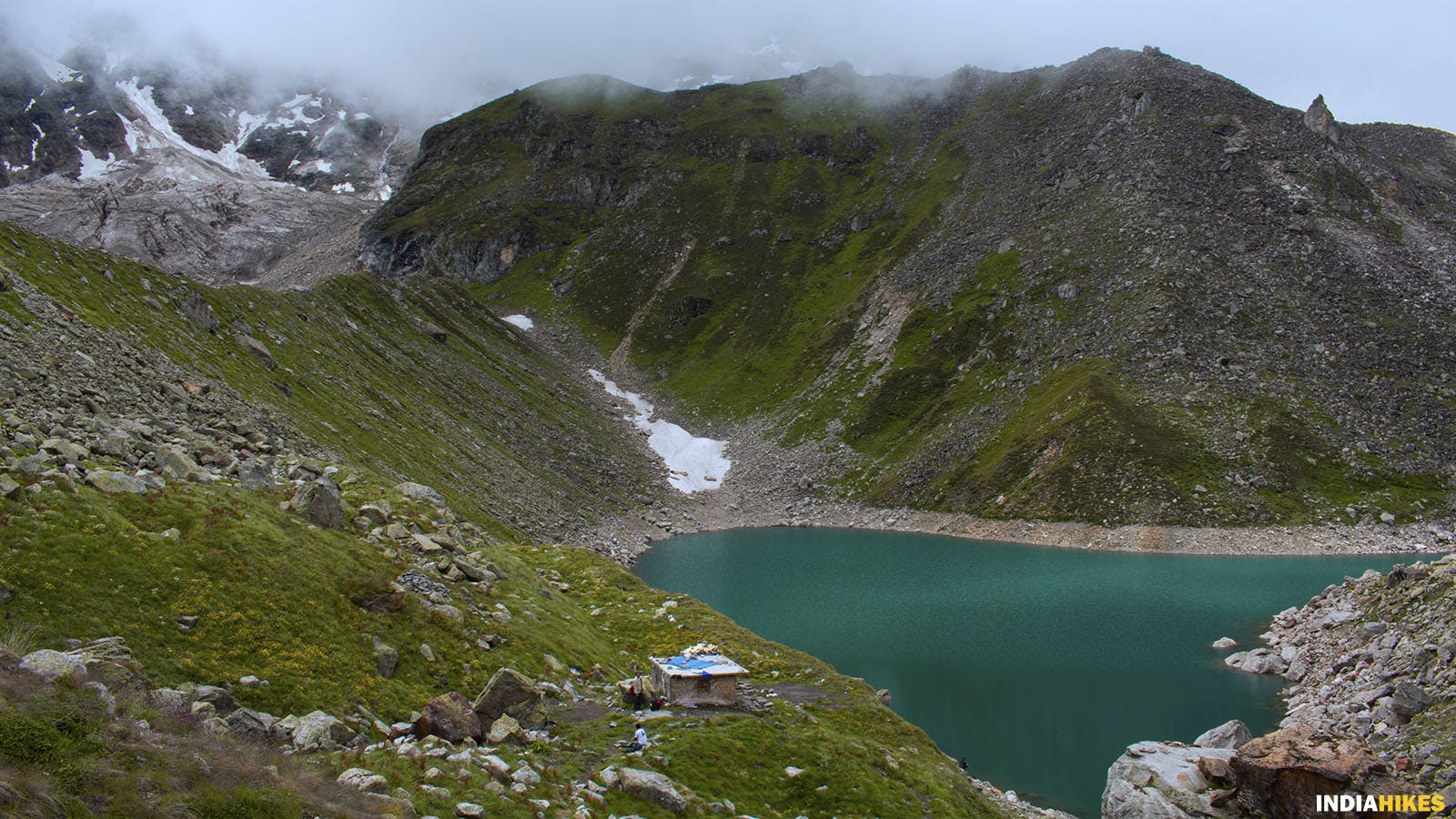
Can You Help Us With Photographs Of This Trek?
We are looking to enrich this documentation with more photos. Pictures go a long way in explaining the trail, more than words ever can. If you have done this trek, can you share your photos with us? We will include them on this page, with due credit to you. Click here to contribute .
Satopanth Tal is an untouched glacier lake at an altitude of 15100 ft. With the shape of a triangle, it is hidden amidst the majestic Garhwal region.
Satopanth Lake has a very rich history. It is considered to be a religious place for the locals. It is believed that the trimurthis(triple deity of the divinity in Hinduism), Brahma, Vishnu, Maheswara meditated on its three corners.
Some articles say that at the end of the Mahabharata, Pandavas took the route from Mana village to reach the steps to heaven which is on the Swargarohini glacier via Satopanth Tal.
The trail to Satopanth lake is one of the beautiful trails in the Garhwal region. You cross Mana, India’s last village, the famous Vasundhara waterfall. Sahastradhara which has more than 100 waterfalls can be spotted on the trail. Trekking on the bank of Alaknanda and camping in the Lakshmi van forest and Chakratirtha meadow are the best part of the trek.
The lake is surrounded by Mount Chaukhamba, Mount Neelkantha, Mount Swargarohini and Mount Balakun. All these snow-capped mighty mountains will be standing next to you.
This triangular Satopanth lake in Garhwal Himalaya remains clean throughout the year even though locals throw the ashes of the dead in the lake. There is also an extensive study which shows the water quality of the lake is being categorised as “Excellent” following the standards of WHOand Bureau of Indian Standards(BIS). Here is the link to the article.

➤Table of Contents
Just like you, we love trekking! And this is a trek we’ve documented in great detail to help you do it on your own. Drop-in comments at the end of the page if you need any help! You will get all the information required to do the Satopanth Tal trek on your own.
To navigate through the documentation easily, use this section of Table of Contents
- What to Watch out for undefinedundefinedundefinedundefinedundefinedundefinedundefinedundefinedundefined
➤ What to watch out for
The majestic view of the mount neelkanth .
The trail to the Satopanth lake is at the foot of the Mount Neelkanth. It is the major peak of the Garhwal division of the Himalayas.
If the weather is clear you can constantly see this mountain once you cross the Lakshmi van forest region.
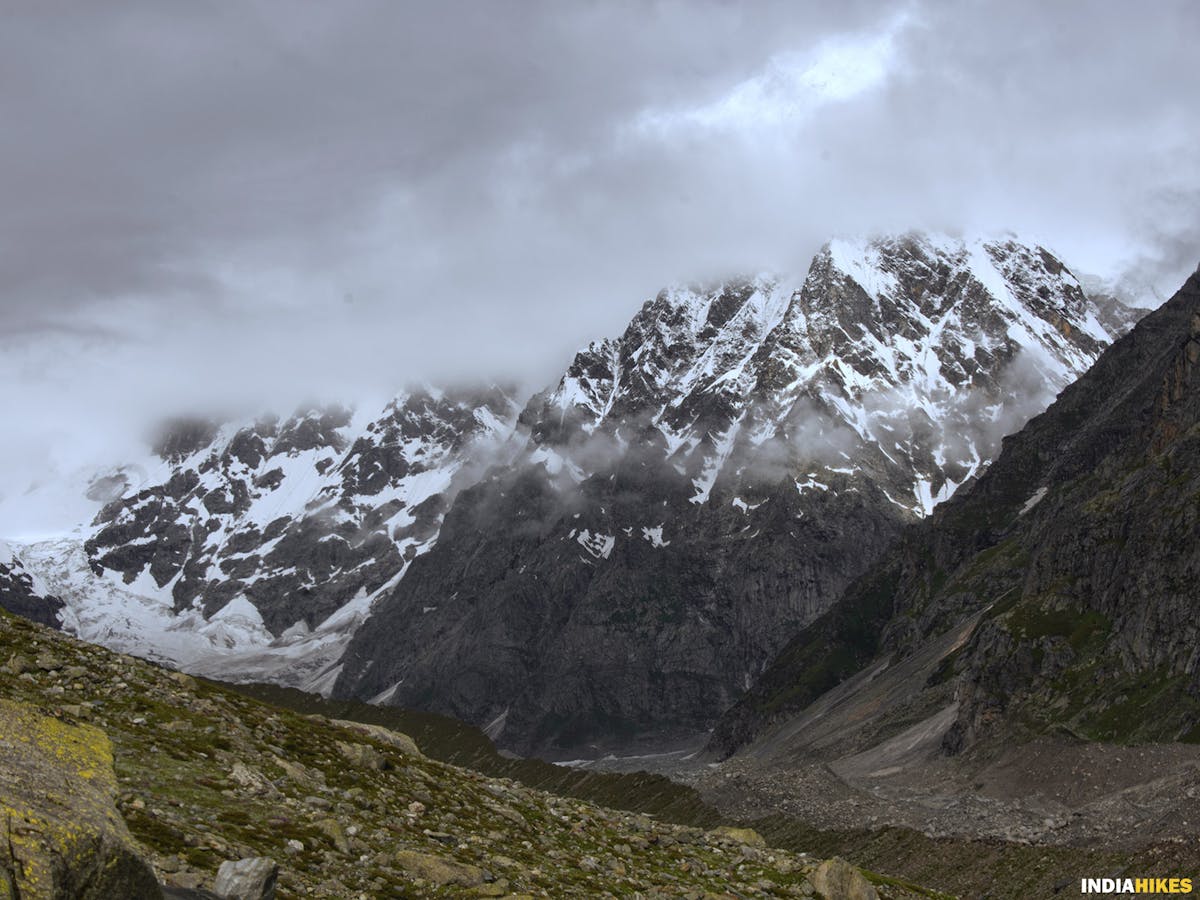
Chaukhamba Peak. Picture by Saurav Sinha
The view of the beautiful Vasundhara waterfall
After a 3 km trek from the Mana Village, you start to hear the burbling sound of the Vasundhara falls. It will be on your right side on the other bank of the Alaknanda river.
There are many tourists and locals who trek only to the Vasundhara falls from the Mana village and return back. The trail from the village is tricky and takes almost 2 hours.
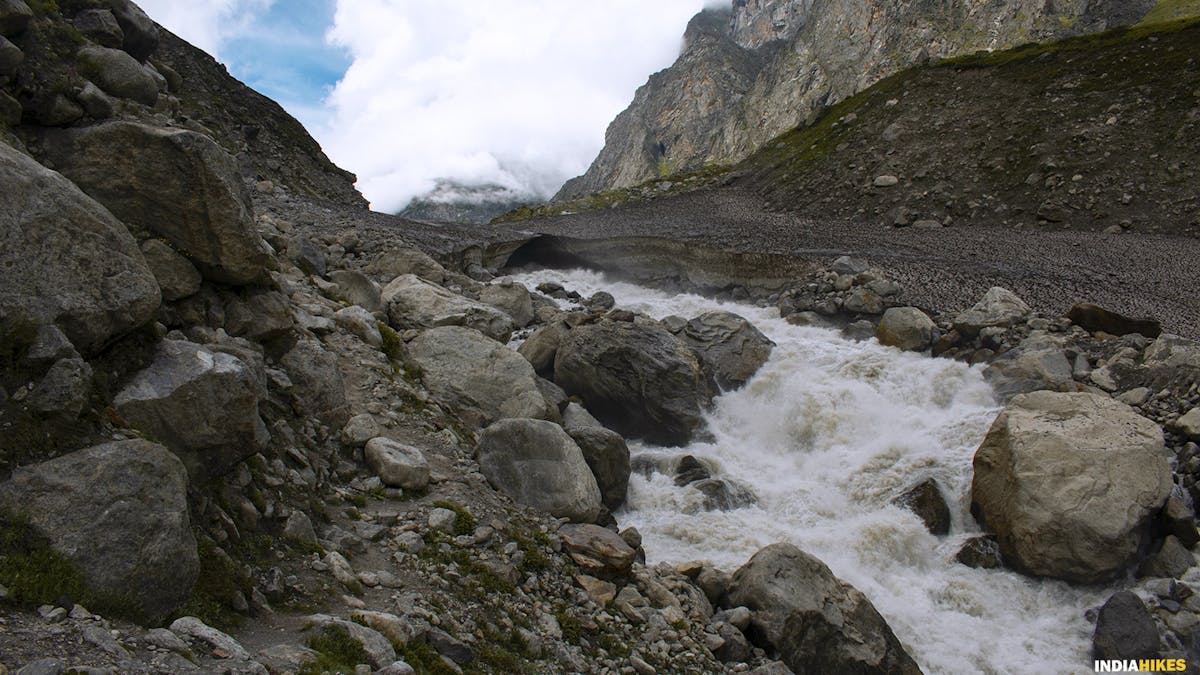
Glacier of Alaknanda River. Picture by Saurav Sinha
Crystal clear Satopanth Tal
Pristine Satopanth Tal is situated in the midst of snow-capped mountains. Some of the famous mountains like Swargarohini, Chawkamba, Neelkanth and Balakun can be seen from here.
This triangular lake has a perimeter of over 1 km and has a soothing evergreen colour. It remains clean throughout the year.
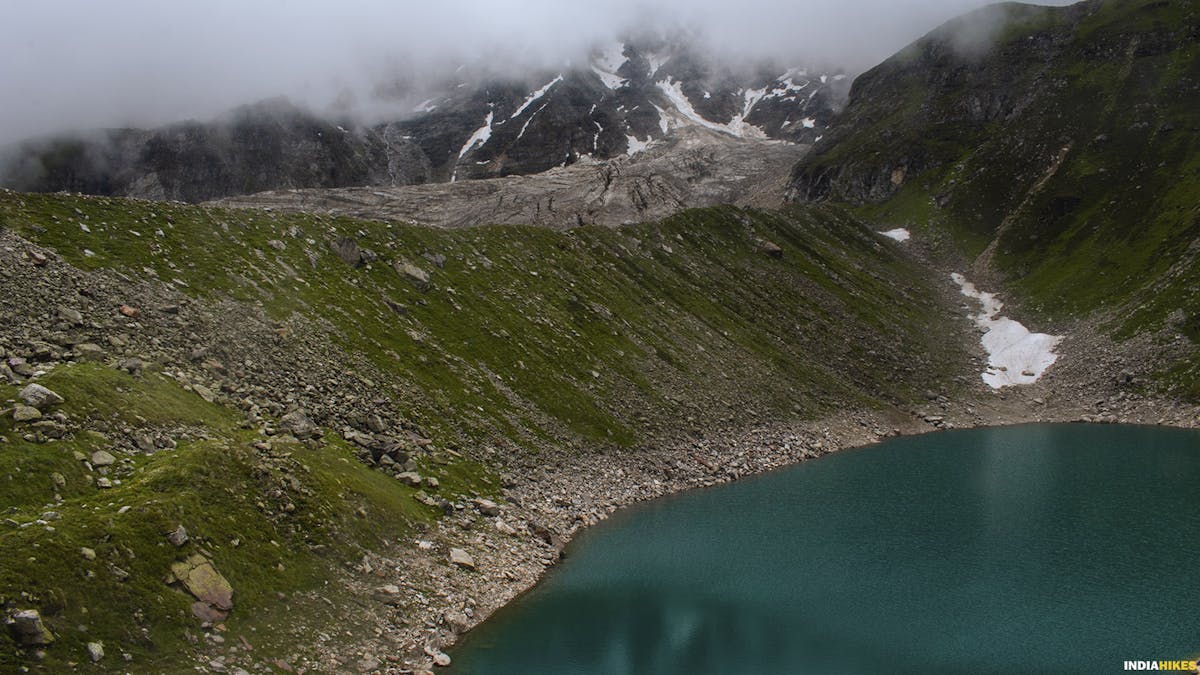
Satopanth Tal, seen from the Ridge. Picture by Saurav Sinha
Click here to go back to the Table of Contents
➤ Trail Information
Satopanth Tal trek can be done in 4 days from Badrinath to Badrinath. The trail can be divided as:
Day 1: Acclimatisation Day
Day 2: Badrinath to Lakshmi van via Mana Village and Vasundhara falls
Day 3: Lakshmi van to Chakrateertha
Day 4: Chakrateertha to Satopanth Tal and back
Day 5: Chakrateertha to Badrinath
Badrinath is at an altitude of 10,830 ft which is quite high to start any trek. So it is recommended to stay one extra night at Badrinath and start the trek.
It is recommended to go on a preventive course of Diamox for this trek. It will help your body to acclimatize faster. You will have higher chances of completing the trek.
Here is an article that tells you how to prevent Altitude sickness. It will help you prepare for the trek with the required precautions.
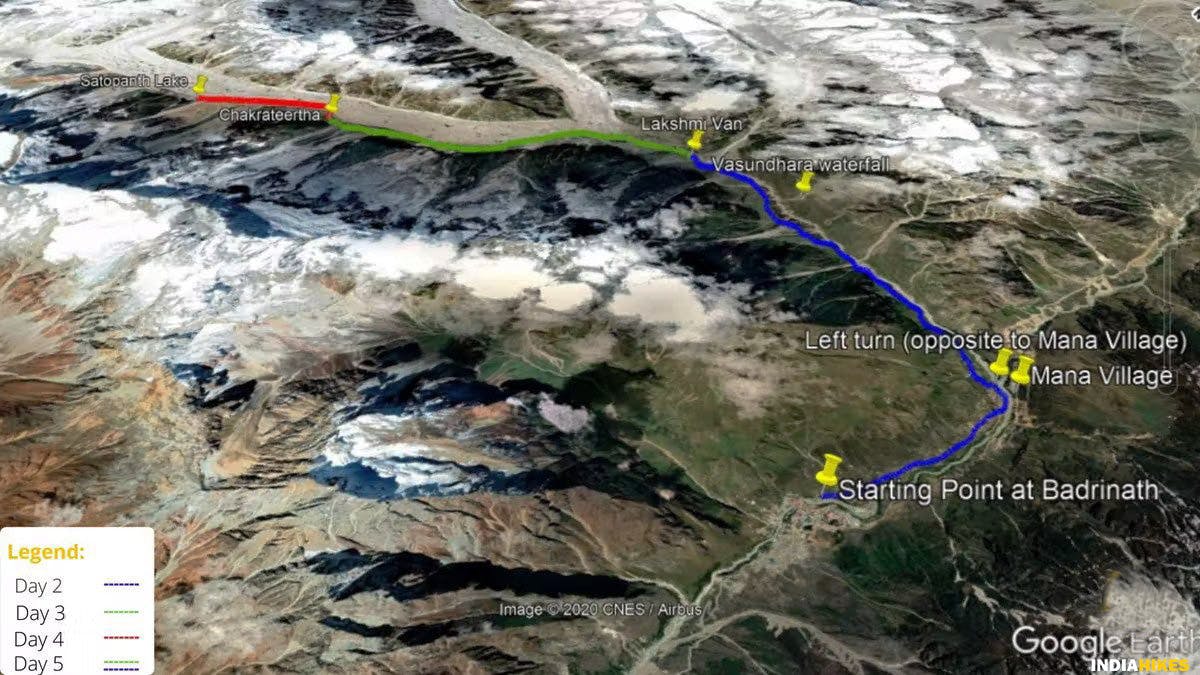
Trail Map of Satopanth Tal Trek. Source: Google Earth. Picture Courtesy Nayana Jambhe
Day 1: Acclimatisation day at Badrinath
Since the trek starts at a high altitude of 10,830 ft, a buffer day is a must. On day 1, you can go to Mana village, explore a bit there and come back to Badrinath.
Since the Inner Line Permit(ILP) is compulsory, you can also get it done from Joshimath if you do not have it.
Rest well on that night and prepare yourself for a long trek ahead.
Day 2: Badrinath to Lakshmi van
Trek Distance: 9 km Trek Duration: 4 – 5 hours GPS coordinates of the starting point at Badrinath: 30°44’47.98″N 79°29’33.07″E GPS coordinates of the Lakshmi van: 30°47’0.68″N 79°25’58.64″E
Start the trek early in the morning from Badrinath. The trek distance to be covered is 9 km.
You walk on the Badrinath to Mana road all the way to the Mana village
Tip: You can also get a taxi from Badrinath to Mana village and then start the trek from there. It will reduce 3 km from the overall trekking distance on that day. A taxi would charge you around Rs 300 to 400.
After a 3 km trek in the same trail, on your right side, you can see the Mana village. This is India’s last village to the China border. Mana is just 26 km away from the India China border.
You can also see the road that goes to the border. But the entry is restricted only to people in the army.
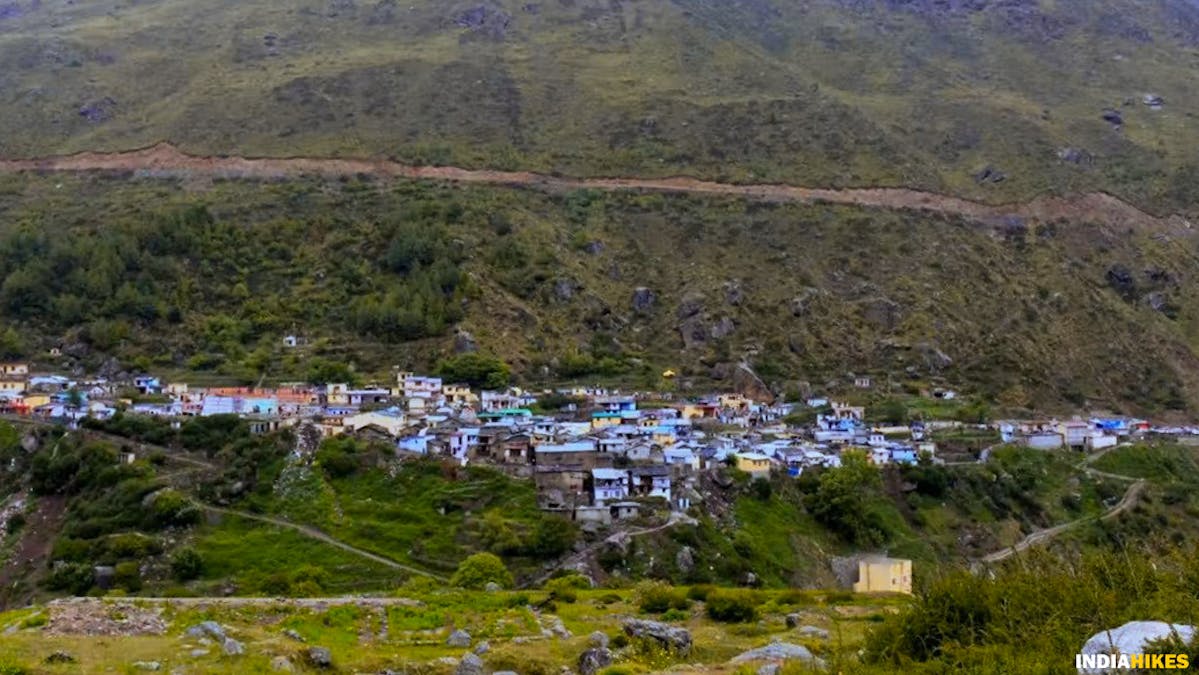
Mana village, captured from the other bank of Alaknanda river. The road above the village leads to the India-China border. Picture by Puttaraj Alige
From this village, the trail deviates towards the left side (towards Eastern side) of the Alaknanda River. There is a proper man-made trail from here for a few kilometres.
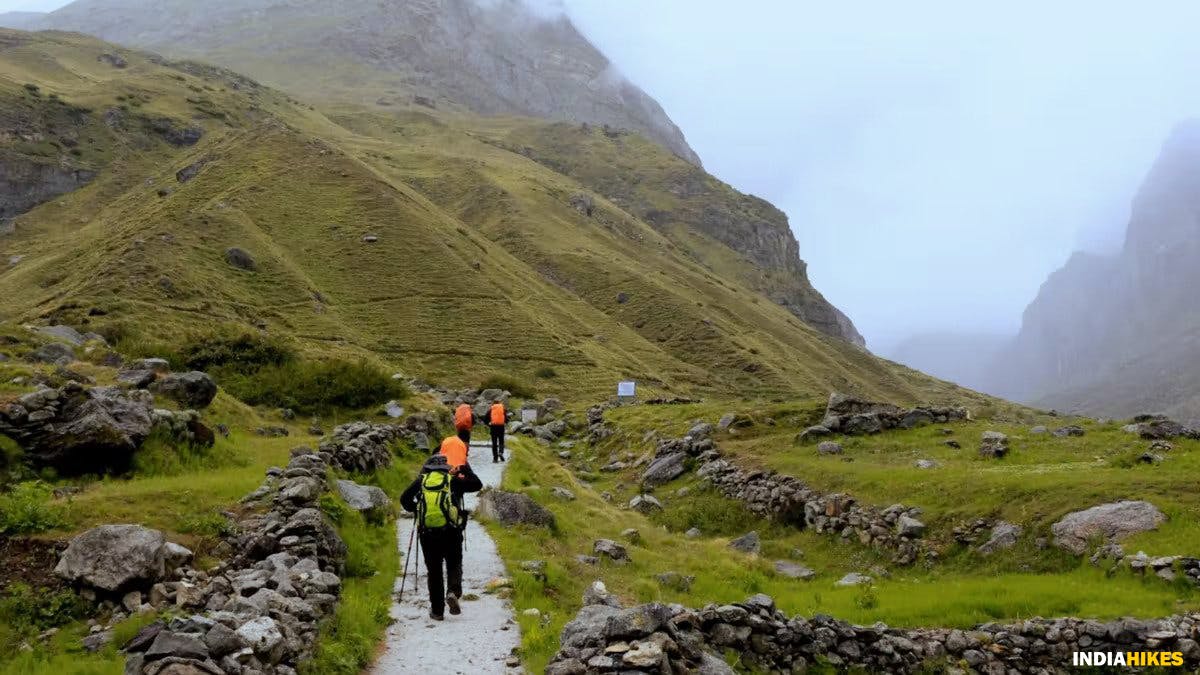
The trail from Mana village towards Vasundhara falls on the left bank of the Alaknanda river. Picture by Puttaraj Alige
After 2 to 3 km from the village, you start to hear the sound of water plunging down from almost 400 ft. Soon, you see the graceful Vasundhara fall on your right.
There is another route to reach Vasundhara falls from Mana village. It is from the right side of the Alaknanda river. Tourists and villagers visit the waterfall and return back to the village from that side.
It is proven that the water of Vasundhara falls as well as the Alaknanda river holds medicinal value. Hence, many people carry the water in a bottle and store it.
Take a quick break here. Drink some water. Since you are gaining altitude as you are covering the distance, you need to keep yourself hydrated throughout the trek. Make sure you fill your water bottle here.
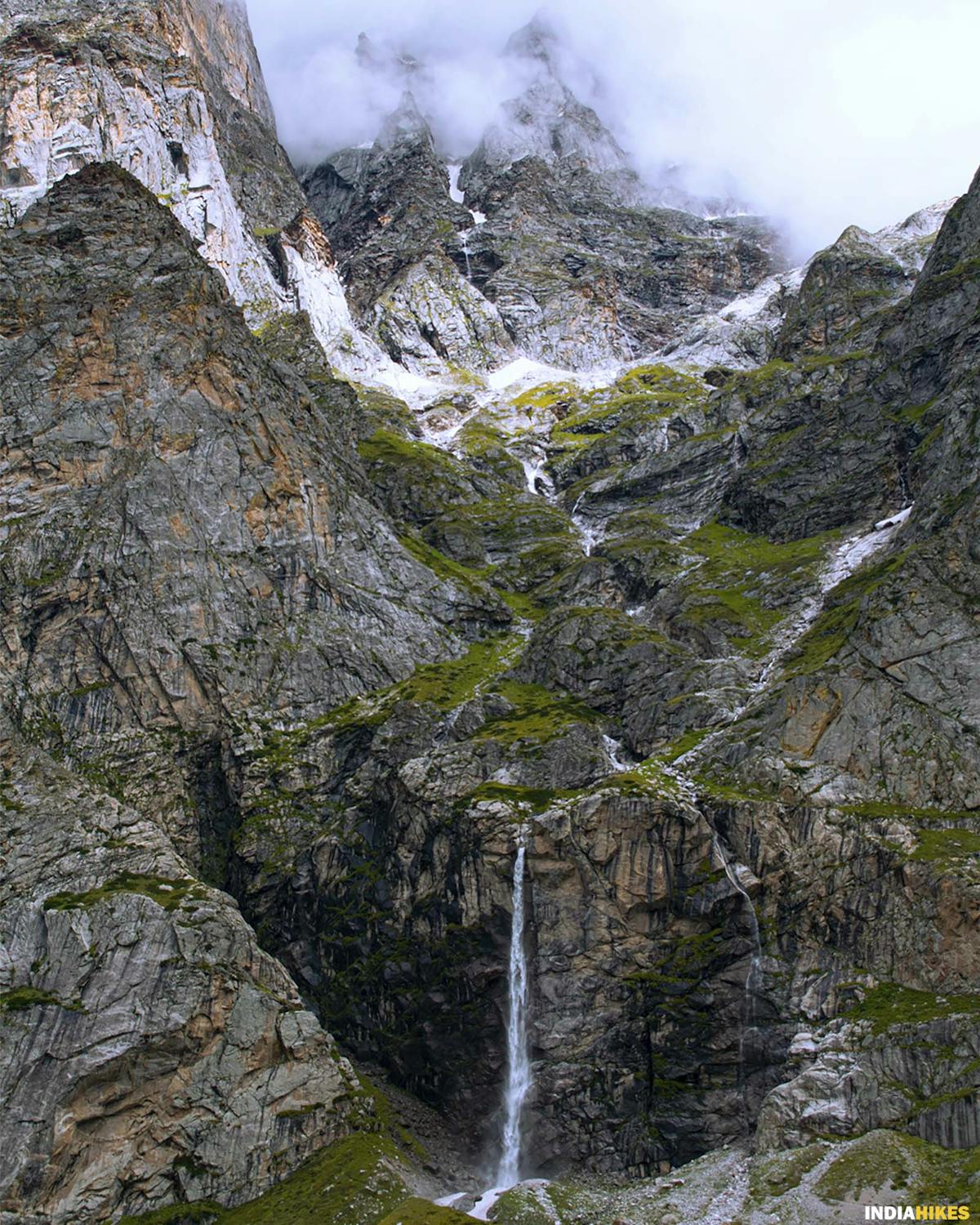
Vasundhara waterfall as seen from Laxmivan. Picture by Saurav Sinha
As you cross the falls and continue towards Lakshmi van campsite, the valley opens up into two. Stay on the left bank throughout the trek.
After 3 km of moraine walk on the left bank of the Alaknanda river, you reach the Lakshmi van campsite.
Now you are at an altitude of 11,900 ft. Take the oximeter reading. It should be above 90. If it is below 90, start descending down immediately.
This campsite is on the green grassland. You find a lot of Bhoj-Patra trees in this campsite.
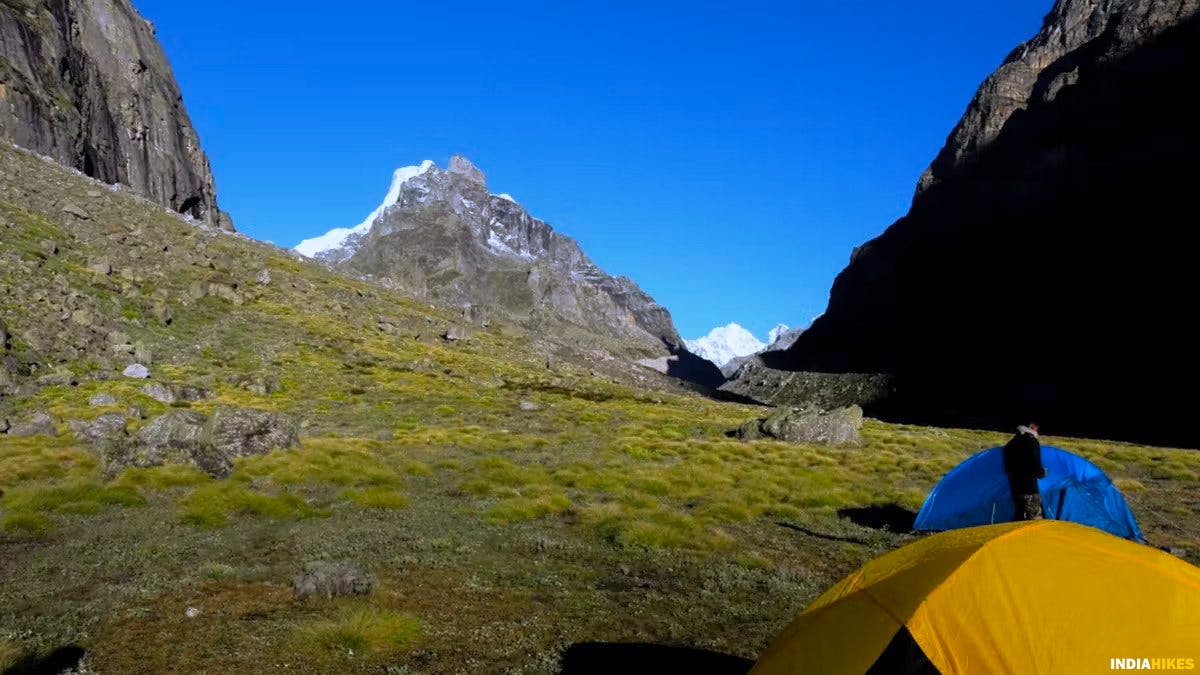
Laxmivan campsite. Picture by Puttaraj Alige
Day 2: Lakshmi van to Chakrateertha
Trek Distance: 7 km Trek Duration: 3 – 4 hours GPS coordinates of the Lakshmi van: 30°47’0.68″N 79°25’58.64″E GPS coordinates of the Chakrateertha: 30°45’5.12″N 79°22’54.45″E
Today’s trek is slightly difficult as the altitude gain is more than 2000 ft. But, it is a scenic route as you enter Satopanth valley.
PROTIPBefore starting the trek make sure you have a healthy breakfast and pack some snacks to eat on the way. Keep drinking water the entire day.
The trail continues to be on the bank of the Alaknanda river. You trek on the grassland in the middle of the terminal moraine of Dhano glacier.
Keep your eyes open for some of the most beautiful alpine flowers on the trail. Once you cross this patch you start to see the 3 peaks of Bhagirathi in front of you(Only if the weather is clear).
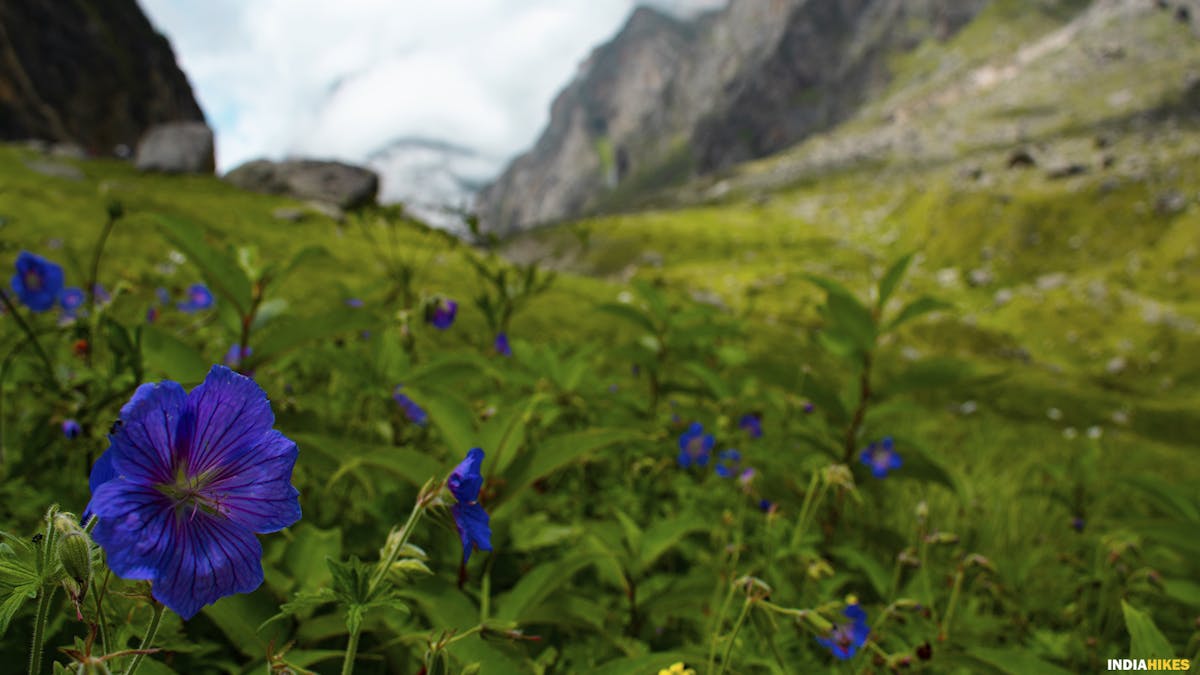
Alpine Flowers, seen on the way to Chakrateertha campsite. Picture by Saurav Sinha
After around 5 km of a trek, you reach the Sahastradhara. From here you can see Mount Neelkanth on the left side.
You also spot more than 100 of small waterfalls on the huge monolithic rock in front of the mountain.
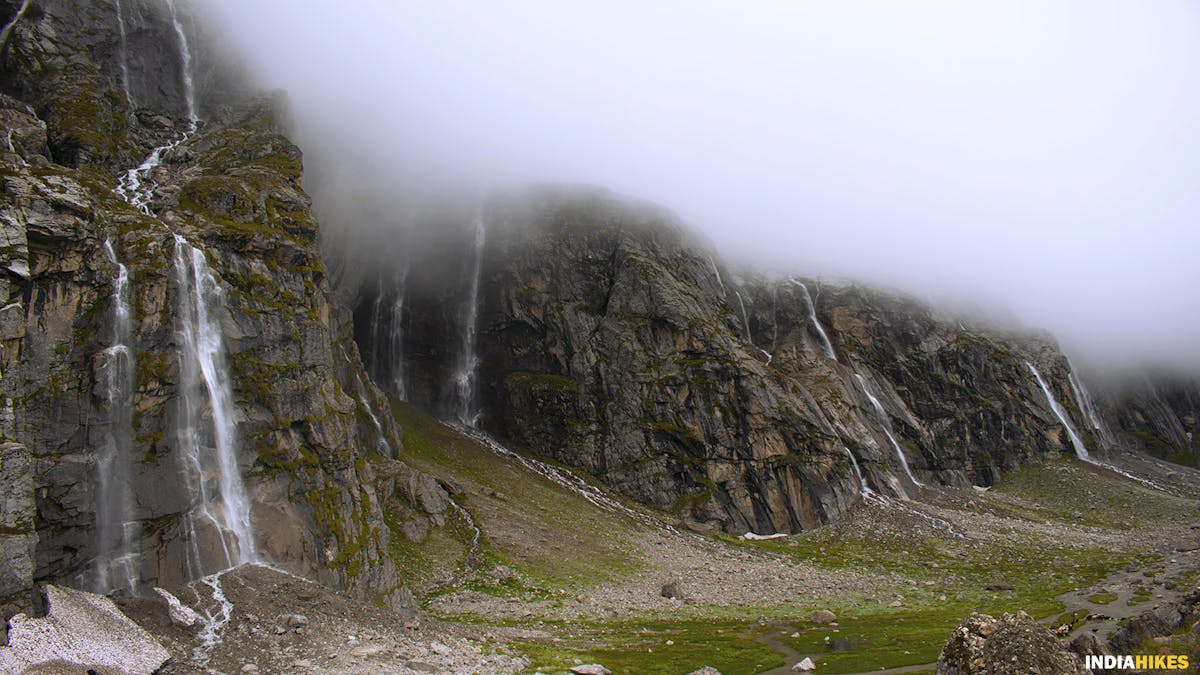
Sahastradhara( 100 waterfalls) feels like you have reached Heaven. Mount Neelkanth is hidden in the clouds behind. Picture by Saurav Sinha
The weather here changes drastically post noon. You are at an altitude of 14,000 ft. At higher altitude weather becomes unpredictable post noon. Make sure you reach the campsite as early as possible.
From here Chakrateertha campsite is around half an hour. It is a flat grassland where you can pitch your tent for the night.
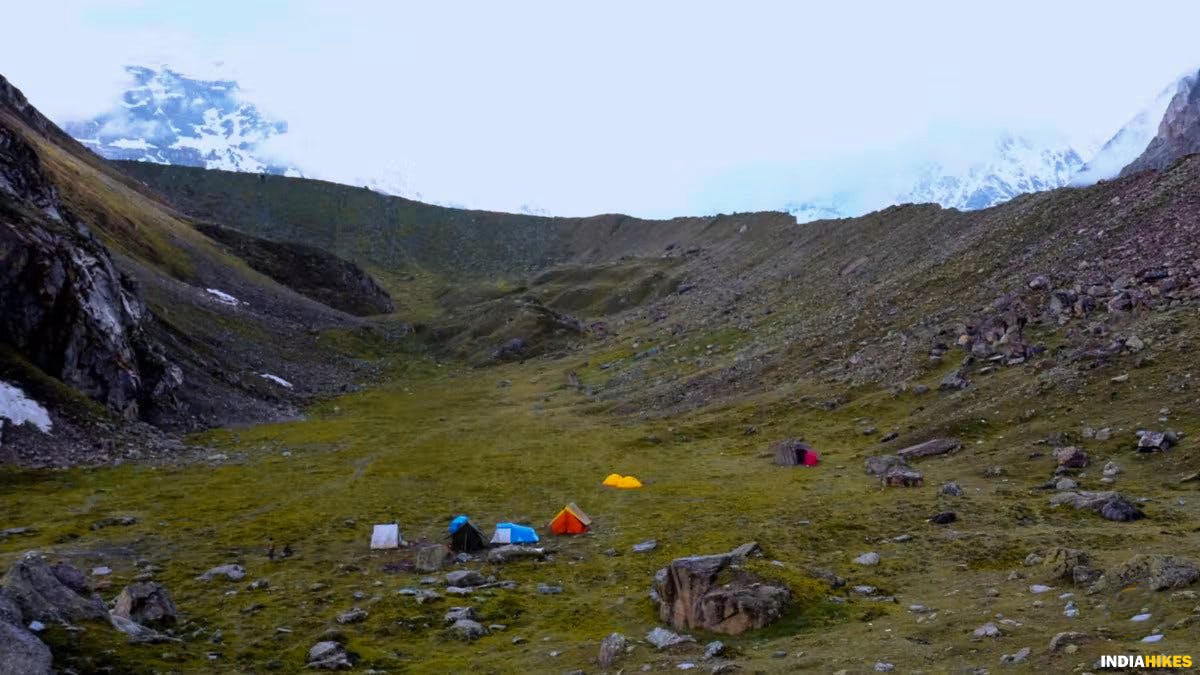
Chakrateertha campsite. Picture by Puttaraj Alige
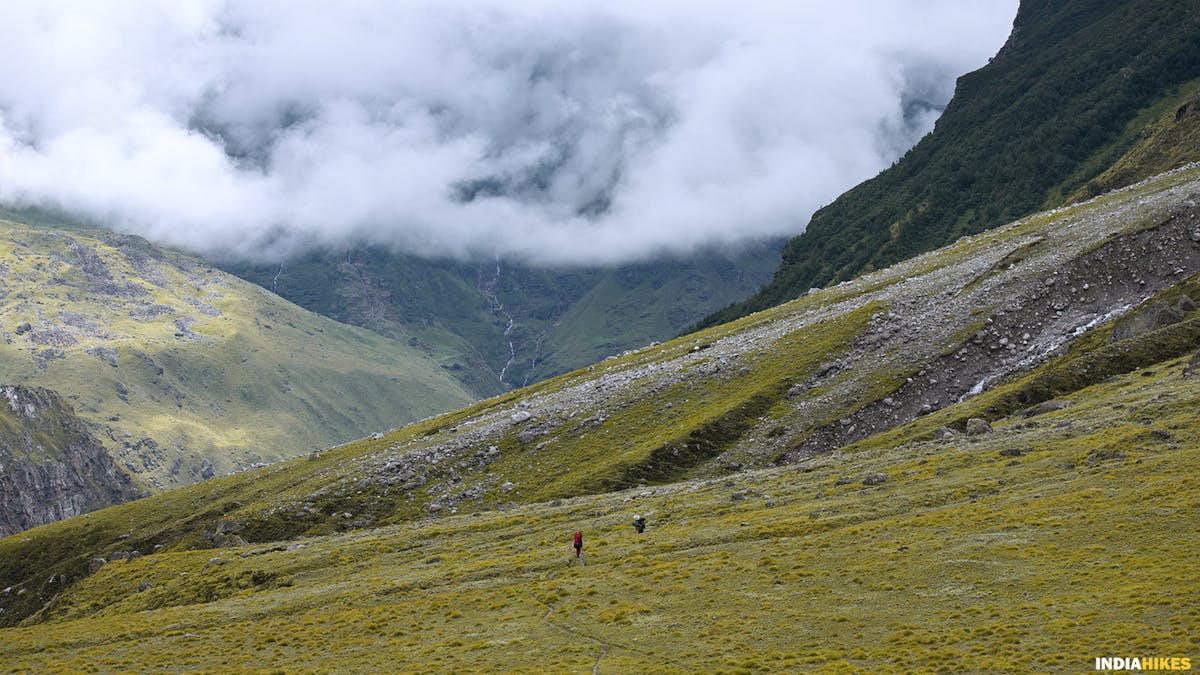
Vast Meadows after Laxmivan. Picture by Saurav Sinha
Once you reach the campsite, make sure you cover your head and wear a fleece jacket. do not expose yourself too much to the cold. The temperature here can be 5 to 10 degree day time and -5 to 0 degree during night.
Here is an article that explains how to layer up yourself for any Himalayan treks.
Check the oximeter reading. If the reading is below 90 or you are showing any symptoms of headache, nausea, fatigue, loss of appetite or dizziness, you need to descend down immediately. These are signs of Altitude sickness. It can lead to deadlier conditions of HAPE and HACE if not recognized on time.
Here is an article that gives you how to recognise the altitude sickness quickly and treat it before it gets worse.
If you want to read a true story of a trekker how she saved her husband’s life on the Satopanth Tal, go through this article.
Day 3: Chakrateertha to Satopanth Tal and back to Chakrateertha
Trek Distance: 10 km (5+5) Trek Duration: 8 hours GPS coordinates of the Chakrateertha: 30°45’5.12″N 79°22’54.45″E GPS coordinates of the Satopanth Tal: 30°44’42.37″N 79°21’28.04″E
Prepare yourself for a jaw-dropping view next day early in the morning. With Mount Neelkanth on your left, Chaukanmba at the centre, Balakun range on your right, you can not forget this sight soon. Keeping the view in mind, get ready for a difficult day of the trek.
The initial trail from Chakrateertha is pretty flat and you trek on the grassland.
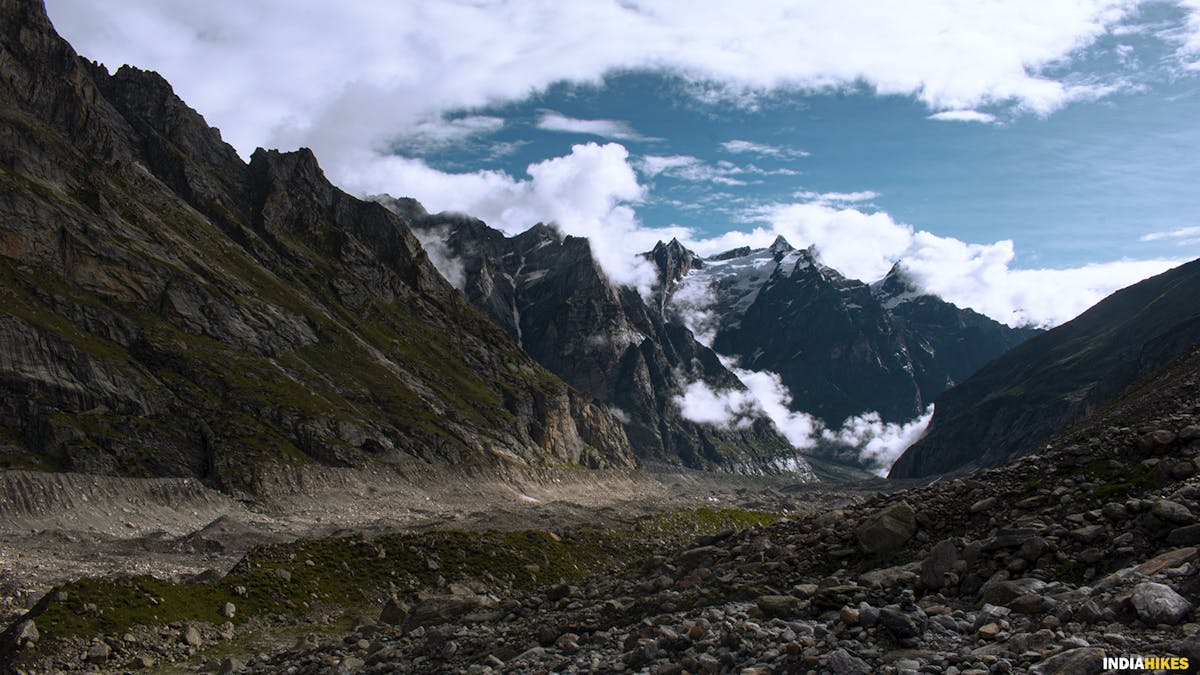
Satopanth Glacier with Kuber Parvata. Picture by Saurav Sinha
After 2 km of the trek, the trail mazes through boulders and moraine. You need to trek very carefully. Take the help of a trekking pole here.
PROTIP Carry 2 trekking poles if you have. It is more comfortable than using one. It also helps in ascending steep sections. This article explains the benefits of using 2 trekking poles.
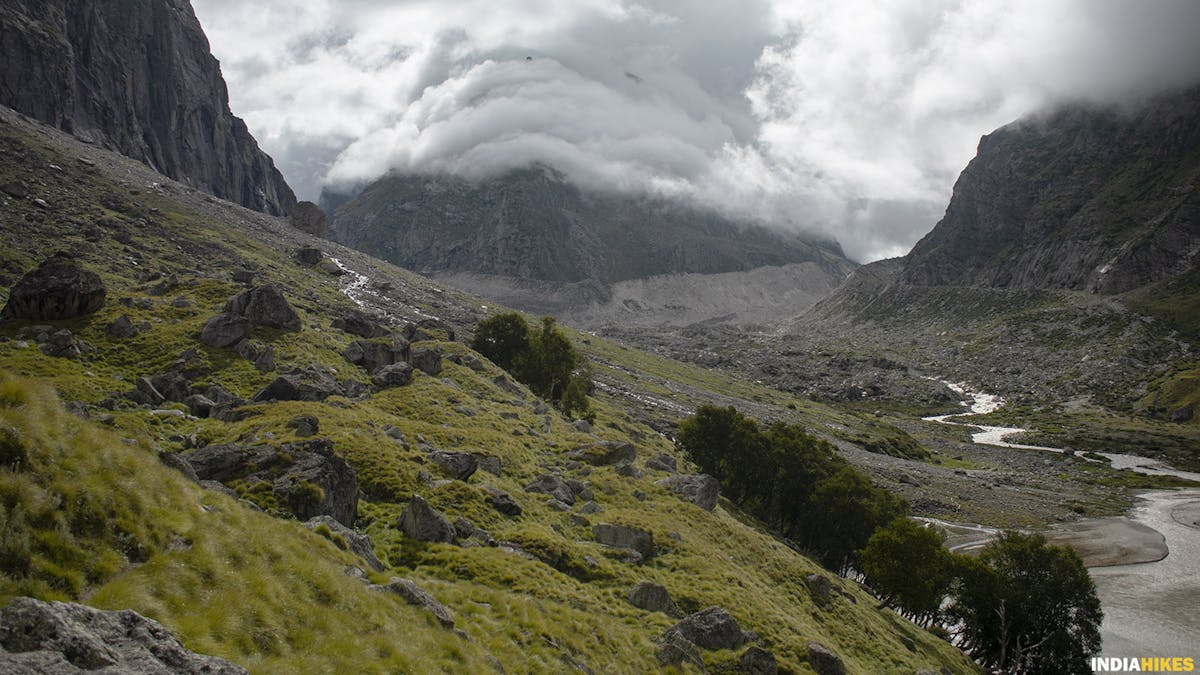
Laxmivan with Bhojpatra trees. Picture by Saurav Sinha
Satopanth Tal is still hidden. You get the first view of the Tal only when you reach the top of the ridge. From there you can see the triangular Satopanth Lake.
The lake looks very small in the picture but when you stand in front of it, it is huge. It has a perimeter of over 1 km.
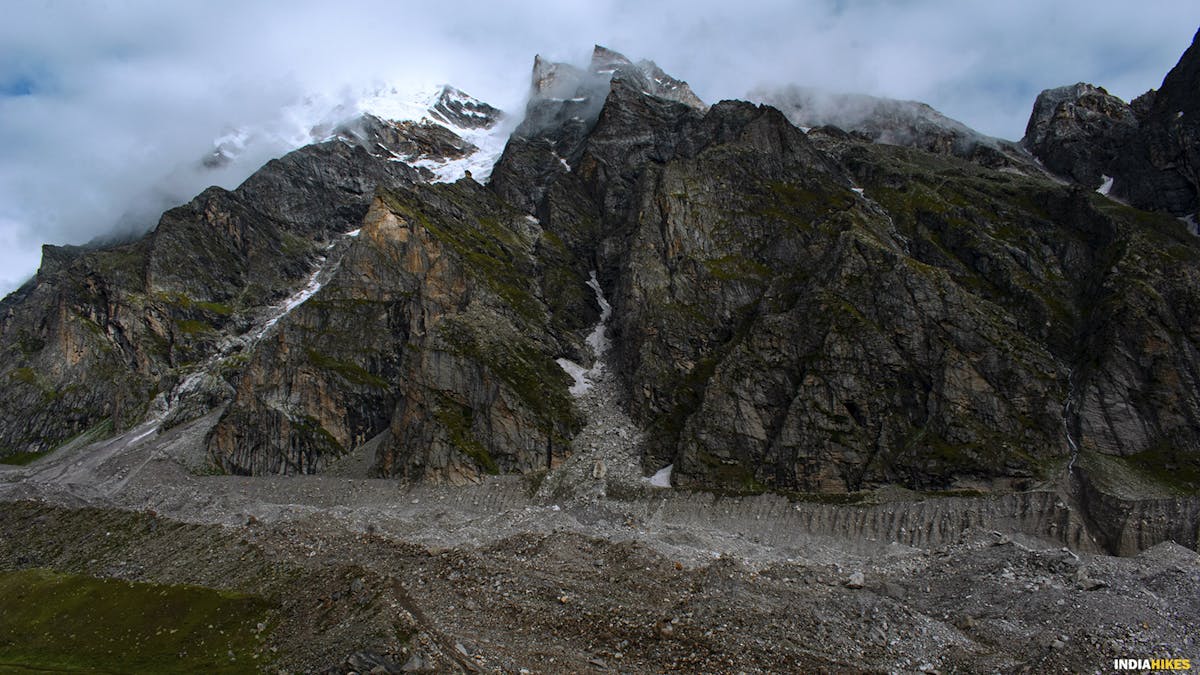
Satopanth Tal glacier. Picture by Saurav Sinha
There is a small room constructed as a temporary shelter here using stones. A Local sage Mauni Baba is known to live near the lake.
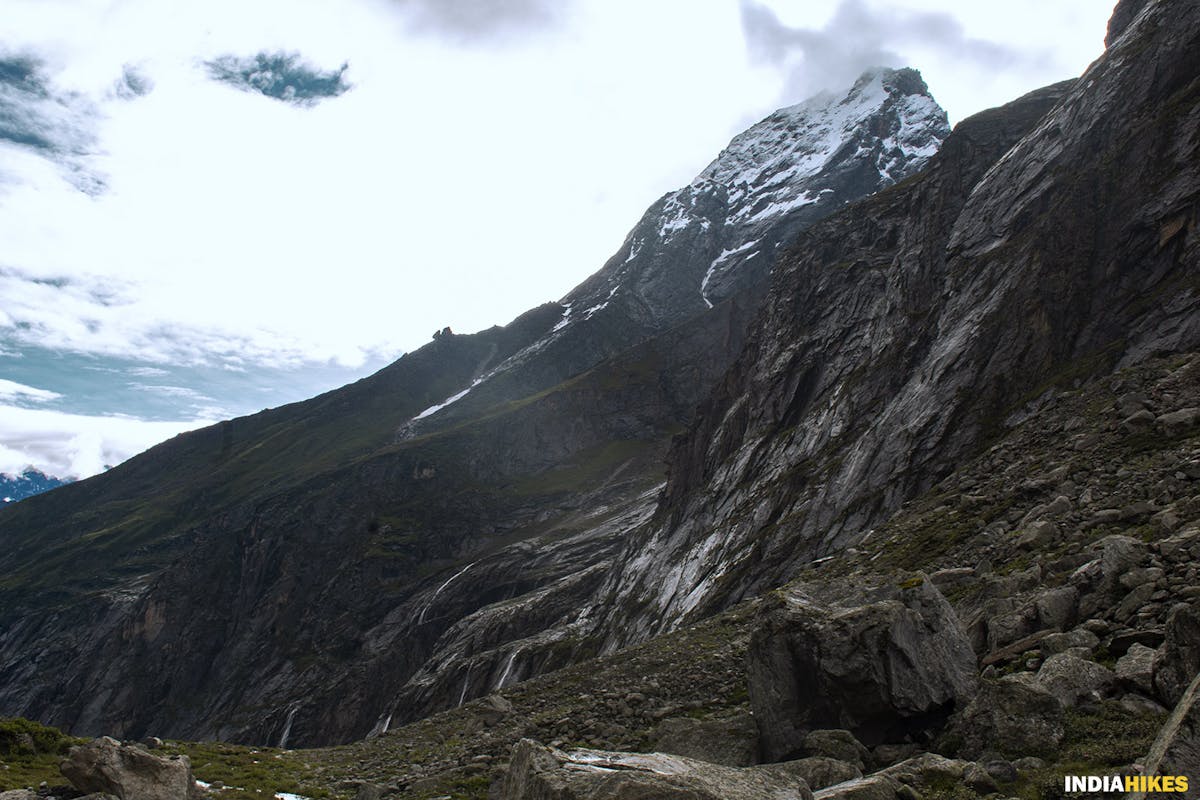
Neelkanth Peak from chakrateertha. Picture by Saurav Sinha
The views from here are spectacular. Spot the Mount Chaukhamba at the centre, Balakun on the right, Swargarohini towards left and Neelkanth standing behind you towards left.
The water quality of the Lake is excellent. It stays clean throughout the year. There are stories and beliefs that few rare birds keep the lake clean all the time. But nobody has spotted those birds till now. You might be that rare person who spots on the trek!
There is also one more interesting thing to see from here. If the weather is clear, you can also see the 3 steps out of 7 on the Swargarohini glacier which is believed to be the steps to heaven that Pandavas took.
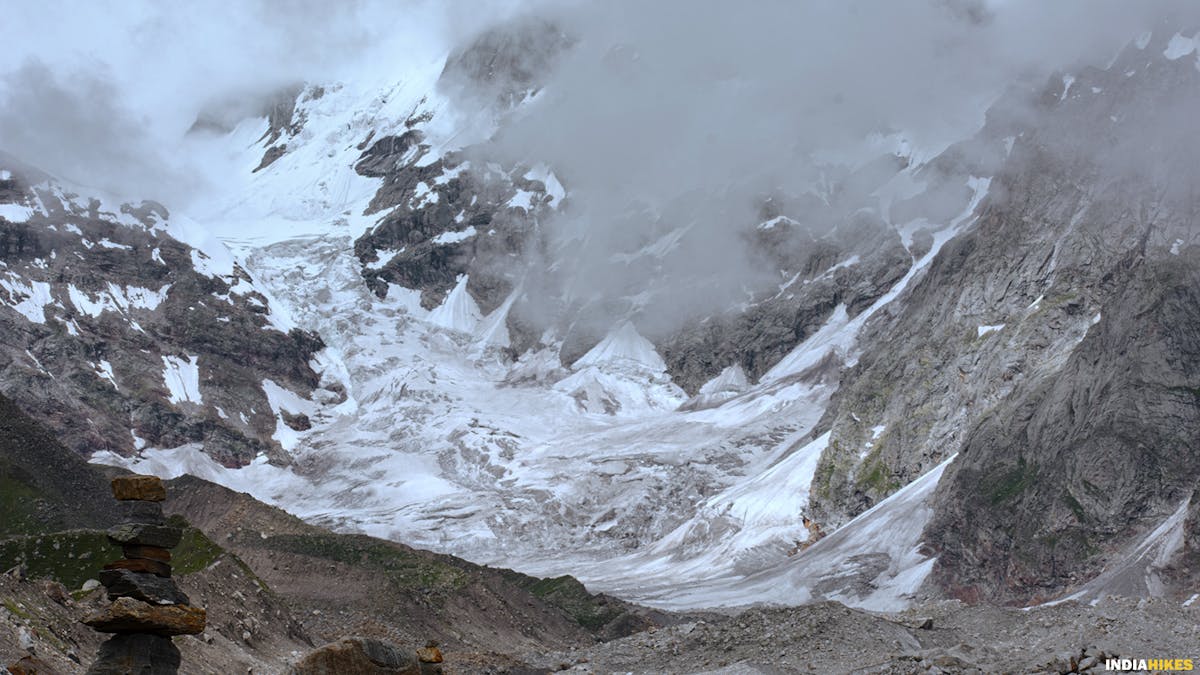
Swargarohini glacier. Picture by Saurav Sinha
Enjoy the calmness around the lake for half an hour. This is the perfect setting to reflect on your long journey.
After having packed lunch or snacks, start the return journey to Chakrateertha. It will take around 2 to 3 hours to reach back to the campsite.
Day 4: Chakrateertha to Badrinath
Trek Distance: 15 km Trek Duration: 5 – 6 hours GPS coordinates of the Chakrateertha: 19°23’35.91″N, 73°47’42.45″E GPS coordinates of the Badrinath: 30°44’47.98″N 79°29’33.07″E
Take the same trail taken to reach Chakrateertha from Lakshmi van and again from mana to Lakshmi van. This will take around 5 to 6 hours to reach Mana village.
If you are too tired to walk up to Badrinath, you can take a jeep or taxi from Mana village.
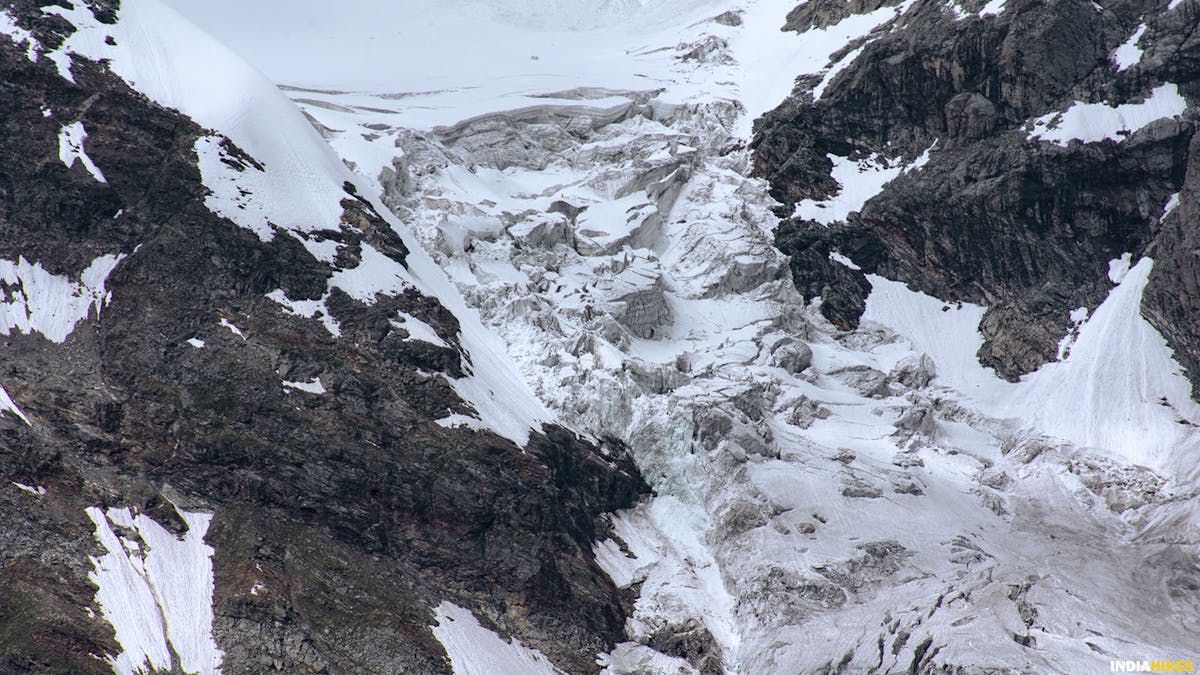
Swargarohini Steps. It is believed that Pandavas found their way to heaven from here. Picture by Saurav Sinha
➤ Best Season to do the Satopanth Tal Trek
Satopanth Tal trek is best if you do it in the month of May to mid-July and September to October.
In the month of May to mid-July, you get to see the lush green meadows, beautiful wildflowers and crystal clear Satopanth Tal.
If you are trekking post-monsoon, you can see the Alaknanda river at its best and graceful Vasundhara waterfalls joining the Alaknanda river aggressively.
Since this trek goes up to 15100 ft, you can expect a lot of snow during winter. So trekking in the winter season is not possible.
During the monsoon season, the trail becomes extremely dangerous making it difficult to access the lake.
➤ Difficult sections on the Satopanth Tal Trek
Satopanth Tal trek is of Moderate-Difficult level. You need to have prior Himalayan trekking experience and high fitness level to do this trek.
This trek is categorized based on the steep sections on the trail, overall altitude gained. And the total distance covered every day.
The trail of this trek passes through a maze of loose rocks, boulders and moraine. Trekking on them is not as easy as trekking in any other places.
Apart from the terrain, there are a few sections that are steep and need to be negotiated carefully. They are:
Forced ascent: Chakrateertha campsite is at an altitude of 14,500 ft and Lakshmi van is at 11,900 ft. Which means you will be gaining almost 2,500 ft in a day. This makes you more susceptible to altitude sickness. If you are trekking on your own, having the knowledge of AMS is a must.
You can prevent this by starting the preventive course of Diamox from Badrinath and preparing your body to function well at higher altitudes (with less oxygen). To know how to prepare yourself for the high altitude trek, go to “How to get fit” section.
Steep section: The final stretch to Satopanth Tal is quite steep and has loose soil over the glacial moraine. There are also scree slopes that make it more difficult to climb. You need to be very careful while climbing.
➤ How to prepare for the Satopanth Tal Trek
The Satopanth Tal trek is of the moderate-Difficult level. You start at an altitude of 10,830 feet and reach an altitude of 15,100 feet in 3 days. Ideally, you should be only gaining 1000 ft a day. However, the Indian Himalayas climb very quickly. This is called a forced ascent.
Cardiovascular endurance – Target 10 km in 60-70 minutes before the start of the trek
On the Satopanth Tal Trek, you have to cover an average of 8 km each day. This requires a good amount of endurance. You can begin by jogging every day. Start slow and increase your pace every day. Swimming, cycling and stair climbing without too many breaks in between can help too.
In order to be prepared for a high altitude trek, you should have a combination of distance and speed targets .
Here’s a fitness routine that works:
In case you’re just starting with a regular fitness routine, phase out your distance targets in the following manner –
–> Target completing 5 km in 40 minutes when you begin. –> Gradually increase your pace by running 4 times a week and bring it down to 5 km in less than 35 mins. –> If you are above 45 years and is comfortable with brisk walking, then target covering 10km in 90 minutes.
If you are somebody who prefers cycling over running, then try to cover 25 km in 60 minutes.
Strength – Target 4 sets of squats with 20 in each
This is another area you should work on. There is a lot of trekking distance that you will cover in high altitude carrying your backpacks. You have to walk on uneven terrain during the trek. It could be taxing for your legs. For this, strengthening your legs will help. You can do some squats to strengthen them. Start with 3 sets of squats, with 8 squats in each set and work towards reaching your target in 3 weeks .
Flexibility
Another aspect that will help you trek comfortably is flexibility. For this, you can do some stretching exercises – stretch your hamstrings, quadriceps, hip flexors, lower back muscles and shoulders regularly. On your trek, it is important that you arrive on the slopes with your muscles relaxed. Carrying a backpack, however light, can become a strain after a while. These exercises will help you to be in good shape before the trek.
Here is a guide to help you get fit for the trek.
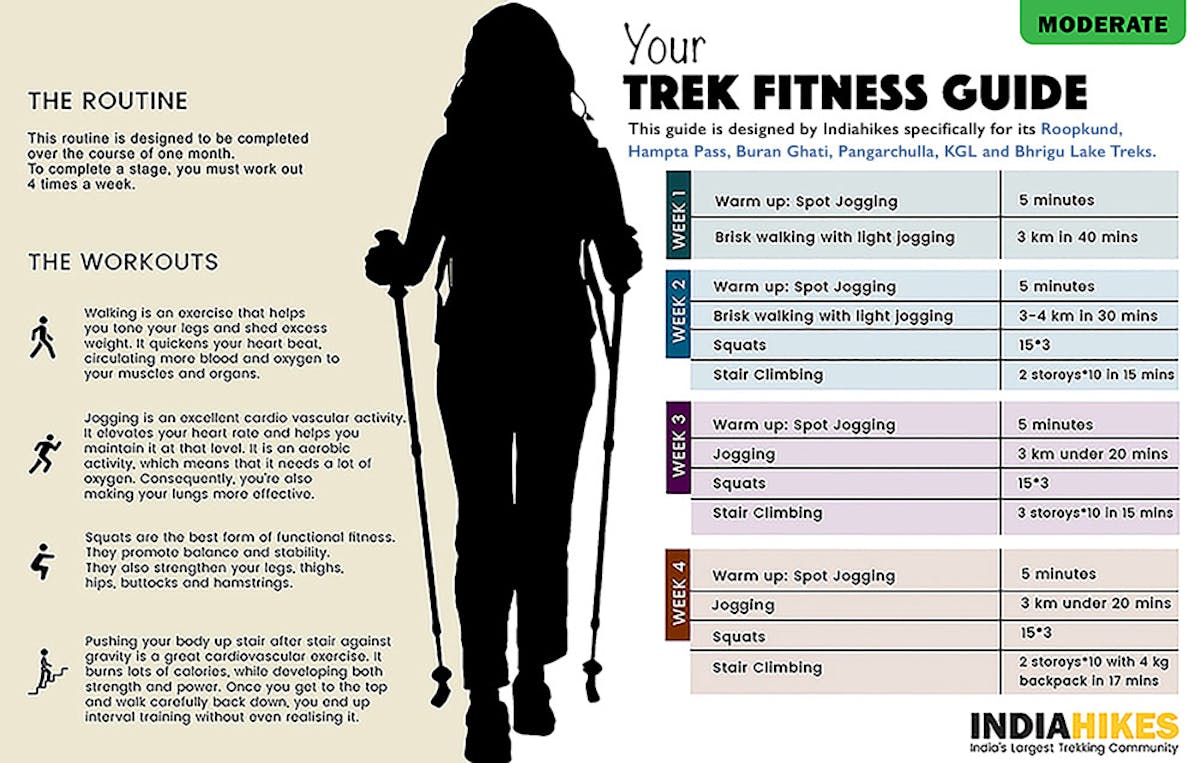
One-month trek fitness routine for a moderate-difficult trek
Working out indoors
If you can’t go out and jog because of time and space constraints, here’s a video you can use to work out indoors.
Click here to go back to the Table of Contents.
➤ How to reach Satopanth Tal
Satopanth Tal trek starts from Mana village, India’s last village. To help you with your travel plans, a detailed step by step guide is given.
The Mana village can be accessed easily from Haridwar/Rishikesh. There are multiple options to reach both places.
Option 1: Fly directly to Dehradun → Rishikesh → Badrinath → Mana village
If you are travelling from cities like Bangalore, Chennai or Mumbai, we recommend you to fly directly to Dehradun.
Rishikesh is just 20 km from Dehradun Airport.
Here is an article that tells you how to reach Rishikesh.
There are 3 options to reach Rishikesh:
- A shared taxi directly to Rishikesh: 1000 Rs per vehicle(Recommended only if you are in a group).
- An auto directly to Rishikesh: 300 Rs.
- A bus from the bus stop which is 1.5 km from the airport: 50 Rs(Cheapest and recommended option).
Tip: Make sure you reach Rishikesh by 6 pm so that you get enough rest before the long journey.
The distance from Rishikesh to Badrinath is around 301 km. There are buses every hour that charge you around Rs 650. Take a bus from Rishikesh that leaves very early in the morning to Badrinath. It will take 10 to 12 hours to reach Badrinath depending upon the road condition.
Tip: Leave Rishikesh before dawn. This is because there is a travel restriction after 6 PM from Joshimath. If you have not crossed Joshimath before 6 pm, you will have to halt there for the night and start again the next morning.
You can stay at Badrinath that day. Next day, you can either hire a cab to the starting point at Mana or directly start the trek from Badrinath.
Option 2: Fly to Delhi → Haridwar → Badrinath → Mana village
Another option is flying to Delhi. This is cheaper than getting to Dehradun. Make sure you reach Delhi by 1 pm.
Tip: If you notice the difference in air ticket prices between Delhi and Dehradun less than Rs 1000 then book directly to Dehradun. The rest and shorter travel time are worth the difference.
There are 2 options to reach Haridwar from Delhi:
- From New Delhi railway station(NDLS), take the afternoon Jan Shatabdi express (leaves at 15.20 pm) to arrive at Haridwar by 8.00 pm.
- There are regular AC buses available from Delhi’s ISBT Kashmiri Gate. They are very frequent and not very crowded. It takes around 7 to 8 hours to reach Haridwar. They will charge you around Rs 700.
Stay overnight at Haridwar. Next day, take the 3 am bus that leaves to Badrinath. They will charge you around Rs 625. Leave Haridwar at max by 5 AM. In case, if you can not take any buses before dawn, travel to Joshimath and stay there (you get buses to Badrinath in the morning).
You reach Badrinath by 4 pm if you have taken the 3 am bus. Stay there for the night. Next day, you can either hire a cab to the starting point at Mana or directly start the trek from Badrinath.
Nearest Railway Station
Haridwar Railway Station – 314 km
Nearest International and Domestic Airport
Jolly Grant Airport, Dehradun – 314 km
Satopanth Tal is a high altitude trek. The trekking gear you need to carry for this trek is different from regular treks. So pay careful attention to this entire section.
- A list of everything you need for the trek ( Skip to section )
- Useful videos to help you with your gear (Skip to section)
- A list of medicines for your trek ( Skip to section )
First, The Essentials. You cannot do the trek without these.
1. trekking shoes: .
Satopanth Tal requires trekking shoes that are sturdy, have a good grip, have ankle support and can handle snow. Here is a quick video on how to choose your trekking shoes .
| Buying Tip : The Trek series and MH series are good options by Decathlon. They are tried and tested. There really isn’t any necessity to buy the higher-priced models. Here is a list of other budget shoes that trekkers are using .
2. Backpack :
For a trek like Satopanth Tal, you need a 50-60 litre backpack. Make sure your backpack has good hip support, shoulder support and quick access pockets. Here is a guide on how to choose a backpack .
| Buying Tip : Wildcraft, Decathlon and Adventure Worx usually make good backpacks. While Wildcraft has more expensive ones, the other two brands have budget-friendly backpacks to choose from.
3. Clothes:
Wearing layers is the mantra in the mountains. Layers give you maximum protection from all elements. And when the weather changes in the mountains (as it happens every few hours), you take off or put on layers as required.
Base layer:
3 t-shirts :.
Wear one T-shirt and carry two. Carry full sleeve dry-fit T-shirts (preferably collared). These prevent your arms and neck from getting sunburnt. In the rarified air on the trek, especially at high altitudes, UV rays can burn you in no time . Dry-fit T-shirts quickly dry your sweat, they are easy to wash and in case of a rainy day, they dry quicker. Round neck T-shirts are ok, but collared ones are better.
3 insulation layers:
The highest altitude you reach on this trek is 15, 100 ft. At these altitudes, it can get freezing cold even in the middle of summer. You will need at least 3 insulation layers for this trek. You will need 2 light fleece layers, 1 full-sleeve light sweater. Do not get your grandma stitched sweaters, which can be very heavy. You need sweaters and fleece jackets that can fold into compact rolls.
1 Outer layer:
A padded jacket serves the purpose here. You don’t really need a water-resistant material. But you need an outer padded jacket that keeps the wind and cold out. Ensure your padded jacket has a hood as well.
| Do you need a down/feather jacket? Not really. A regular padded/shell jacket will do. This video here will help you to learn more about the difference .
Two trek pants:
Two pairs of trek pants should suffice for this trek. Wear one pair and carry two just in case it rains. Trek pants with zippered cut-offs at the thighs are very suitable for treks. Also, choose quick-dry pants over cotton. They dry up soon in case of small stream crossings/rain.
Mandatory Accessories, without these too you won’t be able to do the trek.
These accessories are mandatory. Don’t go to Satopanth Tal trek without them. Trekkers generally put off purchasing / borrowing the accessories for the last minute. We suggest the opposite. Start gathering these accessories first.
1. Sunglasses:
Sunglasses are to prevent snow blindness. Especially in the month of May and October on a trek like Satopanth Tal, expect to walk on long stretches of snow from Chakrateertha to Satopanth Tal.A small overexposure to direct sunlight on snow can lead to snow blindness (about a half hour’s exposure). That’s because fallen snow is like thousands of mirrors that reflect direct UV rays. So you need sunglasses with UV protection .
| Tip: Try getting sunglasses that wrap around instead of those that have openings on the side. Even peripheral UV ray exposure is not a good idea. Wear sunglasses if the trekking day is bright and sunny (on open sections, meadows). On a snowy section, you must absolutely never take off your sunglasses until the section has been fully crossed. | If you wear spectacles : If you wear spectacles, you can get oversized sunglasses that you wear over your regular glasses (available at Decathlon). If that is cumbersome, photochromic lenses work equally well. Here’s a quick guide on managing sunglasses with spectacles . | Contact lens users : If you use contact lenses, you can use them on the trek too. The lens solution will not freeze. You will also not face any problems in changing your lens in your tent. Just carry enough cleaning solution with you to clean your fingers well. Wear your sunglasses over your contact lens.
2. Suncap:
A sun cap is mandatory. Trekking without a sun cap can lead to headaches, sunstrokes, quick dehydration and a sharp drop in trekking performance.
| Tip : In the mountains, the general rule is to keep your head covered at all times. During the day a sun cap protects you from the harsh rays of the sun (it is doubly stronger with naked UV rays). A sun cap keeps your body temperature in balance. In the evening/early morning, the reverse is true. Your head loses your body heat quickly. A woollen cap prevents heat from dissipating from your head. | Pro Tip : Sun caps with flaps are a blessing for trekkers. They cut out almost all UV leaks, prevent sunburns in every possible way and also they are a lot more effective than sunscreen lotion. A wide-brimmed sports hat also helps to prevent sunburn in a big way.
3. Synthetic hand gloves:
On a trek like Satopanth Tal you are going to be handling snow quite a bit especially in the month of May and October, You’ll need gloves to grip something or to steady yourself in snow. You also want the gloves to keep you warm. Get synthetic hand gloves that have waterproofing on the outside and a padded lining on the inside. If you find the combination difficult to get (not likely), wear a tight-fitting fleece hand glove inside a synthetic hand glove. Hand gloves are mandatory on this trek.
4. Woollen cap or Balaclava:
Ensure these cover your ears. In the cold mountains, you lose maximum heat from your head, not from your hands, feet or the rest of your body. Which is why you need to keep your head protected, especially when the sun is down. Early mornings, late evenings, a cold trekking day are when you must use your woollen cap. Your ears are sensitive too, so a woollen head cap that covers your ears is absolutely essential. A balaclava is a modern version of the woollen cap. It covers your ears, neck and parts of your face as well. Do not get a woollen cap that only covers your head.
5. Socks (3 pairs):
Apart from two sports socks, take a pair of woollen socks. Sports socks give you cushioning plus warmth. Again the mantra is to wear synthetic socks or at least a synthetic blend. Cotton socks soak in water and sweat. They are very hard to dry. As for woollen socks, they help you to keep warm and snug in the night. If you cannot get woollen socks, wearing two sports socks serves the purpose as well.
6. Headlamp :
Trekkers are often confused about whether they need to get a headlamp or a handheld torch. You need to get a headlamp because it leaves your hands free to do other activities. On the Satopanth Tal trek, you’ll need your hands free to wash dishes, pitch tents and hold your trek poles. Ensure your headlamp covers a wider area and is not too focused as a single beam. On a trek, your headlamp must help you see around you as much as ahead of you.
7. Trekking pole (a pair):
Trekking poles give you stability and balance. They reduce your energy consumption by almost 40%. On the Satopanth Tal trek, there are steep ascents and descents. The trek up to the Satopanth Tal is pretty steep. A pair of trekking poles will make the difference between a comfortable and a strenuous trek. In India, we tend to use a single trekking pole. However, two trekking poles give you greater stability and balance. They also increase your walking pace.
8. Rainwear:
On a trek, the weather can change quickly. A bright sunny day can turn into a downpour in a matter of minutes. Carry a poncho or a rain jacket to tackle this. A poncho is a big rain cover with openings for your arms and your head. It is extremely effective because it covers both you and your backpack. It is extremely light and weighs next to nothing. Rain jackets are more streamlined and less cumbersome but weigh more. Rain pants are really not required. Dry fit trek pants dry quickly even if soaking wet.
9. Rain cover for your backpack:
Backpacks are your life. You carry all your dry clothes, your warm gear in your backpack. It is important that your backpack stays dry at all times. Modern backpacks usually come with built-in rain-covers. If your backpack does not have a rain-cover, ensure you get a rain cover by either (a) buying a rain cover (b) or cutting a large plastic sheet to the size of your backpack. You can roll the plastic sheet around your backpack and keep it in place with a string or elastic.
| Pro tip: It’s good practice to compartmentalise your clothes, accessories and other things in plastic covers inside your backpack. That way, even if it rains and your backpack gets wet, your things are water-proof inside the backpack.
10. Daypack (20-30 ltrs, optional):
On day 4, you will be coming back to Chakrateertha. So carrying a daypack is mandatory . In your daypack, you carry essentials like water bottles, rainwear, emergency medicines, headlamp, some snacks and a warm layer. A daypack is a smaller backpack that is usually of 20-30 ltr capacity. Laptop bags are not daypacks. Do not get them.
Other mandatory requirements
1. a toilet kit: .
Keep your toilet kit light. Carry just the basics — toothbrush, toothpaste, small soap, toilet tissue roll, a small moisturiser, lip balm, and a roll-on deodorant. You will not be able to have a bath on the trek, so don’t overload on soaps and shampoos.
| Pro tip: Carry miniature-sized items. You will not need more than that. If you’re travelling in a group, share one toothpaste for all. Avoid getting large toilet rolls. The smallest size roll is more than enough for a trek like Satopanth Tal. | For women: If you are likely to have your periods on your trek date, don’t worry about it. You can use your pads, tampons or menstrual cups on the trek. There will be toilet tents where you can get changed. Make sure you carry ziplock bags to bring back your menstrual waste. Don’t leave behind any waste in the mountains. Watch this video to learn how to dispose your sanitary waste .
2. Cutlery:
Carry a lunch box, a mug and a spoon. Your lunch box must be leakproof. You will need this to have lunch, dinner and breakfast.
| Pro tip: Carry stainless steel cutlery. Avoid fancy high-grade plastic cutlery. Stainless steel cutlery is infinitely easier to wash in cold water. Grease is easier to remove and hygiene is at the highest. Watch this video on why steel cutlery is better than plastic.
3. Two 1 litre bottles or a 2-litre hydration pack:
Satopanth Tal has long walking days. You need to carry two one-litre water bottles to keep yourself hydrated over the distance. If you are used to a hydration pack, then that is ok too. If one among the two bottles is a lightweight thermos, then that helps you to store warm water on a really cold day or for late evenings and early mornings.
4. Plastic covers:
Carry 3-4 old plastic covers to keep your used clothes. You could use them even for wet clothes. Re-use old plastic bags for this and do not buy new ones.
Useful videos to help you with your gear:
- What to take on your trek
- How to pack your backpack
- How to choose your trekking shoes
- Trekking shoes vs sports shoes. How are they different?
- How to layer up on a Himalayan trek
- Why you need a trekking pole
- How to manage sanitary waste on a trek
Personal medical kit
Carry these medicines with you, easily accessible at all times.
- Diamox (1 Strip): Be on a course of a half tablet Diamox starting from Delhi every 12 hours (125 mg). Carry on the medication until you descend down to Badrinath. Being on a preventive course of Diamox greatly reduces the chances of Acute Mountain Sickness on the Satopanth Tal trek.
- Dolo 650 (5 tablets): This is paracetamol. It helps to tackle fever, mild pain
- Avomine (4 tablets): Carry this especially if you are prone to motion sickness. Pop one-half hour before the start of your road journey.
- Combiflam (5 tablets): Take a combiflam if you get a sudden twist of the leg or a muscle strain. It is a pain reliever. It also contains paracetamol.
- Digene (4 tablets): Take it if you feel the food that you’ve taken is undigested.
- ORS (6 packs): Consume a pack of ORS water at least once a day, usually mid-day when you are in the middle of your trek. It replenishes essential salts lost while trekking. Tip : It also makes cold water easier to drink.
- Knee Brace (optional) : Carry this if you are prone to knee injury or have known issues of knee pain.
➤ Frequently asked questions about Satopanth Tal Trek
1. who can do the satopanth tal trek .
Only an experienced trekker can attempt the Satopanth Tal Trek on their own.
Satopanth Tal trek has a difficulty level of moderate to difficult. You need to have good stamina and endurance to do this trek.
There is also a good amount of altitude gain. Hence, you need to have prior Himalayan trekking experience and also have the knowledge of trekking in higher altitudes. Acute Mountain Sickness can be deadly without having the proper knowledge.
2. Is it compulsory to take a guide on the Satopanth Tal Trek?
The Satopanth Tal trek goes along the Alaknanda River. You can easily navigate up till Lakshmi van campsite. However, after that trail becomes difficult and you need a guide’s help in choosing the right trail. You can take local guides from Mana village or Badrinath. They usually charge Rs 1500 per day in May to mid-July and Rs 1000 per day from September to October. So it is better to go with a reliable guide to help you navigate the trail and also share some local stories that will be interesting to know about.
At Indiahikes, we take great detail to make sure you get this information. Here is one such contact number of reliable guides that we know of: Yashpal Singh – 9458949621, Ankit Nenwal – 9458366959
3. How to manage food and water sources on the trek?
There is not a single tea house or food stall on the trail. You will have to cook your own food. So carry all the utensils and gas stove to cook your own food.
If you are taking a guide along with you, you can ask them to arrange it for you. They charge Rs 1000 per day for cooks and Rs 800 for porters.
You can take water from the Alaknanda river as well as small streams you get on the way.
Tip: If you are not comfortable with having water from the river or streams carry purification tablets or life straw bottles to purify the water.
4. Where do we have to take permission for Satopanth Tal Trek?
Inner line permit has to be taken from Joshimath. Divisional Forest Office of Nanda Devi Biosphere Reserve, Joshimath is the place where you have to get the permission. Ph. No: 91-1389-222179.
If you are hiring a guide they will help you with the permission. You just need to inform them in advance.
5. Is there any place to rent camping and trekking equipment?
There are shops at Badrinath where you can rent camping equipment. However, there is no guarantee that they are of good quality.
It is recommended to carry all the camping equipment from your place of residence if there are any. Later you can rent utensils and other equipment from Badrinath.
If you are looking to buy any equipment, here is the link.
Emergency contact for Satopanth Tal Trek
Hospital: Government Hospital is the nearest hospital in the case of an emergency. It is 4 km from Mana village and closer to Badrinath.
Police Station: Badrinath police station is the nearest police station to Mana village. It is 4.6 km away from the village.
National Disaster Response Force : In case of an emergency, you can contact either police or NDRF. They will send a rescue team to help you with.
ERSS: For any kind of emergency help, you can contact the Pan-India Emergency Response Support System (ERSS) number- 112
➤ Places to visit after the Satopanth Tal Trek
Badrinath is the holy town from where the trek starts. Once you complete the trek, you can visit all the temples in and around Badrinath.
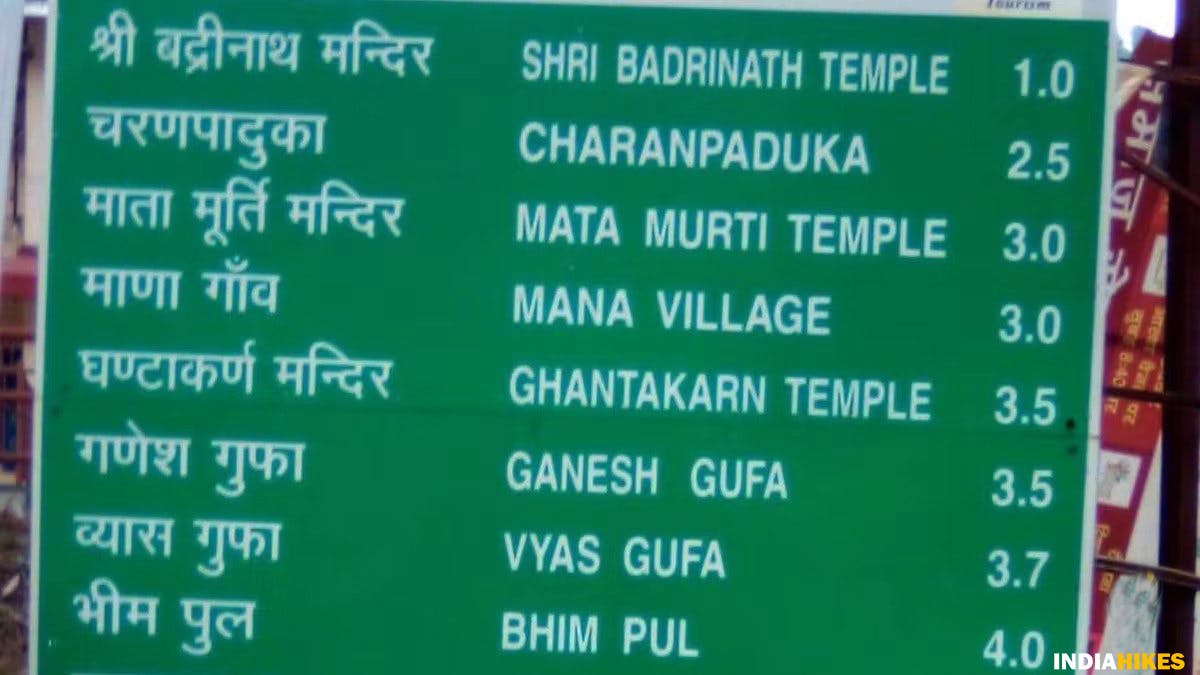
Some of the places to visit in and around Badrinath. Picture by Mahipal Bisht
Pandukeshwar Temple: This is a sacred place located between Joshimath and Badrinath. It is 18 km from Joshimath and 23 km from Badrinath.
It is believed that the King Pandu, the father of great Pandavas of Mahabharata worshipped Lord Shiva here.
Special thanks to Puttaraj Alige & Saurav Sinha for contributing and helping in documenting the trek Banner Image by Saurav Sinha
Photos Edited by Sneha.G.Iyer The trek was written by Nayana Jambhe
Upcoming Treks
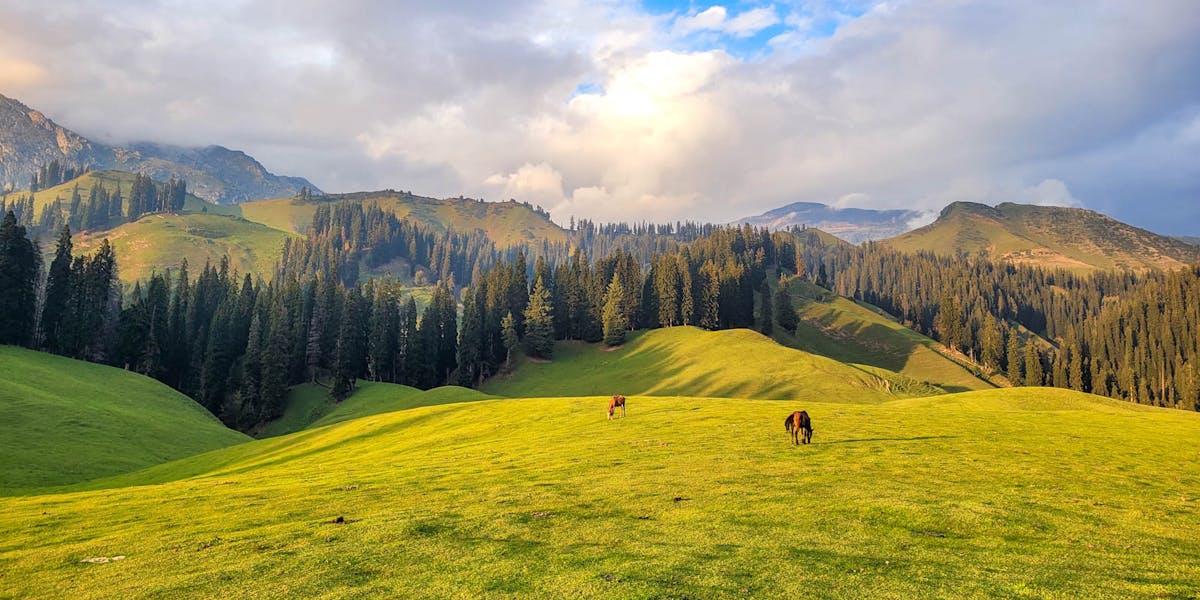
Nafran Valley
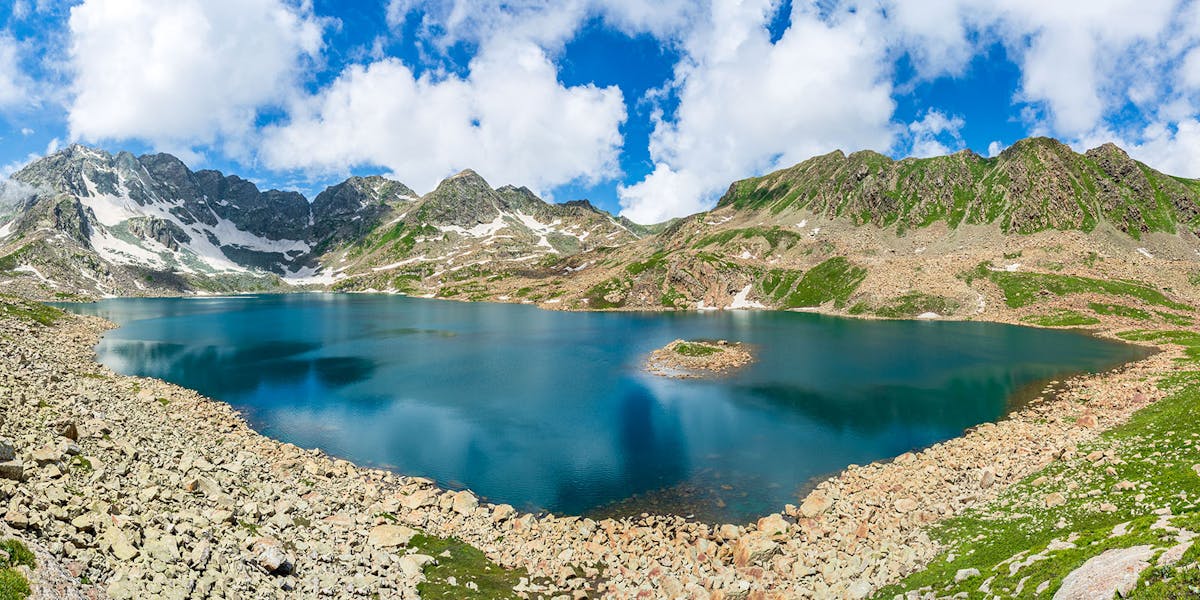
Bodpathri Trek
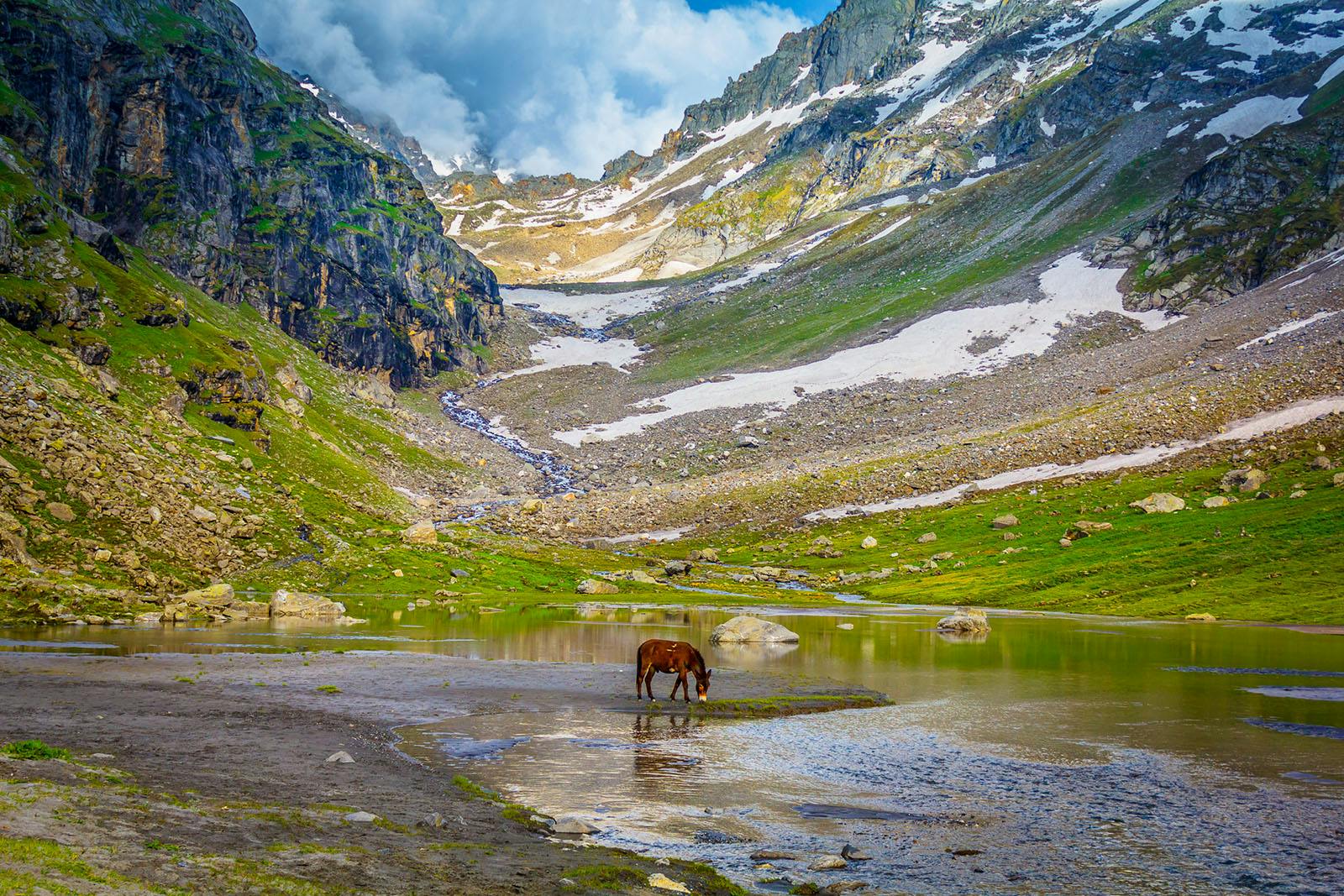
Hampta Pass

Valley of Flowers
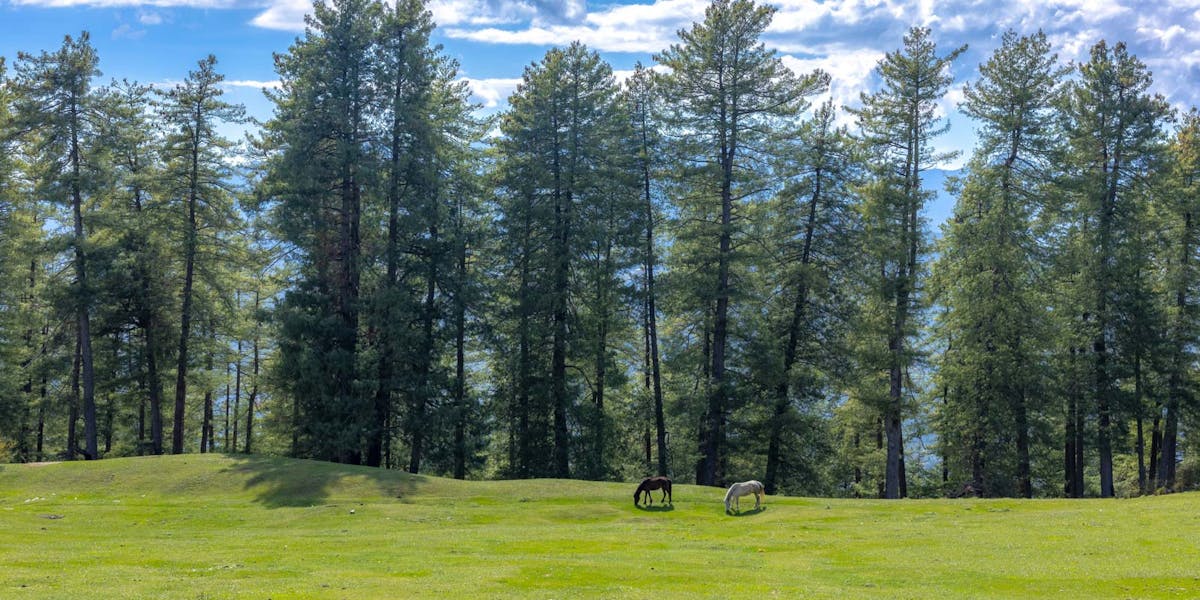
Bijli Mahadev Trek
Sign up for our much loved Weekly Mailer
We have terrific trekking tips, trek updates and trek talks to look forward to
Treks by Categories
Treks by season, treks by month, treks by duration, treks by difficulty.
- Easy - Moderate
- Moderate - Difficult
Treks by Region
- Uttarakhand
- Himachal Pradesh
- Lahaul and Spiti
- Jammu & Kashmir
- West Bengal
- Chhattisgarh
Treks by Experience
- Family Treks
- Stargazing Treks
- Senior Treks
- Adventure Therapy
- Summer Camps
- Youth Camps
- Cancellation policy
- Work with us
- Our sustainability practices
- Privacy Policy
- Terms & Conditions
080 468 01269 Mon to Sat - 9.30 AM to 7.30 PM Sun - 9.30 AM to 6.30 PM
Bengaluru Office
139, Defence Colony Road, Defence Layout, Sahakar Nagar, Bengaluru, Karnataka 560092
Dehradun Office
Mohabbewala, Titan Road, Near Titan Factory, Chandramani Khalsa Dehradun - 248002
© 2024 Indiahikes Private Limited
All images are copyrighted by their respective authors.

Satopanth Tal Trek
Satopanth tal.

Description
Reviews (2), things to take, available dates, include / exclude, the satopanth tal trek is a popular trekking route in the indian state of uttarakhand. it leads to a glacial lake called satopanth tal uttarakhand himalayas.
The Satopanth Tal trek is a captivating journey through the majestic Himalayan landscapes of Uttarakhand, India. Here’s an overview of what you can expect:
- Location : Situated in the Chamoli district of Uttarakhand, the trek starts from Mana village, which is near the famous pilgrimage site of Badrinath.
- Duration : The trek typically takes around 6-8 days to complete, depending on the route and pace chosen by trekkers.
- Altitude : The trek reaches a maximum altitude of approximately 4,600 meters (15,092 feet) at Satopanth Tal, which is a glacial lake surrounded by towering peaks.
- Terrain : The trail winds through diverse terrain, including dense forests, rocky paths, alpine meadows, and glacial moraines. Trekkers encounter steep ascents and descents, as well as river crossings along the way.
- Mana Village: Starting point of the trek and the last inhabited village on the India-China border.
- Vasundhara Falls: A stunning waterfall along the route, believed to be associated with Hindu mythology.
- Chakratirtha: A picturesque campsite offering panoramic views of surrounding peaks.
- Satopanth Tal: The ultimate destination, a pristine glacial lake surrounded by snow-clad peaks. It is considered sacred by Hindus and holds mythological significance.
- Challenges : The trek presents various challenges, including high altitude, unpredictable weather, and rugged terrain. Proper acclimatization, physical fitness, and adequate preparation are essential for a successful journey.
- Best Time to Visit : The trek is usually undertaken from May to October, during the summer and autumn months, when the weather is relatively stable and the trail is accessible. However, conditions can vary, so it’s essential to check weather forecasts and trail conditions before planning the trek.
Overall, the Satopanth Tal trek offers a memorable adventure amidst the pristine beauty of the Himalayas, attracting trekkers seeking both physical challenge and spiritual rejuvenation.
Wishes here never go unfulfilled in Satopanth Tal
Satopanth Tal is a High Altitude Lake at a height of 4,600 Meter. It is one of the virgin treks not known by many but the trekker and sadhu sant or local people of the area believe that this lake is sacred and possess some supernatural power of fulfilling wishes.
The Satopanth Tal is between two beguiling the trail is thrilling through dense forest, meadows with enchanted beauty and some steep ridges but the panorama views from the top cannot be described in words.
Trek to this sacred Tal is a difficult one but as the beliefs of people wishes are fulfilled here so it’s worth going there, this part of swargarohini the way to Heaven.
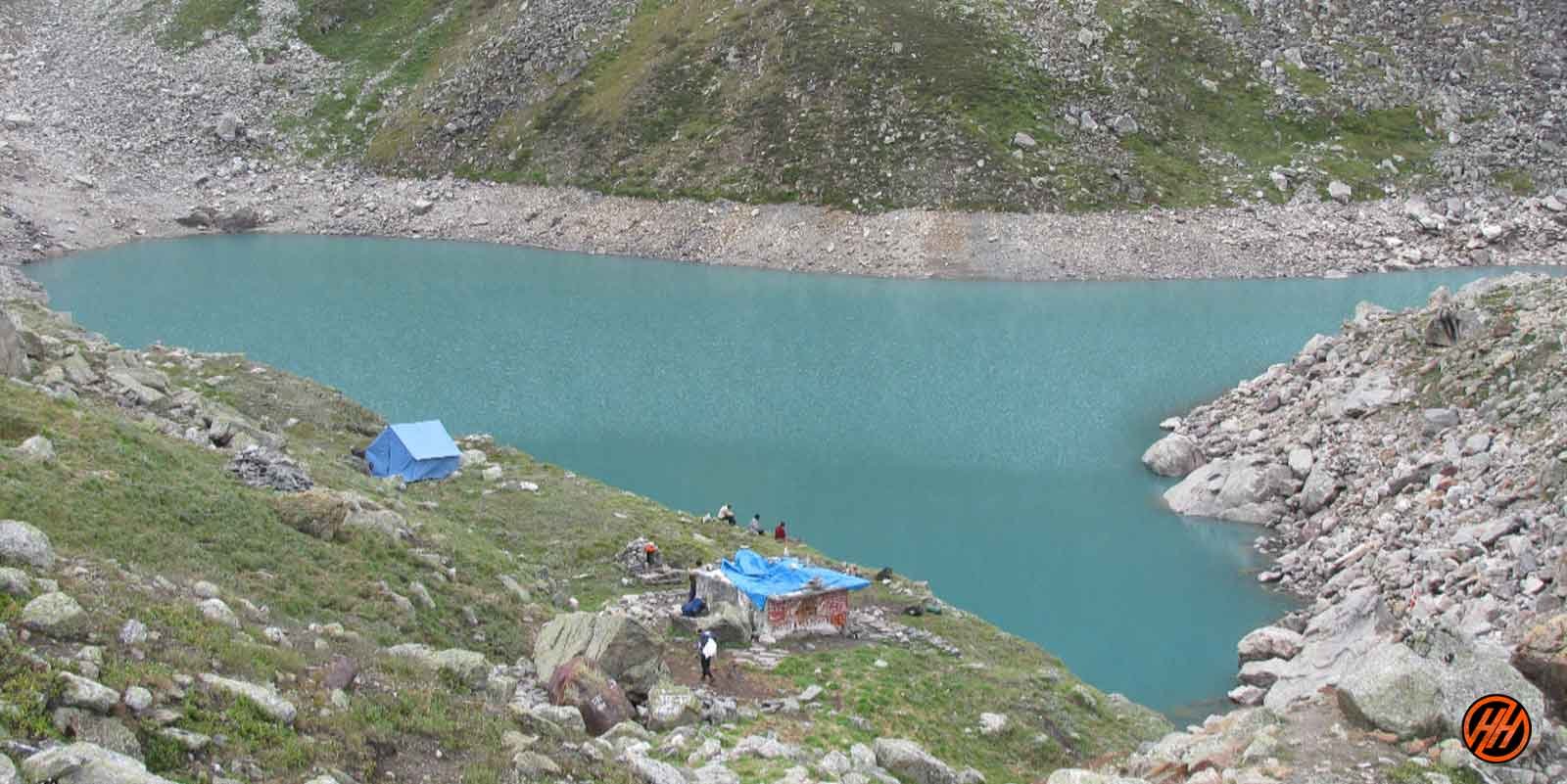
Story of Satopanth Tal Trek
It is believed that Lord Brahma, Vishnu and Mahesh often took bath in the waters of Satopanth Tal since then it is considered sacred and pure. Devotees believe that a holy dip in Satopanth Tal will wash away so every year thousands of people visit this place.
To reach this Lake, trek through some Himalayan villages , wide meadows with several streams en route and go through glaciated tracks. It is going to be an adventurous journey.
Mountain views, the great snow-capped peaks visible are Nilkanth, Swargarohini , Narayan Parbat and Balakun with some thrilling views of Chaukhamba Peaks .
Best Time to Visit Satopanth Tal Trek ?
Satopanth Tal trek is a very beautiful and an Moderate trek in the Uttarakhand Himalaya The Satopanth Tal trek is great for those people who have a great passion for mountaineering and consider it a special purpose in their life. Satopanth Tal trek is such a trek where you get to see more than one Himalayan mountain range..
You can do Satopanth Tal trek May, June, July, September, October, For those who like summer treks, they can go summer treks are a very good time for those who want to see snow Glacier Greenery .
Satopanth Tal trek is also a good trek for Monsoon trek at that time there are flowers and green greenery which makes the trek very memorable.
The Satopanth Tal trek starts from Mana Village near Badrinath in Uttarakhand, state India which comes in Gharwal Mountain Range District Chamoli
During the day the temperature of Satopanth Tal trek is around ( 08°C to 18 °C and during the night the temperature comes down to 05 °C to 08 °C which is not bad.
You will never consider yourself boring in Satopanth Tal trek , this trek can give you nothing but joy, You will get to see the Garhwali and Bhotiya, Traditional culture in mana village this trek which will always keep you connected towards the mountain. Himalayas.
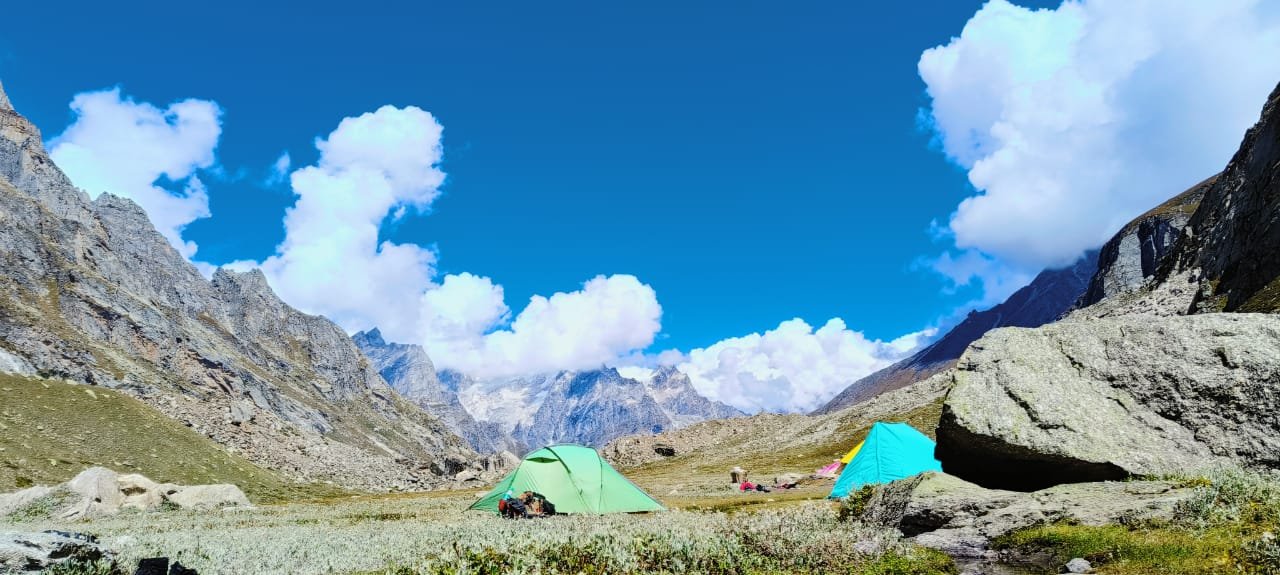
Badrinth Dham Base Camp of Satopanth Tal Swargarohini
The base camp for the Satopanth Tal trek is typically set up in or around the town of Badrinath, which serves as the starting point for the trek. Here’s an overview of Badrinath and its significance as the base camp:
- Location : Badrinath is a town located in the Chamoli district of Uttarakhand, India. Situated at an elevation of approximately 3,100 meters (10,170 feet) above sea level, it is one of the Char Dham pilgrimage sites and is revered by Hindus.
- Accessibility : Badrinath is well-connected by road to major cities like Dehradun, Rishikesh, and Haridwar. The nearest airport is the Jolly Grant Airport in Dehradun, and the nearest railway station is in Haridwar.
- Pilgrimage Site : Badrinath is famous for the Badrinath Temple, dedicated to Lord Vishnu. It is one of the holiest shrines in Hinduism and attracts thousands of devotees and tourists every year, especially during the pilgrimage season.
- Base Camp Facilities : As the base camp for the Satopanth Tal trek, Badrinath offers various facilities and amenities for trekkers, including accommodation options ranging from budget guesthouses to more comfortable hotels. Trekkers can also find restaurants, shops, and equipment rental services in the town.
- Acclimatization : Since Badrinath is situated at a relatively high altitude, it serves as an ideal location for trekkers to acclimatize before starting the trek to higher elevations. It’s essential for trekkers to spend a day or two in Badrinath to adjust to the altitude and prepare for the journey ahead.
- Starting Point : From Badrinath, trekkers begin their journey towards Satopanth Tal, following a well-defined trail that passes through scenic landscapes, including forests, meadows, and rocky terrain.
Difficulty level is Satopanth Tal trek ?
The Satopanth Tal trek is considered to be of moderate to challenging difficulty. Here’s why:
- High Altitude : The trek reaches altitudes above 4,000 meters (13,000 feet), with the highest point being around 4,600 meters (15,092 feet) at Satopanth Tal. Altitude-related challenges such as altitude sickness can affect trekkers, so proper acclimatization is crucial.
- Terrain : The trek involves a variety of terrain, including rocky paths, steep ascents and descents, glacial moraines, and possibly snow-covered sections, especially early in the trekking season. Trekking poles and sturdy footwear are recommended to navigate the terrain.
- Weather : Weather conditions in the Himalayas can be unpredictable, with the possibility of sudden changes, including rain, snow, and high winds. Trekkers should be prepared for varying weather conditions and dress accordingly with layers.
- Duration and Distance : The trek typically takes 6-8 days to complete, covering a distance of approximately 60-70 kilometers (37-43 miles) round trip. Daily hiking distances can vary, with some days involving longer stretches and more challenging terrain.
- Physical Fitness : While prior trekking experience isn’t always necessary, a good level of physical fitness is recommended to undertake the Satopanth Tal trek. Regular cardiovascular and strength training exercises can help prepare for the demands of the trek.
- Remote Location : The trek takes place in a remote and relatively isolated region of the Himalayas. Facilities such as accommodation and medical assistance may be limited along the route, so trekkers should be self-sufficient and prepared to deal with emergencie
Satopanth Tal trek trek safe for Beginner ?
Yes Satopanth Tal trek is a safe trek if you are going with a good trekking team which you must know before booking yourself, It is important for you to know that the bow trekking organization with which we are going is right or not, The minimum age required to trek Satopanth Tal trek is 12 years and maximum 60 years. The rest depends on your fitness .
- High Altitude : The trek reaches altitudes above 4,000 meters (13,000 feet), which can pose risks of altitude sickness for inexperienced trekkers. Beginners may not be accustomed to the effects of high altitude on their bodies, making them more susceptible to altitude-related illnesses.
- Physical Demands : The trek involves long hours of walking each day, covering rugged terrain with steep ascents and descents. Beginners may not have the necessary physical fitness or stamina to handle the demands of the trek, leading to exhaustion or injury.
- Limited Facilities : The trek takes place in a remote and relatively isolated region of the Himalayas, where facilities such as accommodation, medical assistance, and rescue services may be limited. Beginners may not have the experience or resources to deal with emergencies that may arise during the trek.
- Weather Conditions : Weather conditions in the Himalayas can be unpredictable, with the possibility of rain, snow, and high winds. Beginners may not have the knowledge or equipment to deal with adverse weather conditions, increasing the risks associated with the trek.
- Experience : The Satopanth Tal trek requires some level of prior trekking experience to navigate the terrain, manage altitude-related challenges, and ensure safety throughout the journey. Beginners may benefit from starting with shorter and less challenging treks to build up their skills and confidence before attempting more difficult treks like Satopanth T
What should you keep in mind for the Satopanth Tal trek?
Satopanth Tal trek trek is as good as it is said, you also need to be prepared., Satopanth Tal is a moderate trek which starts from Mana Village and ends after trek Mana Village
So what are the special things to keep in mind before coming on this trek?
Satopanth Tal trek is one such trek, which you can do this trek Summer, or Monsoon, this is very safe trek in Uttarakhand Himalayas.
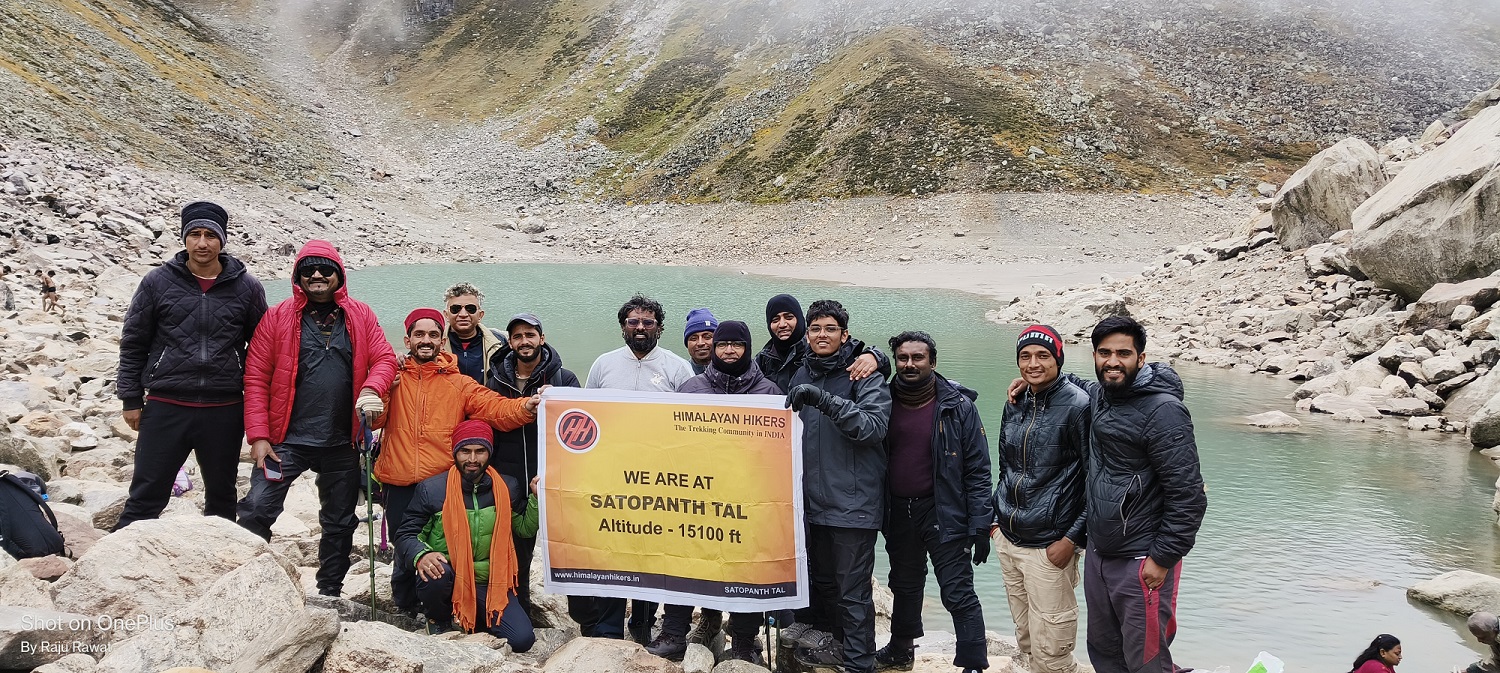
Summer Season
- Summer trek to Satopanth Tal is very special, the view and the temperature are all favorable to you
- For summer trek, you have to bring only normal clothes, so that your trek can be good, there is no need for hot clothes, but in hiking it is also necessary to bring all the equipment which is necessary for you.
- It is necessary to have 3 pairs of clothes from trekking, especially the poncho, you will have to bring every season
- In the summer season, the temperature is always normal, so there is no need for hot clothes.
Monsoon Season
- During the monsoon season, it rains occasionally during the Satopanth Tal trek especially in the Uttarakhand Himalayas , so if you have dry clothes here, it is very good, even when wet, it dries quickly.
- At this time you have to bring at least 3 pairs of clothes, for monsoon trek you do not have to bring too warm clothes, at this time you, hiking pants and t-Sart, I can trek
- It’s only a little cold in the morning and evening and the day is a good temperature for you
- Before going on any trek, it will be easy for you to take information related to each season.
- Trekkers need to know about these, you can ask us anytime like, Satopanth Tal trek route, trek map, temperature, weather condition, difficulty level, trek starting point, end point, transport, view of the trek, best time to visit, How to reach Satopanth Tal distance etc, Trek Location, keep this information before going
- 5. You also find some types of flowers in Satopanth Tal which are very beautiful, these treks are very safe trek for monsoon.
Brief Details of Satopanth Tal?
Before heading towards the itinerary, it is really essential to perceive the reason behind choosing Satopanth Tal trek.
See firstly, the trekking distance is a total of by taxi 680 Km both side and on foot 46 km which is to be covered into 07 days. Dehradun to Dehradun
Satopanth Tal is a high altitude mountain trek Altitudes is 4600 meters
The Starting trail is moderate as compare to other treks this is moderate trek. So this trek is good for beginners’ trekkers
Need proper gear & clothing for sub-zero temperature?
You got to see so many heavenly bodies at one place like the panoramic view of the Himalayan ranges, you can see pine forests, different variety of flora and fauna surpassing through bona fide Garhwali culture.
I think Do spare time in Interaction with our local’s team, and you will get to know about some of the ancient tales of Indian mythology and our local cultures, this is good ideas for trekkers
Beautiful landscapes so carry proper photo gear & Extra battery backup.
The backpack should not exceed 12 kg only
Trekker carry your Photo ID , Adhar card , Passport , Visa , for entry at forest check posts on the trek it is very important
Alcohol and non-Veg and smoking is not allowed in during the trek
Altitude we are going to cover in Satopanth Tal
Joshimath (6152 feet)
Laxmivan (08 km) (4/5 Hours) (12,510 feet)
Chakratirth (13,655 feet)
Satopanth tal (14,755 feet)
Key Points of Satopanth Tal Trek
Duration: – 07 Nights 08 Days from Dehradun to Dehradun
Base camp: – Badrinath
Summer Temperature: – Day (5°C to 15°C) Night (6° C to 12° C)
Satopanth Tal – Altitude: – (17,987 feet)
Best Time: – May, June, September, October
Trek Level: – Moderate
Trek distance: – On foot 46 Km – By taxi 680 km
Group Size: – 15 people
Short Itinerary of Satopanth Tal –
Day 1– Drive from Dehradun to Joshimath Altitude – Joshimath by taxi (256 Km) (10/11 Hours) (1,875 m/ 6152 feet) Overnight stay Hotel
Day 2- Drive from Joshimath to Badrinath by taxi (48 km) (2/3 Hours) Reach hotel need proper acclimatization Overnight stay Hotel
Day 3- Trek from Badrinath to Laxmivan (08 km) (4/5 Hours) (12,510 feet) Overnight stay Camp
Day 4- Trek from Laxmivan to Chakratirth (10 km) (5/6 Hours) (13,655 feet) Overnight stay Camp
Day 5- Trek from Chakratirth to satopanth Tal (10 km) (8/9Hours) (14,755 feet) back to Camp Overnight stay Camp
Day 6- Trek from Chakratirth to Laxmivan (10 km) (4/5 Hours) Overnight stay Camp
Day 7- Trek from Laxmivan to Badrinath via mana village (08 km) Overnight stay Hotel
Day 8- Drive from Badrinath to Dehradun by taxi (380 km) (11/12 Hours)
Things Himalayan Hikers recommend
As previously stated, a camera, as well as spare batteries and memory cards, are recommended. We can assure and guarantee that you will be stopping frequently along the trail to observe the grandeur of the trekking experience.
After the trek, we strongly encourage trekkers to tag us on social media when they post any memories from the trip; this will not only prove invaluable to us with our work, but will also serve as a motivational example for all of our experts.
Why you should choose us
We’re here to give you the greatest experience possible through the eyes of highly skilled and qualified specialists who have a passion for adventure sports. We are community members attempting to promote our favorite adventure sports while also supporting local businesses. We, at Himalayan hikers Local trekking organization in Uttarakhand , dedicate ourselves to providing you with an unforgettable experience.
Weather conditions satopanth tal
The weather conditions around Satopanth Tal can vary depending on the season and altitude. Here’s an overview of the typical weather conditions you might encounter during different times of the year:
- Spring marks the beginning of the trekking season in the region.
- Weather gradually warms up, but temperatures can still be chilly, especially at higher altitudes.
- Days are generally pleasant with clear skies, making it a popular time for trekking.
- However, occasional snowfall or rain showers may occur, especially in March and early April.
- Summer brings warmer temperatures to the region, but it’s also the monsoon season.
- Expect frequent rainfall, especially in July and August, which can make trekking trails muddy and slippery.
- Cloud cover may obscure mountain views, but the surrounding landscape is lush and green.
- Autumn is another popular trekking season characterized by clear skies and stable weather conditions.
- Days are generally sunny with comfortable temperatures, making it ideal for trekking.
- The foliage begins to change colors, creating stunning views of the surrounding mountains.
- Nights can be cold, especially at higher elevations, so be prepared with warm clothing.
Things to carry
1) Because nights at higher elevations tend to be substantially colder, we suggest having well-graded, warm and comfortable clothing along with good quality shoes.
2) Despite the fact that we handle medical crises, we urge individuals to keep their emergency kits at hand in any case of personal underlying illnesses.
3) Since the journey provides you with a picturesque view, don’t forget to bring your camera along with extra batteries.
4) All the trekking gears will be provided by our teams hence a we recommend carrying only the important luggage with essentials
You r Travel Plan for the Satopanth Tal Trek
You can book trains, air flights, and bus tickets for your journey only according to the information given by us.
The Satopanth Tal trek will be of 6 days and 02 days of your journey total of 08 Days from Dehradun to Dehradun
First of all, all the trekkers will have to book their flight and train bus according to our time table as our pick up is from 6 am to 7 am, you will have to reach Dehradun in the morning.
A taxi from Himalayan Hikers will link you to the Dehradun Railway station.
Himalayan Hikers organize transport to Badrinath base camp from Dehradun Railway station. Our vehicles leave at 6:00 am to 7:00 am sharp from Dehradun
In the Dehradun Railway Station, you will get our staff that will arrange transport for you. The contacts no Transport coordinator or our office team will give you a week ago to your departure
Please you guys book your transport facility according to your own time table, after Himalayan Hikers take all the responsibility of Dehradun to Dehradun , that you will not face any problem.
How to reach Satopanth Tal Trek ?
If you are Traveling from Kolkata, Bangalore, Chennai, Pune, Mumbai, Maharashtra, or Gujarat, Delhi Hyderabad any other State , so you will have to come to Delhi, you will get a train from Delhi for Dehradun comfortably.
Option 01:- By Train
All trekkers booked yourself the,
Nanda Devi Express to Dehradun v (Train no is 12402 Departure 11:30 pm: – Reached Haridwar 3:53 am a morning
Take the overnight train Dehradun to from new Delhi- Dehradun Special A/C train from Hazrat Nizamuddin railway station the best option for you. The train reached at Haridwar railway station morning 3:53 am to 4:30 am if you Meet to Our office Member – joining to our upcoming batches and Group.
Option 02:- By Air –
Jolly Grant airport is the nearest airport in Dehradun , Rishikesh or Haridwar, Located about 27 km for the Dehradun main city. There are flights available from all states to Dehradun Airport, you can go online and book your tickets. These are easy and easy ways for you and you also save your time, Taxis are available from the airport to Dehradun, Rishikesh or Haridwar at all time costs Rs. 1000/* one-way pay to directly
Option 03:- By Bus
You can reach Dehradun Bus Stand ISBT from Delhi by a bus, board it from (Delhi) Kashmiri Gate ISBT; it is good if you are booked the seats.
Day 1 : Pickup from Dehradun/Haridwar Railway Station and Drive to Joshmath by Taxi or tempo travellers
Total distance – 280 km – 10/11 Hours journey
Mode of journey – By taxi
Altitude – Joshimath– 6152 feet
Night stay – Hotel – on twin share basis
Himalayan Hikers organizes transport for trekkers from Haridwar Railway Station in the morning which will leave for Sankri around 6:00 am to 7:00 am.
The journey from Dehradun or Haridwar Railway Station to Joshimath typically involves a scenic drive through the Himalayan foothills and passes through several towns and villages. Here’s an overview of the route and some key points of interest along the way:
- Your journey begins at either Dehradun or Haridwar Railway Station, depending on your starting point.
- Dehradun is the capital city of Uttarakhand and offers picturesque views of the Shivalik range.
- Haridwar is a sacred city situated on the banks of the Ganges River, known for its temples and ghats.
- Rishikesh is a popular stopover point known as the “Yoga Capital of the World.”
- The town is renowned for its spiritual significance, yoga ashrams, and adventure activities like river rafting.
- Devprayag is the confluence of the Bhagirathi and Alaknanda rivers, which merge to form the Ganges River.
- It’s a significant pilgrimage site and offers stunning views of the confluence.
- Not to be confused with the city in Jammu and Kashmir, Srinagar is a town in Uttarakhand known for its scenic beauty.
- It’s situated on the banks of the Alaknanda River and offers beautiful views of the surrounding mountains.
- Chamoli is a district headquarters town and serves as a major administrative center in the region.
- The town is surrounded by lush greenery and offers glimpses of traditional Garhwali architecture.
- Joshimath is a significant town and a gateway to several Himalayan treks, including the trek to Satopanth Tal.
- It serves as a base camp for pilgrims visiting the revered temples of Badrinath and Hemkund Sahib.
- The town offers breathtaking views of the Nanda Devi and Neelkanth peaks.
Day 2 : Drive from Joshimath to Badrinath by taxi or tempo travellers overnight stay Hotel
Total distance – 48 km – 2/3 Hours journey
Altitude Badrinath– 10,170 feet
Night Stay – Hotel – on twin share basis
The journey from Joshimath to Badrinath is a picturesque drive through the Garhwal Himalayas, offering stunning views of snow-capped peaks, lush valleys, and sacred rivers. Here’s an overview of the route and some notable locations you’ll encounter along the way:
- Your journey begins in Joshimath, a significant town in the Chamoli district of Uttarakhand.
- Joshimath serves as a base camp for treks to several Himalayan peaks and pilgrimage sites, including Badrinath.
- Vishnuprayag is the first of the Panch Prayag (five confluences) along the Alaknanda River.
- It marks the confluence of the Alaknanda and Dhauliganga rivers, with a picturesque setting surrounded by mountains.
- Hanuman Chatti is a small village and a popular starting point for the trek to the holy shrine of Yamunotri.
- It’s located at the confluence of the Hanuman Ganga and Yamuna rivers, offering serene natural beauty.
- Mana Village is the last inhabited village on the India-China border and holds mythological significance.
- It’s believed to be the home of Vyasa, the author of the Mahabharata, and attracts pilgrims and tourists alike.
- Bheem Pul is a natural rock bridge over the Saraswati River, named after the Pandava prince Bheem from the Mahabharata.
- Legend has it that Bheem placed this bridge to help Draupadi cross the river during their exile.
- Badrinath is one of the Char Dham pilgrimage sites and is dedicated to Lord Vishnu.
- The town is nestled between the Nar and Narayana mountain ranges and offers breathtaking views of the Neelkanth peak.
- The Badrinath Temple, dating back to the 8th century, is the main attraction and draws thousands of devotees each year.
The drive from Joshimath to Badrinath takes approximately 1.5 to 2 hours, covering a distance of around 45 kilometers (28 miles). The route offers spectacular vistas of the Himalayan landscap
Day 3 : Trek from Badrinath to Laxmivan overnight stay Camp
Trek Distance – 08 km – 4/5 Hours journey
Mode of journey – On foot
Altitude – Laxmivan – 12,510 feet
Night Stay – Camp – on twin share basis
The trek from Badrinath to Laxmivan is a scenic journey through the Himalayan wilderness, offering breathtaking views of snow-capped peaks, alpine meadows, and pristine forests. Here’s an overview of the trek route, difficulty level, location, and overnight camping options:
- The trek from Badrinath to Laxmivan typically follows a trail that ascends gradually through the valley alongside the Saraswati River.
- The route passes through dense forests of pine, deodar, and rhododendron trees, offering opportunities to spot diverse flora and fauna.
- Along the way, trekkers may encounter small streams, waterfalls, and picturesque meadows, making for a scenic journey.
- The trek from Badrinath to Laxmivan is considered to be of moderate difficulty.
- While the trail is generally well-defined, it involves ascending terrain and some steep sections.
- Trekkers should have a reasonable level of fitness and be prepared for several hours of hiking each day.
- Badrinath: The trek begins in the town of Badrinath, located in the Chamoli district of Uttarakhand. Badrinath is a significant pilgrimage site and serves as the base for treks to various destinations in the region.
- Laxmivan: Laxmivan is a scenic camping site located at an elevation of around 3,500 meters (11,500 feet) above sea level. It’s situated amidst lush green meadows surrounded by towering peaks, offering a serene and picturesque setting for overnight camping.
- Laxmivan serves as an ideal overnight camping site for trekkers en route from Badrinath to higher altitudes.
- Trekkers can set up their tents amidst the meadows and enjoy stunning views of the surrounding mountains.
- It’s advisable to carry camping equipment, including tents, sleeping bags, and cooking supplies, as facilities may be limited in remote areas like Laxmivan.
- En route to Laxmivan, trekkers are treated to panoramic views of the Neelkanth peak and other snow-capped mountains.
- The trek offers opportunities for birdwatching and wildlife spotting, with chances to see species like the Himalayan monal, musk deer, and langur monkeys.
- Laxmivan provides a tranquil setting for stargazing and experiencing the serenity of the Himalayan night sky.
Day 4 : Trek from Laxmivan to Chakratirth overnight stay Camap
Trek Distance – 10 km – 5/6 Hours journey
Altitude – Chakratirth – 13,655 feet
The trek from Laxmivan to Chakratirth is another enchanting leg of the journey through the Himalayan wilderness, offering stunning landscapes and serene camping spots. Here’s an overview of the route, overnight camping options, distance, trek level, and scenic highlights:
- The trek from Laxmivan to Chakratirth continues along a well-defined trail that winds through alpine meadows and rocky terrain.
- The route gradually ascends, offering panoramic views of the surrounding peaks and valleys.
- Trekkers will pass through patches of dense forests, open meadows, and possibly encounter small streams along the way.
- Chakratirth serves as an excellent overnight camping site for trekkers en route from Laxmivan to higher elevations.
- Located at an altitude of around 3,800 meters (12,500 feet) above sea level, Chakratirth offers expansive meadows surrounded by snow-capped peaks.
- Trekkers can set up their tents amidst the meadows and enjoy the tranquility of the Himalayan wilderness under the starry night sky.
- The distance from Laxmivan to Chakratirth is approximately 5-6 kilometers (3-4 miles), depending on the specific route taken.
- The trek typically takes around 3-4 hours to complete at a moderate pace, allowing time for breaks and enjoying the scenery.
- The trek from Laxmivan to Chakratirth is considered to be of moderate difficulty.
- While the trail is generally well-marked, it involves some steep sections and rocky terrain, requiring a reasonable level of fitness and hiking experience.
- Trekkers should be prepared for several hours of hiking and be cautious of altitude-related challenges as they ascend to higher elevations.
- Along the route, trekkers are treated to breathtaking views of the surrounding Himalayan peaks, including Neelkanth, Chaukhamba, and Hathi Parbat.
- Chakratirth offers a serene setting with lush green meadows, colorful alpine flowers, and the soothing sound of mountain streams.
- The area is ideal for photography enthusiasts, offering stunning vistas at every turn and opportunities to capture the beauty of the Himalayan landscape.
Day 5 : Trek from Chakratirth to Satopanth Tal summit then back to Camp
Trek Distance – 05 km – 4/5 Hours journey
Mode of journey – ON foot
Altitude – Satopanth Tal – 14,755 feet
Start the trek early today because you will be crossing some tricky sections on the trail. Ascent to the ridge’s high point and trek along the glacier to reach serene triangular “Satopanth Lake”. Get impressive views of Chaukhamba peaks and Neelkanth Mahadev.
The trek from Chakratirth to Satopanth Tal and back is the highlight of the journey, offering trekkers an opportunity to witness the stunning beauty of Satopanth Tal, surrounded by towering Himalayan peaks. Here’s an overview of the route, altitude, location, and scenic highlights:
- The trek from Chakratirth to Satopanth Tal involves ascending along a challenging trail that passes through rocky terrain, moraines, and possibly snow-covered sections.
- The route follows a gradual ascent, offering panoramic views of the surrounding mountains and valleys.
- Trekkers will cross streams, negotiate steep inclines, and navigate through high-altitude terrain before reaching the pristine shores of Satopanth Tal.
- Satopanth Tal is situated at an altitude of approximately 4,600 meters (15,092 feet) above sea level, making it one of the highest points of the trek.
- The ascent from Chakratirth to Satopanth Tal involves a significant altitude gain, so trekkers should acclimatize properly and pace themselves accordingly.
- Satopanth Tal is located in the Garhwal Himalayas of Uttarakhand, India, near the town of Badrinath.
- The glacial lake is surrounded by majestic peaks, including Neelkanth, Chaukhamba, and Balakun, creating a breathtaking backdrop for trekkers.
- Along the trekking route, trekkers are treated to stunning vistas of the surrounding Himalayan peaks, including snow-capped mountains, alpine meadows, and cascading waterfalls.
- Satopanth Tal itself is a mesmerizing sight, with its crystal-clear waters reflecting the azure sky and towering peaks.
- The area around Satopanth Tal is tranquil and serene, offering trekkers a chance to relax and soak in the natural beauty of the Himalayas.
- After spending time at Satopanth Tal, trekkers will retrace their steps back to their campsite at Chakratirth.
- The descent involves navigating the same trail in reverse, offering different perspectives of the landscape and allowing trekkers to enjoy the scenery from a new angle.
Overall, the trek from Chakratirth to Satopanth Tal and back is a challenging yet rewarding adventure, offering trekkers an opportunity to experience the pristine beauty of the Himalayas
Day 6 : Trek from Chakratirth to Laxmivan overnight stay Camp
Trek Distance – 10 km – 4/5 Hours journey
Mode of journey – on foot
Night Stay – Camp – on twin share basis
The trek from Chakratirth to Laxmivan offers trekkers a scenic journey through the Himalayan wilderness, with opportunities to enjoy the tranquility of the alpine meadows and majestic views of the surrounding peaks. Here’s an overview of the route and overnight camping options:
- The trek from Chakratirth to Laxmivan involves descending from the higher altitude of Chakratirth back to the serene meadows of Laxmivan.
- The trail may follow the same route taken during the ascent or may vary slightly, depending on the specific trekking itinerary.
- Trekkers will pass through lush forests, open meadows, and possibly encounter small streams along the way.
- Laxmivan serves as an ideal overnight camping site for trekkers descending from higher altitudes.
- Trekkers can set up their tents amidst the picturesque meadows and enjoy the tranquility of the Himalayan wilderness.
- Laxmivan offers a serene setting with panoramic views of the surrounding peaks, making it an ideal spot to rest and rejuvenate after a day of trekking.
Day 7 : Trek from Laxmivan to Badrinath via mana village
Mode of journey – By taxi – 15 km – On foot – 13 km
Altitude – Swargarohini base camp – 17,987 feet
Night Stay – Hotel – on twin share basis
The trek from Laxmivan to Badrinath via Mana Village offers trekkers a scenic and culturally enriching journey through the Himalayan landscape. Here’s an overview of the route:
- The trek from Laxmivan to Badrinath via Mana Village involves descending from the higher altitude of Laxmivan to the town of Badrinath, passing through the picturesque Mana Village along the way.
- The trail may follow a combination of descending paths through forests, meadows, and rocky terrain as it winds its way down to lower elevations.
- From Laxmivan, trekkers begin their descent towards Mana Village, trekking through alpine meadows and possibly crossing small streams.
- Trekkers will pass through scenic landscapes, including lush forests and open meadows, with opportunities to enjoy panoramic views of the surrounding mountains.
- From Mana Village, trekkers continue their descent towards Badrinath, following well-defined trails that wind through the Himalayan foothills.
- The trail may pass through quaint villages, terraced fields, and patches of dense forests, providing glimpses of local life and culture.
- Trekkers will eventually reach the town of Badrinath, a significant pilgrimage site and home to the revered Badrinath Temple dedicated to Lord Vishnu.
Day 8: Drive from Badrinath to Dehradun by taxi or tempo travellers
Distance – 328 km – 11/12 Hours journey
Mode of journey – By Taxi
The drive from Badrinath to Dehradun by taxi or tempo traveler offers travelers a scenic journey through the Himalayan foothills and valleys of Uttarakhand. Here’s an overview of the route:
- Your journey begins in the town of Badrinath, a significant pilgrimage site and home to the revered Badrinath Temple dedicated to Lord Vishnu.
- Badrinath is nestled between the Nar and Narayana mountain ranges, offering breathtaking views of the surrounding peaks.
- As you leave Badrinath, you’ll pass through Mana Village, the last inhabited village on the India-China border.
- Mana Village holds mythological significance and offers glimpses of traditional Himalayan culture and architecture.
- Chamoli is the district headquarters town and serves as a major stopover point along the route.
- The town is surrounded by lush greenery and offers picturesque views of the Alaknanda River and surrounding mountains.
- Srinagar is a town situated on the banks of the Alaknanda River and serves as another significant stopover point.
- The town offers opportunities to stretch your legs and enjoy local cuisine before continuing your journey.
- Devprayag is the confluence of the Bhagirathi and Alaknanda rivers, where they merge to form the Ganges River.
- The town is a sacred pilgrimage site and offers stunning views of the confluence.
- Rishikesh is a major town known as the “Yoga Capital of the World” and offers opportunities for adventure activities like river rafting and bungee jumping.
- It’s a popular stopover point where travelers can rest and explore before continuing their journey.
- Your journey ends in Dehradun, the capital city of Uttarakhand, known for its picturesque landscapes and colonial architecture.
- Dehradun is well-connected by road and rail to major cities like Delhi and offers plenty of accommodation options for travelers.
Mandatory Documents
Please carry the documents given below.
Original and photocopy of government photo identity card- (Aadhar Card, Driving License, Voters ID, etc, Passport and Visa important to foreigners Medical Certificate (First part should be filled by the Doctor and Second part by the Trekker) Declaration Certificates
Note: – Many trekkers commit the same mistake of carrying unnecessary items on a trek which only makes the backpack heavy. It is important to know the right items to carry. It differs from season to season if you are trekking in summers then carry less layers of warm clothing and if you are trekking in winters carry enough layers to protect yourself against chilly cold.
Necessary Items for trekkers

Backpack (50 to 60 liters) A strongly built backpack with good support is compulsory for a trek. (Rain cover is important)
Sturdy Trekking Shoes The shoes should be strong enough with good support. The people ask if sports shoes would be comfortable but it is good to bring the right trekking shoes.
The Clothes You Should Bring On a Trek Avoid keeping extra clothes because it only makes you backpack heavy.
Trek Pants – The jeans are never suitable for a trek so you need at least 2-3 trek pants for treks carry more for longer treks.
Jacket – Jackets are very important to carry on a trek it protects you against the chilly weather. So carry 2 jackets on a week long trek.
Layers of warm Clothing Carry warm woolen layers or fleece. Carry more layers during winter season (at least 2 to 3) and less during summer.
Thermals – The Temperature decreases at night so you might be need thermals for Night.
T- Shirts – Bring those t shirts which dry fast.
Poncho –They are needed if you are trekking on a Rainy day to keep you dry.
Hiking Pole
Water Bottle 2
Cap or Balaclava
Woolen and Waterproof Gloves
Socks (Woolen and Regular)
Torch head light
Personal Toiletry Items – (toothpaste, toothbrush, toilet paper, sanitizer etc.)
Carry Personal Medical Kit
Personal Medical Kit (Carry minimum 5 tablets and maximum 10)

Diamox – (Prevents altitude sickness)
Digene – (It cures discomfort in stomach, acidity)
Crocin Advance – (Cures fever and headache)
Aspirin/Combiflam – (Pain reliever)
Disprin – (Cures headache)
Avomine – (Prevents motion sickness)
Avil – (It treat allergies)
Norflox TZ & Lomofen – (Prevents Diarrhoea)
Ranitidine – (Reduces the amount of acid in stomach)
Volini/Moov spray – (For sprains)
Betadine/Savlon – (Antiseptic cream)
Stretchable/Elastic bandage
Note:- Use medicines only when prescribed by the doctor. In case you face any problem during your trek, discuss and take advice from the Professional guide.
Sorry! Here are no Available dates right now. For Any Queries you can Email us with [email protected] and Call Us +91 9756197558
- Satopanth Tal trek we do in small group, Small group is always safe and good, our own experience is that special care can always be taken for trekkers in small group
- We need to have minimum 5 people for Satopanth Tal
- Groups of up to 15 people are safe in Satopanth Tal
- We always tell Trekkers that you can feel yourself very comfortable with your own group
- One thing should always be kept in mind that in high altitude treks, only a small group should always be taken so that you can experience peace and joy.
- In small groups, always the group can be supervised very well
What is Included In This Trek?
Transport Facility
Forest Permit and entrance fee
Accommodation in tents on twin share basis
All meals: breakfast, packed lunch, tea, coffee, snacks, soup and dinner
(All camping gears)
High quality tents
Sleeping bags
Separate Toilet tents – Ladies and Gents
Dining Tent
Dining Table
Kitchen team
Radio Walkie Talkie for Communication
Good Experience Trek Leader guide and Technical guide
Medical Kit
Oxygen Cylinders
Crampons and Gaiters
What is Not Included In This Trek?
Personal Insurance
Medical Certificate
Personal toiletry Items and Personal Medicine kit
On first day En Route to base camp the Breakfast and Lunch are Not Included
Last Day En Route Lunch and Dinner are Not Included
2 reviews for Satopanth Tal Trek
Palash – November 19, 2019
Well organised
santanu das – November 19, 2019
Satopanth our first trek with Himalayan hikers, this is good company in Uttarakhand,, service and food very good, thanks to Himalayan hikers all team
Your email address will not be published. Required fields are marked *
Name *
Email *
Save my name, email, and website in this browser for the next time I comment.
Related Tours
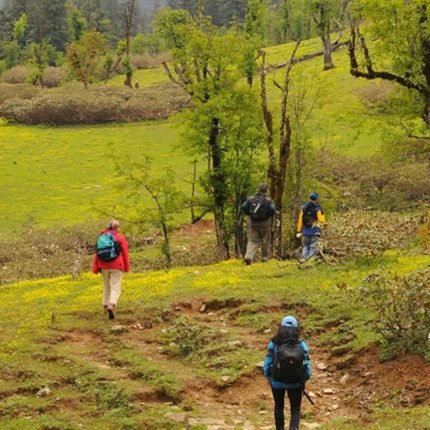
Sarutal Trek
The Saru Tal Trek is most beautiful trek in the Himalayas
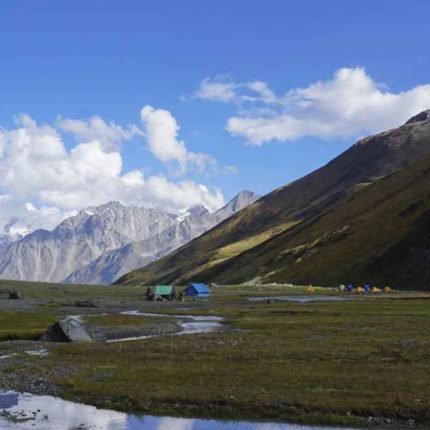
Pin Bhaba Pass Trek
Pin Bhabha Pass – The Stunning dark forests of Mulling
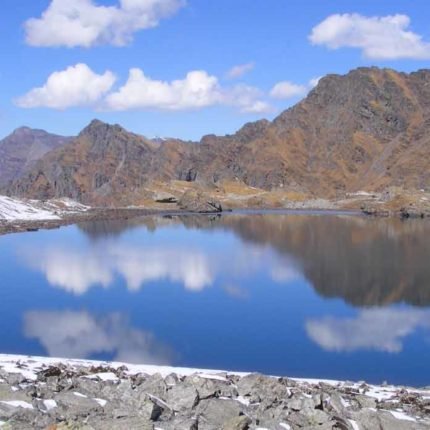
Baraadsar Lake Trek
Trek to a phenomenal “Wish fulfilling Lake” “Baraadsar Lake”.
Price: ₹ 30,000.00
Book the tour
Send a quick enquiry.
- Overview Itinerary Dates Include/Exclude
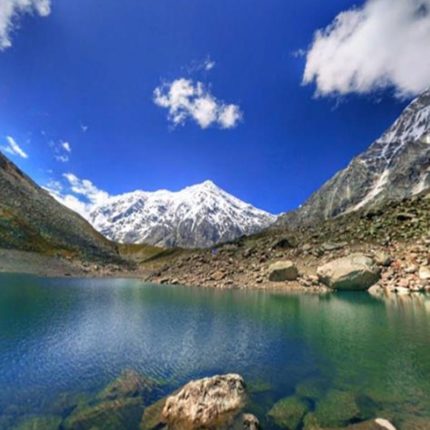
Best summer destinations : Chopta - Nainital - Mussoorie - Kanatal - Dhanaulti - Chakrata - Auli - Kausani - Mukteshwar - Chaukori - Pangot
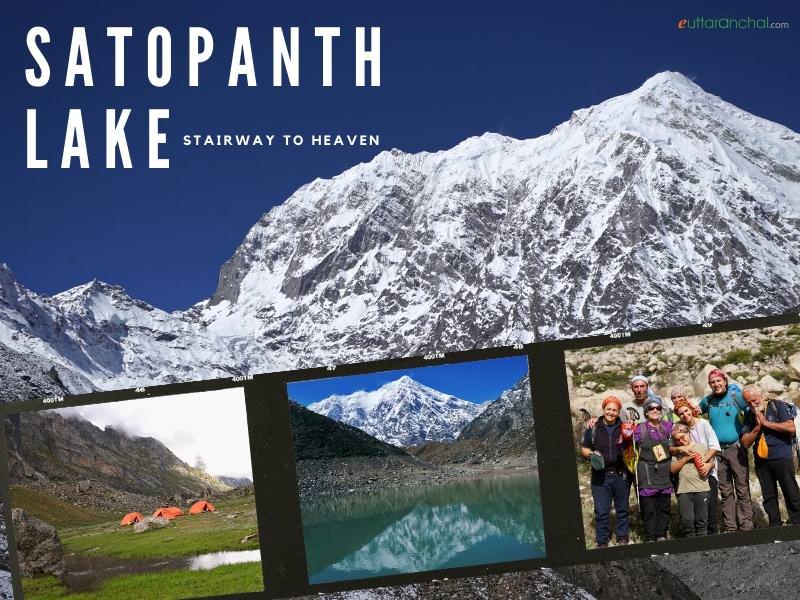
- Satopanth Trek
- Uttarakhand
- Uttarakhand Tourism
- 2 Tour Packages
- Send Enquiry
Satopanth - Glacial Lake of Divinity
Satopanth Tal is a crystal clear green water, the triangular lake at an elevation of 4600 meters above sea level and is adorned in the midst of the snow-shrouded peaks. Satopanth Tal is a high altitude lake located in Chamoli district of Uttarakhand and near to Badrinath Shrine .
Apart from religious significance Satopanth also become one of the Popular treks in Uttarakhand . This glacier trek offers majestic views of Himalayas.
Get Satopanth Lake Trekking Guide, Trek Updates, Satopanth Travel Tips
- Satopanth Trek Tour Packages
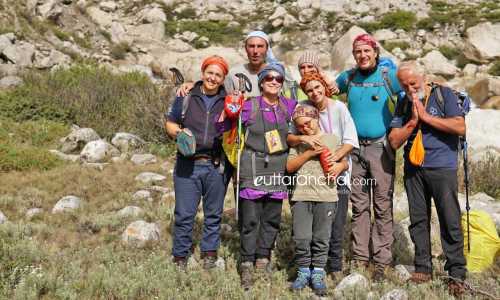
- Tour Packages
- How to Reach
Why you should gear yourself up for the venerated Satopanth trek?
The pea-green Satopanth Lake is celebrated for its holiness and mysticism which tempts many avid travellers to gear up for commencing the Satopanth Tal trek. The virgin trail leading to Satopanth can be easily accessed by crossing Lakshmi Van and Chakratirtha. This rewarding trek will offer you unobstructed view of the snow crested Chaukhamba and many other peaks. You will have euphoric spiritual as well as mental bliss while reaching at this lake.
The trail to the lake rewards trekkers with abundant natural beauty in the form of snow-clad peaks, verdant hills covered with pine and oak trees, gushing rivulets and streams.
Best Suggested Itinerary for Satopanth Trek
Day 01: Rishikesh - Badrinath Early morning catch the bus to Badrinath from Rishikesh and have lunch en-route. On reaching Badrinath , pay obeisance at the Badrinath temple and take the blessings of the deity. Check it at a hotel, have dinner and overnight stay.
Day 02: Badrinath - Lakshmi Van Post breakfast, check out from the hotel and commence a short 3 km trek to Mana (you can take local taxi as well), the last village of India on the Indo-Tibetan border. After getting your permits checked, make your advancement towards the Vasundhara Falls . After crossing the Saraswati temple from Mana, the gradient of the trek will become steeper. Walk-in harmony with the mighty Alakananda River, flowing below.
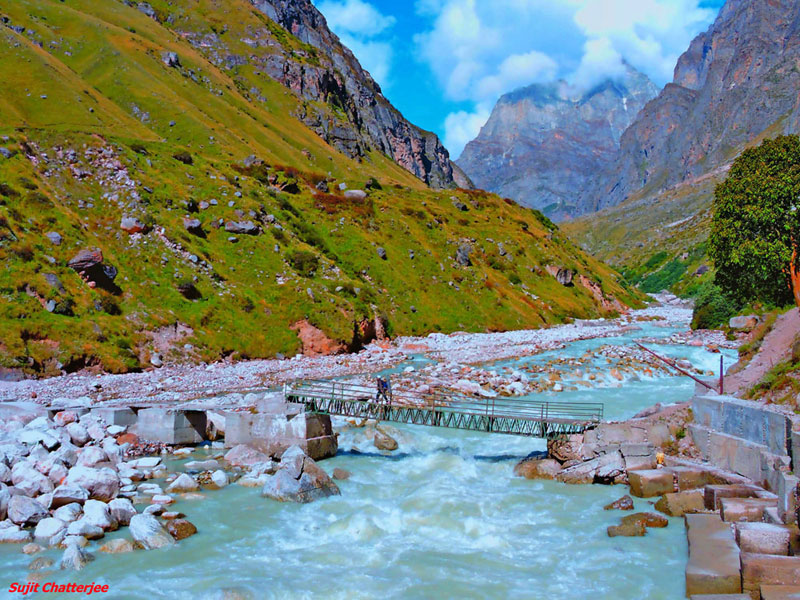
After a couple of hours, the surging sound of the water plunging from a height will suddenly hit your ears. On walking closer to the sound, the sight of Vasundhara Fall will come into your eyes. This cascading waterfall has medicinal properties and has been scientifically proved. Absorb the beauty of the waterfall and start treading through the thick birch forests of Laxmi Van. Walk 4 km further on the moraines and you’ll come across your campsite at Laxmi Van. Day 03: Lamxi Van - Chakratirtha Capture the beautiful sunrise view and gear up for today’s trek. This is a short yet scenic trek which will cross the Satopanth Valley. The well-marked trail is dotted with the green patches amidst the vast terminal moraines of Dhano Glacier.
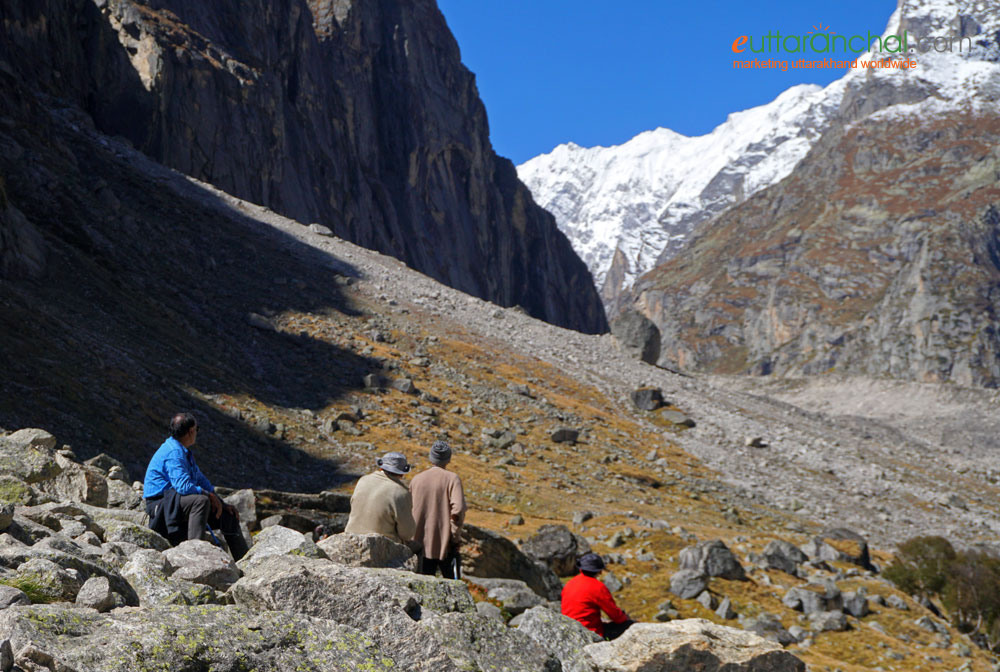
On the way, you can see the colourful alpine flowers blooming in the valley, after which the glorious view of the three benevolent peaks of Bhagirathi will first appear at the Satopanth Valley. Gradually climb the steep ridge of Sahastradhara to Chakratirtha camping grounds. On reaching the campsite, roll on the ground and gaze at the glaring west face of Mount Neelkanth.
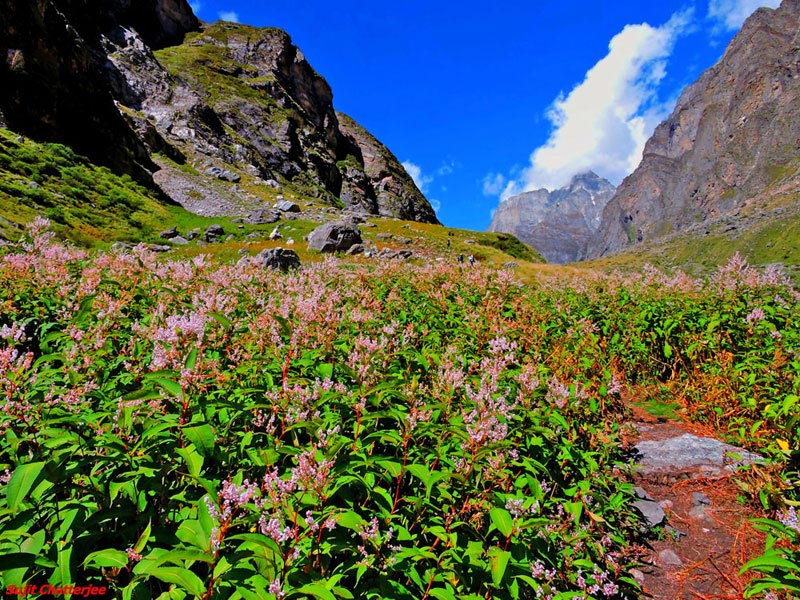
Day 04: Chakratirtha - Satopanth - Chakratirtha Unzip your tents early morning, to have a tempting view of Chaukhamba in the centre, Neelkanth , Satopanth and Parvati Peaks on your left and Balakun on your right. Sip a cup of tea, while getting drenched in the enigmatic aura of the colossal hills.
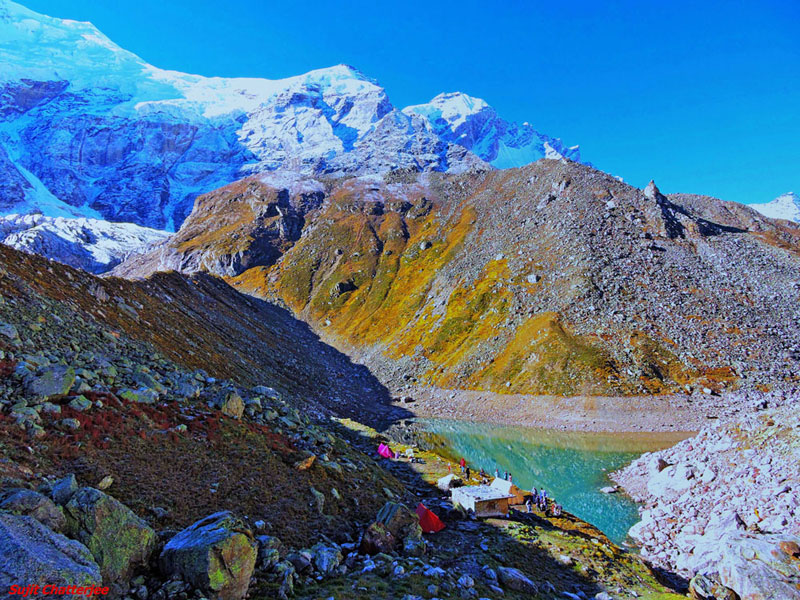
Now get ready to meander through the puzzling maze of boulders and moraines. You may also hear the perpetual tumbling sound of the avalanches throughout the valley. This is a tricky stretch so be patient while crossing it. In the last 2 km trek, you may have to deal with a couple of steep slopes and walk over the loose soil scattered over the glacial moraines. On reaching the top of the ridge, you will see the first sight of the triangular shaped, Satopanth Lake .
The breath-taking views from the emerald lake will sweep you off your feet. You can also see a saint known as Mauni Baba who resides near the lake and has stopped talking from a very long time. There is a common belief that he can live on only sun and air if food is unavailable. After spending some time here, start descending to Chakratirtha campsite. The 5 km return trek to Chakratirtha can be completed in a couple of hours.
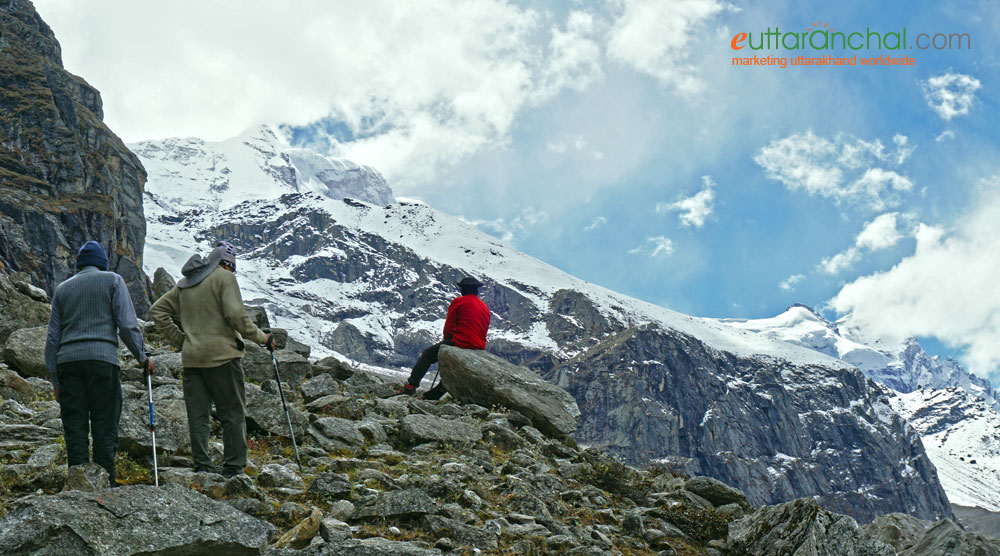
Day 05: Chakratirtha - Mana - Badrinath Wake up to the chirps of the playful birds, post breakfast pack your tent to start descending all the way down to Mana village . Follow the same trail that you took for reaching Chakratirtha from Mana. This 15 km trek can be completed in 5-6 hours. On reaching Mana, take the taxi ride to Badrinath , check in at a hotel and have an overnight stay there.
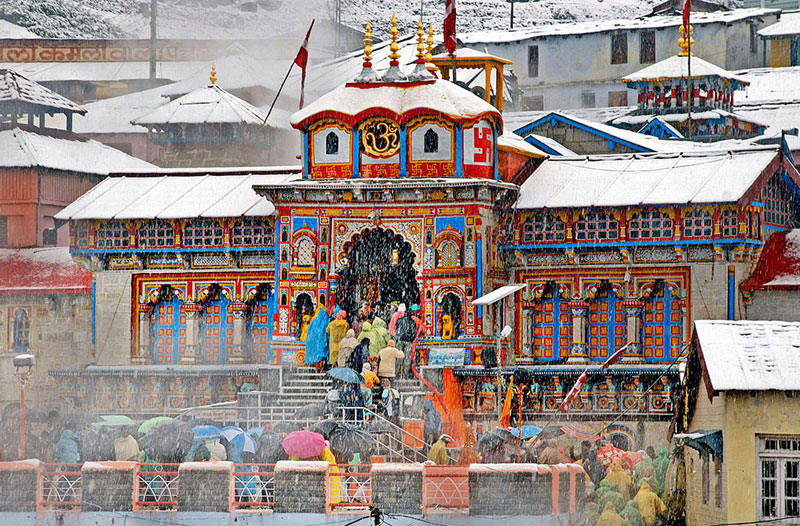
Day 06: Badrinath - Rishikesh After having a nutritious and healthy breakfast, check out from the hotel and leave for Rishikesh .
You can also check our tours of Satopanth : Budget Trek to Satopanth ex-Badrinath :: Satopanth ex-Haridwar/Joshimath Deluxe Trek
Satopanth Trek Travel Tips
- Trek to Satopanth Tal is moderately difficult and hence requires the trekkers to be physically fit. Cardio-vascular exercises like running, swimming could be practiced to improve stamina.
- It is recommended that to take the service of experience guide or trekking company for Satopanth Tal trek. You can also check Satopanth Tour packages from eUttaranchal as well.
- During the monsoons months (July-August), it is better to check with weather and road conditions with the local authorities and tour operators before travelling to the destination.
- Best time to visit Satopanth Tal is during the months of May, June, September and October. Nearest railhead is at Rishikesh while the nearest airport is situated at Dehradun.
- Obtain inner line permits from the Forest Department in Joshimath.
- The weather conditions and the gradient make the trek more difficult than it may appear.
- Last market is in Badrinath , do all preparations in Badrinath or Joshimath itself.
Mythology about Satopanth Trek
According to the Hindu legends amd Mythology, the Tridevas or the three devas, Brahma , Vishnu and Mahesha (Shiva) mediated on the corners of this lake. It is believed that during every Ekadashi the trinities take a holy dip in the water of Satopanth Lake. The Hindus believe that taking a bath in the Saptopanth Lake on the 11th day of the solar and lunar fortnights is considered to be auspicious.
Locals also believe that some special type of birds are found here, which pick up the pollutants of the lake and thus keeping the lake clean. These birds are not found anywhere else. The local belief is that they are the Gandharvas perdue, who guards the lake against evils.
The Hindus believe that Goddess Lakshmi and her husband Narayan indulged in a penance at Lakshmi Van and Chakratirtha.
There is an interesting story behind the indent created at Chakratirtha which states that Narayan once kept his Sudarshana Chakra on the valley and due to its weight the valley got its round shaped meadow surrounding the lofty mountains.
About Satopanth Lake
With its emerald blue-green crystal clear waters the triangular lake, having a perimeter of 1 km is situated at an astounding height of 4400-4600 meters (15100 feet). Satopanth Lake is 25 km from Badrinath shrine and about 4 km from Chakrateerth. This pristine lake is situated on the base of legendary Neelkantha Peak. The travelers can relish the stunning views of the glorious Balakun Peak, Kuber Top, Mt. Nilkantha and Mt. Swargarohini which are visible en route.
There is a saint known as Moni Baba , who hasn’t uttered a single word from years. There is a common belief that he can live on sun and air if food is not available.
What is Meaning of Satopanth?
Satopanth word is derived from two words – ‘ Sat-o ’ meaning of truth, and ‘ Panth ’ meaning path or way. So its literal meaning is the path of truth .
Satopanth Lake has three corner and each corner of Satopanth Lake is named after divine Trinity of Brahma, Vishnu, and Mahesh. The lake considered sacred by the local people of Mana village , which is base camp village for Satopanth Lake.
About Satopanth Glacier and Bhagirathi-Kharak Glacier
The Satopanth and Bhagirath Kharak glaciers are located at the head of Alaknanda Valley in Chamoli district of Uttarakhand. Both Satopanth glacier (13 m) and Bhagirath Kharak glacier (18.5 m) have an average width of 750-850 metres.
These glaciers sprawl over an area of 21.17 and 31.17 square km respectively. The eastern slopes of Chaukhamba group of peaks feed the ice to these glaciers. The towering peaks raging from 5,288 to 7,068 metres are snow-clad during winters.
These two glaciers are separated by a linear ridge. Both the glaciers have a sinuous course as their paths are obstructed by a number of spurs. The ablation zones of both the glaciers are covered by a thick layer of debris and their snouts are located at 3858 m and 3796 m above sea level.
The Alaknanda River originates from Satopanth glacier and meets Uttar Ganga upstream to Alkapuri. At Mana, Alaknanda meets Saraswati River and there onwards it drains in the Badrinath basin. The enchanting Vasudhara Fall is located on the route of these glaciers.
Satopanth is also known or written as Satopanth Lake, Satopant Tal, Sathopanth Tal, Sathopanth Lake trek, Satopanth Glacier trek. Sometimes it is also known as Satopanth - Swargarohini Trek .
Satopanth Trek Photo Gallery
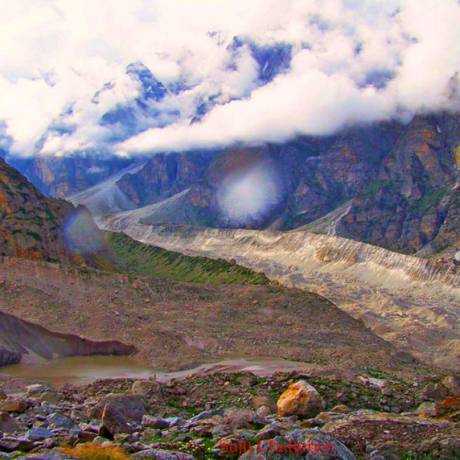
- Satopanth Trek Travel Guide
- Satopanth Trek Weather
- How to Reach Satopanth Trek
- Satopanth Trek FAQs
- Satopanth Trek Photos
What is Satopanth Trek famous for?
Satopanth Trek is famous among tourist as Trekking, High Altitude Lake, Mythological Importance, Camping, Glacier, Pilgrimage.
Satopanth Trek is recommended destination for Foreigners, Groups, Solo.
Satopanth Trek is popular destination for following activities/ interests - Adventure , Camping , Glaciers , Lakes , Pilgrimage , Trekking .
Satopanth Trek Highlights
- Surreal high altitude green lake Satopanth
- Walk over a natural rock bridge, Bheem Pul near Mana Village
- Vasudhara waterfall during the trek
- Walk through the last village of India, ' Mana '
- Meet Moni Baba near the lake
- Cross many glaciers and valleys during the Satopanth trek
- Views of Himalayan peaks like Chaukhamba, Neelkanth and Swargarohini
- Satopanth Lake remains frozen during from October to May.
Uttarakhand Travel Update
Char Dham yatra will start from 10 May 2024, Bookings Now Open! Check Char Dham Tour Packages - Hotels in Badrinath - Char Dham Yatra by Helicopter - Kedarnath Helicopter Booking Guide - Char Dham hotels
Char Dham Closing Dates: Gangotri , Yamunotri and Kedarnath dhams are closed now. Badrinath temple will be closed 19 Nov. Check out Char Dham Yatra tours : Char Dham News . Char Dham Registration is compulsory for visiting Char Dham Temples. Check Kedarnath Helicopter Ticket booking guide .
Traveling to Uttarakhand? Check out Uttarakhand Covid Stats , Uttarakhand Travel Guidelines and Uttarakhand Travel News
Char Dham Update: Gangotri , Yamunotri , Kedarnath and Badrinath are open for pilgrims. Check out Char Dham Yatra tours : Char Dham News . Char Dham Registration is compulsory for visiting Char Dham Temples. Check Kedarnath Helicopter Ticket booking guide .
Last Updated: 07 May 2024
Satopanth Trek overview
- Best time to visit Satopanth Trek May, Jun, Sep, Oct,
- Starts from Badrinath
- Trek Distance 22 kms
- Trek grade Moderate
- Trek duration 5 days
- Altitude range 4600 mts
- Located in Chamoli, Garhwal
- Famous for Trekking, High Altitude Lake, Mythological Importance, Camping, Glacier, Pilgrimage
Travelling to Satopanth Trek in 2024?
Contact us for planning your Satopanth Trek tour with best travel packages of as per your requirements!
- Char Dham Yatra
- Char Dham Packages
- Chopta Tourism
eUttaranchal
- Uttarakhand Tour Packages
- Uttarakhand Hotels
Customer Service
- Return, Cancellation & Refund
- Privacy Policy
- Terms of Use
Business Connect
- List your Package
- List your Hotel
- Send Feedback
- Nainital - Musoorie
- Haridwar - Rishikesh
- Chopta - Tungnath
- Badrinath - Kedarnath
- Auli - Joshimath
- Kedarkantha - Har ki Dun
- Corbett - Binsar
- Badrinath Hotels
- Kedarnath Hotels
- Nainital Hotels
- Rishikesh Hotels
- Mussoori Hotels
- Chopta Hotels
- Corbett Resorts
- Adi Kailash Packages
- Valley of Flower Tours
- Kumaon Tours
- Badrinath Packages
- Kedarnath Packages
- Chopta Packages
- Nainital Packages
- Valley of Flowers - Hemkund Sahib
- Kuari Pass Trek
- Satopanth Trekking
- Phulara Ridge Trek
- Brahmatal Trek
- Panchachuli Base Camp Trek
- Nag Tibba Trek
Get Customized Tour Package
Satopanth Tal: Trek To The Prestine Glacial Lake
The Western Himalayas are home to numerous out-of-this-world trekking trails , and several of them feature high-altitude glacial lakes . Satopanth Taal is one such pristine body of water, located in Chamoli district of Uttarakhand, near Badrinath Temple.
The virgin landscape of Satopanth Taal is tucked within a triangular region at an elevation of 4.600 metres (15,100 feet). Mighty peaks of Garhwal Himalayas such as Neelkanth, Chaukhamba, Swargarohini, and Balakun surround the emerald green waters of the lake, and they can be seen once you reach the summit of the trek.
The trek towards Satopanth Taal starts from Badrinath Temple, and you can even pay a visit to the Lord and take his blessings before you start your journey. The base camp for the trail is at Mana by the River Saraswati, the last village of Indian territory before the Indo-Tibetan border starts.
Do keep in mind that you will find no permanent establishments for a night stay on your Satopanth Taal Trek. So, you will have to carry tents, food, cooking materials, and sleeping gear along with you.
Satopanth Taal Trek – An Overview
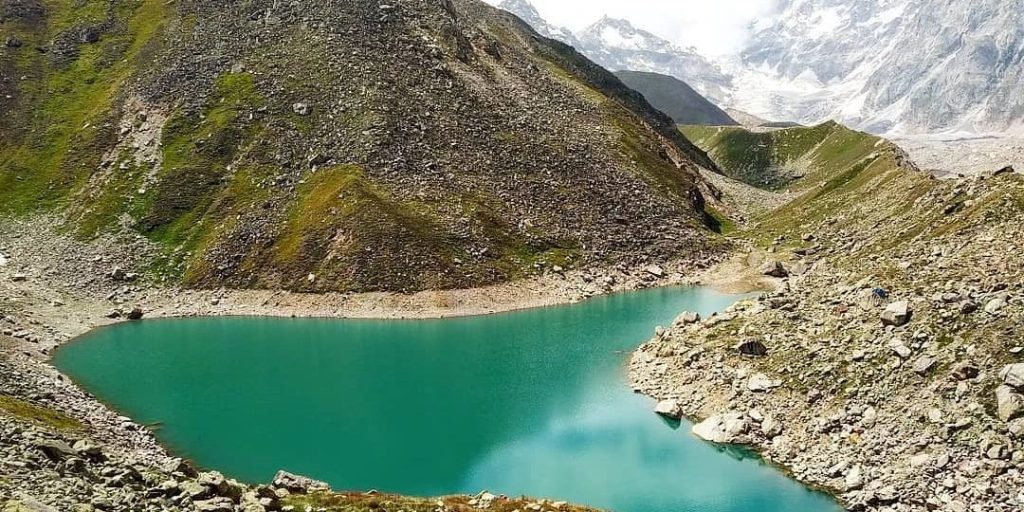
A heavenly destination amidst the snow-capped mountains, the route to Satopanth Lake offers an isolated yet stunning trekking trail spanning for a little less than 50 kilometres there and back again. Along with being an offbeat trekking destination, Satopanth Lake is also a spot of great spiritual veneration for the inhabitants of Mana Village.
Other than the local legends explained later, the trek route to Satopanth Taal is also known for being the path taken by the Pandavas in Mahabharata. After their time on Earth was over, the five brothers and their wife Draupadi started walking from Mana Village to reach the steps to heaven, which is believed to be on the Swargarohini glacier. Three out of the seven steps they took can be seen from the summit of Satopanth Taal trek.
Swargarohini is not the only important glacier in this region. As you start walking from Mana upstream along the River Alaknanda, you will come across Satopanth Glacier itself, as well as Bhagirath Kharak Glacier. Both the moving streams of ice are fed by the snow from Chaukhamba peaks .
Satopanth Glacier, originating from the Chaukhamba peaks at 7,068 metres and melting at 3,810 metres, has an expanse of 13 km and gives birth to the Alaknanda River. The river stream goes on to meet Uttar Ganga at Alkapuri and then Saraswati near Mana to drain in the Badrinath basin.
- Duration: 6 Days
- Difficulty: Difficult
- Distance covered: Around 50 km
- Maximum Altitude: 4,600 metres (15,100 ft)
- Start and End Point: Badrinath via Rishikesh
- Base Camp: Mana Village
- Last ATM point: Mana Village
- Nearest village: Mana Village
- Nearest Airport: Jolly Grant Airport, Dehradun
- Nearest Railhead: Rishikesh
- Best Time: May-June, September-October
The Legend of Satopanth Taal
The moniker of Satopanth Lake has a special meaning behind it. ‘Sat-o’ in traditional Sanskrit means ‘Of truth’ and ‘Panth’ means ‘Pathway’. So ‘Satopanth’ together means the pathway towards the ultimate truth.
The lake resembles a triangular shape, and legend says each of the three corners of Satopanth Lake is presided by one of the Universal Holy Trinity of Hindu Dharma. Brahma, the creator, Vishnu, the preserver, and Shiva, the destroyer, are believed to be meditating at three corners and charting the course of the cosmos towards the Greater Good.
Locals of the Mana village believe that the trinities take a holy dip in the water on the lunar day of every Ekadashi. The water of the lake is therefore auspicious and is regarded by the Mana village inhabitants as a resting place for their dead. After someone passes away and their corpses are cremated, the villagers scatter the ashes in the water of Satopanth Lake.
There exist other myths about the lake, which have come down from one generation to another as part of the common folklore. It is believed that some special species of birds often visit the shores of Satopanth Taal, which are actually Gandharvas from heaven. They come over to pick through the dirt and pollution, keeping the lake clean and guarding it against evils.
If you ask around in the village, you will hear more such stories about the landscape at Satopanth, such as Lord Vishnu’s Sudarshan Chakra caused the indent at Chakrateertha, and hence was given the name.
The Best Time to do Satopanth Taal Trek
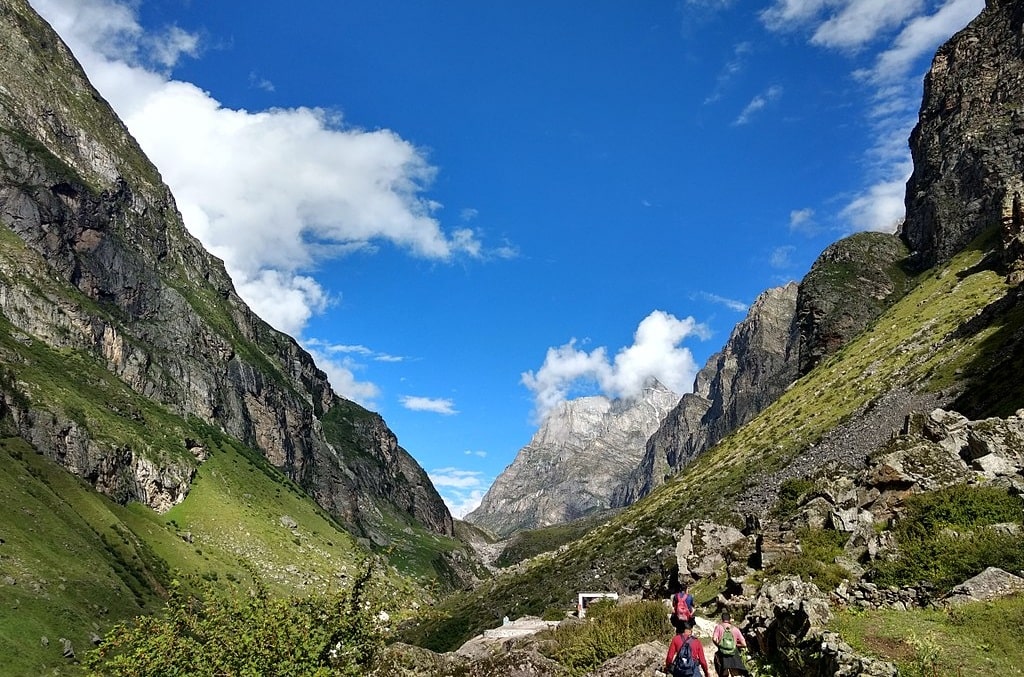
Overflowing with beauty all year round, the Satopanth trek is a high-altitude trek best undertaken during either summer or post-monsoon.
Summer (May to mid-July): The clear skies offer clear views of the snow-capped Mt. Chaukhamba, Mt. Neelkanth, and Mt. Swargarohini. The view of the night sky full of stars is just as enchanting. Trekkers can enjoy nature in its glory during summers with beautiful alpine flowers blooming all around. The trails along the banks of Alaknanda and through dense forests and lush meadows are irresistibly alluring.
Summer is also one of the best times to visit Satopanth lake. This is a glacial lake located near the Badrinath shrine, at an altitude of 4600 meters above sea level. This triangular lake with pristine bluish-green waters is stunningly beautiful. It is considered to be sacred and believed to possess mystical powers. Its tranquil beauty also attracts beautiful exotic birds exclusive to this region.
It is one of the best summer treks through the Indian Himalayas . With average summer temperatures ranging between 12⁰C in the day and 7⁰C to -5⁰C at night the weather remains pleasant. It is still important to carry warm clothes though as nights can get quite chilly.
Post Monsoon (September to October): The post-monsoon season is another ideal time to undertake the Satopanth trek. Autumn reveals yet another aspect of the natural beauty of this region. Trekkers can enjoy trails covered in rich fall colors while the sky remains clear.
This is the best time to witness the Alaknanda River at its glorious best its powerful amalgamation with the Vasundhara falls. This 400 ft waterfall is a sight to behold and the Satopanth trek is incomplete without paying a visit to it.
Satopanth taal in October possesses a mesmerizing quality with the onset of snowfall covering the landscape in a light cover of white. With temperatures ranging between 5⁰C in the day and -15⁰C at night it remains cold throughout the day. Therefore, it is advisable to be well equipped with thermal and heavy woolen wear and dress in warm layers.
Monsoons and Winters are not recommended due to extreme weather conditions. Heavy rainfall in monsoon causes landslides making routes inaccessible. Since the trek reaches very high altitudes, it is common to find a lot of snow in winter. This also leads to the shutting down of trails dangerously slippery with ice.
How to Reach Satopanth Taal Trek
The Satopanth Trek begins at Mana in Uttarakhand , the last village on the Indo-Tibetan border. It is just 4 km from the town of Badrinath, which is well connected with most major cities of the country. Badrinath is easily accessible via air, train as well as road.
The nearest airport, the Jolly Grant Airport near Dehradun is about 317 km away from Badrinath. It is well connected to all major cities in India with multiple direct as well as connecting flights available throughout the day. Regular Helicopter services are also available from Sahastradhara in Dehradun, which is 146 km away.
If you’re travelling from Delhi, the easiest way is to reach Dehradun in under an hour by flight. Taxis are easily available from outside the Jolly Grant Airport which will take you to Rishikesh in approximately one hour. You may then travel to Badrinath, which is about 300 km away via bus or taxi which may take about 6-8 hours to reach.
Badrinath does not have a railway station and the nearest station is at Haridwar which is well connected to different parts of the country.
Several trains are available from Delhi to Haridwar daily, with transit times ranging between 4 to 6 hours. You can then travel to Rishikesh which is just 25 km away by taxis easily available near the railway station. From there you will get multiple options of taxis as well as buses that can take you to Badrinath in about 10-12 hours.
Direct trains are available from Dehradun to Haridwar as well as Rishikesh. These will allow you to reach your destination in approximately an hour. From there it is relatively easy to reach Badrinath, which is about 300 km away, by either taxi or bus.
Badrinath is well connected to all surrounding States via NH-58 highway and is easily accessible by road.
The excellently maintained roads are safe and make travel easy.
Badrinath is 528 km away from Delhi and is connected to Delhi via the NH-58. It is a long drive of approximately 15 hours, thus taking a bus is more convenient. AC, non-AC as well as AC sleeper buses to Rishikesh are readily available from ISBT Kashmiri Gate. Once you reach Rishikesh you can opt to travel to Badrinath by either taxi or bus which are both easily available.
Badrinath is 340 km away from Dehradun and can be reached in about 12 hours via road. You can take a taxi from Dehradun to Rishikesh and then take a bus or car from there to Badrinath. Rishikesh is about 300 km away from Badrinath and will take about 10-12 hours to reach.
The easiest route to reach Badrinath is via Rishikesh with multiple transportation options like buses, shared as well as private taxis available from there. Once you reach Badrinath, Mana village is just 3-4 km away and you can either take a bus, taxi or simply enjoy a picturesque walk to the little village.
Satopanth Taal Trek Itinerary

Following is a brief 6-day Satopanth Taal trek itinerary that you will be following.
Day 1: Rishikesh to Badrinath – Drive for 300 km (approx.)
On the first day, you will be travelling by road for around 11 hours or so to reach Badrinath from Rishikesh. To reach within a reasonable time and get some rest for the next day, start early. Catch the morning bus or start your car trip at dawn. Pay a visit to the shrine before having dinner and settling down for the night at your hotel.
Day 2: Badrinath to Lakshmi Van – Trek for 5 hours (9km) – 11,900 ft
You can either start walking from Badrinath or take a cab for 3 km to Mana Village. From here starts your actual trail for Satopanth Taal. You will be walking along the left bank of River Alaknanda. After 3-4 km, you will come across the majestic Vasundhara Falls . Crossing the cascading waters of the Falls, keep walking towards Lakshmi Van campsite at 11,900 ft where you will tent for the night.
Day 3: Lakshmi Van to Chakrateertha – Trek for 4 hours (7km) – 14,000 ft
Today you will walk along with the green grasslands along the moraines of Dhano Glacier. Expect to see patches of colourful wildflowers and glimpses of Bhagirathi peaks on your way. Towards the end of the trek, you will reach Sahasradhara – the place of limestone stalactite monoliths along which drip thousands of water streams – giving it the name Sahasradhara, which means a ‘thousand-fold spring’. You can get a view of the mighty Neelkanth peak from here on a clear day. The Chakrateertha campsite is half an hour’s trek away from here.
Day 4: Chakrateertha to Satopanth and back – Trek for 8 hours (10km) – 15,100 ft
This day’s trek starts off on a flat and easy gradient but takes off towards the end. Boulders and moraines trace your path towards the top of the ridge from where you get the first glimpse of the pristine lake . Stay prepared to be greeted with a scintillating view of a lifetime, with Neelkanth behind you, Swargarohini on the left, Chaukhamba straight ahead, and Balakun on the right. Climb back to Chakrateertha once you are done taking the place and clicking photographs.
Day 5: Chakrateertha to Badrinath via Mana – Trek for 6 hours (15km)
Climb down the same path to reach Mana village in about 6 hours this time. You can take a direct cab or jeep to Badrinath if you are too exhausted, which you probably will be.
Day 6: Badrinath to Rishikesh
On the last day of your trip, you will be taking a bus or a cab back to Rishikesh for your further journey towards home. You can pick up some last-minute essentials or souvenirs from either Badrinath or Rishikesh before you leave Uttarakhand.
Difficulty of the Trek
Altitude gain.
Steep altitude gain can be one of the most challenging things on a trek. As you climb up, oxygen levels in the atmosphere decrease. The respiratory organs and the heart are forced to function more heavily. Acute breathing problems might also occur.
Day 3 has the steepest climb in the entire itinerary. From Lakshmi Van to Chakrateertha, you will be gaining more than 2500 ft in altitude, so be prepared for some heavy legwork. Keep water within reach and pack dry snacks for the way to keep the body going.
There is no need to be scared if breathing gets troublesome. Take a small break and breathe normally through the nose, if still not in control then descend to the camp. Panic breathing through the mouth makes it even worse at such times.
Weather and Temperature
While at Chakrateertha campsite, be prepared for a sudden drop in the temperature, especially at night. You will be climbing more than 2500 ft in one day and your body might take a while to acclimatize to the extra cold. Temperature can go down around -5 to -7 degrees Celsius at night. Cover yourself in warm clothes properly while going to sleep, and cover your head and ears as well.
Acute Mountain Sickness
There is quite a bit of altitude gain in Satopanth Taal trek and the most common challenge faced by the trekker is Altitude Motion Sickness . It usually happens at high altitudes due to a lack of oxygen or a drop in the oxygen level in the body at high altitudes. AMS is just like motion sickness causing nausea and headache among the travelers but may become dangerous on ignoring the primary symptoms.
When having the signs of AMS it is advised to descend immediately to a lower altitude as a safe side. Consult your physician you have ever encountered AMS signs before taking any medications.
The stretch from Chakrateertha to Satopanth Lake is likely to have a lot of snow, no matter the season. Prepare yourself with good trekking shoes that will not slip, UV-protected sunglasses to deal with snow blindness, and synthetic gloves with padding to keep your hands warm and help with handling snow.
Physical Fitness
Trekkers must be in good physical condition, capable of climbing 2000-2500 ft on one day’s ascent. Moreover, the terrain is covered with boulders, loose rocks, and moraines, making the walk quite stressful on the knees and ankles. A high level of fitness and prior experience in trekking is required. The final stretch towards the summit of the trek is especially steep, with nothing beneath the feet except loose moraine soil from the glaciers.
Highlights of the Satopanth Trek
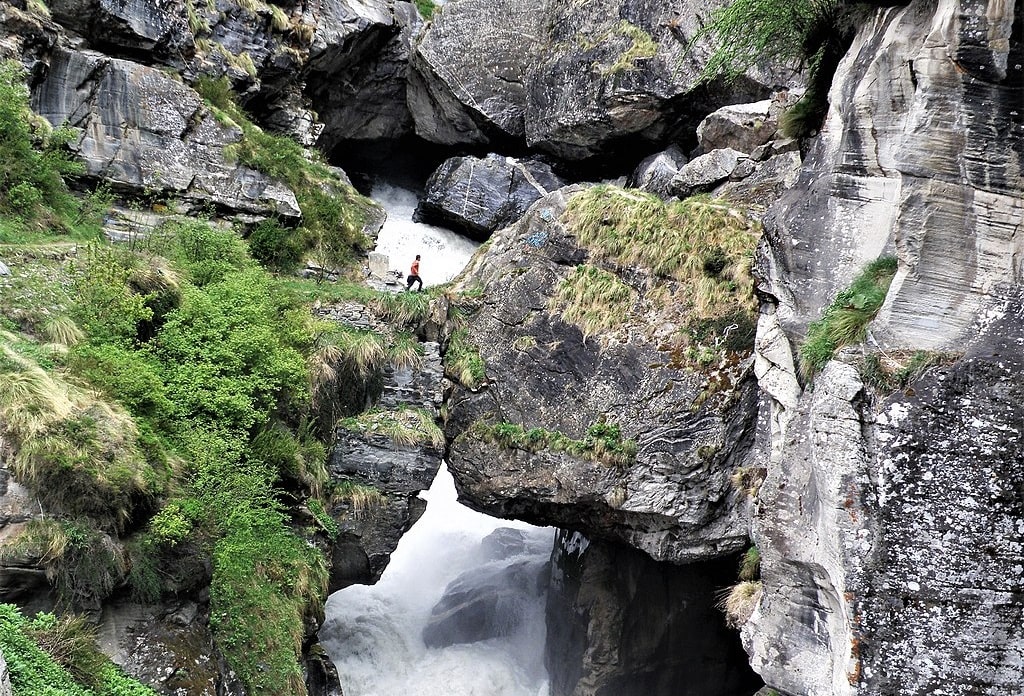
The remote trail leading to the ethereal Satopanth Lake will take you through some divine landmarks such as the Vasundhara Waterfall, the Bheem Pul, and Mana Village.
Satopanth Lake
Situated at an altitude of 15100 feet above sea level, this sacred glacial lake is located near the Badrinath shrine. The Satopanth lake is surrounded by the snow-capped peaks of Chaukhamba, Neelkanth, Swargarohini, and Balakun.
According to Hindu Mythology, Brahma, Vishnu, and Shiva meditated at the three corners of this triangular lake. It is considered especially auspicious to bathe in it on the 11 days of the solar and lunar fortnights. The lake’s dazzling crystal clear emerald waters are also believed to possess healing and wish-fulfilling powers.
Vasundhara Waterfall
Located at a distance of approximately 10 km from Badrinath, is the Vasundhara Waterfall. This astounding 400 feet waterfall unleashes icy droplets of water that seem to vaporize into thin air.
This is another sacred site bearing religious significance. According to mythology out of the five Pandavas, only Yudhishthira and his dog were righteous enough to cross the waterfall and reach heaven. Due to this, it is still believed today, that the water from the Vasundhara waterfall only touches the pure of heart.
The Bheem Pul is a rock bridge near Mana Village . Created from a massive boulder, it is a natural bridge over the Saraswati River. It is located at the confluence of the Saraswati river with the Alaknanda River.
The Bheem Pul is another structure steeped in mythology and is believed to have been placed there by Bheem. As the story goes, Draupadi accompanied the Pandavas on their journey to heaven. However, she was unable to cross the Saraswati River, so Bheem placed a huge boulder over it to aid her.
The natural beauty of this massive rock bridge affords a breathtaking view of the Saraswati as well as the Alaknanda Rivers. This makes it a major attraction of the trek.
Mana Village
The Satopanth Trek starts at a quaint little village snuggled in the foothills of the Himalayas, 3 km away from Badrinath. It is the last village on the Indo-Tibetan border originally set up by Indo-Mongolian tribes. Its proximity to the Ganesh and Vyas caves makes Mana a favorite tourist spot.
It is seasonally inhabited by 200 people who relocate to the plains in winter to avoid the extremely harsh weather conditions. Rich in culture and tradition, Mana is famous for its handicrafts with women adept at knitting and weaving all kinds of merchandise. The locals are very hardworking, friendly, and welcoming.
FAQs Related to Satopanth Lake
1.where is satopanth taal.
Satopanth Taal is located in the Chamoli district of Uttarakhand. It is situated nearby the revered Badrinath Dham shrine and can be accessed from Mana village, the last Indian locality along the Indo-Tibet border.
2.How do you get to Satopanth Lake?
The trek towards Satopanth Lake starts at Mana Village which can be reached from Badrinath. From Mana, you will have to cross two campsites, first at Lakshmi Van and the second at Chakrateertha, and on the fourth day, you will reach the ridge of Satopanth Lake. The trail follows the banks of the Alaknanda River all along.
3.How high is Satopanth?
Satopanth Taal is located at a height of 4,600 metres or 15,100 ft amidst Garhwal Himalayas.
4.What is the itinerary of the Satopanth Taal trek?
The itinerary of Satopanth Taal trek is as follows
- Day 1- Rishikesh to Badrinath
- Day 2- Badrinath to Lakshmi Van
- Day 3- Laxman Van to Chakratirtha
- Day 4- Chakratirtha to Satopanth and back to Chakratirtha
- Day 5- Chakratirtha to Mana and then to Badrinath
- Day 6- Badrinath to Rishikesh
Deals And Offer
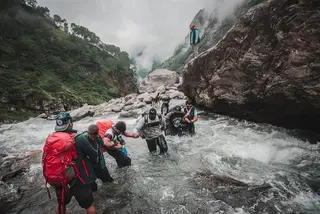
Hampta Pass Trek
4.87 ( 438 ), hampta pass trek 2024 - chandratal lake trek | moxtain, free cancellation till 30 days prior trek, rental & gear available on rent, book with 20% initial amount.
See Dates / Book Now
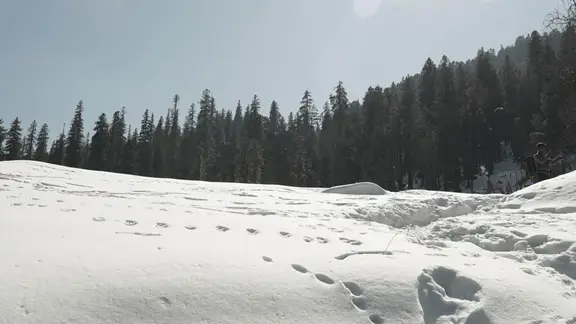
Dayara Bugyal Trek
4.85 ( 398 ), dayara bugyal trek 2024 - 6 days trek | moxtain.
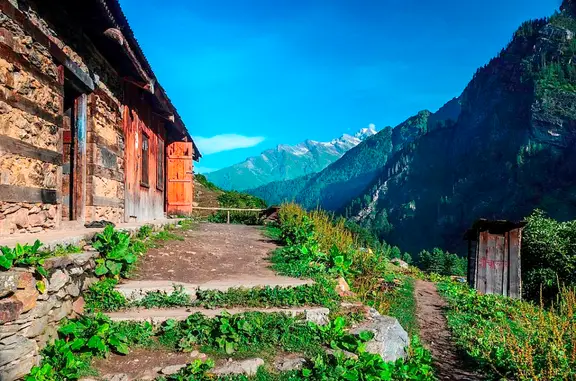
Kasol-Kheerganga-Tosh-Malana-Trek
4.56 ( 24 ), similar blogs.
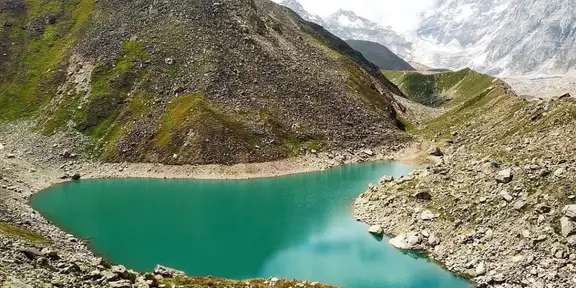
Tarsar Marsar Trek: One of the Most Beautiful Trek in Kashmir
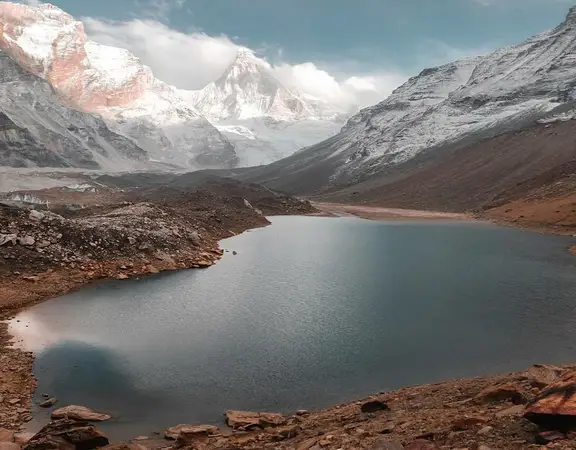
Kedartal: The Glacial Lake Trek in Garhwal Himalayas
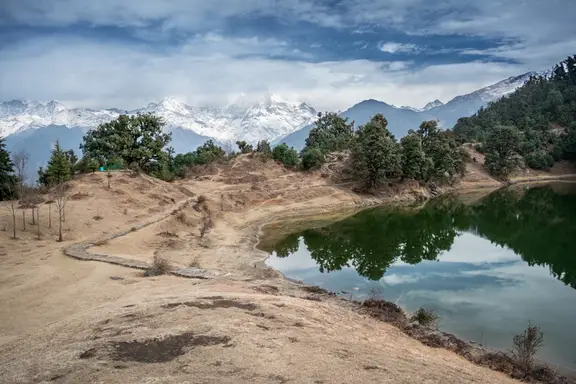
Deoriatal: Weekend Trek in Uttarakhand
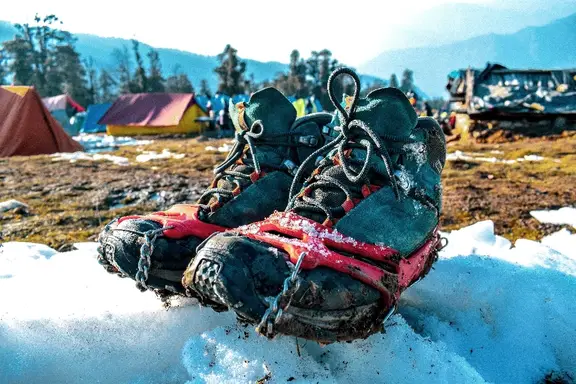
Crampons Vs Microspikes: What To Use For A Trek?
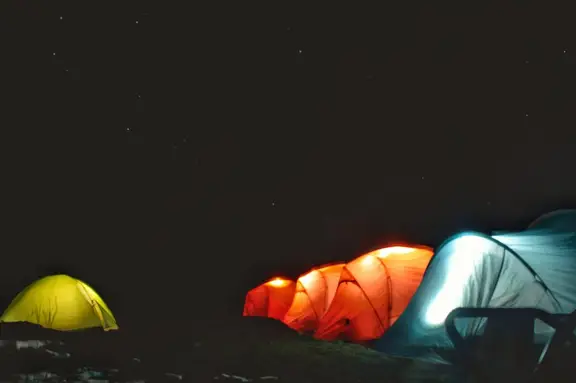
Toilets facility at the campsites
Similar trips, everest base camp trek, stok kangri, annapurna base camp trek, goechala trek, nag tibba trek, deoriatal chandrashila, sandakphu phalut trek, bara bhangal, mayali pass.
Shikhar Blog
Travel Experiences – Sharing Travel Memories Around the World
Satopanth Tal Trek- An adventure to explore the Pristine Glacial Lake
An untouched Glacier Lake, Satopanth Tal is a triangle-shaped hidden treasure amidst the magnificent Garhwal region. The destination happens to be an impeccable religious site for the locals and is believed that the three supreme deities of Hinduism, Brahma, Vishnu, and Maheshwara meditated on the three different corners. Nestled at a huge elevation of 4600 meters above sea level, this crystal clear green water lake is beautifully bedecked amid the snow-shrouded peaks.
This renowned trekking trail in Uttarakhand holds immense significance in Hinduism and attracts thousands of travelers from all across the globe. A massive crowd of devotees treks to this lake on solar and lunar fortnights to take bath into it as this is considered very auspicious. This gorgeous site also offers a great opportunity to have glimpses of the Himalayas.
Along with enjoying the thrilling trekking experience, one can also witness the surreal beauty of the scenic vistas and the glory of the gorgeous Vasudhara Falls. In addition, the traveler also gets an opportunity to capture the awe-inspiring views of Himalayan gigantic such as Chaukhamba, Neelkanth, and Swargarohini.
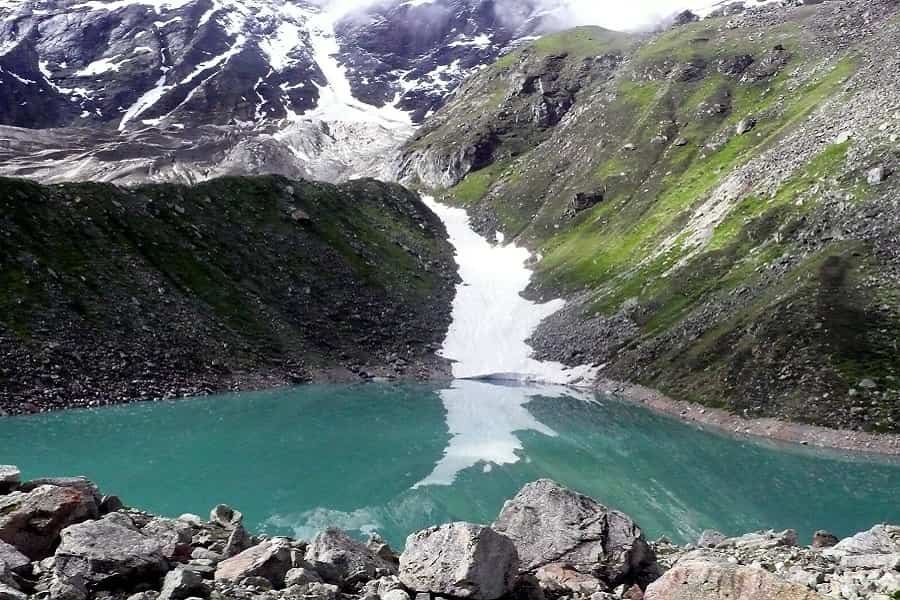
Note- Be informed that you are not going to find any permanent establishments for an overnight halt on the Satopanth Tal Trek expedition. Hence, you are strictly advised to carry food, raw materials, tents, and sleeping gear along with you.
Also Check Out : Detailed Itinerary for Mt. Satopanth Peak Expedition
Brief Details about the Trek
- Duration of the trek- 6 days
- Difficulty level- moderate
- Distance covered- around 50 km
- Start and end point- the journey continues from Rishikesh to Badrinath
- Base Camp- Mana Village
- Nearest Airport- Jolly Grant Airport in Dehradun
- Nearest Railhead- Rishikesh
- Best time- between May-June and then September-October
Trekking Tour Highlights
- Witness the impeccable charm of the untouched Satopanth Lake.
- Walk over the Bheem Pul, a natural rock bridge.
- Watch out for the mesmerizing views of Vasudhara Falls.
- Climb up the Dhano Glacier, one of the majestic glaciers in North India.
- Walkthrough Mana, the last Indian village.
- Witness the spell-binding views of the Himalayan peaks like Swargarohini, Chaukhamba, and Neelkanth.
- Enjoy camping at Satopanth Lake under the starry sky during the night.
The Legend of Satopanth Tal
If we go by the traditional Sanskrit then the word ‘Sat-o’ means ‘of truth’ and ‘Panth’ means ‘Pathway’. Hence, Satopanth altogether means a pathway leading to ultimate truth. Several myths are existing about the lake that has passed on from one generation to another and is spread among locals and tourists as folklore.
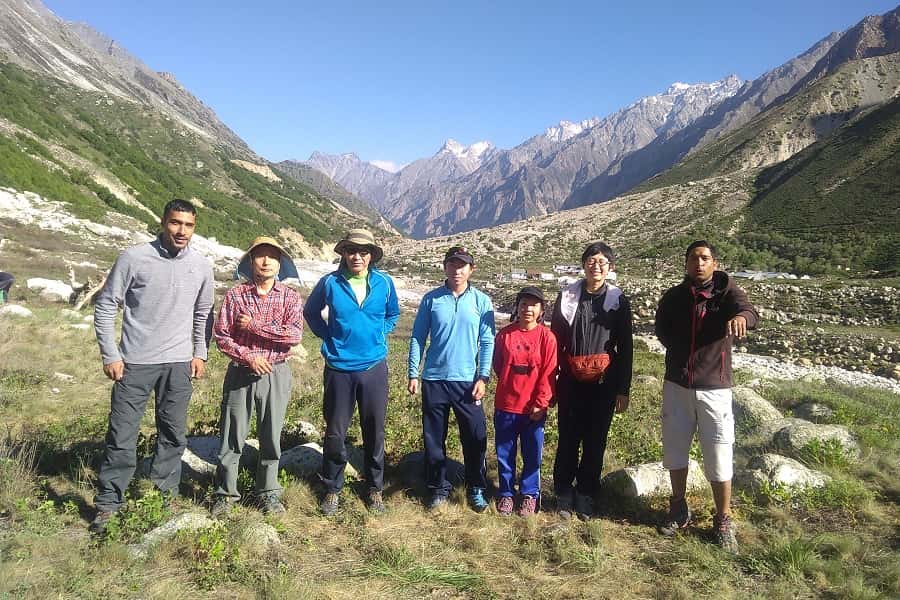
There is a belief that some unique bird species often come to the shores of this lake, which are Gandharvas from heaven. It is believed that they come here to pick the garbage, dirt, and pollution to keep the lake clean and hygienic.
When you roam around the village, you will get to hear several stories related to the origin of this revered site.
Best Time to Trek along the Satopanth Tal Trek
This high-altitude trekking trail however overflows with beauty all around the year and is best to be undertaken either during monsoon months or the summer season.
Covering This Trek during the Summer Months
Summer month in Uttarakhand starts in May and the clear skies offer clear views of the snow-peaked Mt. Neelkanth, Swargarohini, and Mt. Chaukhamba. The starry sky looks so enchanting, especially on the full moon day. Adventure lovers can enjoy the eye-treating views of the nature during summer months with colorful and scented flowers blooming all around.
The trails pass through the dense forest areas, lush meadows, and bluish-green water enhances the glory of this pristine glacial lake. The average temperature of the site ranges between 12 degrees Celsius during the daytime and during the night, the temperature hovers between 7 Degree Celsius and -5 degrees Celsius.
Also Check Out : Detailed Itinerary for Satopanth Base Camp Trek
Covering this Trek Post Monsoon
Another ideal time to trek along Satopanth Lake is the post-monsoon season. September and October reveal another aspect of the scenic vista of this region. This is the most ideal time to witness the beauty of River Alaknanda at its utmost level. In October, the region starts receiving snowfall covering the landscape in a light cover of white.
Winter months are not recommended to plan your Satopanth Tal Trek due to extreme climatic conditions and during the monsoon months, the region becomes quite prone to landslides making routes inaccessible. When you reach the top of this high altitude, it is quite common to find a lot of snow in the winter months.
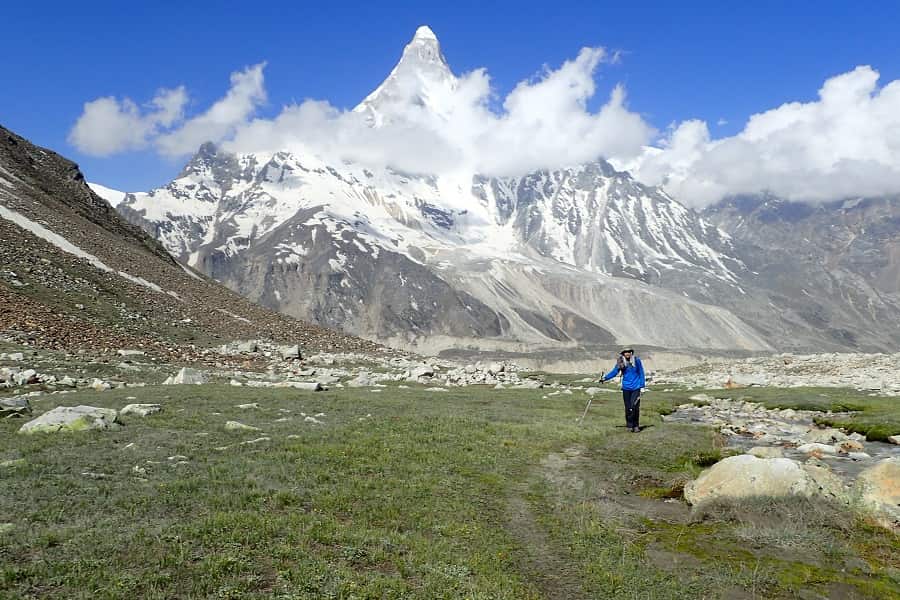
How to Reach Satopanth Tal Trek
The trek commences at Mana in Uttarakhand, the last village established on the Indo-Tibetan border. Located only 4 km away from the main town of Badrinath, the destination is well connected with several major cities of the country.
By Air- Jolly Grant Airport in Dehradun is the nearest airport and is only 317 km away from Badrinath. The airport is well connected to various big cities with several direct and connecting flights available on regular basis. One can also opt for the helicopter services available from the Sahastradhara helipad in the city.
On reaching the airport, one can easily find a taxi or a cab to reach the desired destination.
By Rail – Unfortunately, there is no railway station in Badrinath and the nearest railhead to the pilgrimage is Haridwar Railway Station which is nicely connected to the different parts of the country.
By Road – Badrinath is very well connected to its surrounding states via NH-58 and this makes it easily accessible by roadways. You don’t need to worry about safety as the roads are well maintained and very safe to travel. We would recommend you to take a bus rather than driving your own to reach the place as it would be very arduous and hectic for you.
If you are coming from Delhi then you can easily catch a bus from ISBT Kashmere Gate. Once you arrive in Badrinath then take a bus or taxi to reach Mana Village which is only 3-4 km from here.
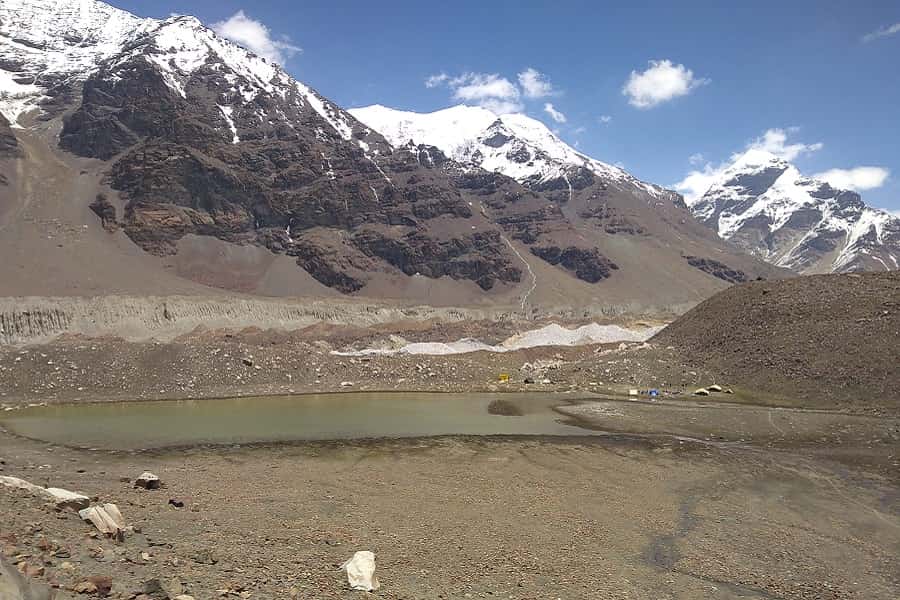
Satopanth Tal Trek Itinerary
To have a clear understanding of the journey you are planning to cover, you must check out this meticulously designed itinerary.
Day 1- Rishikesh- Badrinath- Drive for almost 300 km
You will be covering a total of 11 hours long road journey to reach Badrinath from Rishikesh. We would recommend you to start your day a little early in the morning so that you can reach the site on time and can save your energy for the next day’s schedule. You will be left with a little time in the evening when you can visit the pilgrimage. After darshan and completing the puja rituals return to the hotel for a night meal which is then followed by a relaxing overnight stay.
Day 2- Badrinath- Lakshmi Van- 5 hours long trekking
Kickstart your second day of the trip with a relishing morning meal and then get ready to move towards Mana Village . You can either think of covering the distance between Badrinath and Mana Village by walking or can hire a taxi or cab. After you have completed 3-4 hours of the distance you get to see the mesmerizing beauty of the gorgeous Vasudhara Falls.
After crossing the waterfalls area, keep on moving towards Lakshmi Van campsite elevated at 11,900 feet where you will go for an overnight stay in the tent.
Day 3- Lakshmi Van- Chakratirtha – 4 hours long trekking
On the 3rd day of your journey, you will be walking along the green grasslands along with the rocky areas of Dhano Glacier. This is going to be a very exciting journey where you will be enjoying glimpses of Bhagirathi peaks and the patches of colorful wildflowers. Start trekking towards Sahastradhara from where you get to enjoy the awe-inspiring views of the majestic Neelkanth Peak on a very clear day.
Go for an hour-long trek to reach the Chakratirtha Campsite from here.
Day 4- Chakratirtha to Satopanth Lake and back- 8 hours long trekking
This is the day when you start trekking towards Satopanth Lake from where you get the first glimpse of the pristine glacial lake. Enjoy the scintillating views of a lifetime with Swargarohini on the left, Neelkanth behind you, Balakun on the right, and Chaukhamba straight ahead. Climb up to Chakrateerth once you are done with clicking pictures.
Day 5- Chakrateerth to Badrinath via Mana- 6 hours long trekking
Climb down to Mana Village by following the same route which takes almost 6 hours. Take a direct jeep or cab to reach Badrinath if you feel too exhausted which you definitely would be.
Day 6- Badrinath- Rishikesh
On the last day of your journey, you will be taking a cab or bus to Rishikesh for your onward journey towards home. Take out some time to shop out your heart’s contents or souvenirs from either Rishikesh or Badrinath before you leave the state.
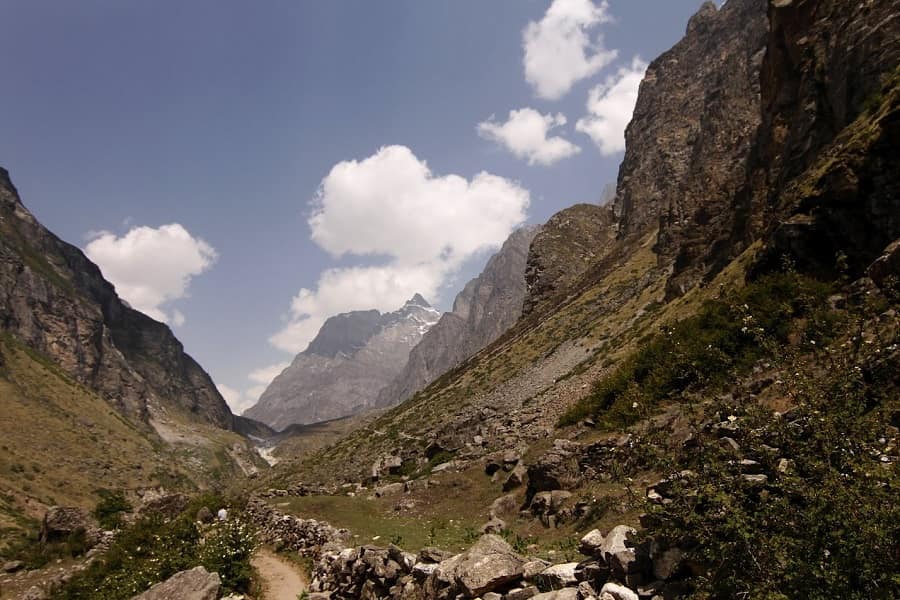
How Arduous is Satopanth Tal Trek
Although the trekking trail to reach the pristine glacial lake in Uttarakhand is of moderate level yet there are some challenges you are surely going to face.
Attitude Gain
- One of the most challenging things on a trek is steep attitude gain as when you climb up the hills, oxygen level in the atmosphere goes down. Our heart and the respiratory organs are bound to function more heavily and this is how acute breathing problems might also occur to someone.
Steep Climb on the 3rd Day
- You will be gaining an altitude of more than 2500 feet in altitude, so be ready for some heavy legwork. Do not forget to keep a water bottle with you to stay hydrated and also carry extra snacks in your bag so that you feel energized throughout the day.
Climate and Temperature
- One needs to stay updated with the weather forecast and be prepared for a sudden drop in the temperature, especially during the night. You will be acclimatizing for a day so that your body gets adapted to the cold climate of the region. The temperature often goes down to a sub-zero level and ranges between -5 and -7 degrees Celsius.
Mountain Sickness
- Altitude Motion Sickness is one of the most common challenges faced by the trekkers as there is a bit of rising in the altitude while climbing up to Satopanth Tal Lake. Altitude Motion Sickness is similar to motion sickness that causes headaches and nausea to the traveler. However, it is not a very serious problem but if ignored initially then it can become very dangerous.
Physical Fitness
- One needs to be physically very fit and should have great strength or else trekking to the height of 2000- 2500 feet is not possible. The entire terrain is covered with loose rocks, moraines, and boulders making the walk pretty stressful for the ankles and knees.
- The entire valley from Chakratirtha to Satopanth Lake is bedecked with thick sheets of snow throughout the year. One needs to be very smart and attentive while packing their trekking bags as your backpacks must include UV protected sunglasses to deal with the snow blindness, good pair of trekking shoes to comfortably walk on the moraines, and a good pair of gloves to keep your hands warm and help with snow handling.
Frequently Asked Questions about Satopanth Tal Trek
It is quite obvious for a traveler to have his/her mind filled with plenty of questions when they plan for this trekking trail. We have enlisted a few of the most commonly asked questions of the trekkers about this thrilling adventure.
Q: How High is Satopanth
- Ans- This crystal clear green water lake is nestled beautifully at an altitude of 4600 meters above sea level.
Q: How Do you Reach There?
- Ans – Badrinath is the starting point of this adventurous trail and then from there, one move to Mana Village. From this place, you will be crossing two campsites, first at Lakshmi Van and the other one is at Chakratirtha.
Q: Where is This Gorgeous Lake Located?
- Ans- This glimmering lake is located in the Chamoli district of Uttarakhand. Satopanth Lake is located closer to Badrinath Dham and is easily accessible from Mana Village.
Q: What is the Itinerary of the Satopanth Tal Trek?
Ans- The itinerary for this thrilling experience goes as follows-
- Day 1- Rishikesh to Badrinath
- Day 2- Badrinath to Lakshmi Van
- Day 3- Lakshmi Van to Chakratirtha
- Day 4- Chakratirtha to Satopanth and then return to Chakratirtha
- Day 5- Chakratirtha to Mana and then to Badrinath
- Day 6- Badrinath to Rishikesh
Q: How Difficult is Satopanth Trek
- Ans- The trek is of moderate to difficult level and you need to have prior trekking experience and a high fitness level to cover this trekking trail.
Leave a Reply Cancel reply
Your email address will not be published. Required fields are marked *
Save my name, email, and website in this browser for the next time I comment.
This site uses Akismet to reduce spam. Learn how your comment data is processed .

Satopanth Tal Trek | Complete Travel Guide
- August 24, 2023

If you’re an adventure enthusiast seeking a thrilling trekking experience amidst nature’s grandeur, the Satopanth Tal Trek should definitely be on your bucket list. Tucked away in the Garhwal Himalayas of Uttarakhand , India, this trek is a gateway to mesmerizing landscapes, alpine meadows, pristine glacial lakes, and a spiritual journey that resonates with the legends of Hindu mythology .
Introduction
Satopanth Tal Trek, nestled at an altitude of 4,600 meters (15,092 feet), promises an unforgettable journey through breathtaking landscapes. This trek is not only about conquering the heights but also about immersing yourself in the spiritual aura that surrounds the region.
Best Time to Visit
The Satopanth Tal trek is a stunning high-altitude trek in the Indian state of Uttarakhand. The best time to undertake this trek largely depends on the weather conditions, accessibility, and the overall experience you’re seeking. Here are the detailed points about the best time to visit Satopanth Tal:
- Weather: Summer is considered the prime trekking season. The weather is generally pleasant during the day, with temperatures ranging from 10°C to 15°C (50°F to 59°F). Nights can still be quite chilly, dropping to around 0°C to 5°C (32°F to 41°F).
- Landscape: The trail is surrounded by lush green meadows, blooming rhododendrons, and various alpine flowers. The clear skies offer excellent views of the surrounding peaks.
- Weather: Monsoon brings heavy rainfall to the region, making the trail slippery and challenging to navigate. Landslides and flash floods are common, posing risks to trekkers.
- Landscape: While the valley is cloaked in vibrant greenery, the weather conditions and safety concerns make this period unsuitable for trekking. It’s best to avoid this time due to the risks involved.
- Weather: Autumn is another favorable season for the trek. Days remain moderately cold, with temperatures ranging from 5°C to 10°C (41°F to 50°F), and nights get colder, dropping to -5°C to 0°C (23°F to 32°F).
- Landscape: The meadows turn golden, offering a breathtaking contrast against the clear blue skies. The views are spectacular, with panoramic vistas of the surrounding peaks.
- Weather: Winter brings heavy snowfall to the region, making the trekking trail inaccessible and dangerous. The temperatures plummet to sub-zero levels, and the high-altitude conditions can be life-threatening for inexperienced trekkers.
- Landscape: The entire region is covered in snow, creating a serene but challenging environment. This period is not recommended for trekking due to the extreme conditions.
- Accessibility: The trek is typically accessible from May to early June and October to early November. These months offer a window of opportunity when the weather is relatively favorable, and the trail is passable.
- Experience: If you’re seeking lush landscapes and vibrant flora, opt for the summer or autumn months. For a more challenging snow-filled adventure, you might consider visiting in late spring (late May) when snow is still present but melting.
How to Reach
Reaching the Satopanth Tal trek involves a series of travel modes to reach the starting point of the trek at Mana Village near Badrinath in Uttarakhand, India. Here’s a detailed guide on how to reach the trek:
- Nearest Airport: Jolly Grant Airport in Dehradun is the closest airport to the trek.
- From Dehradun: Take a taxi or local transport to reach Badrinath , approximately a 10-12 hours drive.
2. By Train:
- Nearest Railway Station: Dehradun Railway Station is the nearest major railway station.
- From Dehradun: Travel by road from Dehradun to Badrinath, which takes around 10-12 hours.
3. By Road:
- Road Route: You can reach Badrinath by road from major cities like Delhi, Haridwar , and Rishikesh. State-run buses, private buses, and taxis are available.
- Delhi to Badrinath: The drive from Delhi to Badrinath takes approximately 10-12 hours.
4. Badrinath to Mana Village:
- Last Motorable Point: Mana Village is the last motorable point before the trek.
- Travel to Mana: From Badrinath, which is around 3 kilometers away, you can hire a taxi or use shared jeeps to reach Mana Village.
5. Trek Start:
- Mana Village: The trek starts from Mana Village, which is also the last village before the border with China (Tibet).
- Trek Registration: Register yourself at the forest check post in Mana Village and obtain any necessary permits.
6. Trekking Route:
- Trek Duration: The trek usually takes 7-9 days to complete, depending on the route and weather conditions.
- Route: The trail passes through beautiful landscapes, including lush meadows, dense forests, and rocky terrain. The final destination is Satopanth Tal Lake.
7. Return Journey:
- After Trek: Once the trek is complete, you’ll return to Mana Village.
- Transport: From Mana Village, you can take transport back to Badrinath, and then proceed to your next destination.
Important Tips:
- Weather Check: Always check the weather conditions and road accessibility before starting your journey.
- Permits: Ensure you have any required permits and registrations for the trek.
- Local Information: Seek information from locals or your trekking guide for the most updated details about travel routes and conditions.
Trek Itinerary
Day 1: arrival in badrinath.
Your journey commences in Badrinath, where you can explore the town’s religious significance and prepare for the trek ahead.
Day 2: Badrinath to Laxmivan
The trek starts with a moderate ascent to Laxmivan, surrounded by picturesque vistas.
Day 3: Laxmivan to Chakratirtha
Traverse through vibrant meadows and gradually gain altitude as you reach Chakratirtha, a camping site with stunning views.
Day 4: Chakratirtha to Satopanth Tal
The most challenging leg of the journey takes you to the mesmerizing Satopanth Tal, where the tranquil waters mirror the sky.
Day 5: Exploration and Return to Laxmivan
Spend a day exploring the area around the lake, and then retrace your steps back to Laxmivan.
Day 6: Laxmivan to Badrinath
Descend to Badrinath, concluding your trek with a sense of accomplishment.
Trek Difficulty
The Satopanth Tal trek is a challenging high-altitude trek that requires good physical fitness, prior trekking experience, and proper acclimatization. Here are detailed points about the trek’s difficulty:
- The trek starts at Mana village, which is already situated at an elevation of around 3,048 meters (10,000 feet). The altitude gradually increases as you proceed, with the highest point being the Satopanth Tal Lake at approximately 4,600 meters (15,092 feet).
- Rapid altitude gain can lead to altitude sickness, so acclimatization is essential. Trekkers should take their time and allow their bodies to adjust to the changing altitude.
- The trek is around 44-48 kilometers (27-30 miles) in total, covering varying terrain including steep ascents, descents, and rocky paths. Trekkers usually complete the trek in about 7 to 9 days, depending on the route taken and individual pace.
- The trail encompasses a mix of terrains, including rocky paths, meadows, moraines, and snow patches, especially during early summer and late spring.
- Some sections involve steep ascents and descents, which can be physically demanding, especially at higher altitudes.
- Weather conditions can be unpredictable, even during the best trekking seasons. Trekkers might encounter sudden changes in weather, including rain, snow, and strong winds, which can make the trek more challenging.
- The trek requires a good level of physical fitness and endurance. Trekkers should be prepared for long hours of walking each day, often ranging from 5 to 8 hours, with occasional longer stretches.
- While the trek doesn’t involve technical climbing, trekkers might need to cross snow patches or glaciers in certain sections. Basic knowledge of using trekking poles, crampons, and ropes might be beneficial.
- The trek takes you through remote areas with limited or no access to modern facilities. Trekkers need to be self-sufficient, carrying essential items like camping gear, food, and warm clothing.
- The trek’s high altitude increases the risk of altitude-related issues. Trekkers should be aware of the symptoms of altitude sickness, such as headache, nausea, dizziness, and shortness of breath, and descend if symptoms worsen.
- Due to the trek’s demanding nature, prior high-altitude trekking experience is recommended. Familiarity with multi-day treks and the ability to navigate changing terrains and weather conditions will greatly enhance your experience.
- Hiring a local guide and/or porter is advisable. Guides are familiar with the terrain and can help with navigation, while porters can assist with carrying heavy loads, allowing trekkers to conserve their energy.
Packing Essentials
Packing essentials for the Satopanth Tal trek:
- Long-sleeved thermal tops and bottoms to keep you warm and dry.
- Fleece or down jacket for added warmth during colder parts of the trek.
- Comfortable and durable pants that allow easy movement and can be converted to shorts.
- Essential to protect against rain and wind, preferably with a hood.
- To keep you dry during unexpected rain showers.
- Warm hat or beanie to keep your head warm and a cap to shield from the sun.
- Insulated, waterproof gloves to protect your hands from cold and moisture.
- Moisture-wicking and cushioned socks to prevent blisters.
Footwear: 9. Trekking Boots:
- Sturdy, waterproof, and ankle-supporting boots with good traction.
- Lightweight and comfortable shoes for wearing around the campsite.
11. Backpack: – A well-fitting backpack to carry your essentials. Opt for one with proper back support and adjustable straps.
12. Sleeping Bag: – Warm sleeping bag suitable for the expected temperatures.
13. Sleeping Pad or Mat: – Provides insulation and comfort while sleeping.
14. Trekking Poles: – Helps with stability and reduces strain on knees during descents.
15. Headlamp or Flashlight: – Essential for visibility during early morning or night treks.
16. Reusable Water Bottles: – Stay hydrated by carrying at least two reusable water bottles.
17. Personal Identification: – Carry an ID card, passport, and necessary permits.
18. Personal Medications: – Prescription medications, first aid kit, and any personal medical supplies.
19. Sunglasses and Sunscreen: – Protect your eyes and skin from harsh sunlight.
20. Trekking Towel: – Quick-drying and lightweight towel for personal hygiene.
21. Toiletries: – Toothbrush, toothpaste, soap, hand sanitizer, and wet wipes.
Miscellaneous:
22. Camera or Binoculars: – Capture the breathtaking landscapes or observe wildlife.
23. Power Bank: – Keep your devices charged, especially if you’re using them for navigation or photography.
24. Notebook and Pen: – Helpful for jotting down notes, thoughts, or observations.
25. Snacks: – Energy bars, trail mix, and quick snacks for sustenance on the trail.
Remember, pack according to the specific weather conditions during your chosen trekking season. It’s essential to strike a balance between carrying necessary items and not overburdening yourself. Plan well, stay organized, and prioritize comfort and safety.
Flora and Fauna
The Satopanth Tal trek is known for its diverse and unique flora and fauna, which thrive in the Himalayan ecosystem. Here are detailed points about the flora and fauna you might encounter during the trek:
- The lower altitudes are adorned with colorful alpine meadows, carpeted with a variety of wildflowers, including primroses, blue poppies, and buttercups.
- The trail passes through dense rhododendron forests, particularly vibrant during the spring months when these trees are in full bloom.
- As you ascend, you’ll come across birch and oak forests, providing a unique contrast against the white snow in winters.
- Juniper bushes are commonly found along the higher altitudes of the trek, and they often provide important shelter and food for local wildlife.
- Mosses and lichens cover rocks and trees, creating a lush and magical appearance in certain sections of the trail.
- Often spotted grazing on the rocky slopes, these sure-footed ungulates are adapted to high-altitude environments.
- Another herbivorous species, Himalayan tahr, can be seen on the steeper cliffs and rocky terrains.
- Small, rabbit-like creatures known as pikas are often spotted scurrying about, gathering food and nesting materials.
- The vibrant and colorful Himalayan Monal is the state bird of Uttarakhand. You might catch glimpses of its iridescent plumage.
- While rare to spot, the region is known to be home to elusive snow leopards. Their presence adds to the trek’s allure.
- Red foxes are commonly found in the Himalayas and are known for their adaptability to various altitudes.
- During the spring and summer months, the trekking route becomes a haven for various migratory birds, contributing to the rich birdwatching experience.
- The meadows host a variety of insects and butterflies, contributing to the vibrant and diverse ecosystem.
- These domesticated animals are often used as pack animals for transporting goods in the higher reaches.
- Various types of mountain goats, such as the Himalayan Ibex, might be seen clinging to steep cliffs and rocky slopes.
Cultural Significance
The Satopanth Tal trek holds significant cultural importance due to its association with Hindu mythology, ancient traditions, and the religious beliefs of the local communities. Here are detailed points about the cultural significance of the Satopanth Tal trek:
- Pandavas and Mahabharata: The trek is linked to the epic Mahabharata. According to Hindu mythology, the Pandavas, protagonists of the Mahabharata, are believed to have taken this route on their journey to heaven.
- Spiritual Journey: Many trekkers view the trek as a spiritual journey to connect with the divine and follow in the footsteps of the Pandavas.
- Pilgrims’ Beliefs: The area is considered sacred, and pilgrims undertake the trek to seek blessings, purification, and spiritual growth.
- Mana Village: The starting point of the trek, Mana is the last inhabited village near the Indo-China border. It’s believed to be the home of the Yakshas, a mythical race.
- Vyas Gufa: A cave where the sage Vyas is said to have composed the Mahabharata, adding to the area’s cultural and historical significance.
- Badrinath Temple: The trek starts near the famous Badrinath Temple, one of the Char Dham pilgrimage sites dedicated to Lord Vishnu.
- Mata Murti Temple: En route, trekkers visit this temple dedicated to Mata Murti, the mother of the Pandavas.
- Sacred Lake: The Satopanth Tal Lake is believed to be a site of cosmic significance where Lord Brahma, Vishnu, and Maheshwara (Shiva) reside. It’s considered a trijunction of the divine trinity.
- Rituals and Offerings: Trekkers often perform rituals and offer prayers by the lake to seek blessings and fulfill their wishes.
- Local Communities: The trek takes you through villages inhabited by the Bhotiya community, known for their unique culture and way of life.
- Himalayan Festivals: If your trek coincides with local festivals, you may witness traditional rituals, dances, and celebrations.
- Interactions: Interacting with the local communities provides insights into their way of life, traditions, and beliefs.
- Respectful Engagement: Engage with local customs and practices respectfully to foster cultural understanding.
- Cultural Preservation: Efforts are being made to preserve the cultural heritage of the region and promote sustainable tourism that respects local traditions.
- Oral Traditions: Local guides often share mythological stories and historical narratives, enriching trekkers’ understanding of the region’s cultural heritage.
- Connecting Generations: By learning and sharing these stories, the cultural significance of the trek is passed down to future generations.
The Satopanth Tal trek offers not only a physical journey through breathtaking landscapes but also a cultural journey through the heart of Hindu mythology and the rich traditions of the Himalayan region.
Safety Measures
Safety measures to consider for the Satopanth Tal trek:
1. Pre-Trek Preparation:
- Fitness Assessment: Ensure you are physically fit and capable of handling the demands of high-altitude trekking.
- Medical Check-Up: Consult a doctor for a health check-up, and inform them about your trekking plans.
2. Experienced Guide and Team:
- Local Guide: Hire an experienced local guide who is familiar with the trail, weather conditions, and emergency procedures.
- Porters: Consider hiring porters to carry heavy loads, allowing you to focus on trekking.
3. Acclimatization:
- Gradual Ascent: Follow a gradual ascent profile to acclimatize properly and reduce the risk of altitude sickness.
- Rest Days: Incorporate rest days into your itinerary to aid acclimatization.
4. Altitude Sickness Awareness:
- Recognize Symptoms: Educate yourself about the symptoms of altitude sickness, such as headache, nausea, dizziness, and shortness of breath.
- Descend if Necessary: If symptoms worsen, descend to a lower altitude immediately.
5. Weather Awareness:
- Check Forecasts: Stay updated on weather forecasts before and during the trek.
- Be Prepared: Carry appropriate clothing for different weather conditions, including rain and snow.
6. Hydration and Nutrition:
- Stay Hydrated: Drink plenty of water throughout the trek to prevent dehydration, but avoid overhydration.
- Balanced Diet: Consume nutritious meals to maintain energy levels. Pack high-energy snacks.
7. Equipment and Gear:
- Quality Gear: Ensure your gear is of good quality and appropriate for the conditions.
- Equipment Check: Regularly check your gear, including trekking poles and boots, for wear and tear.
8. First Aid and Medications:
- First Aid Kit: Carry a well-stocked first aid kit with essentials like bandages, antiseptics, pain relievers, and blister treatment.
- Personal Medications: Pack any necessary prescription medications and inform your guide about them.
9. Emergency Contacts:
- Local Authorities: Know the local emergency numbers and the nearest medical facilities.
- Communication: Carry a charged mobile phone with emergency contacts saved.
10. Navigation:
- Map and GPS: Carry a map, GPS device, or smartphone with navigation apps for route guidance.
- Offline Maps: Download offline maps in case of no network coverage.
11. Emergency Shelter and Communication:
- Emergency Shelter: Carry a lightweight emergency shelter or bivvy bag.
- Signal Devices: Consider carrying a whistle, mirror, or signaling devices for emergencies.
12. Group Safety:
- Stay Together: Trek in a group and avoid splitting up.
- Buddy System: Have a trekking buddy and keep each other in sight.
13. Respect Local Customs and Environment:
- Cultural Sensitivity: Respect local customs, traditions, and practices.
- Leave No Trace: Follow the principles of “Leave No Trace” and pack out all your waste.
14. Insurance:
- Travel Insurance: Ensure you have comprehensive travel and medical insurance that covers high-altitude trekking.
15. Evacuation Plan:
- Emergency Evacuation: Be aware of the evacuation procedures and the nearest evacuation points.
Remember, safety should be your top priority. Proper planning, awareness, and adherence to safety guidelines will enhance your trekking experience and ensure you return safely.
In conclusion, the Satopanth Tal trek is a remarkable journey that intertwines natural beauty, cultural significance, and adventure in the heart of the Himalayas. As you embark on this trek, you’ll find yourself immersed in breathtaking landscapes, ranging from lush meadows and rhododendron forests to rugged terrains and snow-covered expanses. The trek’s association with Hindu mythology adds a profound spiritual dimension, making it not just a physical endeavor but a pilgrimage of sorts.
The diverse flora and fauna you encounter along the way are a testament to the resilience of life in these high-altitude environments. From colorful Himalayan Monals to elusive snow leopards, each sighting adds to the enchantment of the journey.
However, embarking on the Satopanth Tal trek requires careful preparation. Adequate physical fitness, proper acclimatization, and essential gear are crucial to ensure a safe and enjoyable experience. Hiring an experienced guide and considering the cultural and environmental aspects of the region contribute to responsible and sustainable trekking.
As you traverse the trail, you’ll not only connect with nature but also with the rich cultural heritage of the Himalayan region. The journey is an opportunity to learn from local communities, hear ancient stories, and witness traditions that have withstood the test of time.
In summary, the Satopanth Tal trek offers a blend of adventure, spirituality, and cultural immersion that stays with you long after the trek is complete. It’s a chance to be humbled by the grandeur of the mountains, inspired by the legends that echo through the valleys and enriched by the connections you forge along the way. Whether you seek solace, challenge, or seek a deeper understanding of the world around you, the Satopanth Tal trek holds the promise of a transformative experience amidst the splendor of the Himalayas.
FAQs – Satopanth Tal trek
- Is prior trekking experience necessary for the Satopanth Tal Trek? While prior trekking experience is beneficial, beginners with good fitness levels can also undertake this trek with proper preparation.
- Are there accommodation facilities on the trek? Yes, there are camping sites and basic guesthouses available at various points along the trail.
- What kind of weather can be expected during the trek? Weather can be quite unpredictable. It’s advisable to carry both warm and waterproof clothing.
- Are solo treks recommended? It’s recommended to trek with a group or a certified guide due to the challenging terrain and potential altitude-related risks.
- Can I engage in photography throughout the trek? Absolutely! The landscapes are a photographer’s paradise. Just ensure you have spare batteries and memory cards.
Related Posts
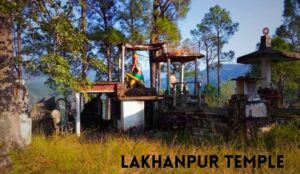
Lakhanpur Temple in Chaukhutia
In the lush green hills of Uttarakhand, amidst the tranquil surroundings of Chaukhutia village, lies a sacred haven that whispers stories of faith and folklore.
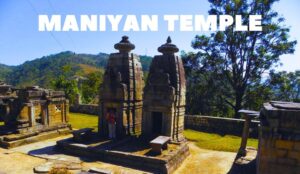
Maniyan Temple – A Spiritual Gem in Uttarakhand
Nestled amidst the picturesque Kumaon Hills of Uttarakhand, the Maniyan Temple complex stands as a testament to the region’s rich history and vibrant spiritual heritage.
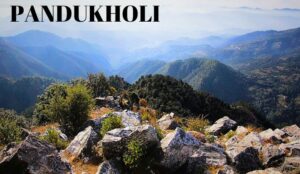
Pandukholi A Heaevn in Kumaun Hills
Nestled in the serene folds of the Kumaon Himalayas in Uttarakhand, India, Pandukholi is a captivating destination known for its breathtaking natural beauty, spiritual significance,
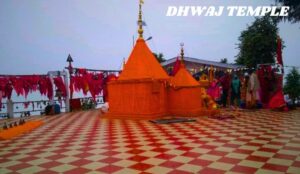
Dhwaj Temple in the Heart of Pithoragarh
Nestled in the serene and picturesque landscapes of Uttarakhand, the Dhwaj Temple is a beacon of spirituality and natural beauty. Located in Pithoragarh, a quaint

Saurabh Kanu
Full time travel guide.
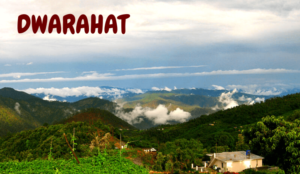
Dwarahat Kumaon Hills of Uttarakhand
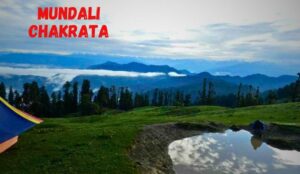
Mundali Chakrata Hidden Gem of Uttarakhand
This is the heading.
Wander Sky: The Travellers’s Space
As Luis Bunuel rightly said, ‘A life without memory is no life at all” and we believe in helping wanderers build a memory worth remembering. Experienced members of Wander Sky provide exceptional trips with interesting stories to live by.
We are a team of experienced guides and trip planners who are working to make the next “wander” a “wonder”. In more than 5 years, we have led thousands of wanderers for over 20+ treks and 30+ trips. We have expertise in organizing treks and trips all across India including all major Himalayan treks.
Featured Trips
Important links.

Home » Shop » Satopanth Tal Trek
- getting there
- Detailed itinerary
- cost inclusions
- cancellations
- 1 Week trek
- Garhwal Treks
- Moderate Grade Treks in Himalayas
- Summer Treks
- Uttarakhand
Satopanth Tal Trek:
Upcoming summer Satopanth tal trek starting on 26th May 2024 at Badrinath on Day 1 as per the given itinerary.
The mythical lake trek route to Satopanth Tal encompasses the flavor of high altitude feature, walking on boulder, moraine, glacier and knife edge ridge are enthralling. Captivating peak views are hard to believe. This triangular shaped glacial lake lies above 14000 ft, hidden inside the ridge believed to be the “the road to truth” (Satya ki pantha or path) .

The Panch Pandavas of epic Mahabharata took this difficult trail to try to reach the heaven. At different places on the trail, the legends still live, and the names bear the resemblance of the myth. Towering Chaukhamba ridge looms over the lake along with the Neelkanth, Balakun, Parvati and other peaks. Many people believe that the Trimoortis, Brahma, Vishnu and Maheshswar, take bathe in the lake in an auspicious day. Adventurous devotees and Sadhus visit this lake in the monsoon for pilgrimage.
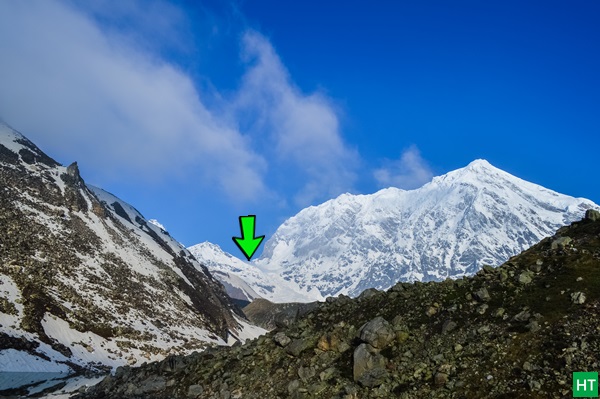
This trail is a classy example of glacier moraine walk on boulders, loose rock and scree zones to the core of the Himalayas and NOT recommended for the beginners . Trekkers must be having prior high altitude multi day trekking experiences.
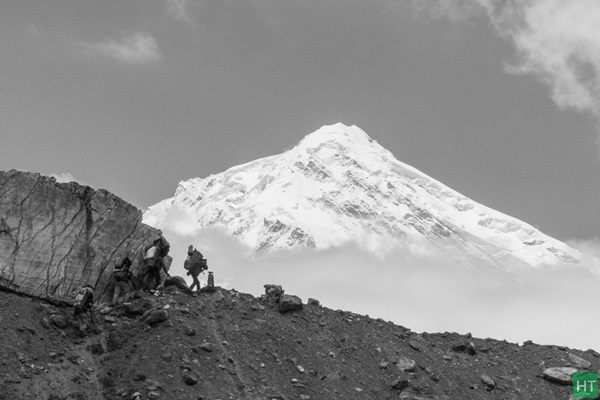
After crossing Alaknanda at Mana the trail till Laxmivan is relatively easy and like the usual trekking trails. The trail on the opposite side of the river goes to Vasudhara falls. Campsite of Laxmivan is located on a patch of grass and perhaps the campsites are the only shades of green from now on.
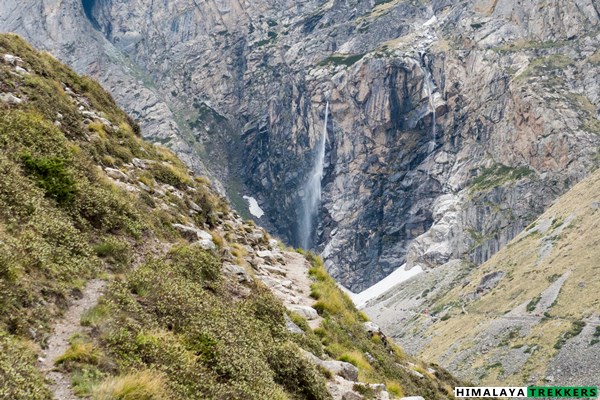
Brief Itinerary for Satopanth trek:
Day 1: Drive from Rishikesh to Badrinath – 290 Km – 11 to 12 hours. Accommodation and meals on your own (NOT included in the TREK FEE). Day 2: Meet your trek guide and briefing. Active Acclimatisation at Badrinath – Walk towards Charan Paduka or Mana etc, in the afternoon you may visit the holy temple. Accommodation and meals on your own. Day 3: Trek from Badrinath to Laxmivan – 10 km – 6 hours. Camp on a twin sharing basis. Day 4: Trek to Chakratirtha – 9 Km – 5 to 6 hours. Camp Day 5: Trek to Satopanth Tal – 5 Km – 3 hours – spend an hour or so and return to Chakratirtha – Total 10 Km – 8 hours. Camp Day 6: Trek from Chakratirtha to Mana – 15 Km – 6 to 7 hours – Walk or drive to Badrinath 3 Km – 1 hour or so. Accommodation and meals on your own . Day 7: Drive from Badrinath to Rishikesh – 290 Km – 1 1o 11 hours. Dehradun airport (DED, Jolly Grant or haridwar railway station is an hour’s drive from Rishikesh.
Important Note:
- You need to reach on their own to Rishikesh on Day 1 morning (by 6 am) or the previous night. Return to Rishikesh on Day 7 evening (by 8 pm). Arrange your tickets for inward journey and return from Rishikesh accordingly.
- TREK FEE ₹ 15,950 + 5% GST per person is excluding Badrinath and includes everything for the trek to Satopanth and back, i.e. 4 days of trekking.
- For further acclimatisation you may reach Joshimath on Day 0 and then move to Badrinath next day, i.e. Day 1 of our itinerary.
Satopanth Tal trek route and the legend:
We are purely trek organisers and run this trek once or twice in a year for interested and experienced Himalayan hikers.This typical glacial moraine trail into the core of the Himalayas is indeed a delight to any trekker. At the same time 50 Km round trip from Badrinath is tricky in many aspects. It is a full camping style porter run (no horses/mules) trek and there is nowhere you get any food or shelter. This glacier valley is typically low in oxygen and trekkers must get acclimatised once reaching Chakratirtha. If not, there is noway but to return. You need to negotiate boulder zones, moraine debris and scree zones before reaching Satopanth Tal.
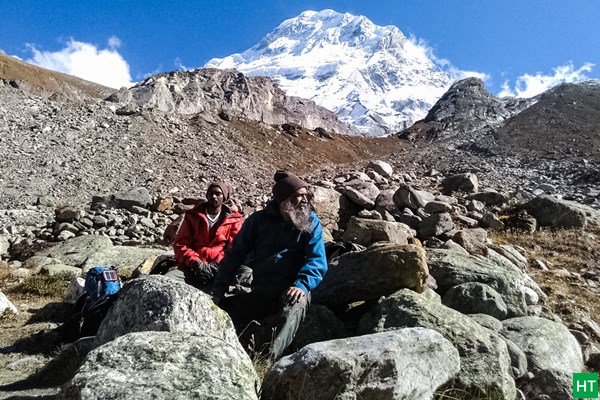
We often get requests from people wishing for Satopanth and Swargarohini Yatra . This must be taken as a high altitude Himalayan trek and the pilgrims must have prior trekking experiences like Kailash, Adi Kailash, Manimahesh, Kinnaur Kailash circuit, Srikhand Mahadev or similar, preferably all. Swargarohini area is out of scope of this trek as that is a mountaineering pursuit. On a clear day one can see clearly the legendary Swargarohini steps from Satopanth Tal and its surrounding. Here is how it looks from Satopanth on a clear day.
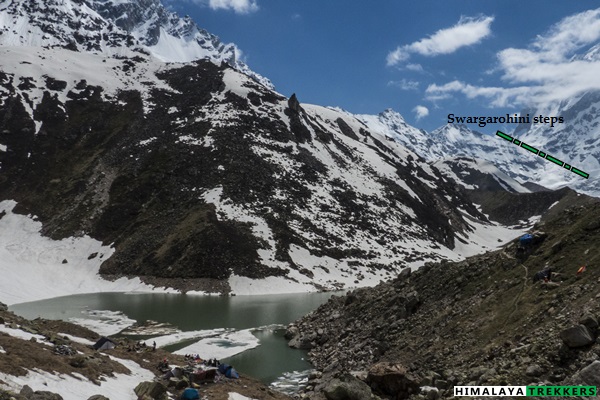
Camping restricted at Satopanth Tal (with effect from Sep 2018):
As per Uttarakhand High Court order (Petition No. : 123/2014 ) , one can not camp on alpine and sub-alpine meadows/grasslands, locally called “Bugyal”. Therefore forest department has revoked the permit to camp at the lake, i.e. Satopanth Tal. Starting from Sep 2018, our highest camp is at Chakratirtha and we visit Satopanth and return to same camp.
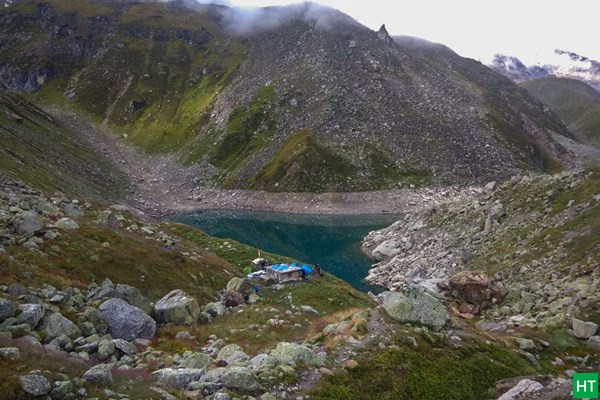
Access to Satopanth trek base – Badrinath:
To reach the trek base Badrinath you need to reach Haridwar on your own arrangements. Haridwar is well connected by train from Delhi and Kolkata. Frequent regular and Volvo bus service from Delhi Kashmiri Gate ISBT.
Based upon trekkers request we may arrange a pickup from Haridwar railway station to Badrinath and back. This will be shared equally by the availing team members on actual basis and paid directly to the driver. The fare is ₹ 8000 for a Tata Sumo/Mahindra Maxx one way. This can accommodate 5 to 6 people. A Tempo Traveller charges ₹ 12000 (12-13 seat) one way. This is NOT included in TREK FEE.
You can reach Badrinath by bus which start very early morning from Haridwar, latest by 4:30/5 am. Its a long journey and may take up to 13/14 hours.
To reach the trek base Badrinath independently/public transportation check the details in GETTING THERE TAB.
Click here to check the List of things to carry in Satopanth Tal trek or Download the PDF list.
Duration: 4 days of trekking from Badrinath to Satopanth Tal and return. Haridwar to Haridwar in 7 days.
Prerequisite: Prior high altitude trekking experiences are must. At least 2 Moderate grade treks are highly recommended.
Grade: Moderate
Physicality: 7/10
Trail Length: 50 Km
Highest Point: Satopanth Tal ~ 4400 m/14430 ft
Seasons: June & August/September
Access: Trek starting point (trek base) is Badrinath, 310 Km from Haridwar
Rail station: Haridwar (Station Code: HW)
Airport: Delhi, Jolly Grant in Dehradun (Airport Code: DED)
Upcoming scheduled dates for Satopanth Tal trek:
- You can check the scheduled Fixed Departure dates in the calendar available inside Booking Form or inside REGISTER NOW form. Tour starting Dates are highlighted as per our itinerary ( Day 1 of 8 days itinerary ).
- At present BOOK NOW functionality is disabled . You can get all the information in your email by submitting the REGISTER NOW form.
- If you are a group of people and available dates are not matching then you may select Custom date mode (by clicking the Select your custom date) and fill in the displayed form.
- You can also check all the available dates at a glance in our TREK CALENDAR .
- Trekkers need to reach Haridwar on Day 1 morning (latest by 6 am) or the previous night. Return to Haridwar on Day 8 evening (around 8/9 pm). Arrange your tickets for inward journey and return accordingly.
Access to Badrinath (The trek base): Haridwar is well connected by train from Delhi and Kolkata. Frequent regular and Volvo bus service from Delhi Kashimiri Gate ISBT.
To reach the trek base Badrinath you need to reach Haridwar by your own arrangements.
We will arrange a pickup from Haridwar to Badrinath and back. The cost will be shared equally by the team members and is approximately around 7000 Rs one side in a Jeep (Mahindra Maxx, Sumo). One such Jeep is comfortable for 6-8 persons.
If you want to reach and return from Badrinath by public vehicle then:
1) Take early morning bus service from Haridwar to directly Badrinath or till Joshimath. Direct buses leave by 5 am. The state operated Bus terminus (referred as Roadways) is just opposite to the Haridwar railway station. Privately operated buses start just 2 minutes walking from here. In the summer during Char Dham Yatra, buses are packed. It takes 11/12 hours to reach Joshimath. Look for a shared Jeep service or book a car till Badrinath. It may take up to 14 hours.
2) From Badrinath early in the morning board the direct bus for Haridwar/Rishikesh. It will take 12 hours. From Rishikesh, it is only 25 Km journey to Haridwar by frequent bus service.
There are direct trains from Kolkata to Haridwar.
KUMBHA EXPRESS – Train No. – 12369 ( Very good option to reach Haridwar by 5 pm; Spend the night in Haridwar and start your onward journey by car next morning)
UPASANA EXPRESS – Train No. – 12327 ( Very good option to reach Haridwar by 5 pm; Spend the night in Haridwar and start your onward journey by car next morning)
DOON EXPRESS – Train No. – 13009 ( Don’t book this train when you plan a long onward journey immediately in the morning)]
Avoid booking wait listed (WL) tickets in AC classes (1A/2A/3A) or Chair Car (CC). Book Sleeper class (SL)/Second Sitting class (2S) tickets which have normally more seats/berth and hence much better chance to get confirmed.
Following trains are good to reach Haridwar and run daily.
DDN JANSHTBDI – Train No. 12055 (Arrives HW in the evening @ 7:30 pm, good choice when you stay the night in Haridwar and have a long drive ahead next day) NANDA DEVI EXP – Train No. 12205 (arrives HW early morning @ 4am) UTKAL EXPRESS – Train No. 18477 (arrives HW in the night @ 9pm) MUSSOORIE EXP – Train No. 14041 (arrives HW in the morning @ 5:45am) Always avoid booking waitlisted (WL) tickets in AC classes (1A/2A/3A) or Chair Car (CC). Book Sleeper class (SL)/Second Sitting class (2S) tickets which have normally more seats/berth and hence much better chance to get confirmed.
Govt. Road Transport (Roadways of Uttarakhand, Uttar Pradesh, Delhi, Haryana, Punjab etc.) buses are frequently available in day time and night from Kashmiri Gate ISBT ( http://www.delhi.gov.in/wps/wcm/connect/doit_transport/Transport/Home/ISBT/Fare+Chart ). Tickets are available on board for these regular type buses. From Delhi Airport or Station you can reach ISBT Kashmiri Gate via Delhi Metro service ( http://www.delhimetrorail.com/metro-fares.aspx ). It is only 4 Km from NDLS and can be reached easily by booking an auto rickshaw.
For privately operated bus, you can book online from different portals ( http://www.redbus.in ). Select a boarding point suitably. Overnight Volvo/A.C/Push back bus service.
For night stay in Haridwar:
Trekkers reaching on the previous day before the journey to the actual trek base need to stay the night in Haridwar. There are several options in Haridwar for spending a night while staying in Premium, Standard or Budget accommodation. Options vary from Privately operated Hotels/Lodges, to State run Tourist rest House and Dharamshalas.
State run GMVN (Garhwal Mandal Vikas Nigam) operates Hotel Rahi just beside the Bus Stand and opposite to the Haridwar Railway Station. This is a reliable and a decent choice for Standard accommodation. Check the following for online booking of the above: http://www.gmvnl.com/newgmvn/tour/booktrh.asp You can call or visit GMVN nearest office or even send an email for more information.The information is available at: http://www.gmvnl.com/newgmvn/online_reservation/#
Normally you reach Haridwar from any trek base by 7/8 pm in the evening. You can take any train after 9 pm or regular bus service as mentioned above to reach Delhi or directly to your homeward journey in the same night.
Drive from Haridwar to Badrinath – 310 km – 12 hours
You must reach Haridwar by 5 am latest or you can reach the previous evening/night. This is possibly one of the longest journeys in a day on the mountain. From the plains of Haridwar to the the holy shrine of Badrinath at 3000 m/10000 ft. The road (NH 58) follows initially the valley of River Ganga, and later for a major section beside its main tributary Alaknanda. On route we cross Rishikesh and then the confluence at Deoprayag, Rudraprayag, Karnaprayag, Nandaprayag to reach Joshimath. From here Badrinath is another 45 Km. Total distance is 310 Km and can take around 13/14 hours. Night stay at lodge/rest house.
Note: Trekkers having an extra day and willing to spend on the mountain are advised to reach till Joshimath on first day. Next day after lunch you can reach Badrinath in 2/3 hours drive (by bus or reserved car). In Joshimath town you may visit Shri Shankracharya Math, Bhavishya Kedar & Narsing temple or a car trip to Auli, (14 Km, 45 mins drive) or a ride in Auli Rope way. So it is better to stretch this journey in 9 days instead 8 days as this one.
Active Acclimatisation at Badrinath
After a much needed sleep today visit the Badrinath temple in the morning at your will. After lunch we will walk either to Mana Village or to Charan Paduka area for an acclimatisation walk. This is pretty much a must at Badrinath which is already a place devoid of visible tree and having an oxygen level of only 70% that of sea level. Mana village is only 3 Km away from Badrinath. This is a small settlement of Tibetan/Bhutia/Bhote people and settled here for ages. People stay here only in summer and monsoon. From fall they start their downward movement to lower areas. At Mana you will find a SBI ATM welcoming that we are at the last ATM in the Indian side. At Bhim Pul you can see Saraswati river gushing down carving the rocks and disappearing inside a cave. However you can see clearly this stream meets Alaknanda just after a while.
Trek to Laxmivan – 9 Km – 5/6 hours
Today morning after breakfast we start our 5 days trek to Satopanth and back. We will follow the Alaknanda river and will keep the river on our right (true right of the river). In June it is possible to cross the river at Mana as the snow bridge after Mana normally remains good and intact. In post monsoon you will cross the river at Badrinath temple bridge and turn left to take the concrete track for few kilometres. The trail is a gentle uphill following Alaknanda. Walking around 3 hours we reach a flattened ground called Chamtoli Bugyal. Myriads of tiny wildflowers bloom during summer and monsoon in this valley. Vasudhara falls is just opposite to this on the other side of river. From here it is another hour to our camping ground called Laxmivan (~ 3650 m/11650 ft). Total distance is 9 Km and may take 6 hours. Though called a “Van”(Forest in Hindi), this place is only a patch of green grass on the trail. Draupadi of Mahabharata supposed to breath her last here. From this ground the views are simply breath taking, in fact in all our next camping grounds. If you look directly north, you will notice that two glacial valleys connecting ahead. the right is the Alkapuri valley, the source of the river Alaknanda. This is also said to be the abode of Kuber, Yakshas and Gandharvas. The fluted peak called Shri Parvat is at the head of the valley and is mesmerising during the sunrise from this camp. Looking back you can see the Mana peak towering above Mana area. The valley which turned right is the one towards Satopanth Tal and we will follow tomorrow. On the other side of the river you can see the much famed Vasudhara waterfalls. Tent accommodation for the night.
Trek to Chakratirtha – 11 Km – 6/7 hours
Today we trek to Chakratirtha another 11 Km ahead towards Satopanth Tal. Initial 2 km is an easy walk till Bandhar from where the valleys bifurcate. This area has quite a few Rhododendron bushes flowering late in May. From here the terrain changes to typical glacial moraine covered with boulders and rocks. On our left locate a single standalone rock pillar named Bhim Gada. We cross the stream in a suitable place and continue to walk on the moraine ridge. After continuing for couple of hours we reach Sahastradhara, where numerous waterfalls cascading down the mountains on the left. As per legend brother twins Nakula and Sahadeva died around this place. Crossing the area we climb on moraine ridge and continue for another two hours to reach another patch of green, beautiful camping ground called Chakratirtha (~ 3950 m/12750 m). The way may take 6/7 hours. The view of Mount Neelkanth from this campsite produces a different angle and face of this iconic mountain. Lord Arjuna died at this holy place. We camp for the night.
Trek to Satopanth Tal – 5 Km – 4/5 hours – In the afternoon walk around the lake
After breakfast we start our today’s trek to Satopanth Tal. Leaving behind our camping area we climb on a steep section to reach the shoulder of a ridge. From here the view unfurls and Chaukhamba massif marks the end of this valley ahead. The terrain becomes rough, full of scree, moraine and debris. We continue our climb and slowly gain altitude while crossing smaller ridges hiking up and down. Though the distance is short but the journey is tiring. Finally we climb a ridge and the turquoise lake is seen in the depression. The shape of the lake is like a “Boomerang”, two arms spreading on the opposite sides. We camp on a suitable place around the Satopanth Tal (~4400 m/14430 ft). It may take 5 hours to cover the 5 Km distance. There is a small temple of Lord Shiva and Parvati is on the left arm and a small hut is constructed on the right arm, where a Sadhu resides in summer and monsoon.
Trek from Satopanth Tal to Bandhar – 14 Km – 6/7 hours
Wake up early in the morning to witness the magnificent sunrise and the reflection of Chaukhamba peak on Satopanth Tal. Legendary Swargarohini steps on the left side of the Chaukhamba massif is clearly visible on a clear day. Bhim couldn’t go any further and Yudhisthira continued alone to heaven following the Swargarohini. After breakfast our descent starts and we trace back our trail to Bandhar, 14 Km via Chakratirtha and Shahastradhara. The walk can take 6/7 hours. Camp for the night.
Trek back to Badrinath – 11 Km – 6 hours
We return to Badrinath via Laxmivan and Chamtoli. 11 Km distance may take 5/6 hours. Night accommodation in lodge.
Drive from Badrinath to Haridwar – 310 Km – 12 hours
Today morning we start our long journey back to Haridwar. We reach Haridwar by 8/9 pm in the evening. Trip ends here.
P.S.: Distances and altitudes are approximate and may not be exact.
TREK FEE: ₹ 15950 (Ex Badrinath to Badrinath, trek only) + 5% GST
The above TREK FEE doesn’t include stay or meals in Badrinath.
Inclusions:
Twin sharing tent accommodation during the trek.
All meals during the trek (Day 3 lunch to Day 6 lunch) . Regular Indian style nutritious vegetarian food during the trek, breakfast packed or hot lunch (depending upon the time you reach a campsite), light snacks, dinner along with morning and evening tea.
Excellent Trekking Guide, who will be a local to this particular area and has profound knowledge of the trekking trails around.
Specialised Cook, Support staff, Porters for carrying the central logistics of the trek.
Camping equipment like Sleeping bag, Carry mattress, Gaiters, Micro spikes/Crampon. (Bring your own sleeping bag, if you have a high altitude specific personal one. This is always better for hygienic reasons.)
Kitchen tent, dining tent and toilet tent as required during the trek.
All permit fees, camping charges, forest levy required for the trek.
Basic Medical & First Aid kit.
Medical cum Travel Insurance Policy covering high altitude trekking tours (For Indian nationals it is included in the TREK FEE, up to 60 years of age). It covers your trek as well as your return journey for a maximum duration of 7 days.
Exclusions:
Transportation from Rishikesh to Badrinath and back. We can arrange the same and trekkers need to pay directly to the driver sharing equally on actual basis.
Any accommodation or meal in Badrinath . There are plenty of options for vegetarian food at Badrinath along with budget and standard accommodation choices.
We assume that you will carry your personal Rucksack/Backpack with all your personal belongings. If you want to offload your Rucksack and be carried by a Porter, then you need to pay additional ₹ 4000 for the entire duration of the trek. The rucksack must not weigh more than 10 Kg.
Any tip or gratuity to the HT support staff.
Anything that is NOT mentioned in the “Inclusions” or personal in nature.
- We assume that you have read and understood our “Terms & Conditions” ( https://himalayatrekker.com/terms-and-conditions ) before Booking a trek/tour.
- To reserve your place in a scheduled Fixed Departure trek or a Customised/Private trek pay 25% of the TREK/TOUR FEE as the initial “Booking Deposit” . You can pay by Net banking/Draft/Cheque/Credit/Debit/AMEX cards. This will ensure your participation in the desired trek and we will reserve your place in the scheduled date. You need to pay the remaining amount at least 15 days before Trek Starting Date .
- If you book a Trek/Tour before 14 days or less from Trek/Tour Starting Date, you need to pay the full TREK/TOUR FEE .
Cancellations:
- “Booking Amount” i.e. 25% of the TREK/TOUR FEE is Non-Refundable at any stage.
- If in case you are not able to make it due to unavoidable reason(s), we provide you a very flexible choice of Shifting to another trek within next one year . One year is counted from the starting date of the trek/tour you booked initially with us.
- In case you postpone your trip you need to inform minimum of 15 days before the trek/tour starting date. (Though we suggest to inform us earlier if known)
- In case you postpone a trek/tour before 15 days of the scheduled Trek/Tour Starting date or prior , you may shift to another group of the same trek/tour scheduled in the same season or within next one year. You may shift to another suitable route also. For changing any, you need our approval first. Your request must be in written communication through your registered email with us.
- If you cancel/postpone a trek/tour from 14 days to 8 days before tour starting date , your Booking Amount is Non-Refundable. We will not take any request of shifting dates. We will charge 50% of the amount as Cancellation Charges and process refund of remaining 50%. You may also shift to another group within next year but 25% Booking Amount will be deemed as Cancellation Charge and the rest amount will be transferred to the shifted group.
- If you cancel a trek/tour 7 days (i.e. a week) before Trek/Tour Starting Date or later , there will be NO REFUND.
- In case of any unforeseen incident including but not limited to natural calamities like flood, earthquake, landslide, forest fire or any political unrest, if we are compelled to cancel the trek/trip, you will be entitled to redeem the full amount for the same/similar kind of trek/trip within next one year.
If you need more clarifications write in to [email protected]
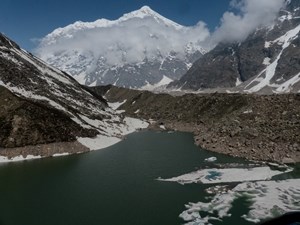
Tour Reviews
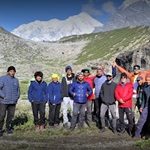
Very well organised and skilled staff to take care of all the different aspects of the trek. Not only they help to make it a memorable experience but also they help you with preparation/booking/shopping so that you won’t feel lost.
Leave a Review
Cancel reply.
You must be logged in to post a comment.
You May Also Like
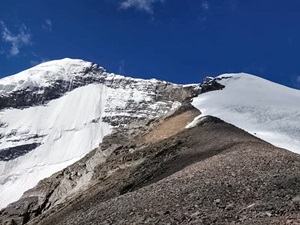
Kang Yatse 2 Peak

Panpatia Col Trek
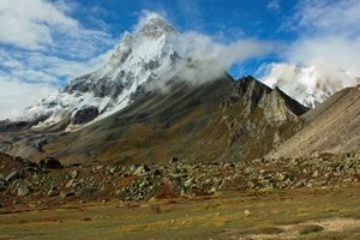
Tapovan Trek
Submit this form that we can email you all the necessary details and call you to discuss., tour starting date: green boxed dates indicate starting of a scheduled fixed departure tour (day 1 of our tour itinerary). please check the calendar and choose a suitable fixed departure date (green boxed) unless dates are not matching or you are looking for a customised/private trip., i accept the terms & conditions.
Satopanth Trek (Uttarakhand) – Complete Travel Guide
Brief about satopanth trek.
The Satopanth Tal trek is not only a spiritual experience but also offers breathtaking natural beauty. It’s a difficult trek that rewards you with a pristine glacier lake that’s nestled amidst the Garhwal Himalayas. The trek offers stunning views of the snow-covered Chaukhamba peak, Neelkanth peak, and Swargarohini peak. Along the way, you’ll also get to witness the Vasundhara Falls, which is a 400-ft tall waterfall, and Sahastradhara, which has over 100 waterfalls.
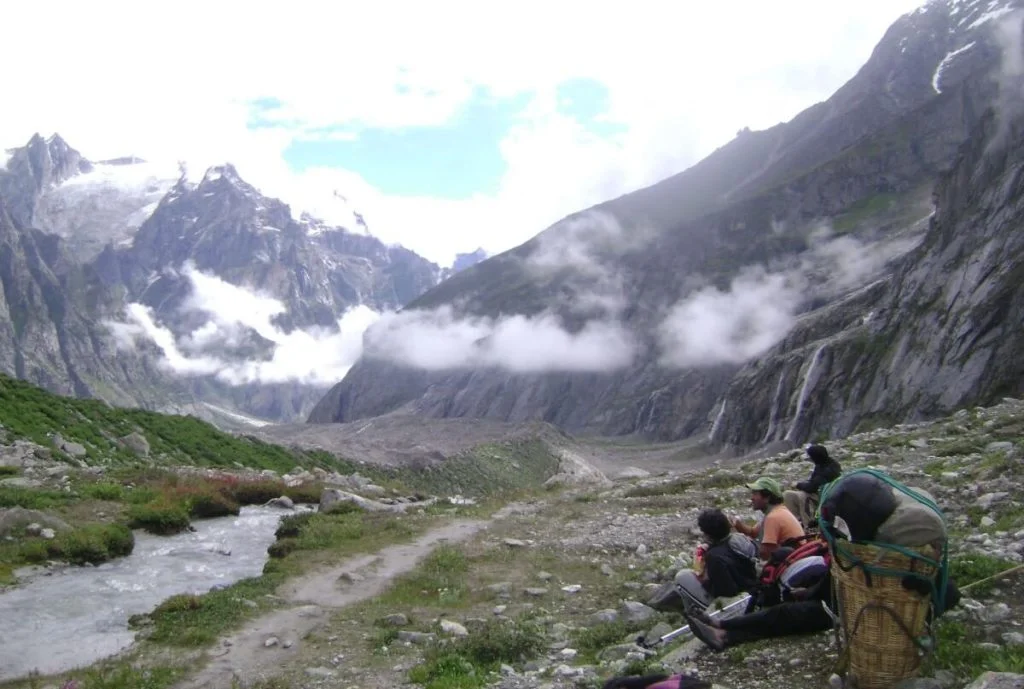
The Satopanth Trek is also an opportunity to explore the rich history and culture of the Garhwal region. You’ll get to visit the last village of India, Mana village, and witness ancient temples and historical sites. The trail takes you through thick forests, snow-covered trails, and beautiful meadows, making it a complete package for those seeking adventure, natural beauty, and spiritual fulfillment.
Key details of the Satopanth Trek :
- Ideal Number of Days for the Visit : 7 days and 6 nights
- Trek Distance : 50 km both ways
- Trek Altitude Range : 15,100 feet
- Starting Point: Joshimath
- Nearest Railway Station : Rishikesh Railway Station (300 km)
- Nearest Airport: Jolly Grant Airport, Dehradun (314 km)
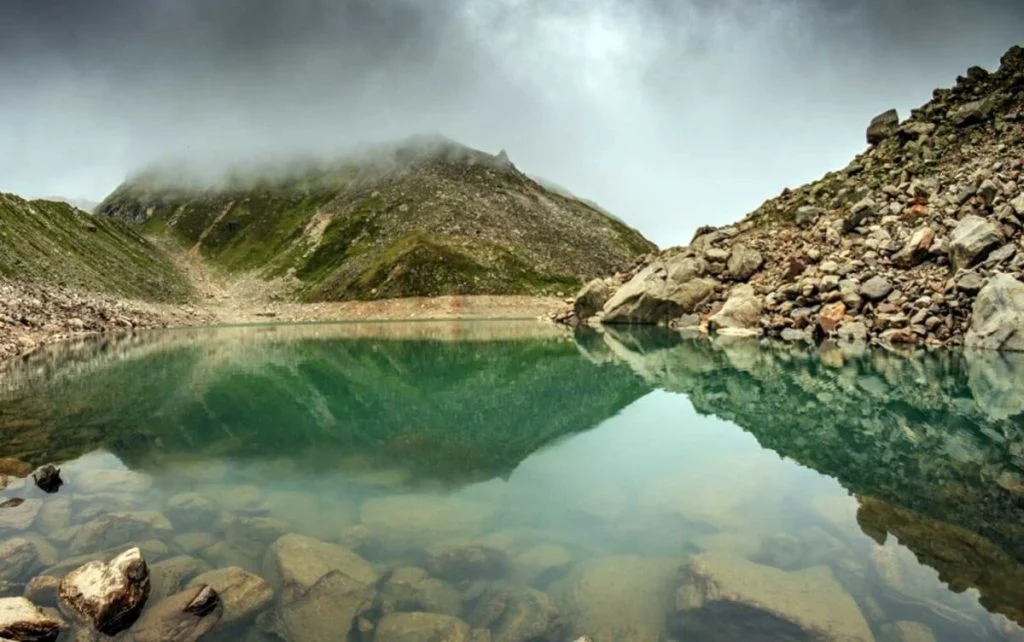
Table of Contents
Best places to visit during satopanth trek.
As you trek towards Satopanth Lake, you will be treated to a majestic view of Mount Neelkanth, the highest peak in the Garhwal division of the Himalayas. The mountain can be constantly seen once you cross the Lakshmi van forest region, provided the weather is clear.
Another attraction on the trail is the Vasundhara waterfall, located 3 km from Mana Village. The burbling sound of the falls will accompany you as you trek towards it, and the falls will be visible on your right side on the other bank of the Alaknanda river.
The Satopanth Lake is a crystal-clear, triangular lake surrounded by snow-capped mountains, including the famous Swargarohini, Chawkamba, Neelkanth and Balakun peaks. It remains clean throughout the year, and the lake’s evergreen color soothes the eyes.
If you’re up to visit a good nearby place, Pandukeshwar Temple, located between Joshimath and Badrinath is another great attraction. It is believed to be a sacred place where King Pandu, the father of the great Pandavas of Mahabharata, worshipped Lord Shiva.
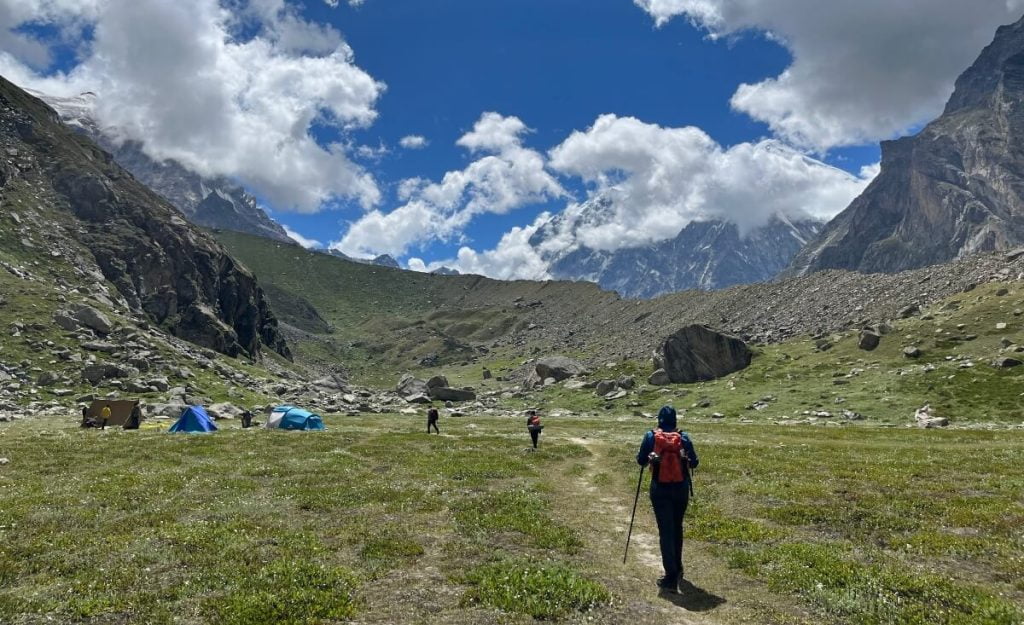
What is the best time to visit Satopanth Trek
The Satopanth Tal trek is best undertaken between May to mid-July and September to October. During May to mid-July, the trail is lush with green meadows and wildflowers. Post-monsoon, from September to October, offers the chance to see the Alaknanda river in full flow, along with the Vasundhara waterfalls.
Trekking during the winter season is not possible due to heavy snowfall, while monsoons make the trail dangerous. The best time to visit Satopanth Tal is during May, June, September, and October, with the nearest railhead at Rishikesh and the nearest airport in Dehradun.
How to reach the starting point of the trek?
To reach Satopanth Tal, you need to start your trek from Mana village, which is easily accessible from Haridwar/Rishikesh. If you are coming from cities like Bangalore, Chennai or Mumbai, it is recommended to fly directly to Dehradun and then take a shared taxi or bus to Rishikesh. From Rishikesh, take a bus to Badrinath and stay overnight there. The next day, you can either hire a cab to Mana or directly start the trek from Badrinath.
Alternatively, you can fly to Delhi and take a train or bus to Haridwar, and then follow the same route to Badrinath. It is important to reach Haridwar or Rishikesh by 6 pm and leave for Badrinath the next day at 3 am to reach there by 4 pm. You can then start the trek from Badrinath or hire a cab to Mana.
Availability of accommodations and food near the trek
Kukke Subrahmanya temple offers plenty of restaurants for an early breakfast before starting your trek, with popular choices like Neo Mysore Cafe and Hotel Kumarakripa opening as early as 5 AM. On the trek itself, Bhatta’s house is the only food source, so let Bhatta know when you arrive to ensure meals are prepared. It’s also a good idea to bring dry fruits, nuts, and non-perishable items like bread and peanut butter or rotis to keep you fueled throughout the two-day trek.
Before setting off, fill your water bottles at one of the temple restaurants, as your next opportunity for water will be at Bhatta’s house or the Forest Office. Carry at least two 1-liter water bottles and avoid filling them from small streams or stagnant sources along the trail, as they might not be safe to drink.
Accommodation:
You can book comfortable resorts and hotels in Joshimath to stay and get ready for the trek.
- Check Resorts & Hotels in Joshimath
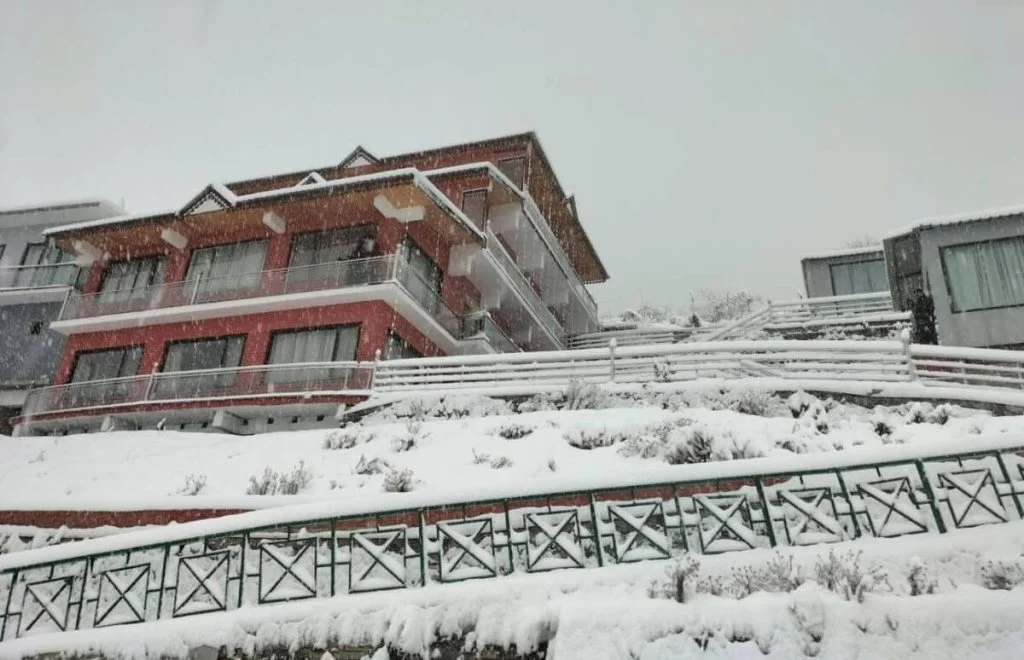
The Difficulty level of the Satopanth Trek
The Satopanth Tal trek is of moderate-difficult level and requires prior Himalayan trekking experience and high fitness level due to the steep sections on the trail, overall altitude gained, and total distance covered every day. The trail is through a maze of loose rocks, boulders and moraine, and has sections that are steep and need to be negotiated carefully.
The final stretch to Satopanth Tal is quite steep and has loose soil over the glacial moraine. A basic level of physical fitness is recommended, and it is suggested you increase your stamina by doing cardio-vascular exercises like running and swimming. Despite the difficulty, the beautiful view and the beautiful hills all around will continue to delight you.
Is Camping Allowed On Satopanth Trek ?
It is recommended to carry your camping equipment for Saropanth Trek. While shops in Badrinath provide camping equipment, the quality is not guaranteed. However, it is possible to rent utensils and other equipment from Badrinath.
Keep in mind that camping on alpine and sub-alpine meadows/grasslands, locally called “Bugyal” is not permitted due to a Uttarakhand High Court order. As a result, camping at Satopanth Tal is not allowed and the highest camp is at Chakratirtha from September 2018 onwards.
Is Any Permission Required For Satopanth Trek ?
You need to obtain an inner line permit from the Divisional Forest Office of Nanda Devi Biosphere Reserve in Joshimath. You can get permission by contacting them on 91-1389-222179. If you are hiring a guide, they will help you get the permit.
Nearby Destinations you may want to explore:
- Kedartal Trek in Uttarakhand – Full Travel Guide
- Tarsar Marsar Trek in Kashmir – Full Travel Guide
- 11 Most Amazing Places To Visit in Dalhousie
About The Author, Anant
Anant is a seasoned traveler and product professional, who is passionate about exploring new products, destinations and cultures. He captures all his experiences through his love of writing. Driven by a desire for adventure and knowledge, Anant is on a quest to see as much of the world as possible.
Related Posts
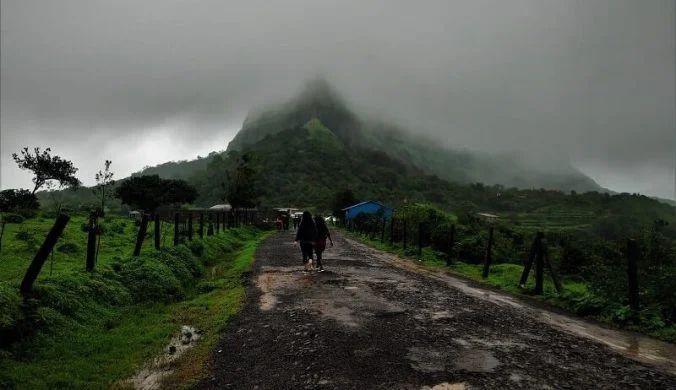

Visapur Fort Trek 2023 (Pune) – Complete Travel Guide

Satopanth Lake Trek
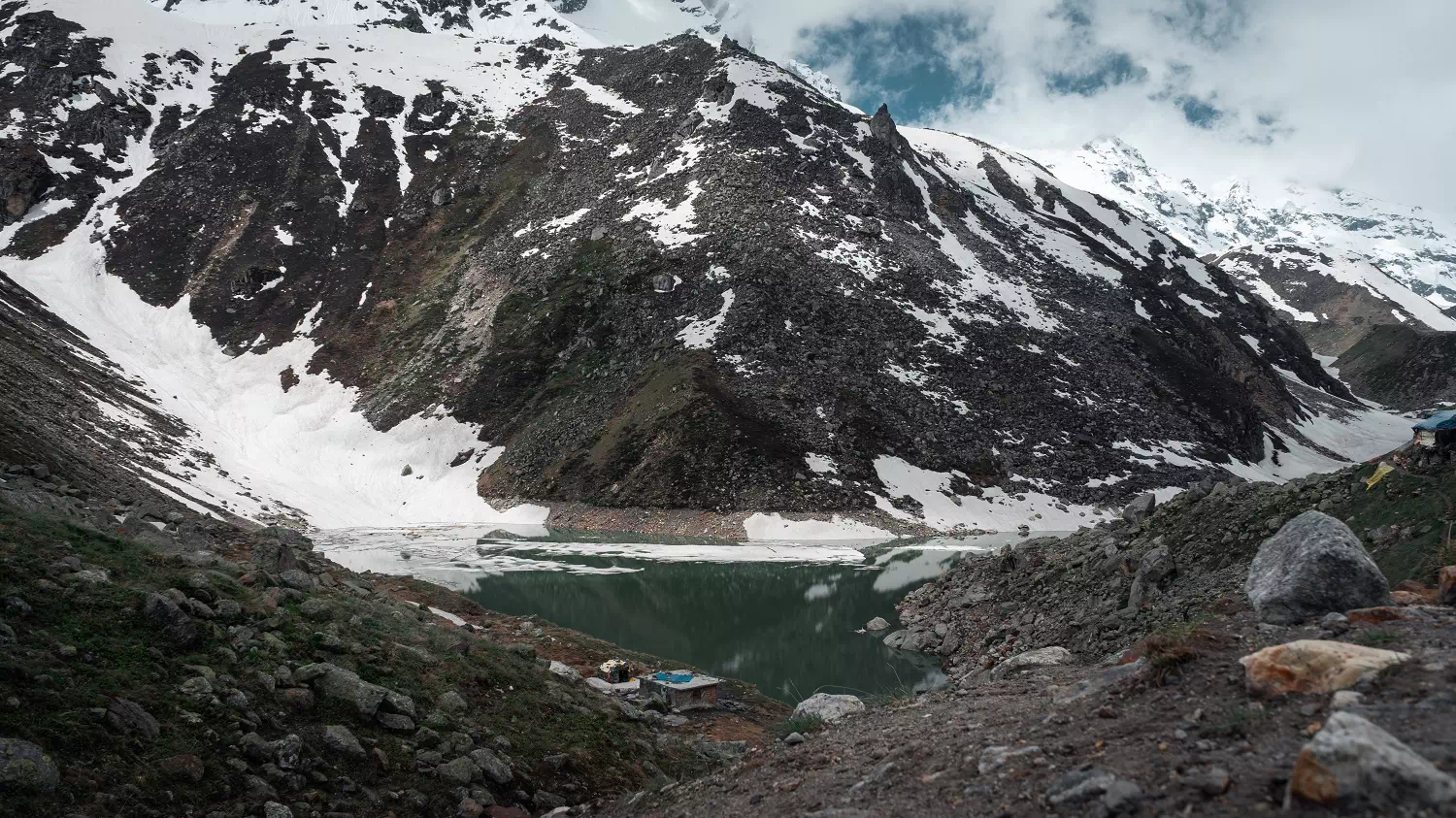
Day 1 Dehradun - Joshimath - Badrinath
We begin the day early and drive to Joshimath via Devprayag, Rudraprayag. One can see Devprayag (confluence of Alaknanda & Bhagirathi.) on the way. The Holy River Ganges starts from here. We reach Badrinath by evening and spend the night in a guest house.
Day 2 Badrinath - Mana - Vasudhara Falls Camp
In the morning visit Badrinath temple and later after breakfast drive a short distance to Mana village (Last village of the border). From here we will trek to Vasudhara falls via Bheem Bridge with packed lunch. Mana Village – 3 km from Badrinath, this is the last village of India on the Indo-Tibetan border. The Indo-Mongolian tribe set up this village. A population of 200 people lives here. Tourists come in plenty to this quaint village. Bheem Bridge – A short distance from Mana Village a natural bridge made of a huge boulder, over the river Saraswathi is seen. The story goes that Bheem; one of the Pandava brothers put it there. The view of this extraordinary bridge and the din of the flowing river make this place interesting. Vasudhara falls – 5 km after Bheem Bridge this astonishingly high waterfall is very attractive. The most interesting aspect about this place is that all the water here becomes vapour and vanishes into the atmosphere. The view looks like the Ganges is descending from the sky.
Day 3 Vasudhara Falls Camp - Laxmi Van - Chakrateerth Meadow
In the morning after breakfast we trek to Laxmi Van (2 kms). This is a small meadow with pastures for goat and sheep to graze. It has a few caves where gujjars stay with their flock of animals. After lunch we further trek to Chakrateerth meadow which is just 3 kms away from the lake. This is a beautiful camping ground with green grass all around and towering peaks surrounding you. At night one may also hear the glacial ice breaking away into a thunderous sound.
Day 4 Chakrateerth Camp To Satopanth Lake And Back To Laxmi Van
The trek from Chakrateerth meadow to the lake is very strenuous on the knees and is entirely over glacial debris. Walking over huge boulder and stones can take a toll on the knees but the calm and placid waters of the lake are a rewarding sight. Satopanth Lake is 18 km from Mana Village amidst the difficult areas of Himalayas. The water in the lake is very calm. On the banks of this lake are innumerable lotus flowers. We head back to our camp site and trek back to Laxmi van.
Day 5 Laxmi Van - Vasudhara Fall - Mana - Badrinath
In the morning trek back to Mana village and then drive 3 kms to Badrinath with pack lunch. One can also take the alternate route to reach Badrinath directly. Upon arrival at Badrinath check in to hotel for dinner and overnight stay.
Day 6 BADRINATH - RISHIKESH
Early in the morning drive to Haridwar via Rudraprayag & Devprayag.
Day 2 How difficult is the trek & what are the challenges?
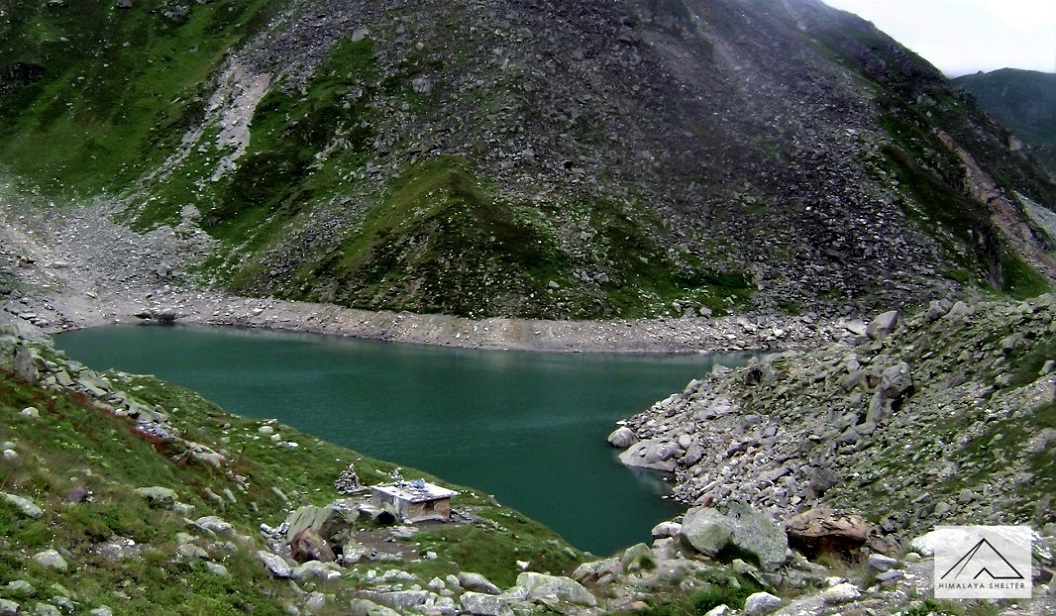
Upcoming Treks
- June 24, 2023 open
FAQ's about Satopanth Lake Trek
What is the best time to do satopanth tal trek.
The most ideal times for the Satopanth Tal Trek are in the summer and after the monsoon. In the summer, which spans from mid-May to June, you’ll have a great time. Similarly, September to October, after the monsoon, is another fantastic time for this trek. During these periods, you’ll be treated to clear skies and delightful weather.
On the other hand, in the monsoon season, you can revel in the breathtaking beauty of the Satopanth Tal lake, surrounded by vibrant greenery.
What is the difficulty level of Satopanth Tal Trek?
The Satopanth trek is moderately challenging. It will help if you have some prior experience with high-altitude trekking. You can also improve your stamina by doing activities like jogging, cycling, and swimming.
What is the height of Satopanth lake?
Satopanth Tal, a glacial lake situated amidst the snow-capped peaks of Uttarakhand, India, is located at an altitude of 4,600 meters (15,100 feet) above sea level.
Is Satopanth Tal Trek safe?
The Satopanth Tal trek is generally considered safe, provided you take necessary precautions and trek with a reputable organization. The trail is well-maintained, with no major technical challenges. However, like any high-altitude trek, there are inherent risks, such as altitude sickness, unpredictable weather, and potential for injuries. We prioritize safety, providing essential measures and a medical kit for emergencies. A knowledgeable guide accompanies you, enhancing your Satopanth Lake trek experience. Additionally, the package includes travel insurance for added security.
What is the starting point for Satopanth Tal Trek?
The Satopanth Tal Trek starts from a charming village called Mana in Uttarakhand, India. Interestingly, it’s the last village before reaching the border with China. Mana village is very close to the famous pilgrimage town of Badrinath, and you can easily reach it from both Haridwar and Rishikesh.
What is the total distance of the Satopanth Tal Trek?
The Satopanth Tal Trek covers a distance of approximately 50 kilometers for the entire round trip. Typically, this trek takes around 5 to 6 days to complete.
What is Satopanth famous for?
This sacred lake holds deep religious significance for the local community. In a solemn tradition, the inhabitants of Mana village honor their departed loved ones by gently placing their ashes into the serene waters of the lake.
What is the temperature during the Satopanth Tal trek?
The temperature during the Satopanth Tal trek varies greatly depending on the time of year and the altitude. Generally, the trek tends to be chilly all year round, with colder nights and milder days. Here’s a breakdown of the temperature ranges:
Summer (May to June):
- During the summer months of May and June, the days offer a comfortably cool range of 10°C to 20°C at lower altitudes, providing a pleasant atmosphere for trekking. At higher altitudes, the temperatures range from 5°C to 15°C. Nights remain cool but not overly cold, with readings between 0°C to 10°C at lower altitudes and -5°C to 0°C at higher altitudes.
Monsoon (July to August):
- The monsoon season brings slightly lower temperatures. Daytime temperatures range from 10°C to 15°C at lower altitudes and 5°C to 10°C at higher altitudes, offering a refreshing trekking experience. Nights become cooler, with temperatures ranging from 0°C to 5°C at lower altitudes and -5°C to 0°C at higher altitudes.
Autumn (September to October):
- In autumn, the days remain cool and comfortable for trekking. At lower altitudes, temperatures range from 5°C to 15°C, providing an enjoyable trekking environment. Higher altitudes experience temperatures from 0°C to 10°C. As the season progresses, nights gradually become colder, with readings dropping to -5°C to 0°C at lower altitudes and -10°C to -5°C at higher altitudes.
Winter (November to April):
- Winter brings chilly conditions, especially at higher altitudes. During the day, temperatures range from -5°C to 5°C at lower altitudes and -10°C to 0°C at higher altitudes. Nights can be very cold, with readings between -15°C to -5°C at lower altitudes and -20°C to -10°C at higher altitudes. It’s important to be well-prepared for the cold weather during this season.
Remember, these are just average temperature ranges, and actual temperatures may vary based on weather conditions. It’s always wise to be ready for colder weather, particularly at higher altitudes and during the night. Make sure to pack appropriate clothing, including thermal layers, a warm jacket, and don’t forget a hat and gloves.
What is the best time to do the trek and how is the weather?
What are the top highlights of the trek.
- Transport support from and to Dehradun: starting from pickup on day 1 to drop on day 6.
- Guide and cook fees.
- Rent for camping equipment.
- Forest entry charges.
- Porter and mule support to carry camping equipment. Please note that personal luggage can be carried by mules and/or porters on chargeable basis.
- All veg meals starting from day 1 dinner to day 6 breakfast.
- Tented accommodation throughout the trek.
- Your designated hotels may not reopen by the time you reach there. While we are making alternate arrangements, do understand that things may not be as “tip-top” as our designated hotels.
- The gurudwara, Hemkund Sahib may not be open. While we are trying to take permission to go to Hemkund Sahib, if it does not happen, then do understand that the pandemic has put restrictions beyond our control.
- Personal expenses like tips, personal medicines, phone calls etc
- Any transport support during the trek apart from what is included above
- Any cost or services not mentioned in the Inclusions
- Accommodation apart from the trek
- Adventure Insurance
- Cost arising due to unforeseen incidents like bad weather, medical evacuation, roadblocks etc
- Porter and mule support to carry personal Luggage can be arranged at an additional cost of INR 350 per bag per day (weighing up to 12 kg)
- Lunch box for packed lunch/breakfast. To avoid using polythenes and Aluminium foils. Keeping the Himalayas clean is our own responsibility. Reduce the use of Plastic when you are in the abode of the Sacred Himalaya
- 17-07-2021 to 23-07-2021 open
- 17-07-2021 to 23-07-2021 close
Send Request
Your query has been successfully registered. we will contact you within 24 hours., something went wrong.try after sometime..
- Satopanth Tal Trek
- GETTING THERE
- DETAILED ITINERARY
- COST INCLUSION
- CANCELLATION
- Garhwal Treks
- Moderate Grade Treks in Himalayas
- One Week Trek
- Summer Treks
- Uttarakhand
Embark on an extraordinary journey with our upcoming summer Satopanth Tal trek, commencing on May 2024, from the spiritual town of Badrinath. The mystical allure of the trek lies in its high-altitude features, where every step takes you through boulders, moraines, glaciers, and knife-edge ridges, offering unparalleled views of captivating peaks that seem almost surreal.
Trail of Legends:
This triangular glacial lake, Satopanth Tal, sits majestically above 14,000 feet, concealed within a ridge believed to be the ancient “Road to Truth” or “Satya ki Pantha.” Legend has it that the Panch Pandavas from the epic Mahabharata undertook this challenging trail in their quest for heaven. As you traverse the trail, echoes of these myths linger, with landmarks bearing names reminiscent of the epic tales.
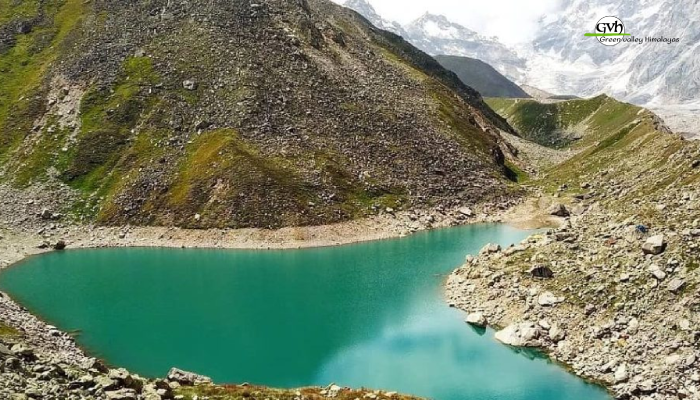
A Glimpse of Divinity:
The towering Chaukhamba ridge and the majestic peaks of Neelkanth, Balakun, and Parvati create an awe-inspiring backdrop. Locals believe that on auspicious days, the Trimoortis—Brahma, Vishnu, and Maheshwar—bathe in the lake, attracting adventurous devotees and Sadhus on pilgrimage during the monsoon season.
Challenging, Yet Rewarding:
This trek is a testament to the Himalayan spirit, demanding experience and resilience. It’s a glacier moraine walk on boulders, loose rocks, and scree zones, providing a unique window into the heart of the Himalayas. However, it’s essential to note that this trek is not for beginners; prior high-altitude, multi-day trekking experiences are a must.
Itinerary Snapshot:
Day 1: Drive from Rishikesh to Badrinath (290 Km – 11 to 12 hours).
Day 2: Trek briefing and acclimatization at Badrinath.
Day 3: Trek from Badrinath to Laxmivan (10 km – 6 hours).
Day 4: Trek to Chakratirtha (9 km – 5 to 6 hours).
Day 5: Trek to Satopanth Tal (5 km – 3 hours) and return to Chakratirtha.
Day 6: Trek from Chakratirtha to Mana (15 km – 6 to 7 hours) and drive to Badrinath.
Day 7: Drive from Badrinath to Rishikesh (290 Km – 10 to 11 hours).
Important Notes:
- Participants need to reach Rishikesh on their own by Day 1 morning or the previous night.
- Return to Rishikesh on Day 7 evening.
- The Trek fee is ₹15,950 + 5% GST per person, excluding Badrinath, and covers everything for the trek.
- Prior acclimatization in Joshimath is recommended for further comfort.
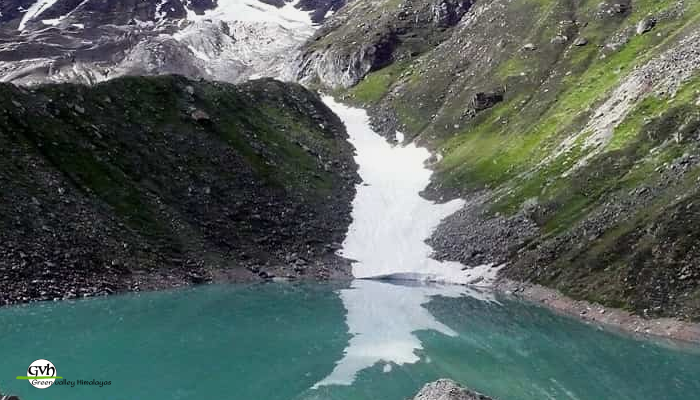
Trail Insights: This glacial moraine trail is a delight for trek enthusiasts, spanning a 50 km round trip from Badrinath. It’s a full-camping trek, with no horses or mules, and trekkers must acclimatize properly upon reaching Chakratirtha, surrounded by low oxygen levels. For pilgrimage seekers, this is a high-altitude Himalayan trek requiring experiences like Kailash, Adi Kailash, Manimahesh, Kinnaur Kailash, or similar.
Camping Note: As per the Uttarakhand High Court order, camping at Satopanth Tal has been restricted since September 2018. The highest camp is now at Chakratirtha, and a day visit to Satopanth is included in the itinerary.
Getting There: Haridwar is the gateway, well-connected by train and bus services from Delhi and Kolkata. We can arrange a pickup from Haridwar to Badrinath on request. Alternatively, buses from Haridwar to Badrinath start early morning.
Join us on this Himalayan adventure to Satopanth Tal, where every step is a journey into legends, divinity, and the heart of the mighty Himalayas.
Duration: 4 days of trekking from Badrinath to Satopanth Tal and return. The entire expedition spans 7 days from Haridwar to Haridwar.
Prerequisite: Prior high-altitude trekking experiences are a must. We highly recommend completing at least 2 Moderate grade treks to prepare for this adventure.
Grade: Moderate. While not overly technical, the trek involves steep ascents and descents, requiring a good level of fitness and stamina.
Physicality: 7/10. Expect challenging terrain and long hours of trekking each day. A good level of physical fitness is essential.
Trail Length: Approximately 50 Km round trip.
Highest Point: Satopanth Tal, towering at an altitude of ~4400 m/14430 ft above sea level.
Seasons: Best attempted in June or August/September when the weather is favorable and the trails are relatively clear of snow.
Access: The trek starts from Badrinath, located 310 Km from Haridwar.
Transportation Options: Reach Haridwar via train (Station Code: HW) or fly into Delhi or Jolly Grant Airport in Dehradun (Airport Code: DED). From Haridwar, embark on a scenic journey to Badrinath to begin your trekking adventure.
Prepare yourself for an unforgettable journey amidst the majestic Himalayas, where every step brings you closer to nature’s grandeur and spiritual serenity.
Plan Your Satopanth Tal Trek:
- Get ready for an unforgettable adventure to Satopanth Tal! Check out our upcoming scheduled trek dates by exploring the calendar within our Booking Form or REGISTER NOW section. Highlighted tour starting dates align perfectly with our 8-day itinerary, ensuring a seamless experience.
- Please note that our BOOK NOW feature is temporarily disabled. However, you can easily receive all the necessary information by filling out the REGISTER NOW form. If our scheduled dates don’t match your availability, don’t worry! Simply choose the Custom Date option by clicking ‘Select your custom date’ and complete the provided form.
- For a quick overview of all available dates, refer to our convenient TREK CALENDAR. Remember, on Day 1 of your trek, make sure to reach Haridwar by 6 am or the previous night. On Day 8, plan your return journey to Haridwar for the evening, around 8/9 pm. Be sure to arrange your tickets accordingly for a smooth travel experience.
Getting to Badrinath (The Trek Base)
By Train: Haridwar is well-connected by train from Delhi and Kolkata. Several trains like Kumbha Express (Train No. 12369), Upasana Express (Train No. 12327), and Doon Express (Train No. 13009) offer good options to reach Haridwar. Upon arrival in Haridwar, travelers can spend the night and start their onward journey the next morning.
By Bus: Frequent regular and Volvo bus services are available from Delhi Kashmiri Gate ISBT to Haridwar. From Haridwar, travelers need to arrange their transport to reach the trek base at Badrinath.
From Haridwar to Badrinath (Trek Base):
- Arranged Pickup: We offer pickup services from Haridwar to Badrinath and back. The cost, shared equally among team members, is approximately Rs. 7000 for a one-way journey in a comfortable Jeep (Mahindra Maxx, Sumo), suitable for 6-8 persons.
- Take an early morning bus from Haridwar to Badrinath or Joshimath. State-operated buses depart as early as 5 am from the Bus terminus opposite the Haridwar railway station. Privately operated buses are also available. During peak season, especially during Char Dham Yatra, buses may be crowded. The journey to Joshimath takes around 11-12 hours, and then travelers can look for shared Jeep services or book a car to Badrinath, which may take up to 14 hours.
- From Badrinath, board the early morning direct bus to Haridwar/Rishikesh, which takes around 12 hours. From Rishikesh, frequent bus services are available to Haridwar, which is just 25 km away.
By Air: Travelers can also fly to Dehradun’s Jolly Grant Airport and then take a taxi or bus to Haridwar.
Accommodation in Haridwar: For trekkers arriving in Haridwar the day before the trek, there are various accommodation options available, ranging from premium to budget:
- Privately operated hotels/lodges
- State-run Tourist Rest Houses (GMVN)
- Dharamshala
One reliable option is Hotel Rahi, operated by GMVN, located beside the Bus Stand and opposite the Haridwar Railway Station. Online booking is available through the GMVN website. Trekkers can choose from standard accommodation options.
Departure from Haridwar: Normally, travelers reach Haridwar from any trek base by 7/8 pm. They can then catch a train after 9 pm or use the regular bus service mentioned above to reach Delhi or continue their journey homeward on the same night.
Haridwar to Badrinath | Journey to the Sacred Shrine
Acclimatization at badrinath, trek to laxmivan, trek to chakratirtha, explore satopanth tal, descend to bandhar, return to badrinath, journey back to haridwar.
Note: Distances and altitudes are approximate, offering an overview of the journey’s highlights.
Trek Fee: ₹ 15,950 (Excluding stay and meals in Badrinath) + 5% GST.
Inclusions: Twin-sharing tent accommodation throughout the trek. All meals from Day 3 lunch to Day 6 lunch, including nutritious vegetarian food, breakfast, packed or hot lunch, light snacks, and dinner, along with morning and evening tea. Experienced Trekking Guide with in-depth knowledge of the trails. Skilled Cook, Support staff, and Porters for logistical support. Camping equipment such as a Sleeping bag, Carry mattress, Gaiters, and Microspikes/crampons (Bring your sleeping bag for hygiene reasons if you have one). Kitchen tent, dining tent, and toilet tent as required. All permit fees, camping charges, and forest levies. Basic Medical & First Aid kit. Medical cum Travel Insurance Policy covering high altitude trekking tours (For Indian nationals up to 60 years of age, covering trek and return journey for a maximum of 7 days).
Exclusions:
Transportation from Rishikesh to Badrinath and back (arrangements can be made at an additional cost, shared equally among trekkers). Accommodation or meals in Badrinath (plenty of vegetarian food and accommodation options available). Personal Rucksack/Backpack carrying personal belongings (Additional ₹ 4000 for porter service, weight limit: 10 Kg). Tips or gratuities to the support staff. Anything not mentioned in the “Inclusions” or personal.
- We assume that you have read and understood our “Terms & Conditions” ( https://greenvalleyhimalayas.com/terms-and-conditions ) before Booking a trek/tour.
- To reserve your place in a scheduled Fixed Departure trek or a Customised/Private trek pay 25% of the TREK/TOUR FEE as the initial “Booking Deposit” . You can pay by Net banking/Draft/Cheque/Credit/Debit/AMEX cards. This will ensure your participation in the desired trek and we will reserve your place on the scheduled date. You need to pay the remaining amount at least 15 days before the Trek Starting Date .
- If you book a Trek/Tour before 14 days or less from the Trek/Tour Starting Date, you need to pay the full TREK/TOUR FEE .
Cancellations:
- “Booking Amount” i.e. 25% of the TREK/TOUR FEE is Non-Refundable at any stage.
- If in case you are not able to make it due to unavoidable reasons (s), we provide you a very flexible choice of Shifting to another trek within the next one year . One year is counted from the starting date of the trek/tour you booked initially with us.
- In case you postpone your trip you need to inform a minimum of 15 days before the trek/tour starting date. (Though we suggest to inform us earlier if know)
- In case you postpone a trek/tour 15 days before the scheduled Trek/Tour Starting date or prior , you may shift to another group of the same trek/tour scheduled in the same season or within the next one year. You may shift to another suitable route also. For changing any, you need our approval first. Your request must be in written communication through your registered email with us.
- If you cancel/postpone a trek/tour from 14 days to 8 days before the tour starting date , your Booking Amount is Non-Refundable. We will not take any requests for shifting dates. We will charge 50% of the amount as Cancellation Charges and process a refund of the remaining 50%. You may also shift to another group within next year but 25% Booking Amount will be deemed as Cancellation Charge and the rest amount will be transferred to the shifted group.
- If you cancel a trek/tour 7 days (i.e. a week) before the Trek/Tour Starting Date or later , there will be NO REFUND.
- In case of any unforeseen incident including but not limited to natural calamities like flood, earthquake, landslide, forest fire, or any political unrest, if we are compelled to cancel the trek/trip, you will be entitled to redeem the full amount for the same/similar kind of trek/trip within next one year.
If you need more clarifications write to [email protected]

Leave a Review
Cancel reply.
Save my name, email, and website in this browser for the next time I comment.
Tour Reviews
There are no reviews yet.
You May Also Like

Har Ki Dun Homestay Trek

Ali Bedni Bugyal Trek

Buran Ghati Trek
Get best quote.
Fill this will get in touch for further details

Yatra Cab Services & Holiday Packages
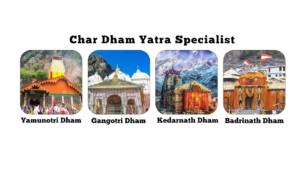
Call Us 9058610050

Yatra Cab Services – A Genuine Taxi Service In Haridwar During Char Dham Yatra
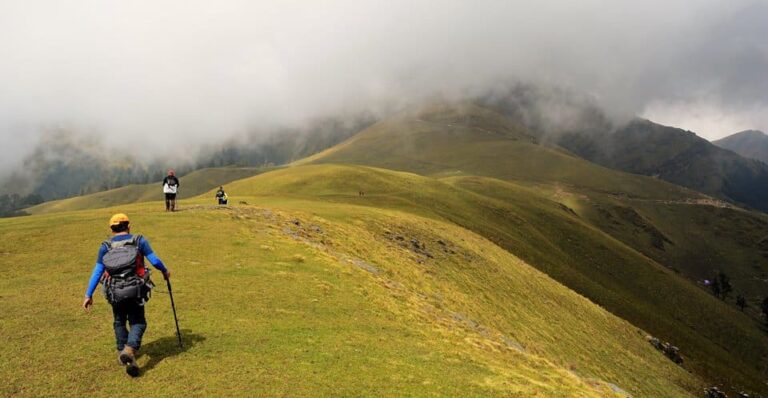
Dayara Bugyal Trek
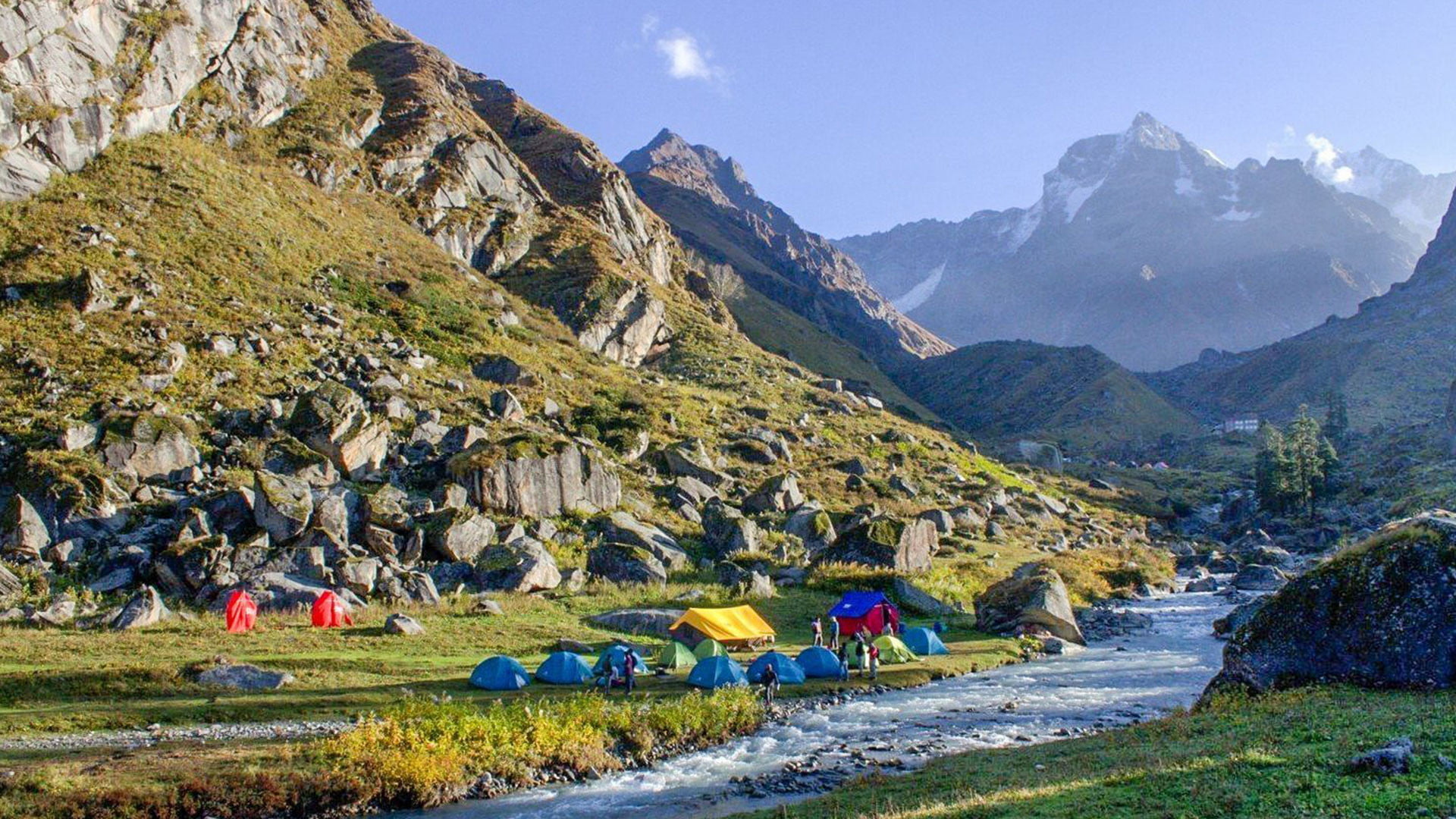
Har Ki Dun Trek
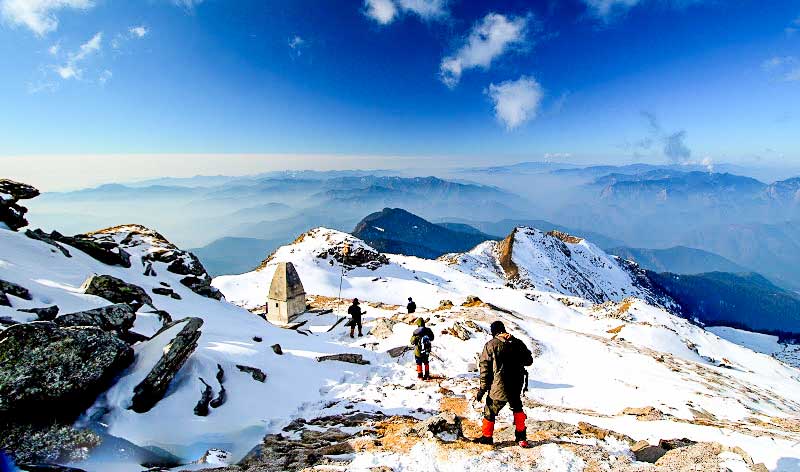
Kedarkantha Trek
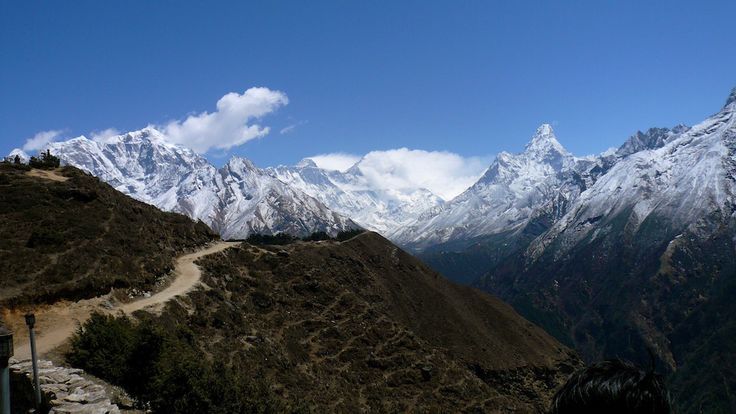
Kuari Pass Trek
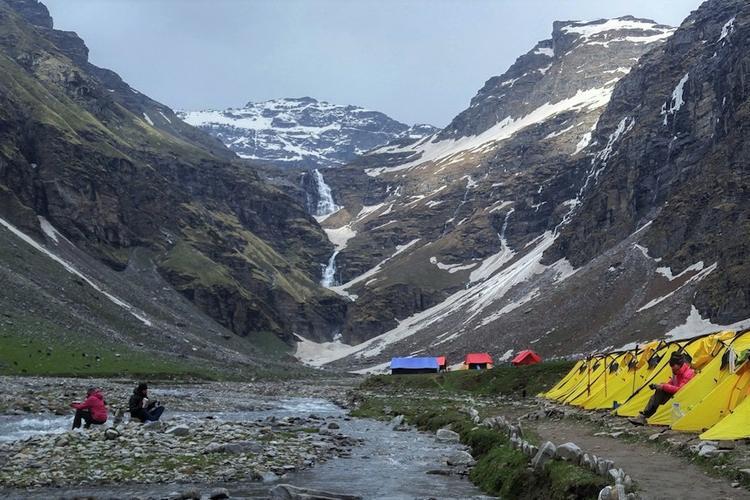
Rupin Pass Trek
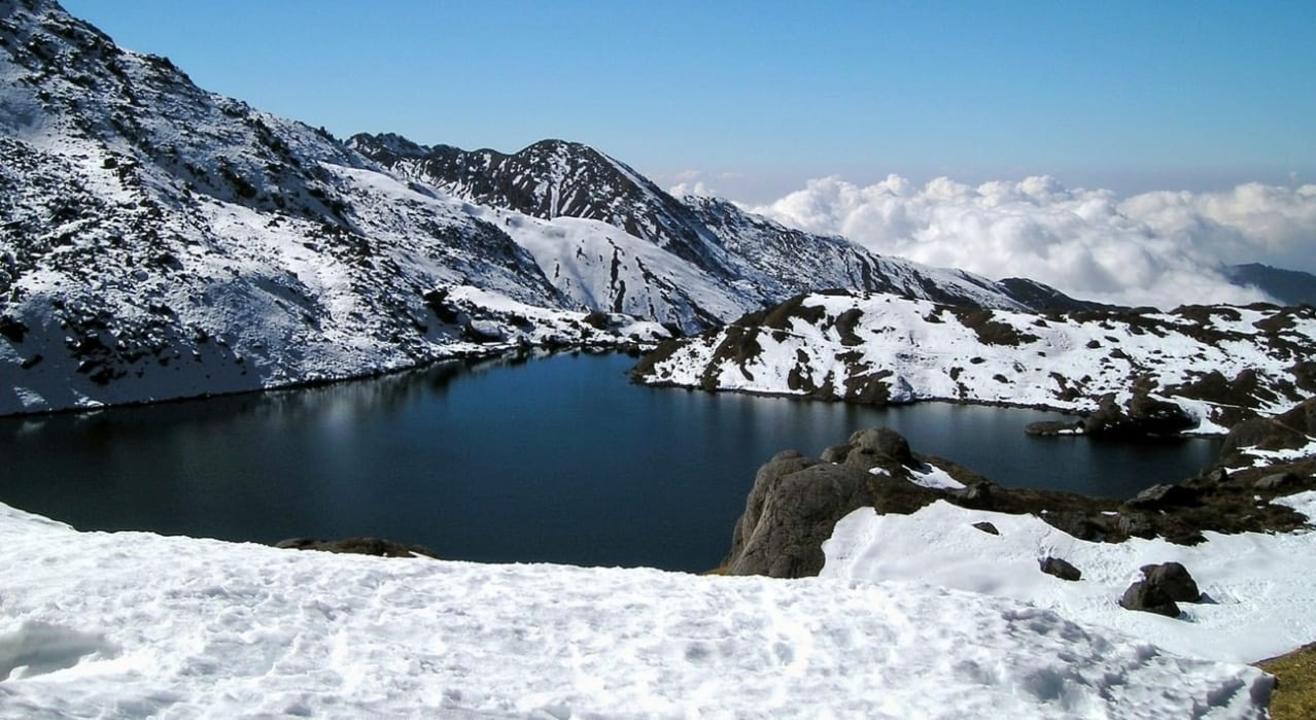
Brahamtal Trek
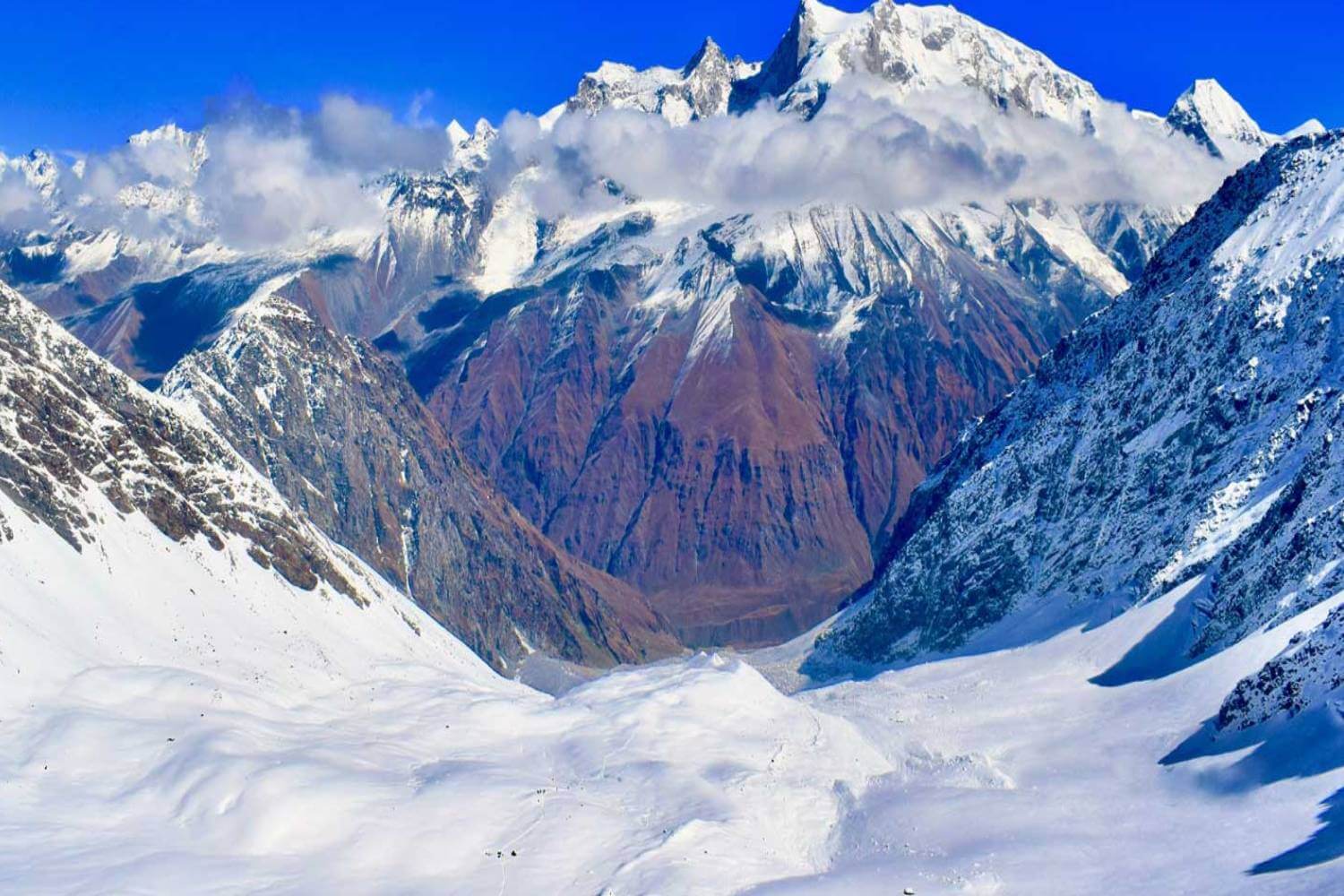
Bali Pass Trek – A Famous Historical Adventure Trek
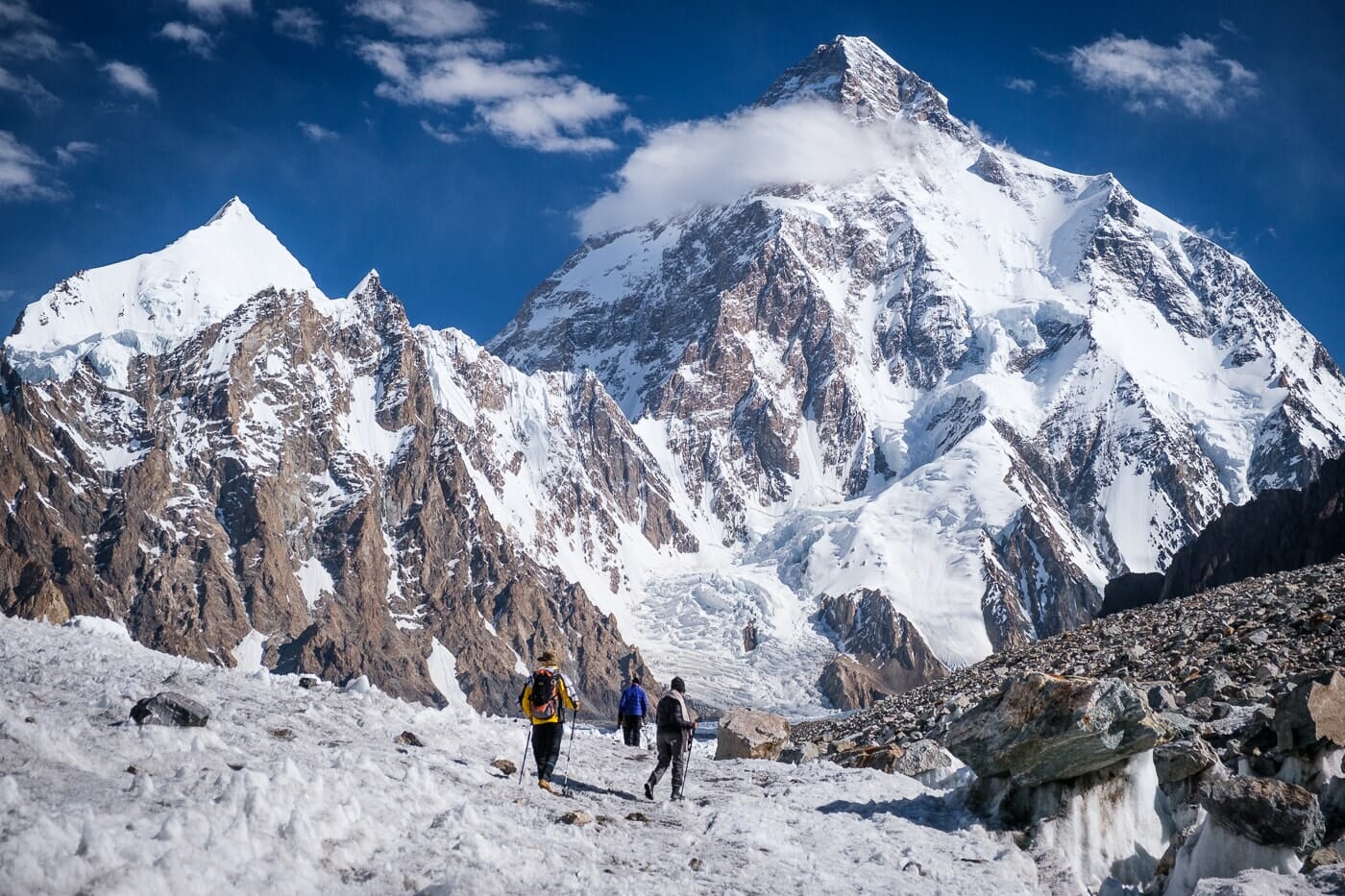
Tapovan Trek
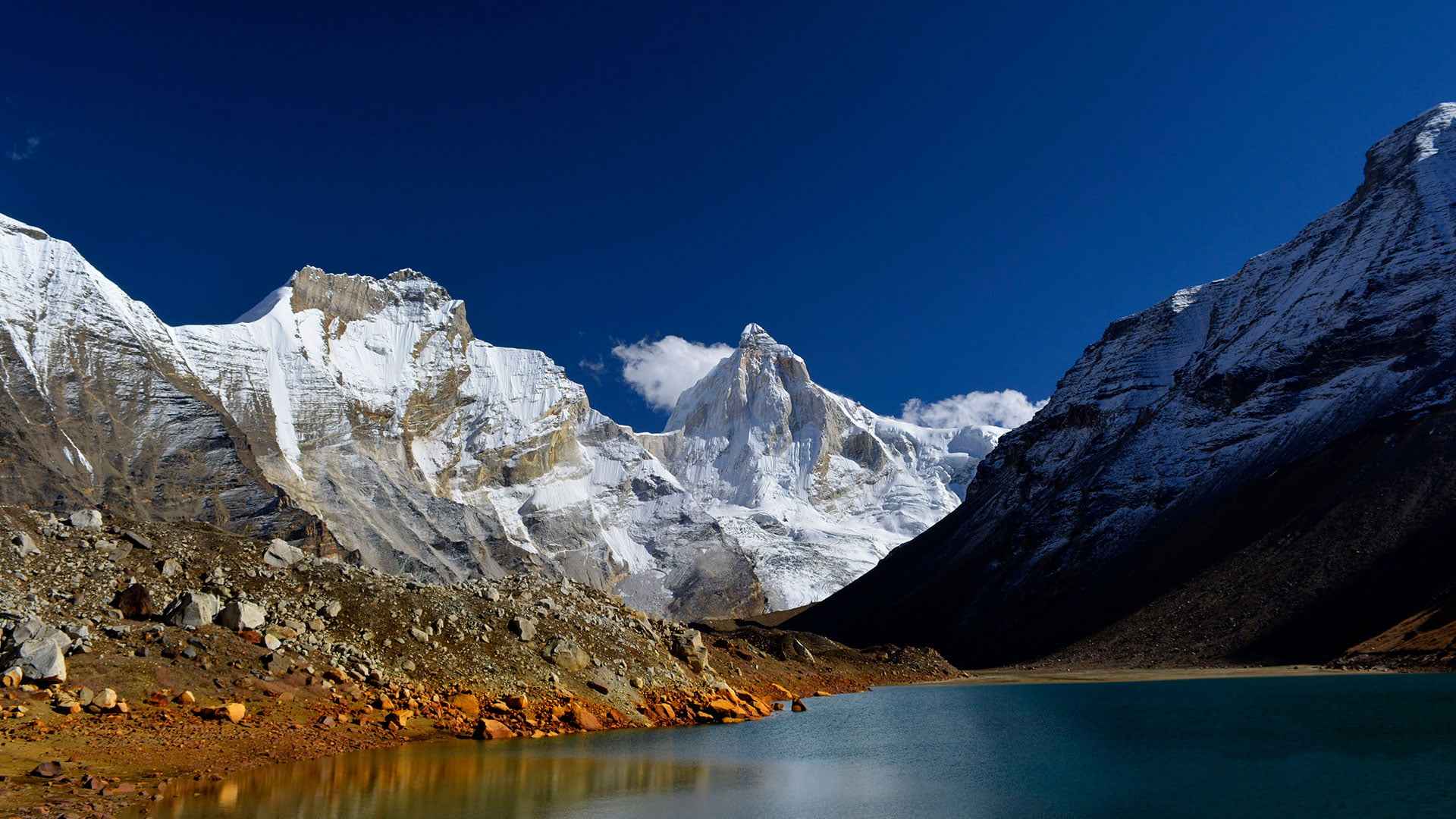
For Ultimate Trekking Adventure Explore Kedartal Trek With Yatra Manager
Travel with yatra manager, best trek in uttarakhand satopath tal trek.
Do not Stop Your quest of Finding Thrill, Adventure, Love With Nature, History and Passion. We are here to give you Best magical Tour fitted to Your Budget.
- Uttarakhand
- Budget Travel
- Char Dham Yatra Tour Package
- Weekend Tour Packages
- High Altitude
- Nature Friendly
- Pilgrim Tour
- Bungee Jumping
- Giant Swing
- Peak Climbing
- Water Sports
Satopath Tal Trek
Perched amid towering peaks, Satopanth Tal is a sacred lake lying at an elevation of 17,989 ft near Chaukhamba line’s base. Associated with many religious aspects Satopanth tal holds an unwavering significance among locals . Lord Brahma, Vishnu, and Mahesh are said to have bathed in the waters of Satopanth Tal, furthering to meditate at its different edges. Satopanth in the local language means “True Pathway to Heaven”. Devotees believe Satopanth Tal to be sacred and pure, and that a holy dip in Satopanth Tal will wash away their sins.
A large crowd of people visit this location each year due to its religious values. In another local belief, it is said that after the great war of Mahabharata, Pandavas on their way to heaven took a path via Satopanth lake.
The route to Satopanth Lake includes passing through Mana, India’s last hamlet, trekking along the Alaknanda River, and camping in the Lakshmi van forest and Chakratirtha meadow. The trek provides breathtaking views of the enormous snow-capped peaks of Nilkanth, Swargarohini, Narayan Parbat, and Balakun, as well as thrilling views of the Chaukhamba Peaks. Satopanth trek is a Moderate-Difficult level trek which will require prior experience of trekking.
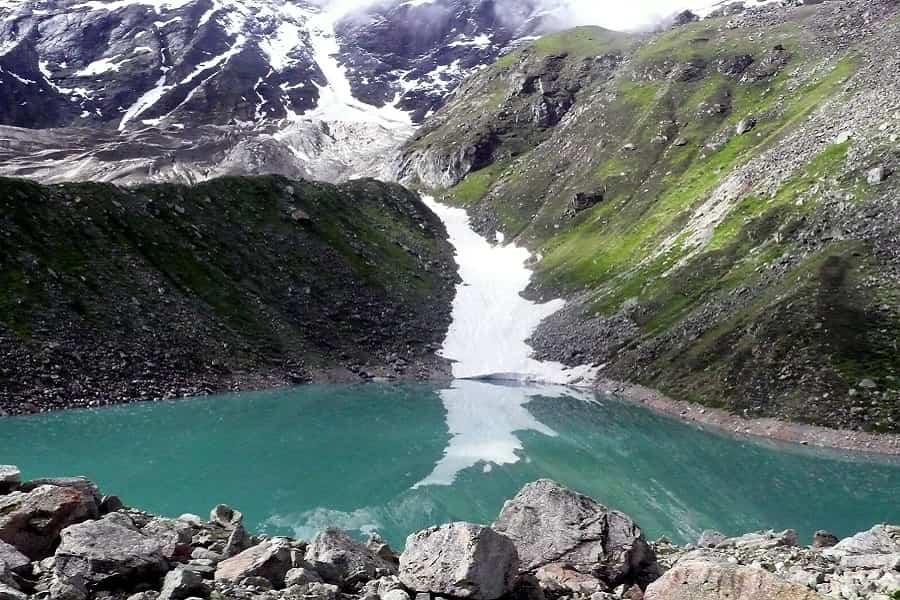
- Duration: 7 nights 8 days
- Altitude: 17987 ft
- Trek distance: on foot 46km- by taxi 680 km
- Summer Temperature: – Day (5°C to 15°C) Night (6° C to 12° C)
- Winter Temperature: – Day (0°C to -2° C) Night (-5°C to -8°C)
- Best time to visit: May, June, September, October
- Trek level: Moderate-Difficult
- Trek route day by day: Dehradun, Joshimath, Badrinath, Laxmivan, Chakatirth, Satopanth Tal
- Weather: Winters are covered with snow whereas summers experience higher temperatures.
Get Best Deals for Selected Packages with Yatra Manager
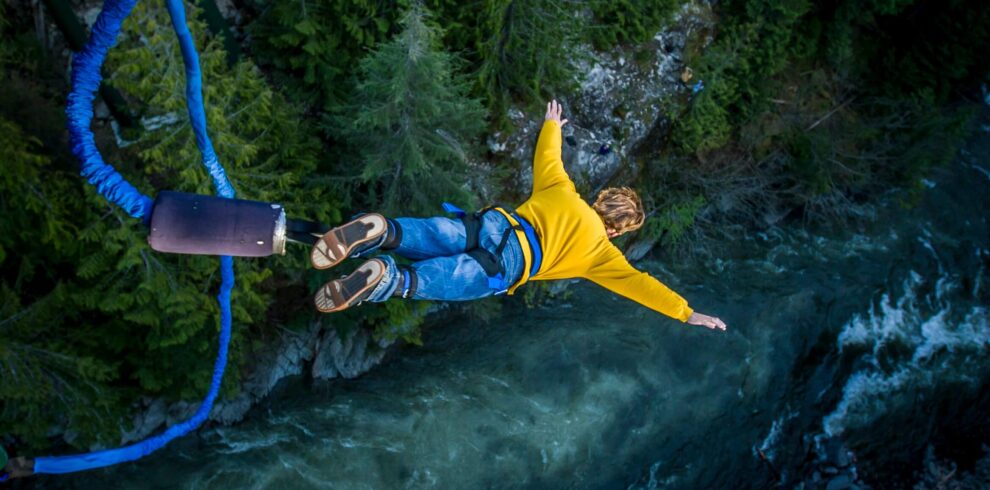
Bungee Jumping (1 Trip)
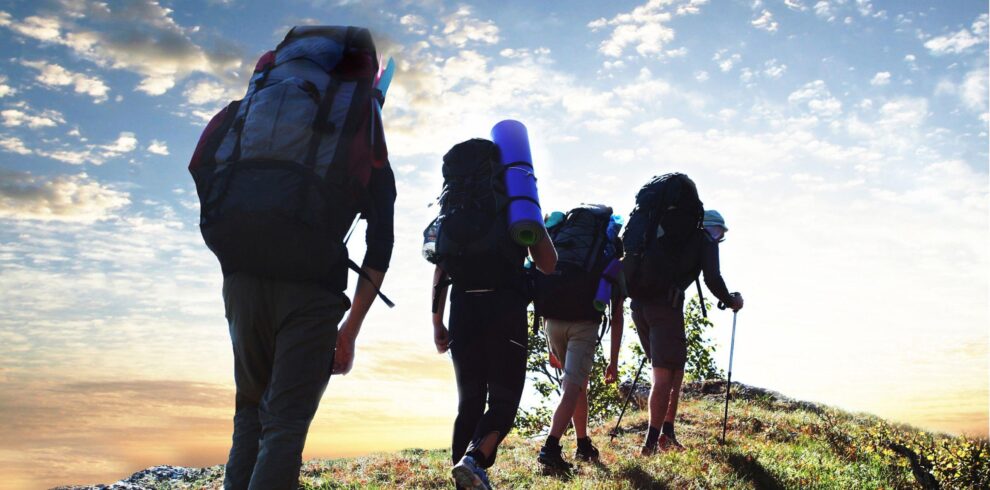
Hiking (3 Trips)

Rafting (7 Trips)
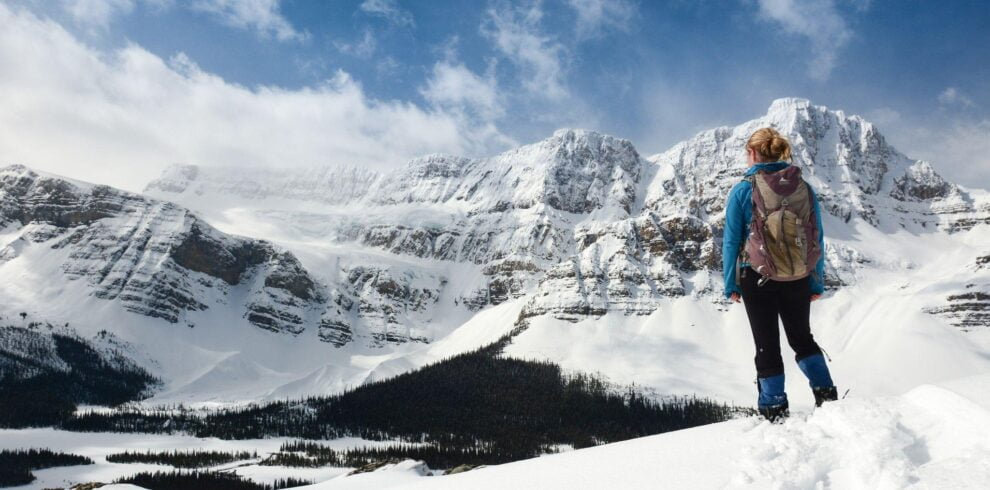
Trekking (4 Trips)
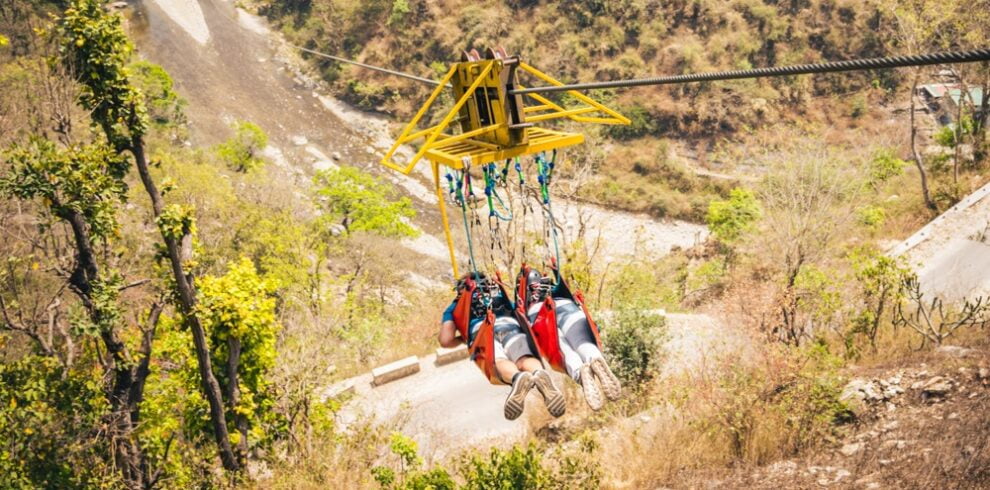
Flying Fox (1 Trip)
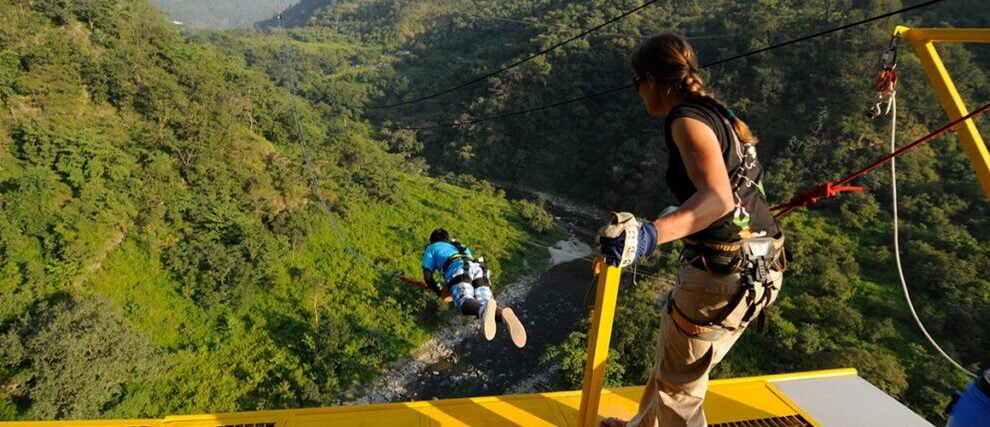
Giant Swing (1 Trip)
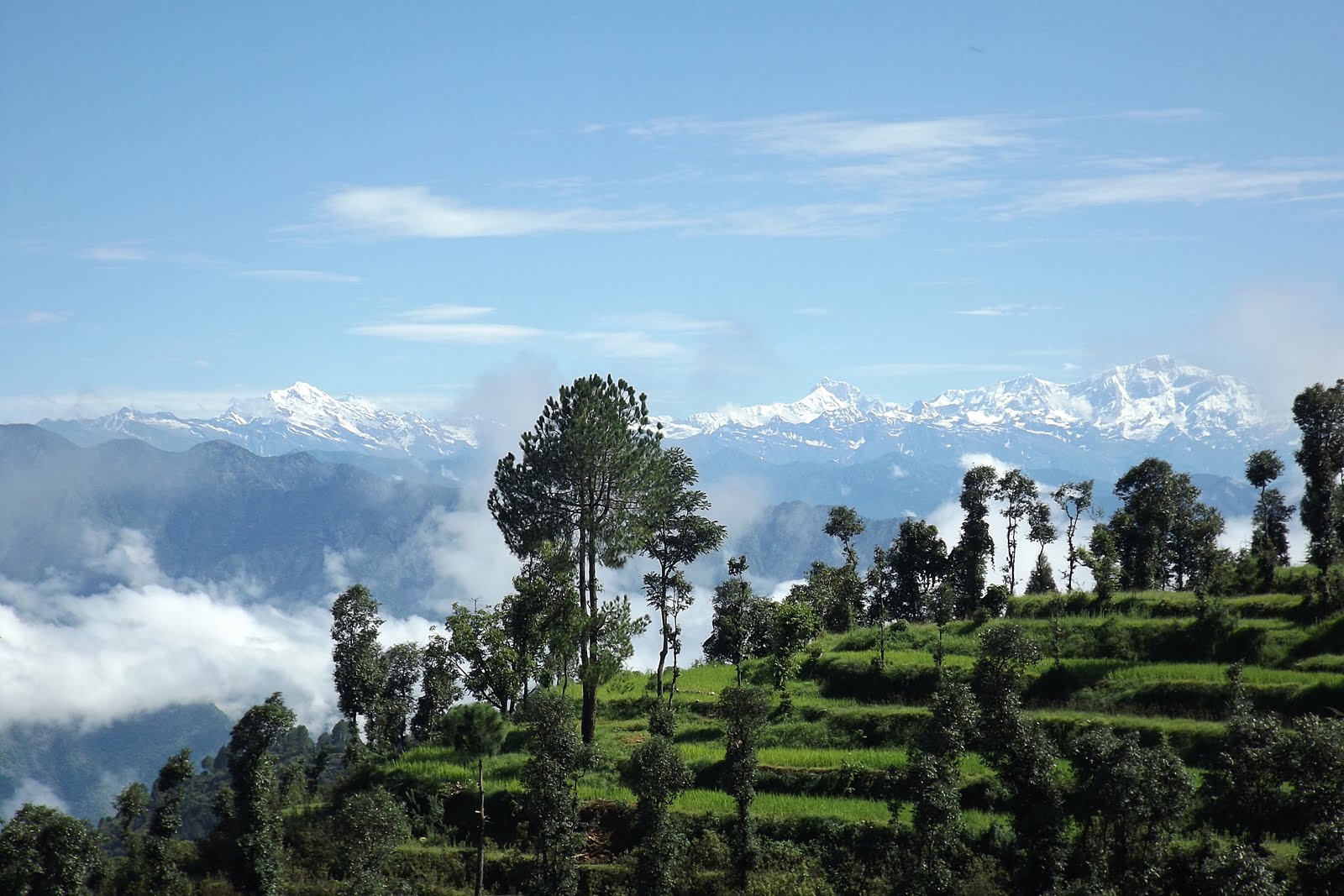
“Unlock the secrets of Khirsu with Yatra Manager’s exclusive insights! Discover breathtaking Himalayan vistas, serene nature walks, and hidden apple orchards. Dive into tranquility amidst pine, oak, and deodar forests. Plan your Khirsu bliss today!”
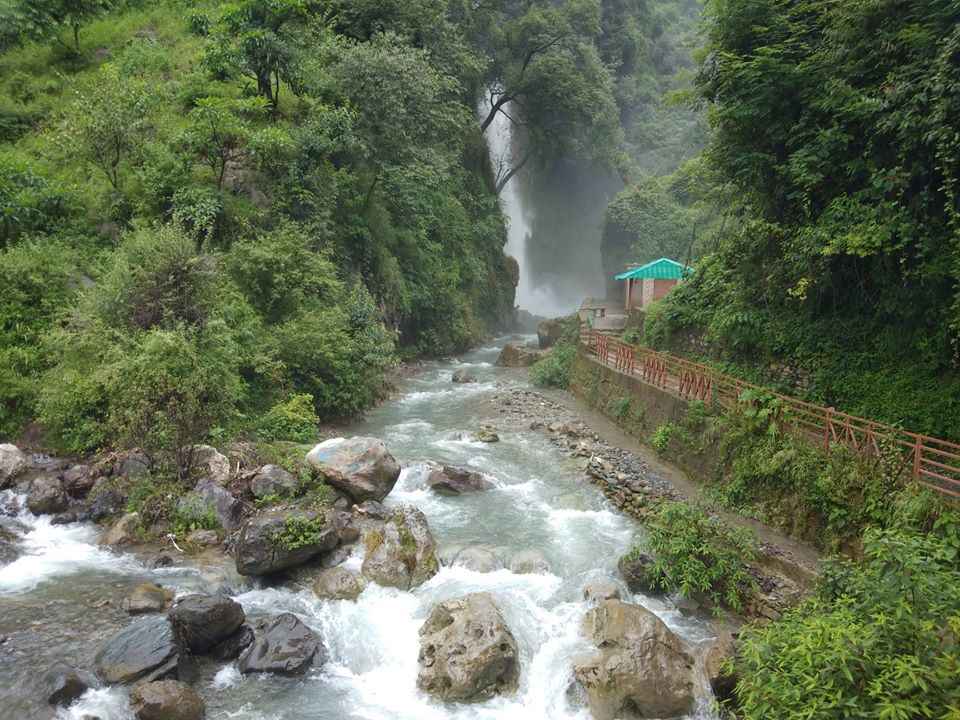
Chakrata, is a Best Hill Station Near Delhi which is a scenic paradise in Uttarakhand. It is a hidden gem with serene landscapes waiting to Be Explored through out the Year. Witness the majestic cascade of Tiger Falls, surrounded by lush greenery. Immerse yourself in the tranquil beauty of Budher Meadow. & Explore the mystical Kanasar forests.

Travel Tips Yatra Cab Services For Char Dham Yatra By Yatra Manager Plan Destination Wedding With Yatra Manager in Uttarakhand […]
Popular Destination
- Indian Destinations
Check Tour Availability
We are one of the prominent travel agencies that you can find around, arranging more than 1500 trips successfully. we customize & manage exceptional tours, based on your personal preference. we aim to provide the best experience for you. join us to make your vacation worth celebrating & enjoy..
- (+91) - 9058610050 (+91)- 8650720050
- [email protected] [email protected]
- 13, BharatMata Puram, Rani Gali Bhupatwala, Haridwar - 249410 Uttarakhand (INDIA)
informations
- Daily Bus Service
- Explore Uttarakhand
- testimonial
- Fixed Departure Tours
- terms & Conditions
- Cancellations & Refund Policy
- privacy Terms
Our Services
- Adventure Activities
- Our services
- Get Me A Taxi
- Rent on tempo travel
- rent on bus
- Char Dham Yatra 2024
- Local Sight Seeing
- Car Pooling Service
Business Links
- Best Deals of Season
- Travel Agents Listing
- Hotel & Resort Listing
- Home Stay Listing
- List Your Taxi/Cab
- List Your Bus
- List Tempo Traveler
- Tour Guide Listing
Helpful Links
- Uttarakhand Tourism
- Hotel & Accommodation
- Heli Ticket Enquiry
- Air Tickets Booking
- Train Tickets - IRCTC
- Char Dham Registration
- Mansarovar Yatra 2024
- suport 24/7
Satopanth Tal Trek
- Evening Tea / Coffee
- Morning Tea / Coffee
- Public/Private Transport
Please choose a slot below to join a group.
Click on a slot to book your seat!
Just Few Steps to Book Your Trip!
By proceeding, you agree to Firstrek's Privacy Policy, User Agreement and T&Cs.
OTP has been sent to your mobile number.
By pressing this, I agree to receiving critical messages such as OTP, booking details on WhatsApp
When do you want to go?
Enter Booking Details
By clicking continue button you will be agree to our terms of user & conditions!
By clicking continue button you will be agree to our terms & conditions!
Your request has been successfully submitted! We will promptly reach out to you shortly. In the meantime, feel free to proceed with the payment. One of our experienced travel consultants will be in touch with you soon. Thank you for choosing us!
- Team Firstrek
Congratulations!
You have Earned Free Travel Insurance by Firstrek worth (Rs.399) Make Payment Now to Redeem
Booking & Pricing Details
By clicking checkout button you will be redirected to secure payment gateway!
Thanks for your Payment!
We have successfully received your payment. Our team will promptly connect with our partners to confirm your booking within the next 24 hours. Typically, this process takes less than 1 hour. Thank you for your patience and trust in our services.
Satopanth Tal Trek Overview
Satopanth Tal Trek is a high-altitude trek in the Indian state of Uttarakhand , known for its stunning views of snow-capped peaks, glacial lakes, and alpine meadows. This challenging trek takes you to an altitude of 4,600 meters, passing through the sacred Satopanth Lake and the majestic Swargarohini peak. Discover the beauty of the Himalayas and challenge yourself with the Satopanth Trek.
About Satopanth Tal Trek
Satopanth Lake , nestled in the Indian state of Uttarakhand , stands as a pristine glacial lake perched at an impressive altitude of approximately 4,600 meters (15,092 feet) above sea level. This stunning body of water finds its sanctuary amidst the grandeur of the Himalayas, specifically within the boundaries of the Chamoli district . The lake is ensconced by a majestic amphitheatre of snow-clad peaks, including the formidable Satopanth Peak, the regal Balakun Peak , and the ethereal Swargarohini , creating a breathtaking natural spectacle.
Uttarakhand, a northern state of India, is well-known for its picturesque landscape and adventurous trekking routes. One of the most popular trekking routes in Uttarakhand is the Satopanth Tal Trek , which is a hidden gem for nature lovers and adventure seekers. The trek starts from Mana village , the First village of India on the Indo-China border , and takes you on a journey through lush green meadows, dense forests, and snow-covered peaks to finally reach the breathtaking Satopanth Lake.
The trek to Satopanth Lake starts from Mana village , which is around 3 km from Badrinath , one of the most famous pilgrimage sites for Hindus. Mana village is surrounded by towering mountains and is a gateway to some of the most beautiful treks in Uttarakhand. From Mana village, the trek leads to the beautiful Vasudhara Falls, which is a sight to behold. The water cascades down from a height of around 400 feet, surrounded by greenery and snow-capped peaks.
After crossing Vasudhara Falls, the trek leads to the lush green meadows of Laxmivan . The meadows are surrounded by beautiful flowers and offer a stunning view of the surrounding mountains. From Laxmivan, the trek takes you through the dense forests of Chakratirth , which is home to a variety of flora and fauna. The trail is steep and challenging, but the view of the surrounding mountains makes it all worth it.
As you reach the end of the forest, the trail opens up to a beautiful glacier called Satopanth. The glacier is around 14 km long and is a sight to behold. The trail leads to the top of the glacier, where you can see the beautiful Satopanth Lake. The lake is located at an altitude of around 15,100 feet and is surrounded by snow-covered peaks. The lake is believed to be the meeting point of Lord Brahma, Vishnu, and Mahesh, according to Hindu mythology.
Location: District Chamoli, Uttarakhand, India. Satopanth Trek Distance: 10 km Trek Altitude: 4,600 metres (15,100 feet) Trek Difficulty: Moderate to Difficult Nearest Airport: Jolly Grant Airport, Dehradun Nearest Railway Station: Rishikesh
Key Highlights of Satopanth Lake Trek
The best package for satopanth trek.
- Rishikesh to Rishikesh (7 Days & 6 Nights) We start our journey from Rishikesh, which is well-known as a holy place in Uttarakhand. Our pilgrim Route will be Rishikesh – Mana Village – LaxmiVan – Satopanth – Mana – Rishikesh. Packages start at ₹ 20,999 Per Person (Including accommodation, meal, and transport) + 5% GST
- If anyone is interested in booking a private tour for their friends and family, we have a distinct procedure in place to accommodate your needs.
The Hindu Mythology of Satopanth Lake
According to Hindu mythology, Satopanth Tal trek is believed to be the meeting point of Lord Brahma, Lord Vishnu, and Lord Shiva. Legend has it that Lord Brahma created this lake as a place for penance and meditation. Lord Vishnu is said to have bathed in the waters of the lake to get rid of his sins. Lord Shiva is also believed to have meditated near the lake, and it is said that the divine trinity meets at the lake on the day of the Ekadashi during the Hindu month of Jyeshtha.
Another interesting legend associated with Satopanth Lake is that of the Pandavas, the protagonists of the Hindu epic Mahabharata . It is believed that after the Kurukshetra war, the Pandavas went on a pilgrimage to find salvation for their sins. On their journey, they came across Satopanth Lake trek and decided to take a dip in its holy waters. However, as they entered the lake one by one, only Yudhishthira, the eldest of the Pandavas, was able to complete the dip. The other Pandavas failed the test, as they still had some attachment to worldly possessions. Yudhishthira was then granted salvation, while the other Pandavas had to continue their pilgrimage.
The Satopanth Lake is also considered to be a sacred place for Hindu devotees, who visit the lake to seek blessings and offer prayers. The lake is surrounded by snow-capped mountains and has crystal-clear water, which adds to its spiritual significance.
The Best Time for Satopanth Lake Trek
The best time to undertake the Satopanth Tal trek is from May to June and from September to October . During these months, the weather is generally pleasant, with clear skies and moderate temperatures. The monsoon season, which occurs from July to August, is not recommended for trekking due to heavy rainfall and the risk of landslides. winter months from November to April are also not suitable for trekking, as the trail is covered in snow and the weather can be extremely harsh. Therefore, it is recommended to plan your Satopanth trek during the months of May–June or September–October for the best experience.
How to reach Satopanth Tal Trek
To reach Satopanth Tal trek, a beautiful high-altitude lake located in the Uttarakhand region of India, you will need to follow a multi-day trekking route. The lake is situated at an altitude of approximately 4,600 meters (15,100 feet) and is considered sacred by both Hindus and Buddhists. Here’s a step-by-step guide on how to reach Satopanth Lake:
Start your journey from Delhi and head towards Haridwar or Rishikesh via NH58. Haridwar/Rishikesh: From Haridwar or Rishikesh, proceed towards Joshimath (250 km) via NH7.
Joshimath to Mana
Continue from Joshimath to Mana village(45 km), the last motorable point on this route.
Trekking Start Point
The trek to Satopanth starts from Mana village.
Rishikesh Railway Station: Rishikesh is the nearest railway station to Satopanth. From Rishikesh, you can hire a taxi or board a bus to reach Joshimath (247 km). Haridwar Railway Station: Alternatively, you can reach Haridwar railway station (280 km) and then proceed towards Joshimath. Joshimath to Mana: From Joshimath, continue your journey towards Mana village, the starting point of the trek.
Jolly Grant Airport, Dehradun: Jolly Grant Airport is the nearest airport to Satopanth. From here, you can hire a taxi or board a bus to reach Joshimath (264 km) via Rishikesh or Haridwar.
Helicopter Service
Some tour operators also offer helicopter services from Dehradun to Joshimath, which can shorten your travel time significantly. Satopanth Trek is a thrilling adventure amidst the breathtaking landscapes of the Himalayas. Whether you choose to travel by road, train, or air, each mode of transport offers its own unique experience, leading you to the starting point of this unforgettable trek.
Accommodation and Meals on Satopanth Trek
The Satopanth Tal trek is known for its breathtaking views of the Himalayan mountains and the crystal-clear lake at the summit. However, it is important to note that there are no hotels or restaurants on the trek, so visitors must bring their own accommodations and meals.
For accommodation, trekkers are required to carry their own camping gear, including tents, sleeping bags, and sleeping pads. It is essential to choose lightweight and durable camping equipment that can withstand the harsh weather conditions on the trek. The campsite options are limited, and trekkers must obtain permission from the forest department before setting up camp. Therefore, it is recommended to plan the camping arrangements in advance to avoid any inconvenience.
In terms of meals, it is advisable to carry a sufficient supply of non-perishable food items that are easy to prepare and provide adequate nutrition. Some popular options include instant noodles, canned food, energy bars, and dried fruits. Trekkers can also carry water purification tablets or filters to ensure that they have access to safe drinking water.
The Places you will see on the Satopanth trek
The Satopanth Tal / Lake Trek is a beautiful and challenging trek that takes you through some of the most stunning landscapes in the Indian Himalayas. Here are some of the must-see places on this trek:
Mana Village
The trek starts from Mana Village, which is the last village on the Indian side before the Tibet border. This picturesque village is situated at an altitude of 3,200 meters and is surrounded by the Himalayan ranges.
Vasudhara Falls
After leaving Mana Village, you will trek for about 6 km to reach the Vasudhara Falls. This waterfall is about 400 feet high and is a popular spot for trekkers to take a break and enjoy the beautiful scenery.
The next stop on the trek is Laxmi Van, which is a small meadow situated at an altitude of 3,400 meters. This place offers stunning views of the surrounding mountains and is a perfect spot to set up camp for the night.
Chakratirtha
After leaving Laxmivan, you will trek for about 5 kilometres to reach Chakratirtha. This place is situated at an altitude of 4,000 meters and is known for its crystal-clear water streams.
Satopanth Lake
The final destination of the trek is Satopanth Lake, which is situated at an altitude of 4,600 meters. This pristine lake is surrounded by snow-capped peaks and is considered a sacred place by the locals. The lake is also believed to be the meeting point of Lord Brahma, Lord Vishnu, and Lord Shiva.
Why you should plan the Satopanth Tal Trek
Satopanth Lake is a glacial lake situated at an altitude of 4,600 meters. The trek to Satopanth Lake is not for the faint-hearted, as it is a challenging 6-day trek that requires a good level of fitness and experience. However, the trek is worth the effort as it provides breathtaking views of the Himalayan range, and the pristine blue waters of the lake are a sight to behold. Here are some reasons why you should plan a Satopanth Lake Trek:
Breathtaking Views
The trek to Satopanth Lake trek takes you through some of the most stunning landscapes in the Himalayas. From dense forests and lush meadows to snow-covered peaks and glaciers, the trek provides a feast for the eyes. The views of the Chaukhamba, Neelkanth, and Balakun peaks from the lake are especially stunning.
Wildlife Sightings
The Satopanth Tal Trek takes you through the Nanda Devi Biosphere Reserve, which is home to a variety of wildlife such as Himalayan black bears, snow leopards, musk deer, and blue sheep. The trek also provides an opportunity to spot various species of birds, such as Himalayan monals, snow partridges, and Himalayan griffons.
Spiritual Significance
Satopanth Tal trek is considered a sacred lake by the locals, and it is believed that Lord Brahma, Lord Vishnu, and Lord Shiva take a dip in the lake on a particular day every year. The trek takes you through several pilgrimage sites, such as Badrinath, Mana Village, and Vyas Gufa, which are of great spiritual significance.
Adventure and Challenge
The Satopanth Lake Trek is a challenging trek that requires a good level of fitness and experience. The trek involves steep ascents, descents, and crossings of glaciers and streams. However, the feeling of accomplishment and satisfaction that comes with completing the trek is unmatched.
Cultural Immersion
The trek takes you through several remote villages where you can interact with the locals and learn about their way of life. The region is home to the Bhotiya and Garhwal communities, and you can experience their unique culture and traditions.
Camping is an essential part of the Satopanth Lake Trek. You will be camping in some of the most picturesque locations, with stunning views of the Himalayas. The campsites are usually set up near rivers and streams, providing a peaceful and serene atmosphere.
Photography
The Satopanth Tal Trek offers plenty of opportunities for photography. From the snow-capped peaks of the Himalayas to the lush green valleys, the region is filled with natural beauty that is perfect for capturing some stunning photographs.
Yoga and Meditation
The serene environment of the Satopanth Trek is perfect for yoga and meditation. You can practice yoga and meditation in the morning or evening, surrounded by the natural beauty of the region.
The clear night skies of the Satopanth Trek provide a perfect opportunity for stargazing. You can witness the Milky Way and other constellations in all their glory.
The Satopanth Tal Trek is an adventure that provides a perfect blend of nature, spirituality, and culture. The trek is challenging but rewarding, and the breathtaking views and wildlife sightings are a once-in-a-lifetime experience. So, pack your bags, put on your trekking shoes, and embark on a journey of a lifetime.
Conquering the Heights: A Journey to Satopanth Tal
In conclusion, the Satopanth Trek stands as a testament to the allure and majesty of the Himalayas. As trekkers traverse through rugged terrain, dense forests, and pristine meadows, they embark on a soul-stirring adventure unlike any other. The journey to Satopanth Tal is not merely about reaching a destination but about embracing the challenges, discovering inner strength, and connecting with the raw beauty of nature. It’s a pilgrimage of the spirit, where each step taken brings trekkers closer to the serenity and grandeur of this sacred Himalayan jewel. With every vista that unfolds and every obstacle overcome, the Satopanth Trek leaves an indelible mark on the hearts and minds of those who dare to tread its path.
Satopanth Tal Trek Itinerary
Day 1- drive rishikesh to mana (3,200 feet).
Start your journey from Rishikesh early in the morning. Drive to Joshimath, a picturesque town nestled in the Chamoli district. En route, you'll pass through Devprayag, Rudraprayag, and Karnaprayag, where the Alaknanda and Bhagirathi rivers merge. Upon reaching Joshimath, take a short break and explore the town. Continue your drive to Mana, the last village, before the trek begins. Overnight stay in Mana.
Day 2- Trek Mana to Laxmi Van (9,200 feet)
After breakfast, start your trek from Mana. The trail gradually ascends through beautiful meadows, dense forests, and picturesque landscapes. You'll pass through the Vasudhara Falls, a magnificent waterfall, en route. Reach Laxmi Van and set up camp for the night. Enjoy the serene surroundings and the breathtaking views of the Himalayas. Overnight camping at Laxmi Van.
Day 3- Trek Laxmi Van to Chakratirtha (12,100 feet)
Today's trek takes you through some challenging terrain. Begin early in the morning and trek through steep trails and rocky terrain. Pass through the mysterious and enchanting Bheem Pul, a natural rock bridge. Continue your ascent to reach Chakratirtha, a scenic spot with a high altitude lake. Camp at Chakratirtha for the night. Enjoy the panoramic views of the surrounding peaks, including Neelkanth and Balakun.
Day 4- Trek Chakratirtha to Satopanth Tal (14,000 feet) and back to Chakratirtha
Start your day with a steep climb to Satopanth Tal, the highlight of the trek. Satopanth Tal is a glacial lake known for its pristine beauty and religious significance. Take some time to admire the tranquillity of the lake and the snow-capped peaks reflecting in its crystal-clear waters. Descend back to Chakratirtha for an overnight stay. Enjoy the starry night sky and the peaceful atmosphere.
Day 5- Trek Back Chakratirtha to Laxmi Van
Begin your descent from Chakratirtha back to Laxmi Van. Take your time to soak up the beautiful surroundings and enjoy the natural wonders of the region. Set up camp at Laxmi Van and spend the night amidst the serene environment.
Day 6- Laxmi Van to Mana and drive to Badrinath (10,170 feet)
On the final day of the trek, trek back to Mana. From Mana, take a short drive to Badrinath, one of the most revered pilgrimage sites in India. Visit the Badrinath Temple, dedicated to Lord Vishnu, and seek blessings. Explore the sacred town and its surroundings. Overnight stay in Badrinath.
Day 7- Badrinath to Rishikesh
After breakfast, bid farewell to the stunning Himalayas and start your journey back to Rishikesh. Enjoy the scenic drive, reflecting on the memories of your adventure. Reach Rishikesh by evening and conclude your trek with unforgettable memories.
Satopanth Tal Trek Route on Map
People also ask about satopanth tal trek, q.1 how difficult is the satopanth tal trek, q.2 what is the best time to trek to satopanth lake, q.3 how long is the trek to satopanth tal, q.4 what kind of accommodations are available on the trek, q.5 can i hire a guide for the trek, q.6 is it necessary to bring my own camping equipment, q.7 are there any restrictions on the trek, q.8 what should i pack for the trek.
I recently completed the Satopanth Lake trek organized by FirstTrek Company, and I must say it was an incredible experience from start to finish. The company's attention to detail and excellent organization made the entire journey seamless. The trek itself was breathtaking, with stunning landscapes, snow-capped peaks, and the pristine Satopanth Lake itself. The knowledgeable and experienced guides provided us with valuable insights about the region's flora, fauna, and local culture. The camping arrangements were comfortable, and the food provided was delicious and nutritious. I highly recommend FirstTrek for anyone looking to embark on an unforgettable adventure.
FirstTrek Company truly exceeded my expectations with their Satopanth Lake trek. From the moment I made my booking, their team was responsive and helpful, providing all the necessary information and guidance. The trek itself was an absolute delight. The trail was well-maintained, and the guides were not only skilled but also friendly and supportive throughout the journey. They ensured everyone's safety and comfort, making the trek accessible even for beginners. The sight of Satopanth Lake was a reward in itself, with its crystal-clear waters and majestic surroundings. Kudos to FirstTrek for creating such a memorable experience
I can't thank FirstTrek Company enough for organizing the Satopanth Lake trek. The entire experience was flawlessly executed, making it a truly remarkable journey. The trek was well-paced, allowing us to acclimatize properly and enjoy the stunning vistas along the way. The guides were knowledgeable and passionate, sharing their insights about the local culture, history, and the surrounding Himalayan ecosystem. The campsite locations were picturesque, and the tents were comfortable and well-maintained. The highlight, of course, was reaching Satopanth Lake, a hidden gem nestled amidst the mountains. FirstTrek Company's professionalism and commitment to customer satisfaction are truly commendable
I recently embarked on the Satopanth Lake trek organized by FirstTrek Company, and it was undoubtedly one of the best adventures of my life. The company's professionalism and attention to detail were commendable. They took care of everything, from permits to accommodations, allowing me to fully immerse myself in the beauty of the trek. The trek itself was challenging yet rewarding, offering breathtaking views of snow-clad peaks, lush green meadows, and the awe-inspiring Satopanth Lake. The team of guides and porters provided constant support, ensuring our safety and making the journey enjoyable. FirstTrek Company is highly recommended for their exceptional service and commitment to creating unforgettable experiences.
FirstTrek Company provided an exceptional trekking experience during the Satopanth Lake trek. Their attention to detail and customer service were outstanding. The guides were experienced mountaineers who made the journey both safe and enjoyable. They went above and beyond to ensure that everyone in the group had a memorable time. The trail was challenging but rewarding, taking us through diverse landscapes and offering panoramic views of the Himalayas. The highlight of the trek was undoubtedly the breathtaking Satopanth Lake, a place of tranquility and natural beauty. I highly recommend FirstTrek Company for their professionalism, expertise, and passion for creating extraordinary adventures.
Top Camping Sites in Uttarakhand & Himachal
- Camping in Rishikesh
- Camping in Tehri
- Camping in Chopta
- Camping in Kanatal
- Camping in Dhanaulti
- Camping in Nainital
- Camping in Chaktara
- Camping in Mukteshwar
- Camping in Auli
- Camping in Shimla
- Camping in Kasol
- Camping in Manali
- Camping in Deoria Tal
Top Hotels in Uttrakhand with Char Dham Route
- Hotels in Rishikesh
- Hotels in Chopta
- Hotels in Bhimtal
- Hotels in Almora
- Hotels in Nainital
- Hotels in Chaktara
- Hotels in Mukteshwar
- Hotels in Haridwar
- Hotels in Mussoorie
- Hotels in Tehri
- Hotels in Pauri
- Hotels in Badrinath
- Hotels in Joshimath
- Hotels in Guptkashi
- Hotels in Kedarnath
- Hotels in Gaurikund
Join Thousands of Businesses & Travellers
Join more then 20 Thousands Travellers & 2000+ Businesses from India.
For Customers
Download App & Be Updated
For Vendors
Sending Feedback..
Your feedback help us to improve.
Your feedback is too much important to us!
Table of Contents
Trek Updates
- +91 9634923602
- +91 7895770439
- [email protected]

The Searching Souls – चल एक सफर पे
Satopanth Lake Trek
- Badrinath to Badrinath
- Best price gauranteed
- High end services
- Easy Booking & Cancellation
Booking open
Contact 8006074398 for more details.
Trek Duration
Trek Distance
Difficulty Level
Best Season
May-June & Sept-Oct
₹17000 ₹15000
Call our satopanth lake trek expert ms. nidhi to know more about the trek.
- One Night stay in Manali at ₹ 1200/person
- Double Sharing Tents at ₹ 500/person
- Trek from Badrinath to Badrinath
- Trek cost: Food(Veg Only- Breakfast, Lunch, Evening Snacks and Dinner), Tents(Triple Sharing), Sleeping Bags, Sleeping Matts
- Micro Spikes/Gaiters for Satopanth lake trekking in winter (if necessary)
- Experienced Trek Leader, Professional Guides and a very supportive staff
- Forest permits
- Medical Amenities – First Aid Kits, Oxymeters, oxygen cylinders.
- Anything not mentioned in inclusion list
- Accommodation and meals at Badrinath
- Any kind of personal Expenses
- Unscheduled or extended stay due to road blocks, Landslides
- Porter/mule charges (Personal), Back pack offloading Charges
- Cost of Evacuation in case of emergency
Summary of Satopanth Lake Trek
Satopanth lake trek overview & itinerary.
Perched amid towering peaks, Satopanth Lake Trek is the sacred lake lying at an elevation of 4303 meter near Chaukhamba massif’s base. Start the trek from last village “Mana” and the main attraction of this place is Vasundhara falls.
Trek to a phenomenal “Wish fulfilling Tal” “On this trek go through Laxmi Van which is a thick forest, reach the pristine Lake and spend time at the divine vicinity. Located at Chamoli distract in Uttarakhand.
Satopanth Lake Trek is a High Altitude Lake at a height of 4350 Meter. It is one of the virgin treks not known by many but the trekker and Sadhu sant or local people of the area believe that this lake is sacred and possess some supernatural power of fulfilling wishes.
The Satopanth Lake Trek is between two beguiling the trail is thrilling through dense forest, meadows with enchanted beauty and some steep ridges but the panorama views from the top cannot be described in words.
Trek to this sacred Tal is a difficult one but as the beliefs of people wishes are fulfilled here so it’s worth going there, this part of swargarohini the way to Heaven.
What is special about Satopanth Lake trekking?
- Satopanth Lake is a high altitude mountain trek Altitudes is 4350 meters
- The Starting trail is moderate as compare to other treks this is moderate trek. So this trek is good for beginners’ trekkers
- You got to see so many heavenly bodies at one place like the panoramic view of the Himalayan ranges, you can see pine forests, different variety of flora and fauna surpassing through bona fide Garhwali culture.
- Beautiful camp sites
- The view on the way is mesmerizing
Satopanth Lake Trek Map
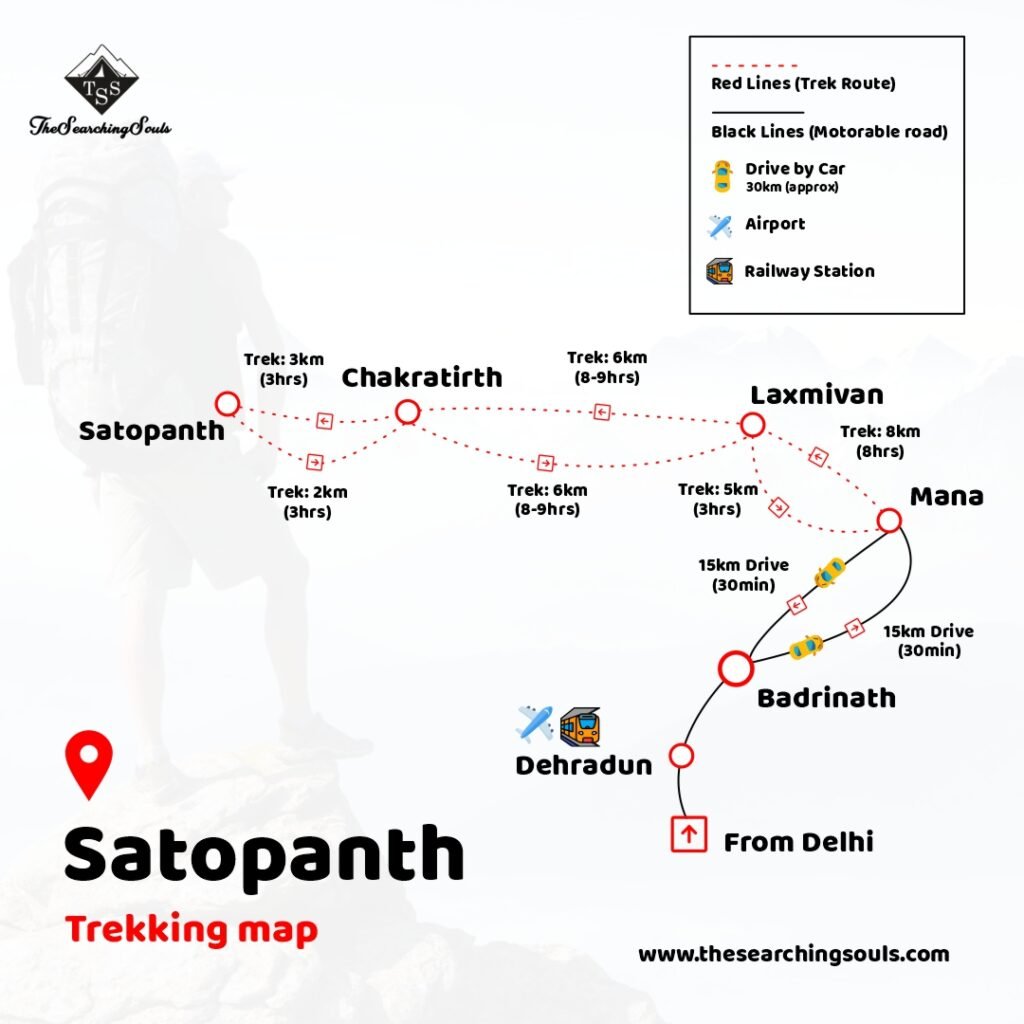
Day 1: Badrinath to Laxmivan, 8 Km Trek
- After breakfast travel to Mana village, from where the trek starts.
- After a short trek you will get the sight of Vasundhara falls which lies opposite Alaknanda River’s bank.
- Reach campsite in the afternoon.
- Stay in the camps
Day 2: Laxmivan to Chakratirth, 10 Km trek
- The trek is challenging today, head from Laxmi Van towards Chakratirth.
- The ascent is sheer through scree and boulders to “Sahastradhara” which means “Thousand waterfalls”. After you climb up the valley this place offer views of Chaukhamba peaks, Balakun and Neelkanth.
- Now, start the steep climb, then a short trek will lead you to Chakrateerth campsite.
- Stay in the campsite
Day 3: Chakratirth to Satopanth, 05 Km trek
- Start the trek early today because you will be crossing some tricky sections on the trail.
- Ascent to the ridge’s high point and trek along the glacier to reach serene triangular “Satopanth Lake”. Get impressive views of Chaukhamba peaks and Neelkanth Mahadev.
- The surroundings are beautiful, explore and relax there for some time.
- Return to Chakratirth campsite and Stay in the camps.
Day 4: Chakratirth to Laxmivan, 10Km trek
- Get back to Laxmivan, descending takes less time but be careful while the descent because some sections are tricky.
- Reach Laxmivan by afternoon. Have meal here.
- Stay in the camps.
Day 5: Laxmivan to Badrinath via Mana, 10Km trek
- Descent towards Mana village and you can reach there in 3 hours.
- From Mana the drive is towards Badrinath, arrangements will be made in a hotel there.
- Evening going to badrinath ji darshan
- Stay in hotel in Badrinath
Essentials to carry with you on satopanth tal trek
- Backpack/Ruck Sack (at least 55 Litres) and a small day bag ( upto 15 litres) for summit day
- Poncho/Raincoat and Rain Cover for Ruck Sack
- 2 Quick Dry T-shirts (preferably Full Sleeves) and Track Pants
- Warm Jacket preferably a down jacket or an equivalent heavy jacket to protect from cold at night
- Comfortable Shoes with a good grip and ankle support. We recommend Quechua Forclaz 100 or similar shoe
- A pair of fleece jacket or fleece upper
- Good Thermals for insulation at night
- Lip Balm and Cold Cream
- Sun Cap or Sunscreen (SPF 30+)
- Dark Sunglasses. People who wear spectacle may use photochromatic lenses in their spects
- 2 pair of warm socks and at least 2 pair of normal cotton socks
- 1 Pair of slippers/Sandals
- Woolen Cap and Gloves for night
- Toiletries – Tooth brush, Tooth paste, Liquid soap, Hand Sanitizers, Slippers, Light Towel, Toilet Roll (Avoid wet tissues as they are not eco friendly)
- Torch or Headlamp with extra pair of batteries
- Personal Medical Kit: Diamox-Mountain Sickness, Crocin-Fever, Avomine-Motion Sickness, Avil 25mg – Allergies, Combiflam, Disprin-headache, Norflox TZ & Lomofen-diarrhea, digene-acidity, omez/rantadine antacid, crepe bandages, band aids, ORS, betadiene or antiseptic cream, moov spray/volini, cotton, gauze.
- Water bottle 1 L or Hydration bag 2 L
- Other personal accessories – Camera, Tripod, mobile charger, power banks(as there will be no electricity during the trek)
- Being a high altitude trek, this trek is suitable for climbers with good physical condition and stamina.
- This is a tentative itinerary which may change as per weather conditions
- We expect you to carry your rucksacks, in case if you want them to be carried by mules back pack offloading charge up to Rs. 700/bag/day is applicable
- In case of any natural calamity the TSS company will not be able to refund the trip charges, for more details check our cancellation policy
What should you pack for the Satopanth tal trek ?
Basic trek essentials.
- Rucksack (60-70 ltr with cover)
- Down Jacket
- Gloves (Woollen and Waterproof)
- Poncho or a Rain Coat
- Trekking Pole
- Trek Shoes - Men or Women
- Trek Pant – 2 Nos. Preferred
- Day Pack ( 20-30 litres)
- A pair of Thermals
- Warm Socks and cotton socks ( 2-3 pair)
- Woollen Cap
- Gloves ( Woollen and waterproof)
- Extra Layering of Warm Clothing as per necessity
- Extra lowers for Nights
- Utensils : Plates, Spoon and Coffee Mug
- Photo ID proof
Personal Utilities :
- Sun Glasses ( UV Protected )
- Sun Screen Lotion (Min SPF- 30 min)
- Moisturiser
- Lunch box, Coffee mug and spoon
- Water bottle or Hydration Bag
- Basic First Aid
- Energy Bars
Toiletries :
- Toilet paper rolls
- Wet wipes (unscented)
- Zip Lock Bags
- Sanitizing Toilet Spray
- Soap and Handwash (pocket sized)
- Tooth Paste and Tooth Brush
Pay Online To Book Your Trek Now
Related treks.
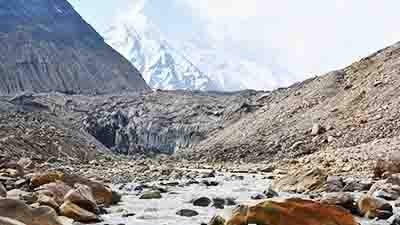
Gaumukh: The Source of...
Hike to Gaumukh is a challenging trek with scenic views.It is a glacier in the Himalayas which is the source of the Ganges River. ...
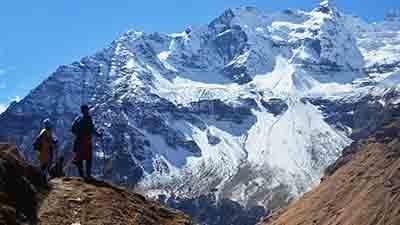
Pindari Glacier Trek
Pindari Glacier is one of the best treks in Kumaon region of Uttarakhand and a very easy one to begin with.
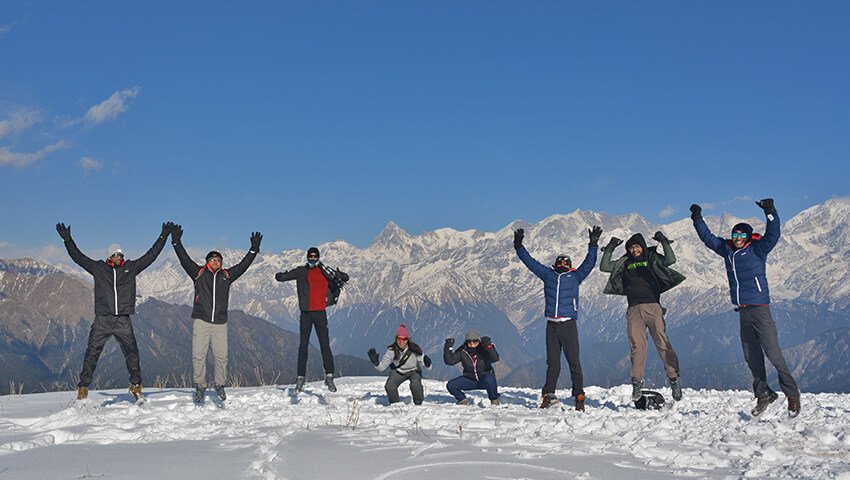
Dayara Bugyal Trek
Hike to a high altitude meadow considered among the highest & largest meadows of the Himalayas offering a panoramic view of gigant...
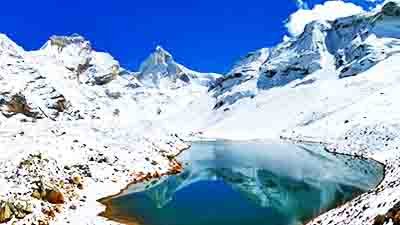
Kedartal Trek
Kedartal- Lord Shiva’s lake,is the source of Kedar Ganga river, that is flowing beside the trail to Kedartal.
FULFIL DREAMS
At The Searching Souls, we intend to encourage people, to take out time from their busy lives and join us on a journey of self-exploration in the Himalayas.
Address Lane No 3, Friends Enclave, Near Siddhartha law college, IT Park, Sahastradhara Rd, Dehradun, Uttarakhand 248013
Daily Business Hours: 9 AM to 9 PM
Call: +91- 9634923602, 7895770439
IN A NUTSHELL
Certified by StartUpIndia, MSME and Uttarakhand Tourism, we are a 5 Star Rated Company with a 95% Customer Satisfaction Score. We deal in Trekking in the Himalayas, Customized group tours.
You will receive an email containing a link allowing you to reset your password to a new preferred one.
Verification mail has been sent.
Please check your mail to verify your account.
Click Here to Login
- How To Reach

30°44'37.8"N 79°21'25.0"E
- Satopanth Lake Trek

Inquire Now
Mana, Uttarakhand
Pickup Point
Railway Station, Dehradun
Minimum Age
- Witness the alluring green lake at a staggering elevation of 14,260 feet.
- The trail passes through Mana, the last village in the Indo-Tibet border.
- Satopanth Lake assures you picturesque and tranquil views of the mighty Himalayas.
Close to the hustle-bustle of the holy city of Badrinath lies a secluded, untouched glacial lake referred to as Satopanth. Hidden amidst the most marvelous levels of the Garhwal region, this shiny green lake exudes grace and serenity. It makes for a perfect detour from a pilgrimage to Badrinath. Although positioned simply 22 km from the famous Badrinath, the path has numerous hidden treasures. The short distance of Satopanth Lake Trek is nicely-compensated with a frequent change in scenery.
On Day 1, one passes the final Indian village, Mana, and enters the green valley of Vasundhara. This is basically wherein the trek begins. At the moment, trekkers can banquet their eyes on the 400-toes waterfall of Vasundhara, the stunning birch forests of Laxmiban, and the view of Balakun, wherein two huge glaciers converge.
On Day 2, the inexperienced forested surroundings rework into bold ridge walks over glacial moraines of Dhano Glacier. The panorama is a lovely mash-up of glacial ice and green patches of grassland. Some of the excellent sorts of alpine flowers can be visible right here. The campsite of Chakratirtha has a beautiful view of the top Satopanth glacier, with the Swaragrohini and Chaukhamba tiers towering inside the historical past.
On Day 3, the walk to Satopanth Lake is a fascinating ridge stroll. The lake stays hidden until the final moment of touch. This triangular lake has a fringe of over 1 km and is of a calming evergreen colour. A trek of a few kilometres above the lake is suggested to get a higher altitude of the Satopanth Glacier.
Satopanth Lake Trek height or elevation is encircled around 14,260 feet. It demands around 6 days to comfortably complete the trek. Trekmunk as a Satopanth LakeTrek Organizer will surely make your journey exciting. Satopanth LakeTrek costs are around 22,450 INR which will cover all the inclusions cost for a fixed departure.
Best time to visit Satopanth Lake Trek
Summer (May, June): Weather remains mild and pleasing during the day time, while the nights are relatively chilly in comparison.
Autumn (September, October): It is the best time to go trekking as this is the time when there is an onset of snowfall and landscapes start looking charming. If planning to visit during the autumn season, one should do the booking in advance as there are very fewer arrangement options.
Brief Itinerary
Detailed itinerary, day 1: drive from dehradun to mana.
This will be the first day on this trek. We will drive from Dehradun to Mana. Reach Mana promptly on the day. This is the last town inside the Indian fringe. After the check of the license, we will proceed with lunch. Post lunch, you can roam around and get acclimatized at this high altitude.
During the evening, a few activities will be arranged in order to increase the interaction between the trekkers. Trekking is a team activity and in order to reach the summit, it is very important to climb together. You will certainly light up in the hues of the place, welcoming strangers to become a part of your life. Dinner will be served at night. Overnight stay will be set up. This will mark the end of the first day of the trek.
Day 2: Trek from Mana to Laxmiban
We will start the journey from Mana to Laxmiban on day 2. In a brief time from Mana, you'll pass Saraswati sanctuary. From here, the angle of the path turns out to be progressively steep. Keep on strolling with the Alaknanda River streaming beneath you. The valley is unbelievably green during a storm. Around 2 after 3 hours, you'll start to hear the sound of water plunging down from 400 ft. Before long, Vasundhara Falls will come into focus. This cascade is known for its deductively demonstrated therapeutic worth. As you abandon the falls, track through the rich birch woods of Laxmiban. The valley opens up into two as you stand up to a great mass of Balakun before you. After around 4 km of moraine walk, you'll run over the campground of Laxmiban to your left side.
Day 3: Trek from Laxmiban to Chakratirtha
The present trek is short, yet beautiful, as you enter the Satopanth Valley. The path is spotted with green fixes in the immense terminal moraine of the Dhano Glacier. Keep your eyes open for not many of the most lovely high height snow-capped blossoms here.
Catch the principal perspective on the acclaimed three pinnacles of Bhagirathi from the Satopanth Valley. The climate here can change radically post early afternoon. Move up the precarious edge of Sahashradhara to Chakratirtha outdoor grounds, which is just a kilometre away. From the campground, lounge in the excellent perspective on the west substance of Mt. Neelkanth.
Day 4: Trek from Chakratirtha to Satopanth Lake and back
On the off chance that you thought the past night's perspectives were extraordinary, prepare yourself for a stunning perspective promptly in the first part of the day. With the Neelkanth, Satopanth and Parvati tops to your left side, the Chaukhamba top in the inside and the Balakun extend to your right side, it is anything but a sight you will overlook soon. Remembering that image, set yourself up for a troublesome day of trekking. Take the path that wanders through a labyrinth of rocks and moraine. The sound of torrential slides thunder all through the valley. The course is precarious. A capable guide can assist you in finding the most appropriate course ahead. The last 2 km of the path have free soil over the chilly moraine. This stretch is additionally misleading with a few soak slants. As you arrive at the highest point of the edge, get your first perspective on the triangular lake. There is a little room built as an impermanent safe house here. A neighbourhood sage, Mauni Baba, is known to live near the lake. From the lake, the perspectives are terrific. Towards the left half of Chaukhamba is Satopanth. Cross this and one can associate with the icefield of Panpatia Col and trek right till Kedarnath. The five km return trek to Chakratirtha should be possible quickly in several hours. One can likewise trek down to Laximban if time grants.
Day 5: Reach Badrinath via Mana
Retrace the same trail back to Mana, and depart for Badrinath. We will play some games, indulge in storytelling until the dinner is served. We will sleep overnight in Badrinath.
Day 6: Depart for Rishikesh/ Dehradun
This happens to be the last day of this breathtaking elegant trek to Satopanth Lake trek. On this day, you will drive back to Dehradun. You will reach Dehradun by 6 or 7 pm. You can plan your onward journey from here.
We can arrange a cab for you from the pickup point in Dehradun, the charges for the same are not included in the package. The cost of the cab can be shared among the trekkers joining the trek. For communications purposes, we will create a Whatsapp Group before the departure date of the trek and will share the details regarding the transportation. The drop at Dehradun after the trek will be arranged in a similar way.
How to reach Satopanth Lake Trek Base camp (Mana, Badrinath) :
Jolly Grant Airport is the nearest airport to Dehradun and is easily accessible, it is just 25 km away from the city. Daily flights from New Delhi are available to this airport. You will have to take a private cab from the airport to Badrinath or Mana or you can take a bus to Govindghat from the bus stand which starts early in the morning.
Dehradun railway station. Overnight trains that hail from Delhi are Nandadevi Express and Dehradun Express. People often prefer railways over airways because with trains you get to see the landscape in its full glory, it is also cheaper and you will definitely enjoy your way till Dehradun. You will have to take a private cab from the airport to Badrinath/Mana or you can take a bus to Govindghat from the bus stand which starts early in the morning.
Regular bus service is available from Delhi ISBT Kashmere Gate which plies government buses that are safe and you can rely on them more than the private buses. You will have to take a private cab from the airport to Badrinath/Mana or you can take a bus to Govindghat from the bus stand which starts early in the morning.
Latest Stories
Why trek with us .

Get Yourself Fit
Nutrition tips, things to take, health & safety.
- Accommodations at Trek: All accommodations on the trek will be on twin sharing basis in Tents or Homestays. Any accommodation in a hotel/guest house/hostel will be in a budget hotel.
- Trek Leader and Guides: An experienced and certified Trek Leader , as well as a professional guide, will accompany you for the trek. The team will have years of experience and well equipped for any emergency situation.
- Services of a Professional Trekking Team: A team of an experienced Cook, Camp Staff, Porters/Mules will accompany you for all the arrangements on the trek .
- Meals: All Meals on the Trek are included. We will serve Vegetarian Indian food on the trek which will be cooked by our high altitude chefs. It will be a five-course meal plan.
- Camping and Safety Equipment: All the camping equipment such as Tents, Sleeping bags, Toilet Tents, Dining Tent, Mattresses, and other things will be provided by us and we guarantee the quality. Safety Equipment including Medical kit, Oxygen Cylinder, Oximeter, Crampons & Gaiters(if required) will be provided by us. We recommend you to bring your own sleeping bags if possible.
- Trek Permits and Forest Camping Charges: Only for Indian Clients, All the applicable trekking permits, Camping Charges, Forest Entry Fee, etc will be paid by us. Foreigners have to pay these charges if not mentioned.
- A Life-Changing Experience: We assure you that by trekking in the Himalayas you will have a life-changing experience and we will do everything we can to provide you with the best services and make your venture in the wild an unforgettable one.
Note: Prior to booking any adventure with Trekmunk, it will be mandatory to sign the waiver form and get a medical certificate from a doctor in due time, without these, you will not be allowed to start the trek. All this will be done online without using any paper.
- GST and Other Taxes: The goods and services tax is not included in the price mentioned with the trek. They are subjected to change according to the government rules of India.
- Food and Accommodation in Dehradun: Food and Stay in Dehradun is not included in the package.
- Flights and Transportation: Flights or other means of transport are not included in the package. Transportation from Dehradun to Mana and Mana to Dehradun is not included in the package. Any expenses occurred during the journey are not included in the package cost.
- Personal Equipment: Your Rucksack, personal clothing, shoes, trek poles, and other personal trekking gear is not included in this package. You have to bring your own gear according to the weather and difficulty of the trek.
- Portage of Personal Bags(Offloading): We highly advise you to carry your own burden (your rucksack) but due to any reason, if you wish to not carry your rucksack, we can arrange for a porter/mule to carry it. For this service, you will be charged over and above the trek cost. The charges for offloading vary with every trek.
- Travel Insurance: Travel Insurance is not included in this package. We recommend you to have travel insurance before opting for such adventures. You can buy insurance from us while booking the trek, it is optional.
- Personal Expenses: Any personal expenses incurred (Laundry, Bottled Water, Beverages, Snacks, Orders at tea houses or dhabas, Tips for guides, Camera fees, etc) are not included in the package.
- Emergency Expenses: Any costs arising out of unforeseen circumstances such as accidents, bad weather, landslides, road conditions and any other circumstances beyond our control are not included in the package.
- Anything not mentioned in Inclusions of the package.
Cancellation Policy And More Information
Booking Terms:
1. Confirmation Policy :
Upon Booking, An invoice will be sent to your mail & within 12 to 24 hours the booking confirmation with additional details will be sent to your mail.
2. Cancellation Policy:
Note: Following Cancellation policy will be followed for departures booked on or before 31st May 2021-
1) Cancellation up to 7 days before the start date of the trek: Get a complete cash refund (minus 5% transaction fee). The money is refunded to the same bank account, credit, or debit card from where the payment was made.
2) Cancellation during the last 6 days before the start date of the trek, and not counting the day of the trek: Full refund with 100% of the trek fee in the form of a Trekmunk Trek Voucher. Valid for 1 year from the date of issue. Can be used on any Trekmunk trek.
3) Cancellation on the start day of the trek, or no show on the start day of the trek : Unfortunately, no refund.
For more details, go to https://www.trekmunk.com/cancellation-policy
3. Refund Policy:
Any refund applicable will be processed within 10 to 15 business days as per the company policy.
4. Postpone/Transfer of a booked trek:
1. You can postpone your booked trek for a period of two months (61 days) but we will charge a 20% processing fee. The last date for the postponement will be 15 days before the start of the trek. Failing to book the slot in 2 months (61 days) time, would be considered a cancellation with no refund of any kind. Postpone of a booked trek can only be done once.
2. You can transfer your booked slot for the trek to any fit person till 15 days before the trek. You just have to mail us the request and rest we will handle. The new person has to get all the mandatory documents duly signed for the trek.
More Information:
1. We Trek for a Cause : For overall development of the areas we run our operations in, we donate Rs 100/- per booking from our profits which are used for the upliftment of the local people and conserving nature. We have named this initiative as - Trek for a Cause. For more details, follow: https://www.trekmunk.com/trek-for-a-cause
2. We are paperless : We are focusing on Sustainable Tourism and to do that we are trying all measures to convert our trek operations to be Eco-Friendly. Going Paperless is one step closer to our aim.
3. Single-Use Plastic : Trekmunk does not encourage the use of single-use plastic items. We are ensuring that our team is working together to reduce the problem and educate those around them. We will send you instructions on how to go plastic-free on your adventures.
4. Preparing for your Holiday : Getting some additional exercise makes a lot of sense to spend time before coming on a trekking adventure. The fitter you are, the more enjoyable you will find the experience. Hiking in the hill country is the best training but jogging, squash and swimming are also good for developing cardiovascular fitness and stamina. To read more on how to get fit, follow: https://www.trekmunk.com/get-fit-for-trek
5. Electricity Supply & Plug : You will get electricity supply till the starting point of the trek. If not Indian, We recommend you check if you require an adaptor for your electrical items at: http://www.worldstandards.eu/electricity/plugs-and-sockets/
6. Currency: The unit of currency in India is the Indian Rupees.
7. Health & Vaccinations:
Severe Allergies : If you have a severe allergy please inform the Trekmunk office before you travel. We will do all we can to help, but we cannot guarantee an allergy-free environment on trekmunk trips. You will need to carry your own treatment for the allergy with you, as 'adrenaline auto-injectors' are not carried as standard by our leaders and staff. You should inform your leader on the arrival of your allergy, and let them know where you keep your adrenaline pen.
Vaccinations : You should contact your doctor or travel clinic to check whether you require any specific vaccinations or other preventive measures. You should be up to date with routine courses and boosters as recommended e.g. diphtheria-tetanus-polio and measles-mumps-rubella, along with hepatitis A and typhoid. Malarial prophylaxis is not usually required for trips in the mountains, however, if you are visiting rural and remote low lying areas then they might be necessary.
8. Passport & Visas/Identity Proofs : If foreigner, Validity for 6 months, should have blank pages, and should be kept with yourself all the time.
9. Water : If you are on a trekking or cycling holiday, water is supplied to fill up your individual bottles. This will be boiled or filtered. Additionally, you should take purification tablets or a filter bottle (such as a LifeStraw, Sawyer Filter) to treat your water when in towns or where water is not supplied. We do not encourage the purchasing of single-use plastic bottles.
10. Altitude : This adventure involves going to a very high altitude. This is not something that you should worry about; the human body is quite capable of adapting to a very wide range of altitudes, but it is important that we follow some simple rules in order to acclimatize successfully. We will send you the information in your mailbox about Acute Mountain Sickness and trekking in high altitudes. On this trip, we carry bottled oxygen for use in emergencies.
11. Guidance on Tipping : Tipping is the accepted way of saying thank you for good service. Normally the guide and any other trek staff are given their tips at the end of the trek and this is best done as a group. The main guide will make sure that the tip is appropriately distributed among all the staff members on the trek.
12. Spending/Emergency Money : Approximately Rs. 8000-10000/- (in Indian Currency)should be carried for miscellaneous expenses including porter and trek crew tips, drinks, soft drinks, etc. We recommend that you carry your travel money in the form of cash as the availability of ATM is less in these remote areas. This can also serve as your emergency spending money.
13. Travel Insurance : It is recommended to have travel insurance for these kinds of adventures. When taking out insurance please ensure the policy you choose covers you for the activities and altitude included in your itinerary. We will ask for the Travel Insurance Details over a mail. Indians can buy insurance from us while booking the trek.
I had the best time of my life at Sandakhphu Phalut trek arranged by Trekmunk. Literally I felt like I was in heaven and I was soo very happy. I will recommend everyone to opt for Trekmunk. I was a solo woman traveler and was a bit worried, but things went very smoothly and I en ...
Our 7 days trip to Meghalaya was a truly memorable experience. Thank you Trekmunk for arranging such an adventurous backpacking trip and a special thanks to Mohit Goswami our trip leader for giving us an experience of what true travelling is. From hitchhiking to traversing the un ...
No words for the bike trip from Srinagar to Leh. One should experience it to feel it and all this because of the management of Trekmunk especially Mohit and Harshit whose efforts even made the hardest of the ride exciting adventurous and above all safe. Although some hindrances w ...
I had the best time of my life at Sandakhphu Phalut trek arranged by Trekmunk. Literally I felt like I was in heaven and I was soo very happy. I will recommend everyone to opt for Trekmunk. I was a solo woman traveler and was a bit worried, but things went very smoothly and I enjoyed it a lot. I miss my fellow trekkers too. I am very satisfied with their arrangements.
Our 7 days trip to Meghalaya was a truly memorable experience. Thank you Trekmunk for arranging such an adventurous backpacking trip and a special thanks to Mohit Goswami our trip leader for giving us an experience of what true travelling is. From hitchhiking to traversing the unknown places to eating delicious Momo's to climbing 3000 steps, we did it all in those 7 days which came to end so quickly and none of us wanted to go back home. Such an experience where you just pick up your rucksacks and walk down the roads of a traveller could have been only possible because of Trekmunk!
No words for the bike trip from Srinagar to Leh. One should experience it to feel it and all this because of the management of Trekmunk especially Mohit and Harshit whose efforts even made the hardest of the ride exciting adventurous and above all safe. Although some hindrances which are quite common like bike issues and medical problems arose with our co-riders, I liked the way these two guys handled it dexterously. I went with one of my best friends and came with a lot more and the trip turned out to be memories that can be cherished for a lifetime. Thanks, Team Trekmunk for giving me a wonderful experience. I can't wait to go on my next adventure with them.
I and my friends went to Markha Valley trek with Trekmunk and we all had a great time. Walking up and down the hill, coming across some beautiful sites was mesmerizing. Staying in tents was so much fun. And our guide had all the knowledge about the trek. Trekmunk is really good with its food and accommodation facilities. I highly recommend Trekmunk. Kudos to their Team.
I was bored with my regular 9 to 5 schedule and then I decided to seclude myself from the chaotic city life. So, I went to Brahmatal trek last month along with a couple of my friends. We went with Trekmunk and it was a lovely experience. The trek guide, Ramesh was very polite and helpful. The food and snacks were amazing. The activities in the campsite during our overnight stay is something that I am gonna cherish my entire life. I am waiting for my next trek with Trekmunk.

Related Blogs
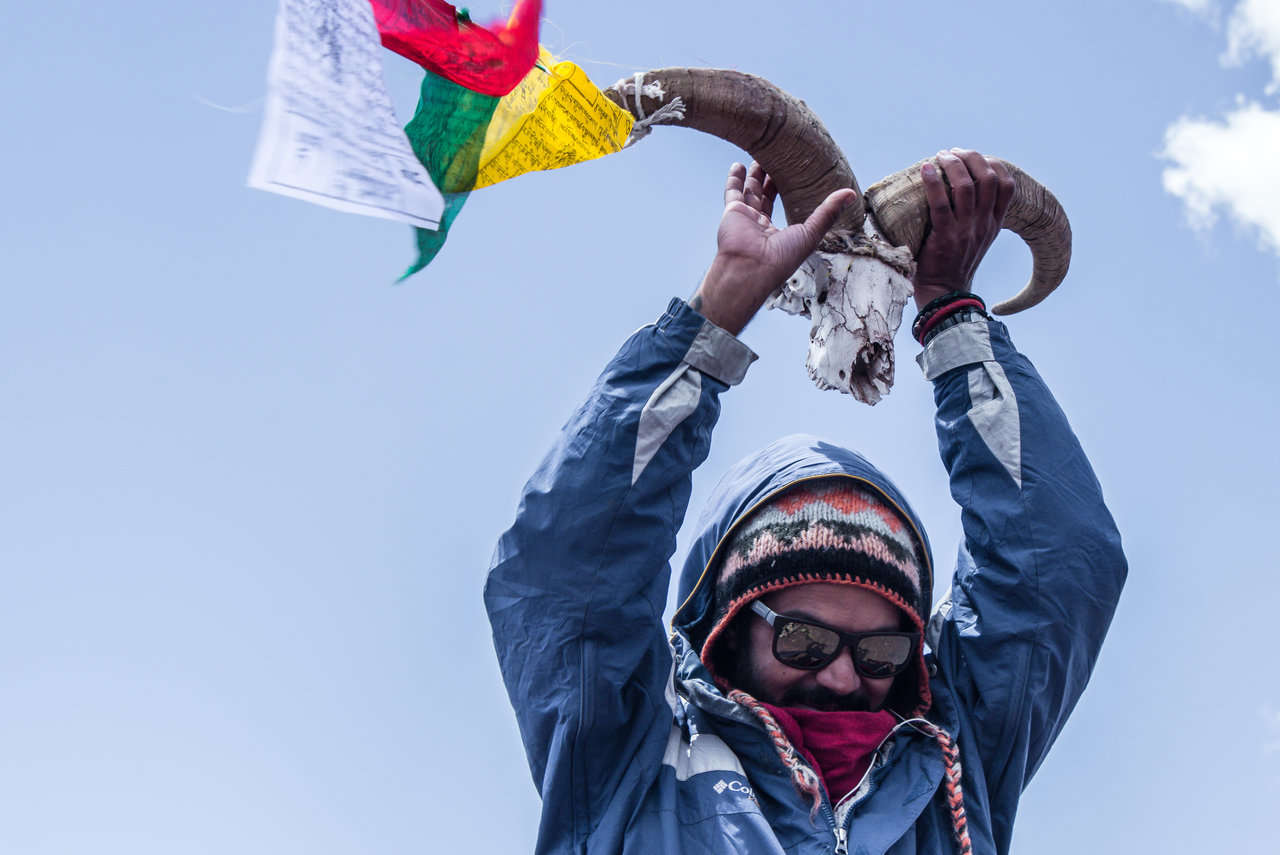
Related Tours
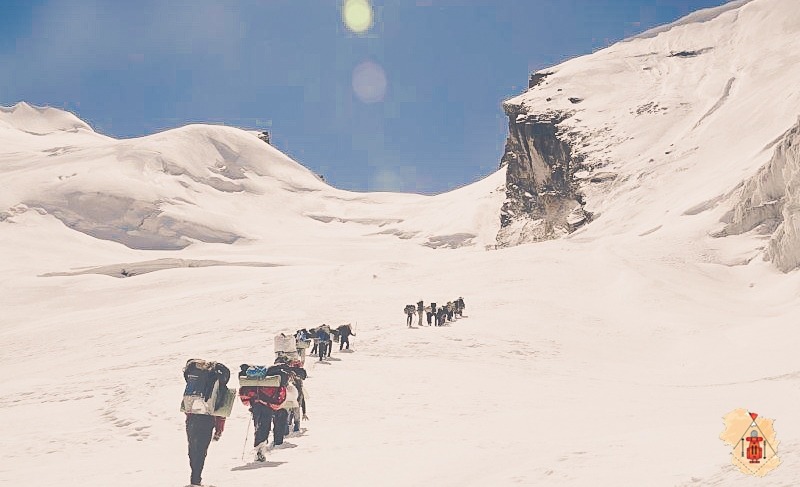
Auden's Col Trek
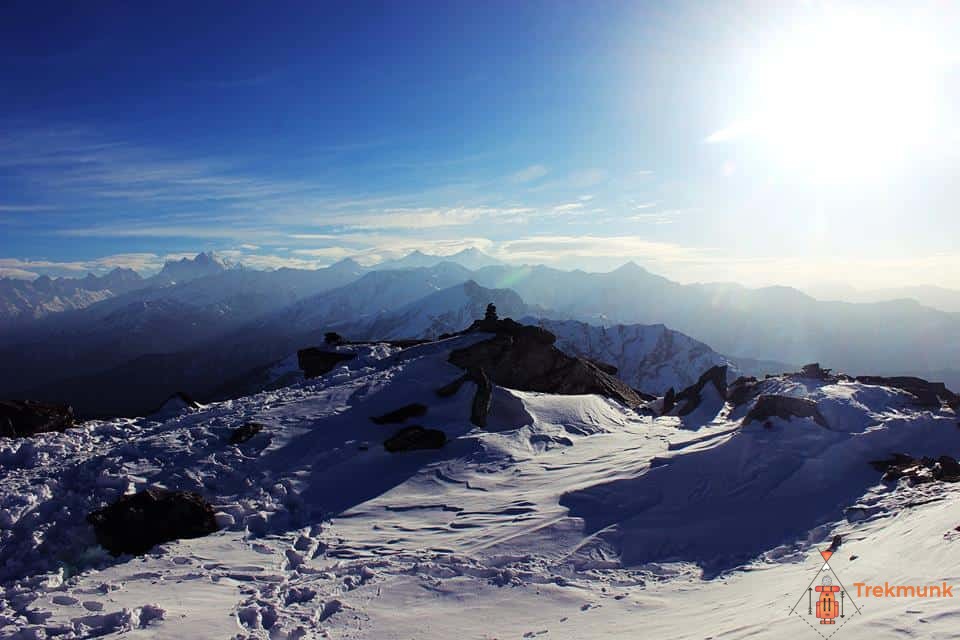
Kedarkantha Trek
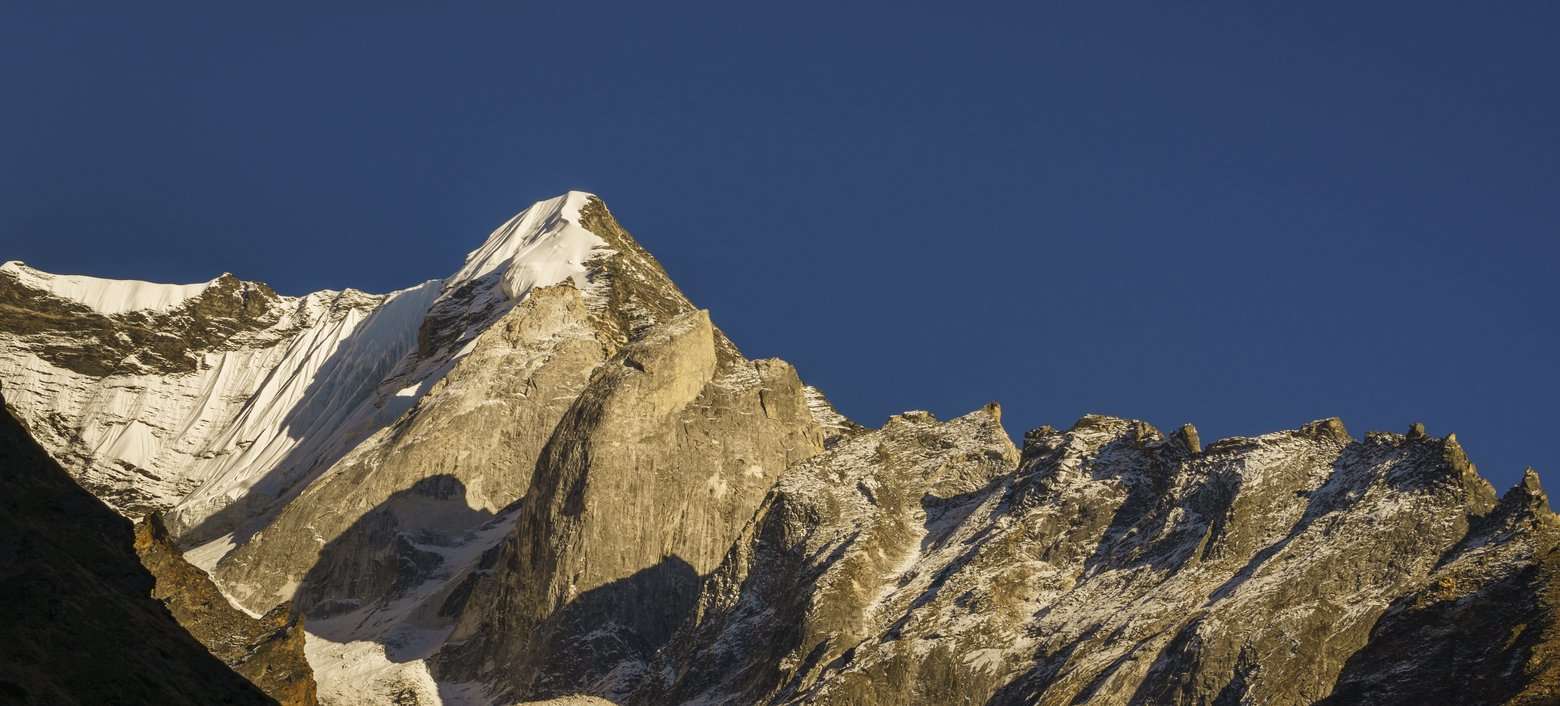
Kedartal Trek
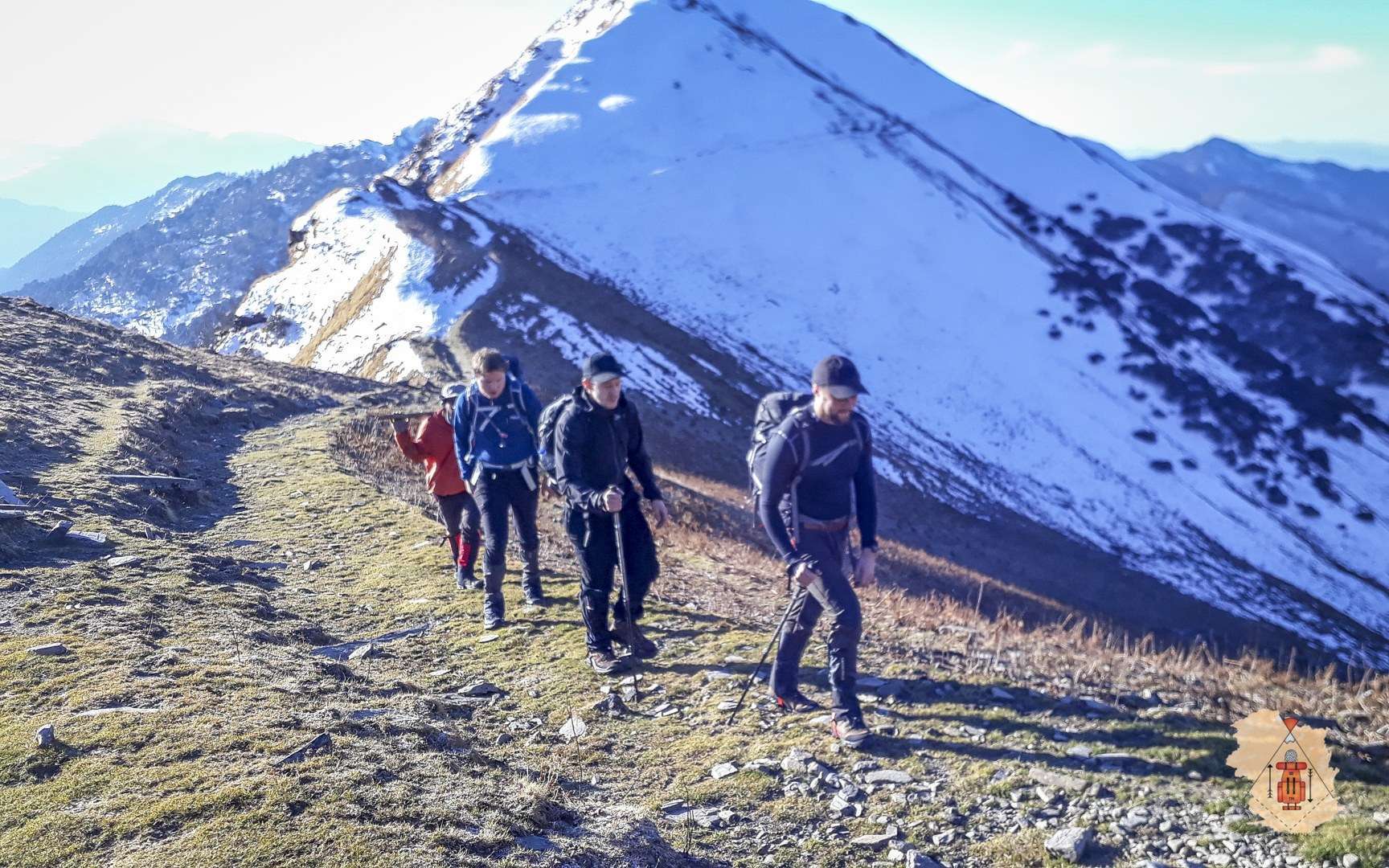
Kuari Pass Trek
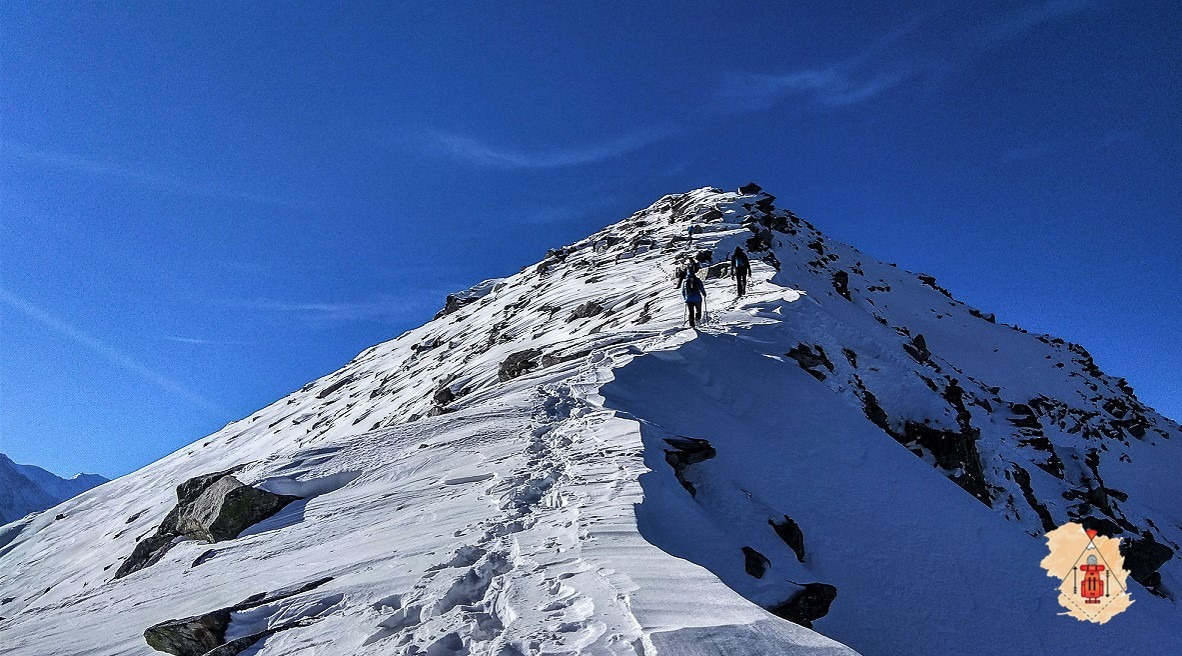
Pangarchulla Summit Trek
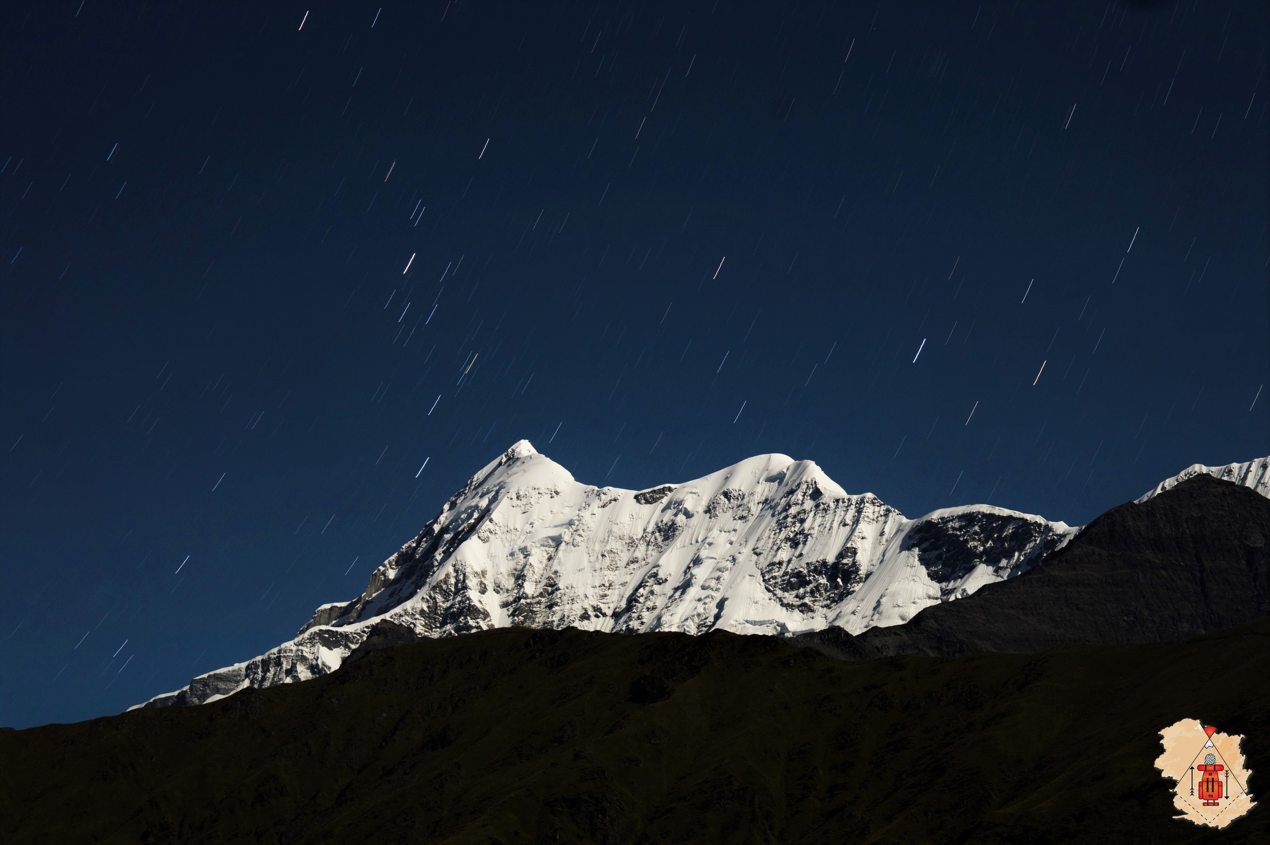
Roopkund Trek
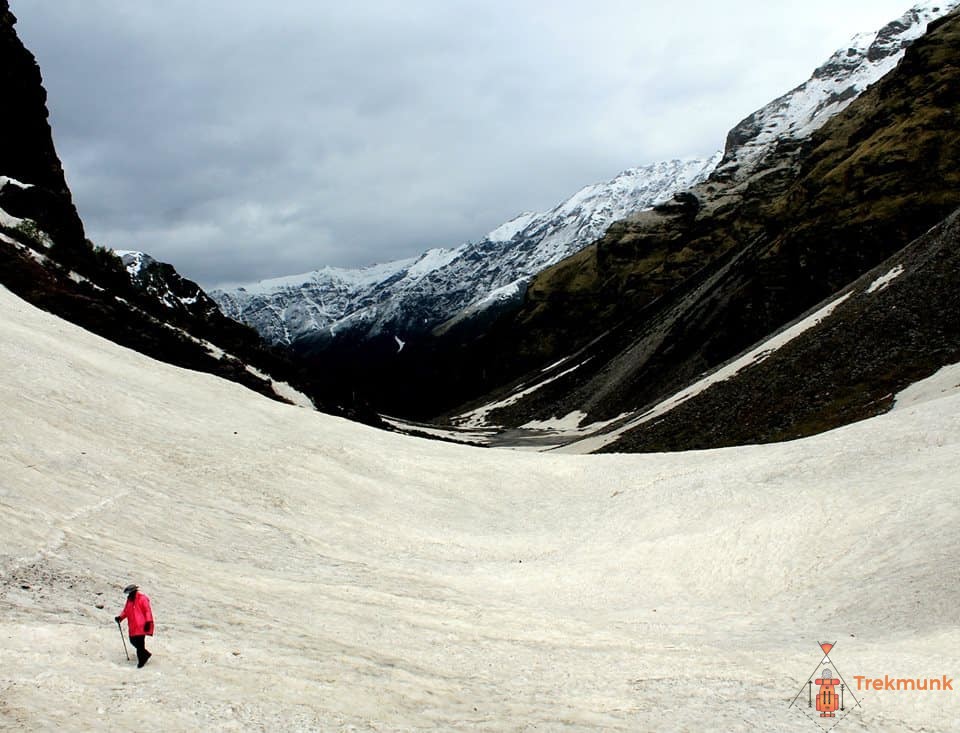
Rupin Pass Trek

"Trekmunk is changing the indian trekking industry"
"10 Most Promising Adventure Sporting and Trekking Companies - 2020"

" Things you do for the Passion for Travel"
Hello there, How can we help you ?
Timing: 10 am to 6 pm IST (GMT +5:30)
Whats App Us
Discover Satopanth Lake Trek: Unforgettable Adventure
Dear Trekkers,
Are you looking for a thrilling and breathtaking trekking experience? Look no further than the Satopanth Lake Trek in India. Located in the Chamoli district of Uttarakhand , this trek offers a journey through stunning landscapes and awe-inspiring views, culminating in the magnificent Satopanth Lake. Imagine standing before a crystal-clear lake reflecting the majestic Himalayan peaks, that's the awe-inspiring Satopanth Lake .
.webp)
This a brand new trek started by us and we encourage each of you to embark on this stunning adventure that is the Satopanth Lake Trek. We are thrilled to announce that the trek opens on 28th May - 16th June and we can’t wait to present another wonderful trek for all of you!!!
How The Journey Unfolds
.webp)
The trek starts from the picturesque town of Badrinath and takes you through Mana village, believed to be the last inhabited village before the Indo-China border. The village is steeped in mythology and is believed to be the abode of the Pandavas during their exile. The trek then ascends through the Vasudhara Falls, a stunning 400-foot waterfall, and the Swargarohini base camp, which offers breathtaking views of the surrounding peaks.
The highlight of the trek is undoubtedly Satopanth Lake, a glacial lake located at an altitude of 14,100 feet. According to Hindu mythology, the lake is believed to be the meeting point of Lord Brahma, Lord Vishnu, and Lord Mahesh. The lake's crystal-clear waters reflect the surrounding peaks, making for a truly awe-inspiring sight. The lake is also considered sacred by the locals, and it is said that a dip in its waters can wash away sins.
The trek takes you through lush green forests, rocky terrain, and snow-capped peaks, making for a truly diverse and exhilarating experience. The trail is approximately 38 kilometres long and takes around 6 days to complete, with altitudes ranging from 4,500 to 14,000 feet.
Why We Suggest The Satopanth Lake Trek To Everyone
Step Into The Mythical World Of The Pandavas With A Visit To Mana Village
.webp)
The trek starts from the picturesque town of Badrinath and takes you through Mana Village, which is believed to be the last inhabited village before the Indo-China border. The village is steeped in mythology and is said to be the abode of the Pandavas during their exile. The village is also home to the Vyas Gufa, where the ancient sage Ved Vyasa is believed to have composed the epic Mahabharata.
Experience The Beauty And Serenity Of The Himalayas
.webp)
The trek takes you through lush green forests, rocky terrain, and snow-capped peaks, making for a truly diverse and exhilarating experience. The region is also home to a wide variety of flora and fauna, including the elusive snow leopard.
Embark On A Journey Of Discovery As You Witness The Ethereal Beauty Of Vasudhara Falls
The trek ascends through the Vasudhara Falls, a stunning 400-foot waterfall. The falls are said to be named after the legendary queen of the Pandavas, who is believed to have taken a dip in the falls.
Challenge Yourself And Discover The Sacred Beauty Of Satopanth Lake
.webp)
Satopanth Lake is undoubtedly the main highlight of the trek. The lake is located at an altitude of 14,000 ft and it is a true natural wonder and a sight to behold. According to Hindu mythology, Satopanth Lake is the meeting point of Lord Brahma, Lord Vishnu, and Lord Mahesh, adding to the mystique and spiritual significance of the trek. The Satopanth Lake is considered sacred by the locals and believed to wash away sins, making it an experience that is both awe-inspiring and spiritually uplifting. The Satopanth Lake is not just a destination, it's an experience of a lifetime that will leave you with memories to cherish forever.
Witness The Resilience And Adaptability Of The Bhotiya Tribe
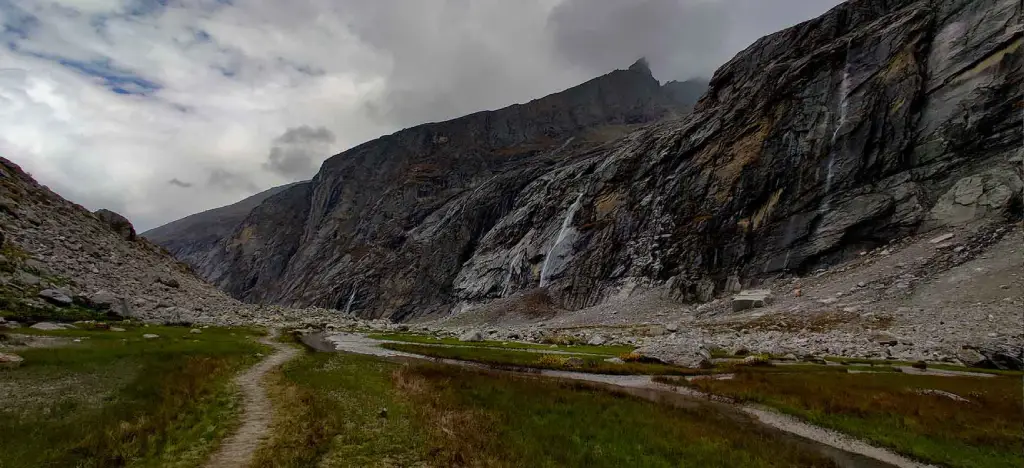
The region is home to the Bhotiya tribe, who have a rich cultural heritage and a unique way of life. The locals are warm and hospitable and offer a glimpse into their traditions and customs. The trek offers the opportunity to interact with the locals and experience their way of life.
The Satopanth Lake Trek is a truly remarkable experience that offers a journey through stunning landscapes, rich culture, and mythology. The trek is a must-do for adventure enthusiasts looking for a challenging and rewarding experience. So, pack your bags and head out on this journey of a lifetime!
Happy trekking!!!!
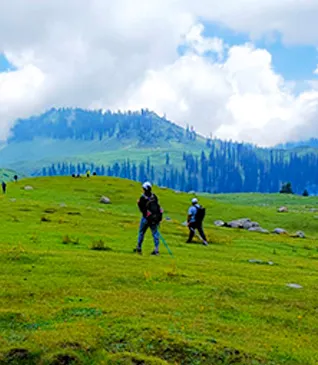
Doodhpathri Trek
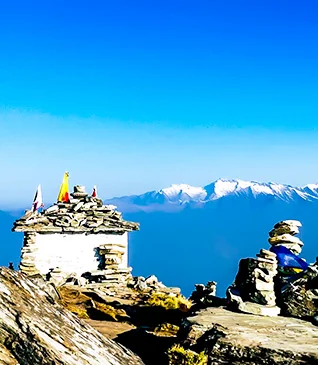
Chopta Chandrashila Tungnath Trek with Deorital
Uttarakhand
.webp)
Ranthan Kharak Trek
.webp)
Nafran Valley Trek
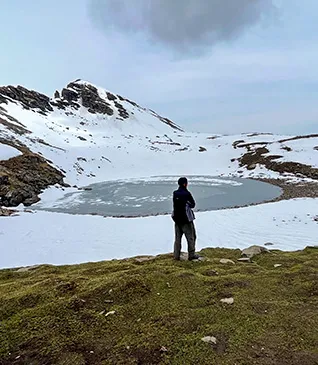
Bhrigu Lake Trek
Himachal Pradesh
.webp)
Dayara Bugyal Trek
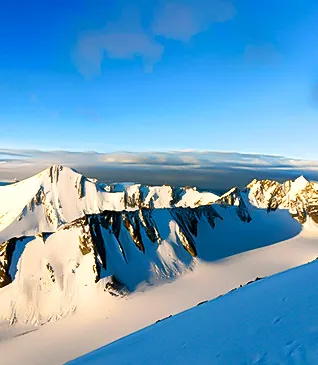
Twin Peak - Kang Yatse II, Dzo Jongo, Markha Valley Trek
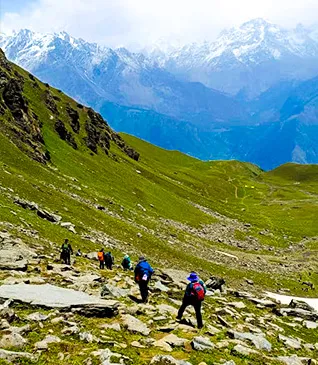
Sar Pass Trek
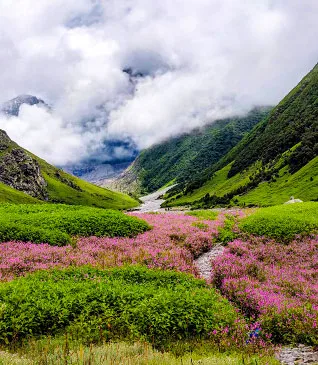
Valley of Flowers Trek
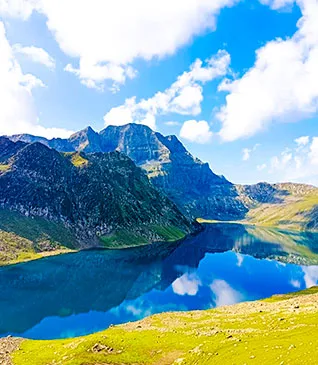
Tarsar Marsar Trek
.webp)
Rupin Pass Trek
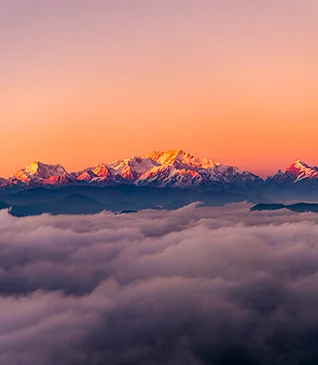
Sandakphu Trek
West Bengal
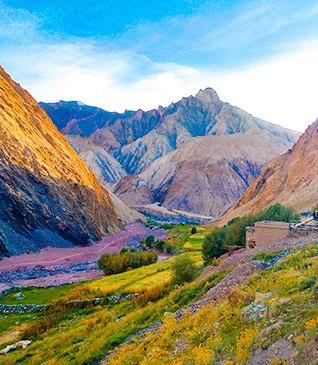
Markha Valley Trek
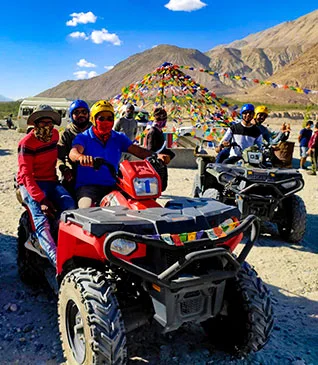
Leh Ladakh Multi-Sports Trip
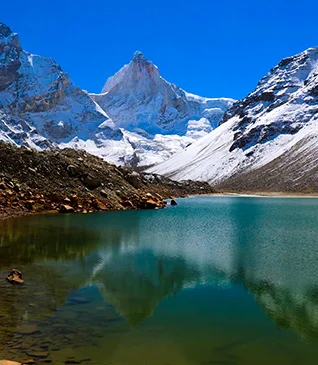
Kedar Tal Trek
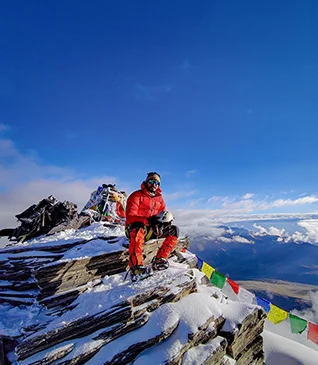
Kang Yatse II Peak Trek Expedition
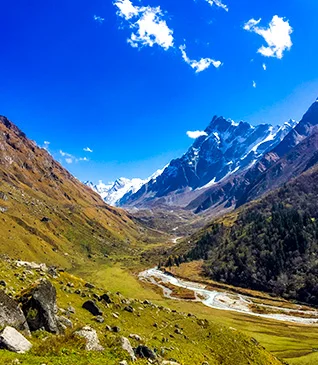
Har Ki Doon Trek
.webp)
Hampta Pass Trek
.webp)
Gaumukh Tapovan Trek
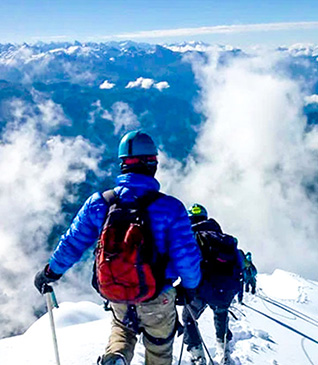
Friendship Peak Expedition
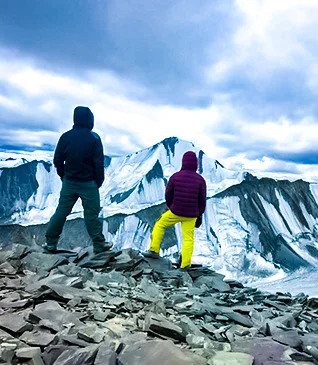
Dzo Jongo Peak Trek Expedition
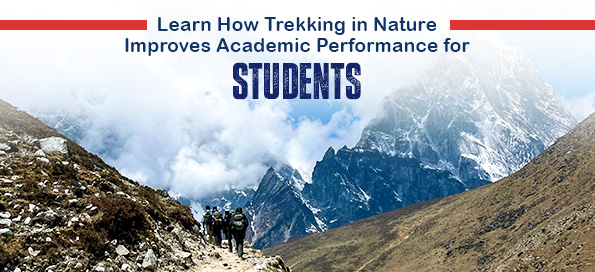
Learn How Trekking in Nature Improves Academic Performance for Students
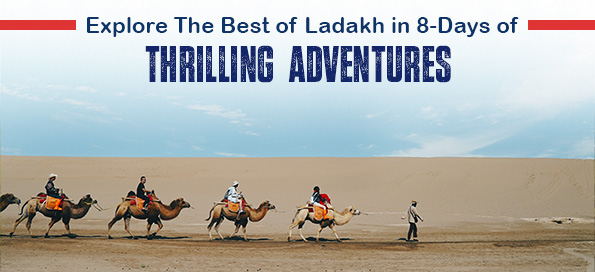
Explore The Best of Ladakh tour Package in 8-Days of Thrilling Adventures
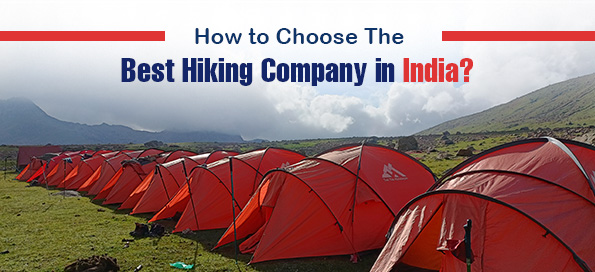
How to Choose The Best Hiking Company in India?
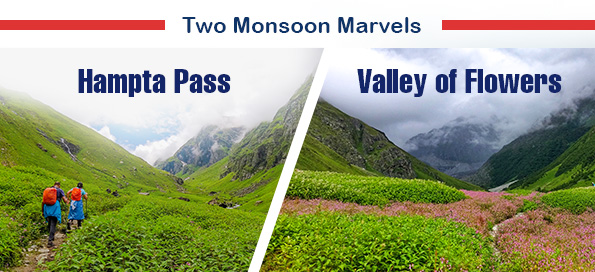
Two Monsoon Marvels – Valley of Flowers & Hampta Pass Trek
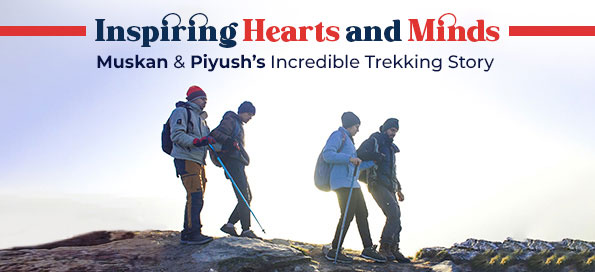
Inspiring Hearts and Minds – Muskan & Piyush’s Incredible Trekking Story
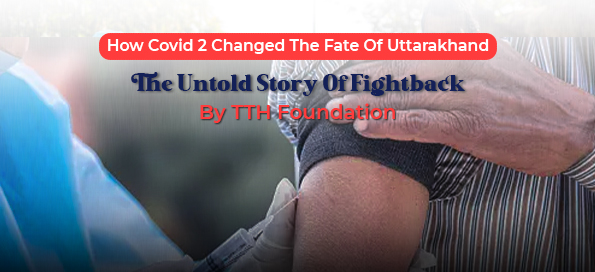
How Covid 2 Changed The Fate Of Uttarakhand & The Untold Story Of Fightback By TTH Foundation
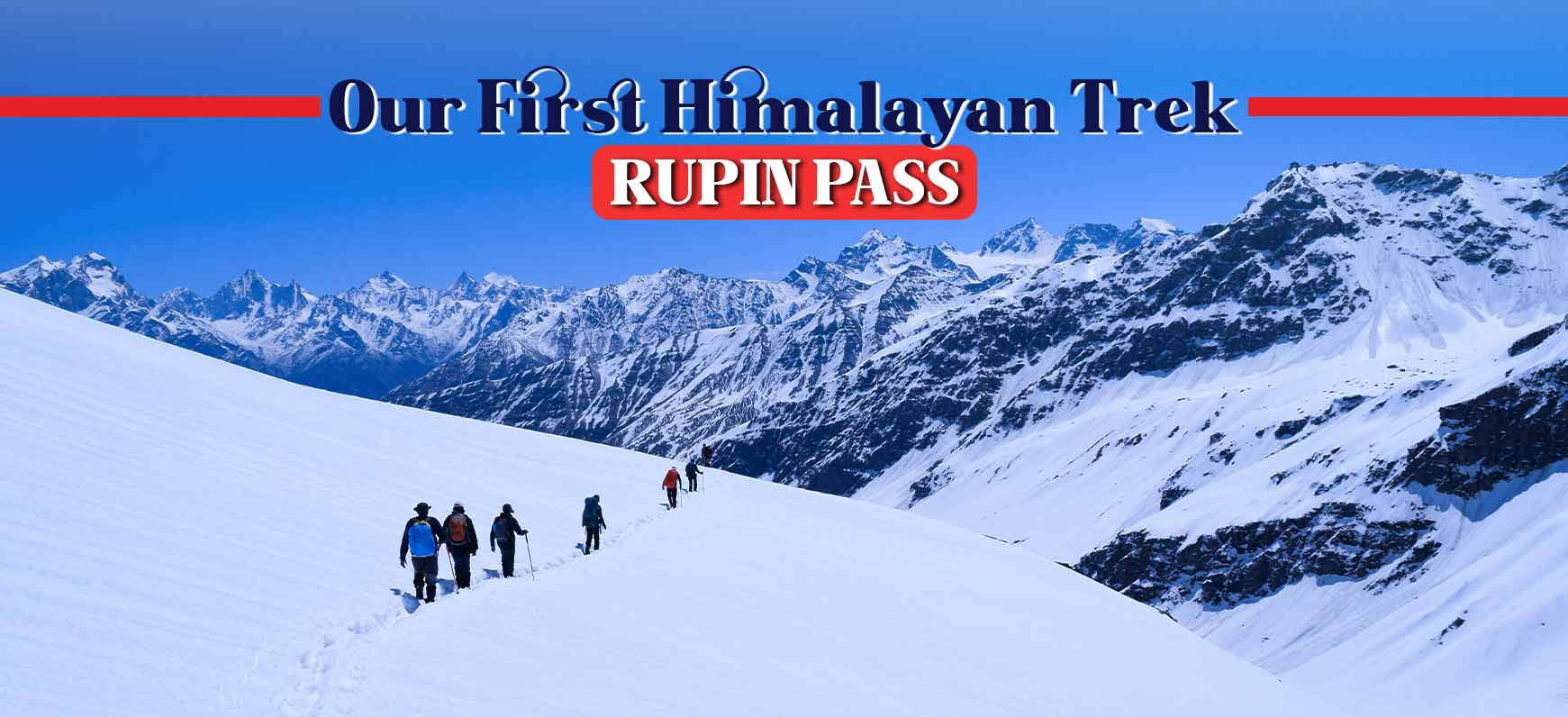
Our First Himalayan Trek - RUPIN PASS Trek
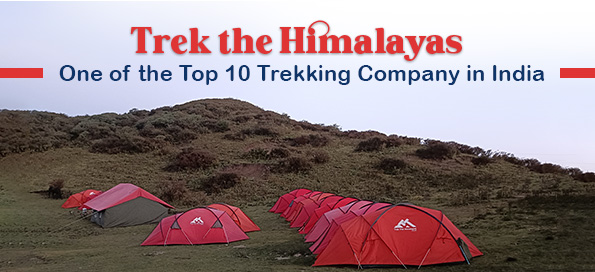
Trek The Himalayas - One of the Top 10 Trekking Company in India
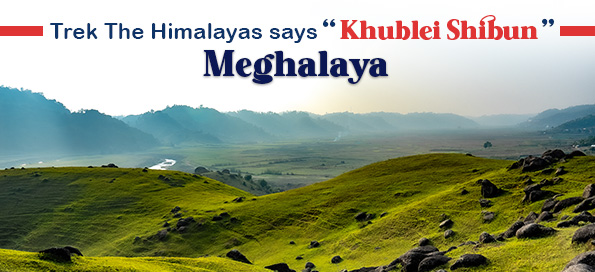
Trek The Himalayas Says “Khublei Shibun” Meghalaya!
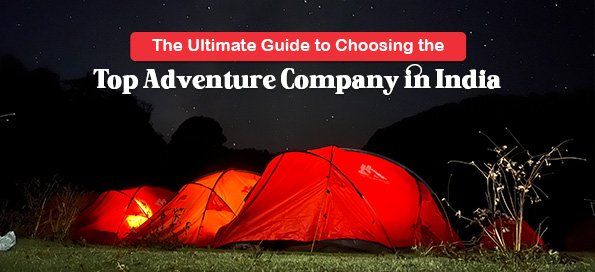
The Ultimate Guide to Choosing the Top Adventure Company in India
Rent A Gear
Trek Articles
Quick Links
Trekking & Hiking
Mountaineering
Multi Sports
Himalayan Pilgrimage
Website Privacy
Terms & Condition
Contact Info
Get in touch with us. E-mail us Monday-Saturday (10 AM to 6 PM)
Address: Trek The Himalayas, Kaintura Plaza, Badrinath Road Tapovan, Rishikesh - 249201 Uttarakhand
Phone: 8191004846
Email: [email protected]
2010 Trek The Himalayas. All rights reserved
Journey to the Sacred: The Satopanth Tal Trek in the Garhwal Himalayas
The Satopanth Tal Trek is a soul-stirring pilgrimage into the sacred landscapes of the Garhwal Himalayas, where pristine glacial lakes, towering peaks, and spiritual legends converge. Nestled in Uttarakhand, India, this trek commences from the pilgrimage town of Badrinath and unfolds as a journey through rugged terrains and high-altitude wonders.
The trail winds through enchanting forests, revealing the majestic Neelkanth Peak and the mystical Mana village, considered the last inhabited village on the Indo-Tibetan border. As trekkers ascend, the landscapes transform into vast meadows adorned with vibrant wildflowers, leading to the pristine Satopanth Tal at an elevation of around 4,402 meters.
Satopanth Tal, believed to be the abode of the Trimurti—Brahma, Vishnu, and Shiva, is surrounded by towering peaks, including Chaukhamba and Neelkanth. The crystal-clear waters mirror the Himalayan grandeur, creating a serene ambiance that invites introspection and spiritual connection.
The Satopanth Tal Trek is not just a physical challenge; it’s a cultural and spiritual odyssey. Trekkers encounter ancient temples, witness the sacred confluence of three rivers, and immerse themselves in the timeless myths of the region. The trek stands as a pilgrimage for those seeking a blend of adventure, spirituality, and the pristine beauty of Uttarakhand’s high-altitude landscapes.
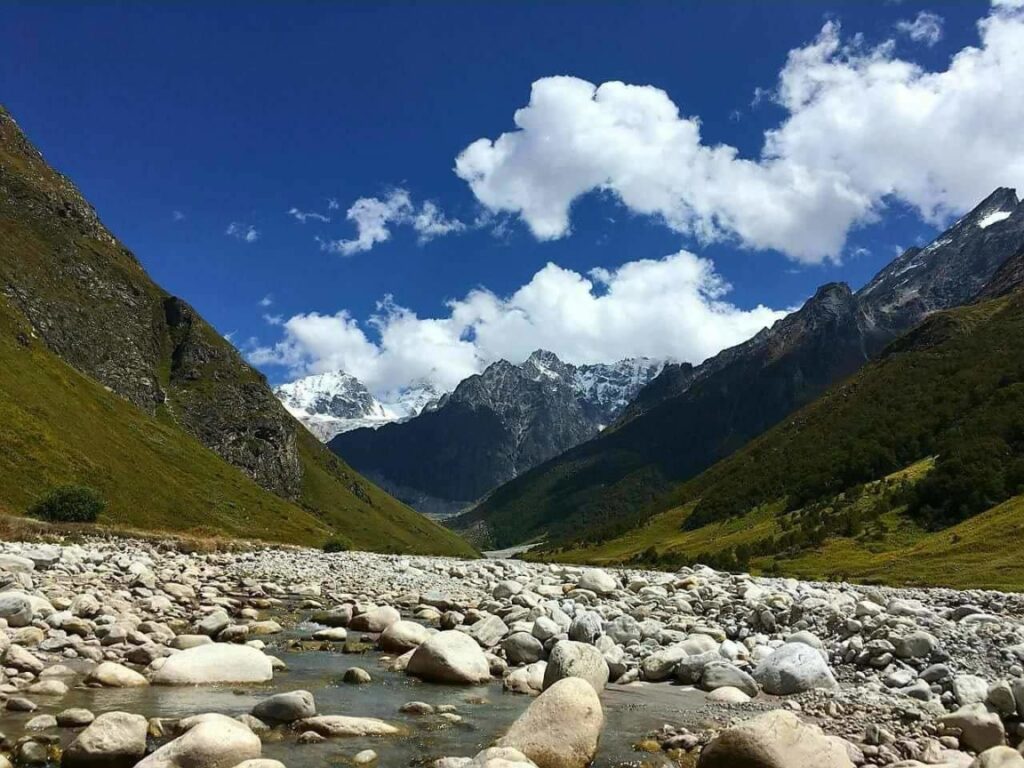
Upcoming Treks to Satopanth Tal
Satopanth Lake Trek
A Trek to an Enchanting Lake in the Shadow of Giant Mountains
Available Batches
September 2024, october 2024.
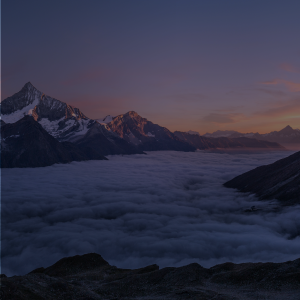
Brief Description
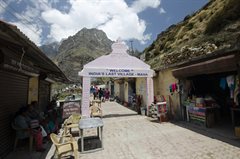
Brief Itinerary
Detailed itinerary.
Badrinath to Laxmiban (12,000 ft) - 7.3 km (Click to View GPS data)
We start our day with an easy walk up the Alakananda river towards the Somtoli meadows. You will see the mighty 400 ft Vasudhara falls on the opposite banks after a while. The trail climbs gradually till Somtoli, crossing a landslide section. You might find few shepherds here or their vacant caves. From here, a small walk through a boulder section takes us to our campsite marked by a cluster of Bhojpatra trees on the slopes. The campsite has great views of Alkapuri, the snout and starting point of Alaknanda river and the Balakun peak.
Laxmiban to Chakrateerth (13658 ft) - 7.0 km (Click to View GPS data)
The trail gets more challenging today. We will start with a sharp ascent through boulders and scree to Sahastra Dhar. As we climb up the valley, views of NIlkanth, Balakun and Chaukhamba open up. Once we reach Sahastra Dhar, we will cross a little stream and walk across a flat area with dozens of streams flowing and merging with each other. Then, we start traversing the left (true right) lateral moraine of the glacier coming down from Chaukhamba at the head of the valley. The trail climbs steeply again after Sahastra Dhar, followed by a short level walk across the upper snow slopes to reach our campsite at Chakrateerth. We will camp in Chakrateerth for the night.
Chakrateerth to Satopanth Lake (14258 ft) to Chakrateerth - 4.9 km (Click to View GPS data)
Although today's trail is short with an easy ascent, the trail goes through tricky boulder sections along the left (true right) lateral moraine. We will cross two spurs coming down from the slopes of Nilkanth to our left (true right) to reach Satopanth Lake - a beautiful blue triangular lake. Throughout the day, we will have imposing views of Chaukhamba and Nilkantha, and a bunch of small glacial lakes to our right. After spending some time at the lake, we will return to Chakrateerth for the night.
Chakrateerth to Chamtoli (11745 ft) - 8 km (Click to View GPS data)
We retrace our track today and reach Chamtoli, where we will camp for the night.
Chamtoli to Mana - 10.2 km. Drive to Joshimath. (Click to View GPS data)
We will finish the remaining descent today and then drive from Mana to Joshimath. Overnight stay in hotel/guest house
What's Included
- Food as per menu on the trek (Lunch on Day 2 till Lunch on Day 7)
- Forest Permits/Camping Charges, if any (upto the amount charged for Indian nationals)
- Tents, Sleeping bags, Sleeping mats
- Micro-spikes, Gaiters, and Helmets as required
- Experienced Trek guide, cook, helpers, and porters for carrying common supplies
- Mountaineering course certified Trek Leader with First Aid certification
- Guesthouse/Hotel accommodation (twin/triple sharing) in Joshimath on Day 1 and Day 7
- Guesthouse/Hotel accommodation (twin/triple sharing) in Badrinath on Day 2
What's Not Included
- Portage of personal bags during the trek
- Cost of any kind of Travel Insurance.
- Any Expense of personal nature.
- Any Expense not specified in the inclusions list.
- Meals during road journeys
Are you Eligible for this Adventure?
Max Altitude

BRS Level Required
Satopanth Lake Trek is a level 4 adventure on the Bikat Rating Scale.
This makes it mandatory for you to have high-altitude experience of preferably multiple treks marked at level 5 on the BRS. The altitude, the terrain and the nature of the climb demand a certain level of skill and a need for you to be aware of how your body reacts to the various features of high altitude environment.
If you do not know what level of BRS trek would suit you best, worry not! Fill out this Form:

we will send you a progression chart to help you comfortably get out of your comfort zone in order to level up and ultimately reach your highest potential in the big, bad world of outdoor adventure.
Packing List
This is a list of essential items for individuals doing the trek with Bikat Adventures. This list contains only those items which the participants are required to bring with them. The list excludes those items which are provided by Bikat Adventures on the trek. We have divided the items into five categories. All the items in the list are essential except for those marked as optional.
Trekking Gear
- Ruck sack bag with rain cover. Qty -1
- Day Pack Bag - Recommended for treks with summit day
- Head Torch with spare Batteries. Qty -1
- U V protection sunglasses. Qty -1 Here is how you can choose the best sunglasses for trekking.
- Water Bottles: 2 bottles of 1 liter each
- Non-skid, deep treaded, high-ankle trekking shoes Qty -1
- Pair of light weight Slipper/Sandals Qty -1
- Quick Dry Warm lower or Track Pants. Qty - 2
- Full sleeves T-shirts/ Sweatshirts. 1 for every 2 days of trekking
- Pair of thick woolen socks. 1 pair for every two days of trekking
- Thermal Body warmer Upper & Lower. Qty-1
- Undergarments. Qty - 1 for every day of trekking
- Warm jacket closed at wrist & neck .Qty-1
- Full sleeves sweater. Qty -1
- Rain wear ( Jacket & Pants ) . Qty-1
- Pair of waterproof, warm gloves. Qty-1
- Woolen cap. Qty-1
- Sun shielding Hat. Qty -1
- Personal toiletries kit (Small Towel, Toilet paper, paper soap, Bar soap, toothbrush, toothpaste, cold cream, etc.)
- Sun screen lotion small pack. Qty -1 Here is your Sun Protection 101 to stay safe in the bright sunny outdoors.
- Lip Balm small pack. Qty-1
- Small size, Light weight & Leak proof lunch box. Qty-1
- Plate. Qty- 1
- Spoon.Qty-1
- Tea/Coffee (plastic) Mug.Qty-1
Miscellaneous
- Camera (Optional)
- Carry your medicines in plenty in case you have any specific ailment. Consult your doctor before joining the trek.
- Dry fruits, Nuts, Chocolate bars (Optional)
Frequently Asked Questions
Eligibility, is this adventure good for me, what’s a good fitness benchmark for this adventure, what skills do i need to complete this adventure, what is the minimum and maximum age limit, about the activity, where is it located, what are some of its highlights, what are some of its challenges, what is the best season for this, what is the accommodation type, what is the temperature like here, is it technically challenging, connectivity, how do i reach the starting point, is there cellular network available throughout, where is the nearest atm, if i choose to travel to the base with you, what is the pick-up point, what time is the drop-off on the last day, what are the nearby attractions that i can explore, equipment & gear, what equipment is provided to us, what can i rent from you, where will i receive the rented items, where do i have to return the rented items, what gear do i need to bring, are there local shops to rent/buy equipment, facilities & additional services, can i offload my bag, can i leave any extra luggage i carry at the base of this adventure, what are the meals like, what are the washroom/ toilet facilities like, what should i do if i get my period on this adventure, what are the medical facilities available to me on this adventure, are there any electricity charging points on this adventure, mandatory documents, what documents do i need to carry, do i need insurance for this, do i need a permit for this, certification, do you provide a certificate of completion, when and how will i get the certificate of completion, international travel, will i need a visa, when should i apply for the visa, what kinds of insurance do i need to travel here, what is the specialty of this when compared to other mountain ranges, till which month can i make a booking for this, what is the qualification of the outdoor leader provided to us, how do you choose your outdoor leaders, is it safe for women, what is the ratio of outdoor leader to participants, what do you do in case of an emergency, what are the rescue options on this adventure, how do you choose your equipment, can i attempt this adventure if i have a specific medical condition, sustainability, what kind of camping do you practice on your outdoor adventures, why are you against fixed camping in the outdoors, how do you manage overcrowding on certain trails, what are some things to remember when using a dry toilet, why should i avoid wet wipes in the outdoors, where should i dispose of my sanitary waste if i am on my period, why should i carry my own utensils on an outdoor adventure, booking process, what happens after i make the payment, do you create a whatsapp group of participants before the start date of the activity, do i need to submit a medical certificate, do i need to submit an undertaking form.
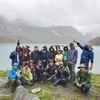
Small Group Size
Our batch sizes are capped at 15 for smaller treks with the trek leader and trekker ratio of 1:8. This ratio, in our years of experience, has proven to deliver the best trekking experience for individuals as well as groups. Capping the size of the group ensures individual attention to each trekker so that no signs of distress or need during the trek go unnoticed. It also helps to form a more cohesive cohort with better group energy which helps define the rhythm and pace of days on the trek. As you go higher up on the BRS scale, since the stakes are higher, expeditions have an even smaller group size with the ratio of expedition leader to climber set at 1:2.
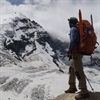
Qualified Trek Leaders
We follow a rigorous regime of hiring and training our experts in the field. Each trek leader is a certified mountaineer with years of experience in the field. In addition to their qualification, they also go through practical and situational training to tackle any and all kinds of sudden conditions that may present themselves on the ground. Being unpredictable is the core nature of the mountains but being ready for any circumstance as best as possible is a controllable asset that we try to nurture. Our field experts are also trained in basic medicine and first-aid response. Watch: Forerunners - The Making of A Trek Leader At Bikat Adventures
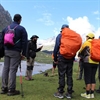
Guided Progression
Since Bikat Adventures is a learning-based organization, we help you climb up the ladder of difficulty within the sphere of outdoor adventure systematically. Our on-ground training modules are designed to handhold you through the upskilling process so that you are ready to take on bigger challenges.
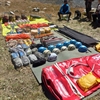
Equipment Quality and Check
All the gear used on our treks and expeditions is tried and tested, maintained for good quality, and is overall top-notch in quality and condition. We are continually looking to obtain the best of everything there is in the market so as to ensure optimum safety.
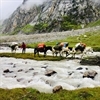
Support Systems
Along with the staff you see on-ground, we have a team of superheroes working in the background to give you the best experience possible. Our background team also comprises local staff from each area who know the region best. Having local support helps with studying the area, pre-planning, execution, and in receiving timely support in case of emergencies in these remote locations.

Communication
Our on-field staff is in constant contact with our teams based in primary locations so as to eliminate any avoidable delay in reaching additional help and support when required. We try to use the best tools for communication available, including satellite phones, in regions where they are not restricted.
What our customers Say

Cancellation Policy
Cash refund
Cancellations up to 30 days prior to departure date
5% deduction
Cancellations between 30 days to 15 days prior to departure date
50% deduction
Cancellations within 15 days prior to departure date
Voucher refund
Cancellations up to 5 days prior to departure date
No Deduction
Cancellations within 5 days prior to departure date
- Cash refund is applicable only in case of bookings made without using any promotional offer code or vouchers
- This is only a brief of cancellation terms. For finer details please refer Detailed Cancellation Policy.
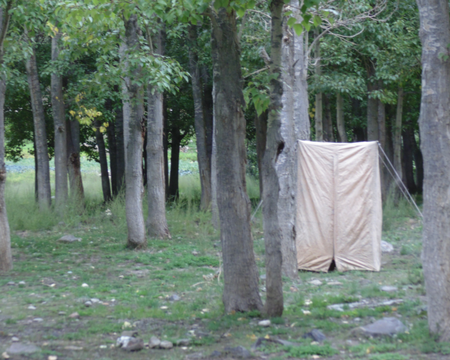
Subscribe for latest updates & offers
Similar adventures.
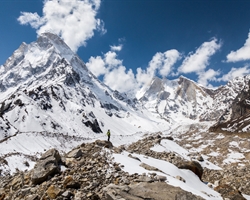
Gaumukh Tapovan Trek
Not just a trek but a journey to the source of river ganga.
Uttarakhand
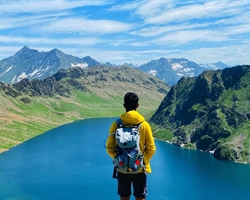
Tarsar Marsar Trek
A shorter and easier alternative to the kashmir great lakes trek.
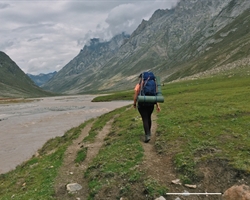
Miyar Valley Trek
The yosemite of the himalayas, enter your email, events by categories.

Mountaineering

Scuba Diving
Events by months.
- January July
- February August
- March September
- April October
- May November
- June December
Events By Nights
- 5 & More Night
- Environmental Policy
- Privacy Policy
- Term & Conditions
- Work With Us
- Address: 303, 3rd Floor, Tower B4, Spaze Itech Park, Sector 49. Gurgaon
- Pre Sale - 7838148127 , Post Sale - 8588878499, 9667639126
Bikat Adventures
- Cancellation & Refunds
- Content Sharing

© 2024 Bikat Adventures - All Rights Reserved
Powered by: novel knett software solutions, submit enquiry.
Screen Rant
12 amazing characters discovery gave star trek.

Your changes have been saved
Email Is sent
Please verify your email address.
You’ve reached your account maximum for followed topics.
Star Trek: Discovery's Tig Notaro Talks Season 5, Her Casting Story, And Jett Reno's Future
Star trek: discovery proves starfleet academy show doesn’t make sense without tilly, 8 sins section 31’s emperor georgiou committed on star trek: discovery.
Warning: This list contains SPOILERS for Star Trek: Discovery Season 5
- Star Trek: Discovery introduced compelling characters like Captain Burnham, helping to reinvent the classic franchise for contemporary audiences.
- Characters like Commander Jett Reno and Adira Tal added depth and diversity to the Star Trek universe, becoming fan favorites.
- Captain Michael Burnham's journey from mutineer to Admiral showcased her intelligence, determination, and compassion, making her an unforgettable Star Trek Captain.
Star Trek: Discovery added some truly amazing characters to the Star Trek universe. Over the course of its five seasons, Discovery has been many different shows, from a dark and complex drama to an Indiana Jones-style adventure. But at its heart, it's always been the story of Captain Michael Burnham (Sonequa Martin-Green) and the people around her. Burnham has changed perhaps more than any other character on Star Trek: Discovery , going from Starfleet's first mutineer to Captain of the USS Discovery .
Since the premiere of Star Trek: The Original Series in 1966, the Star Trek franchise has always excelled at creating compelling and likable characters, and Star Trek: Discovery is no exception. While it can be argued that Discovery 's plotlines have been relentlessly paced and action-oriented, Disco 's endearing characters have kept the show going. Captain Burnham was Star Trek: Discovery's heart, but the show wouldn't have worked without all of the wonderful characters around her. The crew members of the USS Discovery have been through a lot in the show's five seasons, and hopefully, some of their stories will continue in future Star Trek projects.
Not only did Star Trek : Discovery introduce incredible new characters, but the show also reinvented classic characters like Captain Christopher Pike (Anson Mount), Lt. Spock (Ethan Peck), and Number One (Rebecca Romijn), with pitch-perfect casting.
Star Trek: Discovery Season 6 Or Movie - Everything We Know
Star Trek: Discovery season 5 is the final season, but will Captain Burnham and the USS Discovery be back for season 6 or a Paramount+ movie?
12 Eve Harlow as Moll
"i don't need you or your federation.".
Renegade courier Moll made quite an impression as Star Trek: Discovery's latest villain, and she became a thorn in Discovery's side in their search for the Progenitors' technology. Along with her Breen lover and partner in crime, L'ak (Elias Toufexis), Moll caused numerous problems for Discovery — including trapping the ship in a time loop — but she was ultimately just trying to build a life with the man she loved.
It remains to be seen what Moll's Star Trek future holds.
After L'ak's tragic death, Moll tried desperately to resurrect him, but even the Progenitors' technology was not capable of that. By the end of Discovery season 5, Moll has lost her beloved husband and is preparing to spend time in a Federation prison. Dr. Kovich (David Cronenberg), however, has other plans for her, which are all the more interesting considering Kovich's true identity as Temporal Agent Daniels. It remains to be seen what Moll's Star Trek future holds, but the character could certainly have more stories to tell.
11 Callum Keith Rennie as Captain/Commander Rayner
"oh, come on. spare me the 'i get you' bull****.".
Captain Rayner joined the USS Discovery's crew in Star Trek: Discovery season 5, and his "crabby" personality contrasted sharply with most of the other characters. For most of his Starfleet career, Rayner had been serving during wartime, and he found it hard to adjust to the Federation's new way of doing things in the post-Burn galaxy. While Burnham was friends with most of Discovery's crew members and always valued their input, Rayner wanted to remain at a distance and do things by the book.
Star Trek: Discovery Season 5's Callum Keith Rennie On Captain Rayner Challenging Burnham's Authority
Screen Rant interviews Callum Keith Rennie about how his new character, Captain Rayner, fits into Star Trek: Discovery season 5.
Still, Rayner was a good man and a great Starfleet officer, and his gruff attitude warmed up over time, as he and Discovery's crew developed a mutual respect for one another. Rayner brought new energy to Star Trek: Discovery, which worked well when paired with more energetic and optimistic characters like Lt. Sylvia Tilly (Mary Wiseman). Like Moll, Rayner's Star Trek journey seems far from over, and he will hopefully pop up in a future Star Trek project.
10 Jason Isaacs as Captain Gabriel Lorca
"i have been to another universe and back. you think i'd come all this way without a plan".
Despite being from the Mirror Universe, Captain Gabriel Lorca was able to pass as his Prime Universe self long enough to bring the USS Discovery back to the Mirror Universe. The reveal that Lorca was from this evil parallel universe was one of Star Trek: Discovery's best twists, and Jason Isaacs made the character incredibly compelling. Although Lorca only survived for one season, he remains one of Star Trek: Discovery's best villains .
Michael Burnham and the rest of the USS Discovery's crew were deeply affected by Lorca's betrayal and his later death at the hands of Emperor Philippa Georgiou (Michelle Yeoh). The fate of the Prime Universe Lorca remains unknown, although some speculated that it would have been extremely difficult for him to have survived long in the brutal Mirror Universe. Still, anything is possible in Star Trek, and it would be fun to see Isaacs return as any version of Lorca.
9 Tig Notaro as Commander Jett Reno
"i can fix stuff with duct tape, if you want.".
With a fascinating backstory and a delightfully cynical personality, Commander Jett Reno became one of Star Trek: Discovery's best recurring characters. As an engineer on the USS Discovery, Reno helped Commander Paul Stamets (Anthony Rapp) keep the starship running and proved invaluable on numerous missions. Reno never failed to remain calm during a crisis and was always ready with a sarcastic remark to cut through the tension.
Like Rayner, Reno's no-nonsense attitude helped balance out the more openly emotional members of Discovery's crew. Jett may not have had much screen time, but she made the most of what she had, establishing herself as one of Discovery's most memorable characters in her every scene. From her dysfunctional friendship with Stamets to her colorful career history, Jett Reno's hilarious commentary will surely be missed.
Screen Rant interviews Star Trek: Discovery's Tig Notaro about playing Commander Jett Reno and how she always gets the funniest lines.
8 Blu del Barrio as Adira Tal
"everyone always picks on the ensign.".
Star Trek: Discovery has added to the richness of the Star Trek universe with its diverse cast, and Blu del Barrio's Adira Tal is a major part of that. With their genius-level intellect and general enthusiasm, Adira became an invaluable member of the USS Discovery's crew. Commander Stamets and his husband, Dr. Hugh Culber (Wilson Cruz), became surrogate parents for Adira, as they struggled to find their place aboard Discovery.
Adira would make a great addition to Star Trek: Starfleet Academy.
Lt. Sylvia Tilly also became a mentor for Adira, helping the young Ensign work through their social awkwardness and lack of confidence. Adira stepped up in Star Trek: Discovery season 5, working on the bridge and aiding in the search for the Progenitors' technology. With their experience and relatability, Adira would make a great addition to Star Trek: Starfleet Academy , but it remains to be seen whether their Star Trek story will continue.
7 David Ajala as Cleveland Booker
"love always ends in grief, but we can't let the pain do this to us.".
Cleveland Booker was the first person Commander Michael Burnham met upon arriving in the 32nd century, and Book became Michael's partner in love and life. A courier from the planet Kwejian, Book spent his days ferrying goods and helping endangered species across the galaxy. After their meet-cute, Book and Burnham continued working together for about a year before the USS Discovery finally arrived through the wormhole into the 32nd century.
Although not officially a member of the USS Discovery's crew, Book helped Starfleet investigate the Burn and the Dark Matter Anomaly. After the DMA destroyed his homeworld, Booker rebelled against the Federation, seeking revenge on the dangerous anomaly and the species that created it. Booker's Star Trek journey has had its fair share of ups and downs, but in the end, he made amends with the Federation and, most importantly, with Michael Burnham, his eventual wife.
In the future glimpsed in the epilogue at the end of Star Trek: Discovery season 5, Burnham and Book have spent their lives together and have a son named Leto (Sawandi Wilson), who serves as a Starfleet Captain.
6 Mary Wiseman as Lt. Sylvia Tilly
"i love feeling feelings.".
When Michael Burnham first met her new roommate, Ensign Sylvia Tilly, it was immediately apparent that the two could not be more different. Still, Tilly and Burnham helped each other throughout Star Trek: Discovery's early days and eventually became best friends. With her enthusiastic and optimistic approach to life, Tilly could find the silver lining in almost any situation, but she also had a brilliant scientific mind. Despite her occasional awkwardness in social situations, Tilly (often with help from Commander Stamets) could find and implement a solution to almost any problem.
Although Tilly initially wanted to pursue a command position, after the USS Discovery traveled to the 32nd century, she found new meaning as an instructor at Starfleet Academy. Tilly strove to connect with and encourage her cadets, and Sylvia eventually became the Academy's longest-tenured instructor. Considering how instrumental Tilly has been in reestablishing Starfleet Academy, the upcoming Starfleet Academy show would feel odd without her, but nothing has been confirmed regarding her presence on that show.
The cast of Star Trek: Starfleet Academy has yet to be announced, but Mary Wiseman's Lieutenant Sylvia Tilly should definitely be a part of it.
5 Wilson Cruz as Dr. Hugh Culber
"i know, i’m a doctor, not a physicist, but… this will work. i can’t explain it, i just feel it.".
As the Chief Medical Officer and counselor of the USS Discovery, Dr. Hugh Culber has had a lot to deal with throughout Star Trek: Discovery 's five seasons. After being killed and resurrected, Culber understandably had difficulty returning to his normal life, but his relationship with Commander Stamets helped him cope. Still, after Discovery traveled to the far future, Culber struggled to counsel all of Discovery's crew members as they were dealing with their new lives.
Culber's profound compassion and kindness made him a great doctor.
In Star Trek: Discovery season 5, Hugh found someone to talk to in Tilly, and he opened up more about his struggles and potential spiritual awakening. Culber came to accept that some things could not be easily explained, as he let his instincts guide him and ultimately saved Burnham from the Progenitors' portal. Culber's profound compassion and kindness made him a great doctor, and his romance with Commander Stamets remains one of Star Trek's best love stories .
4 Anthony Rapp as Commander Paul Stamets
"that could work. i think i hope. let's go with hope.".
Anthony Rapp's Commander Paul Stamets was part of the scientific team that pioneered the experimental spore displacement hub drive technology used by the USS Discovery. One of Star Trek's most brilliant scientists, Stamets rarely encountered a problem he could not solve, even if it required a creative or unconventional solution. Initially, Stamets was often short with the other officers in engineering, but he later mellowed out and developed more genuine friendships.
The USS Discovery would have been destroyed numerous times over if not for Stamets.
Stamets and his husband, Dr. Hugh Culber, have had one of Star Trek's most realistic relationships and they complement one another perfectly. Culber brought out the best in Stamets, even though he often worried over his doctor husband and their surrogate child, Adira. The USS Discovery would have been destroyed numerous times over if not for Stamets, and he has left quite a Star Trek legacy, despite the spore drive technology being shelved.
3 Michelle Yeoh as Emperor Philippa Georgiou
"i’m extremely wicked, even for a terran.".
Academy Award winner Michelle Yeoh brought her incredible talent to Star Trek as both the Prime Universe Captain Philippa Georgiou and the Mirror Universe Emperor Georgiou. Although Captain Georgiou was killed just as Star Trek: Discovery began, Emperor Georgiou had a fascinating journey throughout her time on the show. Ruthless and calculating, Emperor Georgiou and her Terran Empire had conquered much of their galaxy in the Mirror Universe.
In the Prime Universe, Emperor Georgiou was recruited by Section 31. Georgiou will resume her career with Starfleet's shady intelligence organization in the upcoming made-for-streaming film, Star Trek: Section 31 .
After an attempted coup by Captain Lorca, Georgiou returned to the Prime Universe with the USS Discovery and assisted in the Federation's war with the Klingons. Burnham grew close with the former Emperor, as she had looked up to Georgiou's Prime Universe counterpart as a mentor. Soon after arriving in the 32nd century, Georgiou had to be sent back in time due to being displaced in both time and dimension. Always diabolical and compelling, Georgiou's impact remains even after her departure from Star Trek: Discovery .
Michelle Yeoh's Emperor Georgiou will 'face the sins of her past' in Star Trek: Section 31, but what are those sins? Here are 8 from Discovery.
2 Doug Jones as Admiral Saru
"i may have arrived as an emissary of the federation, but i am kelpien first and foremost.".
Since his introduction in Star Trek : Discovery's premiere, Doug Jones' Saru has been one of the best things about the show. From fearful Kelpian to confident Starfleet Captain to Federation Ambassador (and later Admiral) , Saru's Star Trek journey has taken him to some unexpected places. As the first Kelpian to join Starfleet, Saru has held on to his heritage and reinvented the way his people think about themselves.
Although Saru is always compassionate and empathetic, he can be tough and more action-oriented when he needs to be — shoutout to "Action Saru." Saru has the perfect temperament to excel as a Federation Ambassador and, in Star Trek: Discovery's final season, he does just that. In working with other Federation officials, Saru developed a love connection with Ni'Var President T'Rina (Tara Rosling), and the two became one of Star Trek: Discovery's sweetest relationships, culminating in a beautiful marriage during the series finale.
1 Sonequa Martin-Green as Captain Michael Burnham
"sometimes life, itself, is meaning enough.".
Captain Michael Burnham has been the heart and soul of Star Trek: Discovery since the show began. In Sonequa Martin-Green's more-than-capable hands, Burnham went from being a disgraced mutineer to one of Starfleet's best and most accomplished captains. Wearing her heart on her sleeve, Michael may have had a different command style than many of those who came before her, but she never failed to get the job done. As revealed in Star Trek: Discovery's surprising epilogue , Burnham eventually became a four-star Admiral and passed her legacy to her son with Cleveland Booker.
Michael Burnham has made a name for herself outside of her connections to Spock, and her often unorthodox solutions have saved the galaxy more than once.
Star Trek: Discovery reinvented Star Trek for contemporary audiences and ushered in a new golden era for the franchise. Michael Burnham was integral to this success, and her intelligence, determination, compassion, and tenacity make her an incredible and unforgettable Star Trek Captain. The future may be unclear for many of Star Trek: Discovery's characters, but, as Burnham once said: " We will continue exploring, discovering new worlds, new civilizations... that is who we are." Let's fly.
*Availability in US
Not available

IMAGES
VIDEO
COMMENTS
Difficult sections on the Satopanth Tal Trek. Satopanth Tal trek is of Moderate-Difficult level. You need to have prior Himalayan trekking experience and high fitness level to do this trek. This trek is categorized based on the steep sections on the trail, overall altitude gained. And the total distance covered every day.
Day 5 : Trek from Chakratirth to Satopanth Tal summit then back to Camp Trek Distance - 05 km - 4/5 Hours journey Mode of journey - ON foot Altitude - Satopanth Tal - 14,755 feet Night Stay - Camp - on twin share basis Start the trek early today because you will be crossing some tricky sections on the trail.
Trek to Satopanth Tal is moderately difficult and hence requires the trekkers to be physically fit. Cardio-vascular exercises like running, swimming could be practiced to improve stamina. ... Trek Distance 22 kms; Trek grade Moderate; Trek duration 5 days; Altitude range 4600 mts; Located in Chamoli, Garhwal;
Satopanth Taal Trek Itinerary Mana Village: Startig point of Satopanth Tal . Following is a brief 6-day Satopanth Taal trek itinerary that you will be following. Day 1: Rishikesh to Badrinath - Drive for 300 km (approx.) On the first day, you will be travelling by road for around 11 hours or so to reach Badrinath from Rishikesh.
Satopanth Tal Trek Itinerary. To have a clear understanding of the journey you are planning to cover, you must check out this meticulously designed itinerary. Day 1- Rishikesh- Badrinath- Drive for almost 300 km. You will be covering a total of 11 hours long road journey to reach Badrinath from Rishikesh.
Satopanth Tal Trek, nestled at an altitude of 4,600 meters (15,092 feet), promises an unforgettable journey through breathtaking landscapes. This trek is not only about conquering the heights but also about immersing yourself in the spiritual aura that surrounds the region. ... Duration and Distance: The trek is around 44-48 kilometers (27-30 ...
Upcoming summer Satopanth tal trek starting on 26th May 2024 at Badrinath on Day 1 as per the given itinerary. The mythical lake trek route to Satopanth Tal encompasses the flavor of high altitude feature, walking on boulder, moraine, glacier and knife edge ridge are enthralling. ... Though the distance is short but the journey is tiring ...
Trek Distance: 50 km both ways; Trek Altitude Range: 15,100 feet; Starting Point: Joshimath; ... The Satopanth Tal trek is of moderate-difficult level and requires prior Himalayan trekking experience and high fitness level due to the steep sections on the trail, overall altitude gained, and total distance covered every day. ...
The Satopanth Tal Trek covers a distance of approximately 50 kilometers for the entire round trip. Typically, this trek takes around 5 to 6 days to complete. What is Satopanth famous for? This sacred lake holds deep religious significance for the local community. In a solemn tradition, the inhabitants of Mana village honor their departed loved ...
Day 5: Trek to Satopanth Tal (5 km - 3 hours) and return to Chakratirtha. Day 6: ... Depart from Badrinath for a long journey back to Haridwar, covering a distance of 310 km. Reflect on the awe-inspiring experiences and cherished moments of the trek. Arrive at Haridwar by evening, concluding the memorable expedition amidst the spiritual aura ...
Day 1: Satopanth Tal Trek - Haridwar to Badrinath. Distance: 315 km. Time Taken: 10 hours. Satopanth Tal Trek starts from Haridwar Railway station. The total traveling distance from Haridwar to Badrinath is 323 km by Road. There are no direct flights or trains. The fastest and cheapest way to reach from Haridwar to Badrinath is to take a bus ...
Duration: 7 nights 8 days Altitude: 17987 ft Trek distance: on foot 46km- by taxi 680 km Summer Temperature: - Day (5°C to 15°C) Night (6° C to 12° C) Winter Temperature: - Day (0°C to -2° C) Night (-5°C to -8°C) Best time to visit: May, June, September, October Trek level: Moderate-Difficult
Embark on the breathtaking Satopanth Tal Trek! Experience pristine beauty amidst the Himalayas with our itinerary, route, best time, and package. ... Satopanth Trek Distance: 10 km Trek Altitude: 4,600 metres (15,100 feet) Trek Difficulty: Moderate to Difficult Nearest Airport: ...
Satopanth Lake Trek is the one of the famous winter trek. Book Satopanth tal trekking package with TSS Now. Contact us on 7895770439. ... Satopanth Lake Trek Altitude /Satopanth tal Trek Distance: ⛰14430 ft / 📍50 kms: INCLUSIONS. Trek from Badrinath to Badrinath; Trek cost: Food(Veg Only- Breakfast, Lunch, Evening Snacks and Dinner), Tents ...
Satopanth Tal is a crystal clear green water, the triangular lake at an elevation of 4600 meters above sea level and is adorned in the midst of the snow shrouded peaks. ... The short distance of Satopanth Lake Trek is nicely-compensated with a frequent change in scenery. On Day 1, one passes the final Indian village, Mana, and enters the green ...
Trek Distance: 7 km. Trek Duration: 3 to 4hrs. Stay in tents (twin-sharing). Day-4: Chakrateertha To Satopanth Tal And Back. Altitude: 14,258 ft. Trek Distance: 10 km (5 km on each side). Trek Duration: 8 hrs. Stay in tents (twin-sharing). Day-5: Chakrateertha To Badrinath. Altitude: 10,830 ft. Trek Distance: 15 km. Trek Duration: 5 to 6 hrs ...
Satopanth Tal Trek, named after "Satya" (truth) and "Panth" (path), is a challenging trek offering a glimpse of a sacred lake nestled amidst the majestic Garhwal Himalayas in Uttarakhand. Legend says the Pandavas from the epic Mahabharata took this route on their quest to reach heaven. ... Distance: 9 km | Duration: 5-6 hours. Day 3 ...
The distance between Haridwar and Badrinath is around 310 km and it takes approximately 12 hours to cover. The road is good and there are lots of stops on the way for refreshments and breaks. ... On this day, the final leg of the trek to Satopanth Tal and the walk back to Chakrateertha campsite is completed. The trek of around 10 km (5 km one ...
The highlight of the trek is undoubtedly Satopanth Lake, a glacial lake located at an altitude of 14,100 feet. According to Hindu mythology, the lake is believed to be the meeting point of Lord Brahma, Lord Vishnu, and Lord Mahesh. The lake's crystal-clear waters reflect the surrounding peaks, making for a truly awe-inspiring sight.
The Satopanth Tal Trek is a soul-stirring pilgrimage into the sacred landscapes of the Garhwal Himalayas, where pristine glacial lakes, towering peaks, and spiritual legends converge. Nestled in Uttarakhand, India, this trek commences from the pilgrimage town of Badrinath and unfolds as a journey through rugged terrains and high-altitude wonders.
Are you looking for a challenging and rewarding trek in the Himalayas? Satopanth Trek, Uttarakhand is a perfect choice for you. This trek takes you to the sacred Satopanth Tal, a glacial lake surrounded by snow-capped peaks and legends. You will witness the stunning views of Swargarohini, Chaukhamba, Neelkanth and other majestic mountains along the way. Book now and get a flat 22% off on this ...
Trek to the revered Satopanth Lake starts from Mana ... Satopanth Tal Lake Trek in Uttarakhand is an isolated trek in Garhwal Himalayas nestled on the base of legendary Nilkantha peak and several other prominent peaks in proximity. The route offers splendid views of Chaukhamba, Nilkantha, Balakun, Kamet and Abi Gamin. ... The distance is ...
Satopanth Tal is a lake in Uttarakhand, India, located in the midst of snow-capped peaks at an altitude of 4,600 metres (15,100 ft) above sea-level. ... Essentials for Satopanth Tal trek. A guide, and experienced porters must be taken. There are no night stay places, so a tent, stove, food and mattress are needed.
Star Trek: Discovery introduced compelling characters like Captain Burnham, helping to reinvent the classic franchise for contemporary audiences. Characters like Commander Jett Reno and Adira Tal added depth and diversity to the Star Trek universe, becoming fan favorites. Captain Michael Burnham's journey from mutineer to Admiral showcased her ...